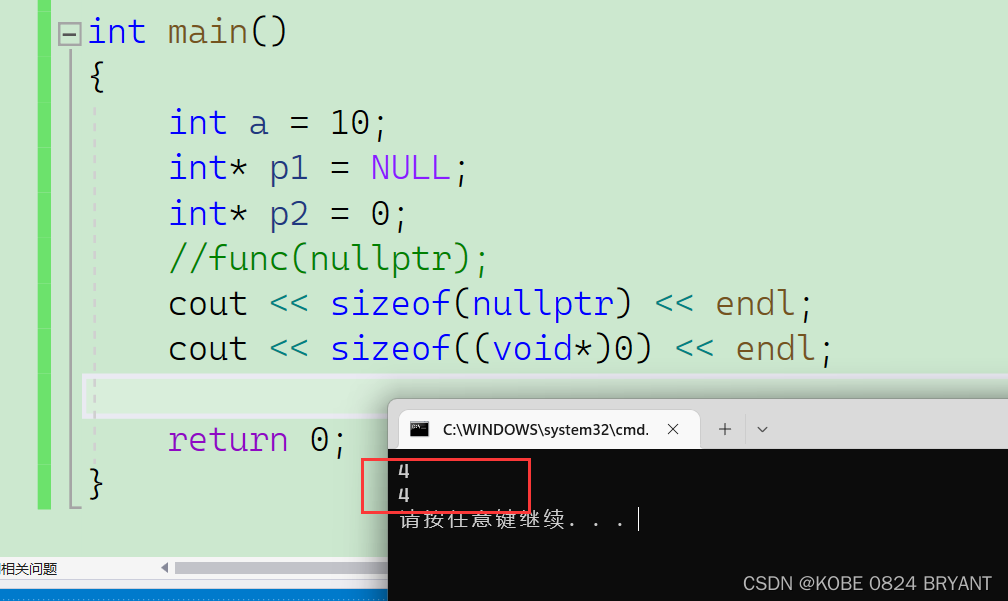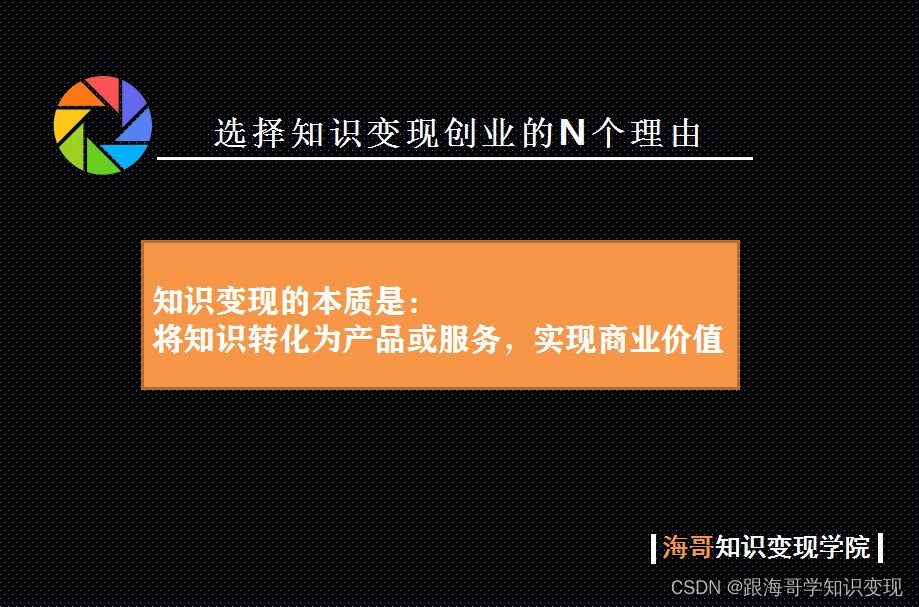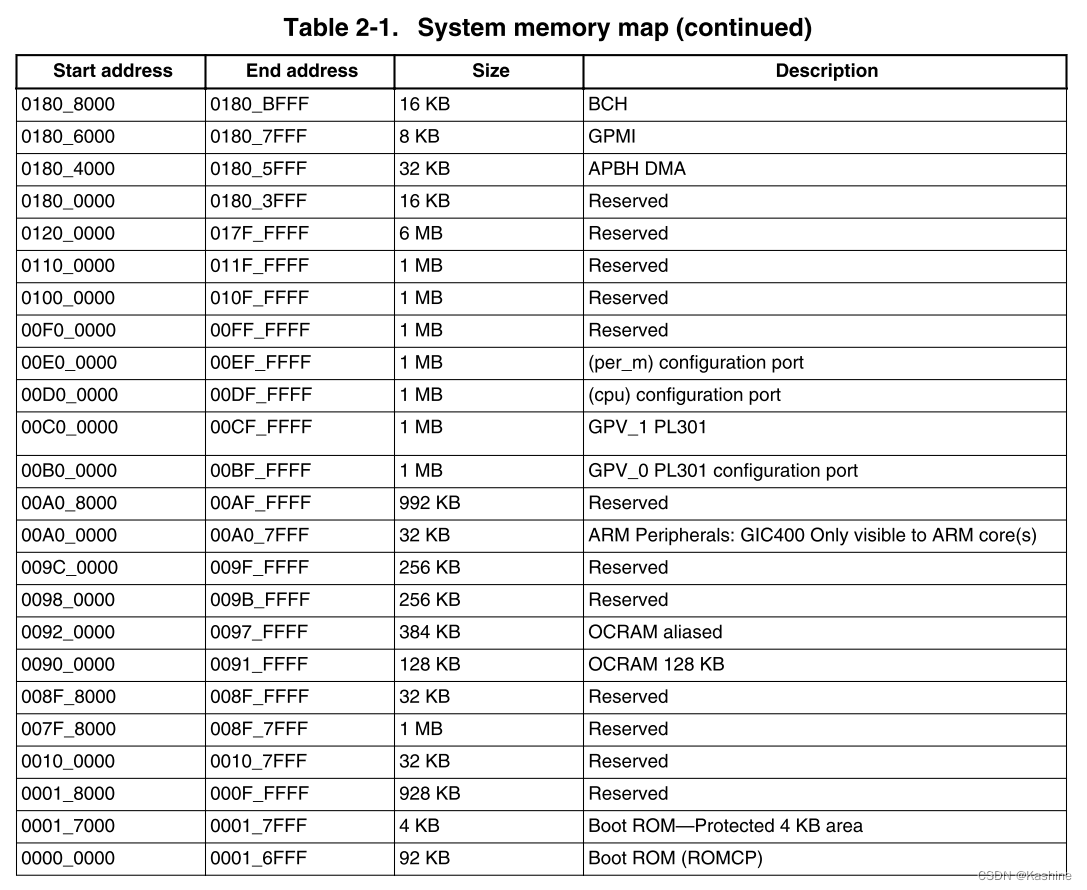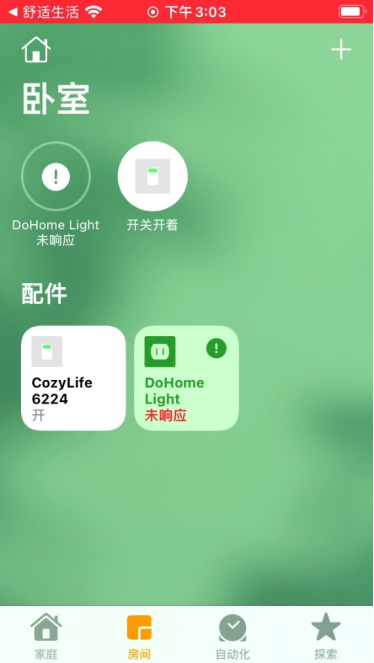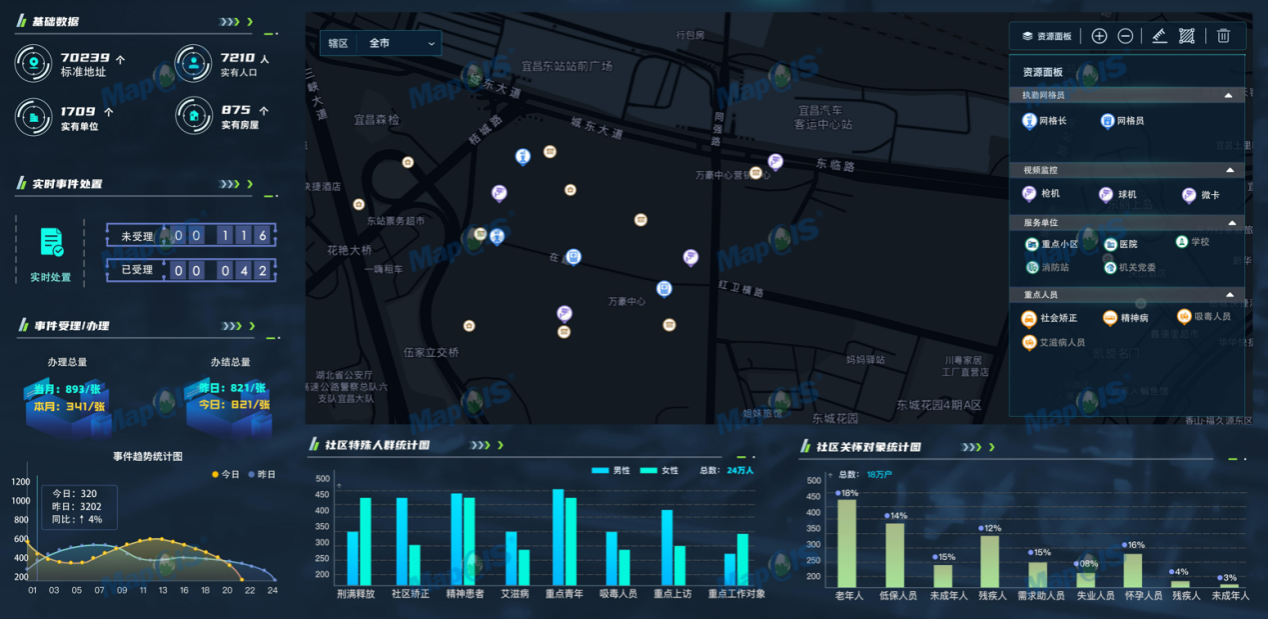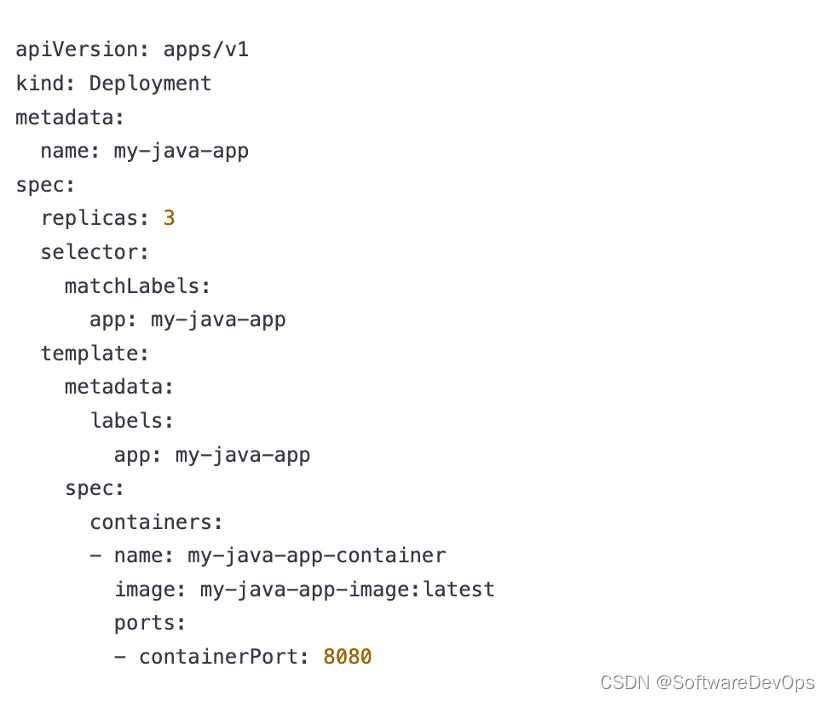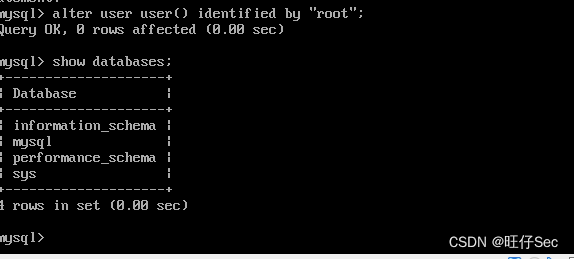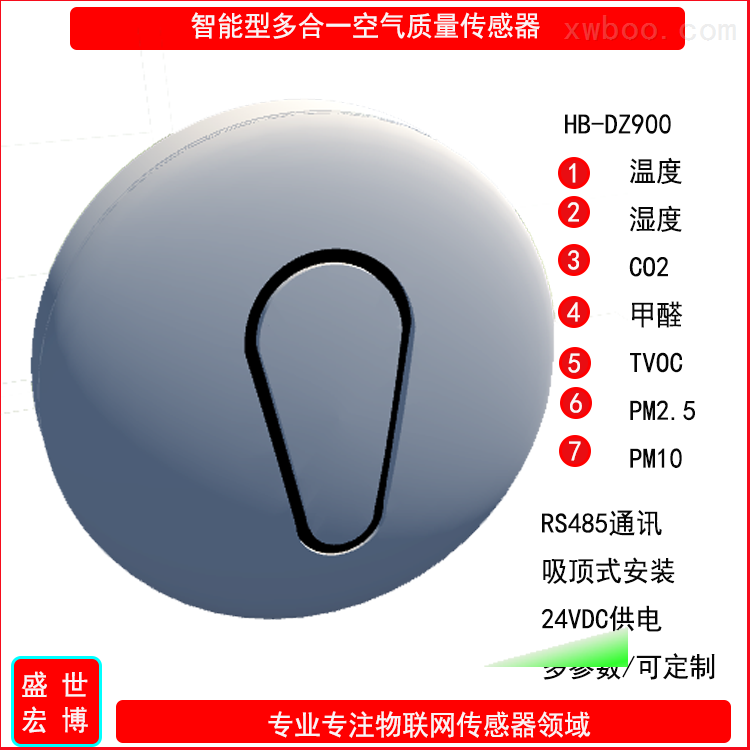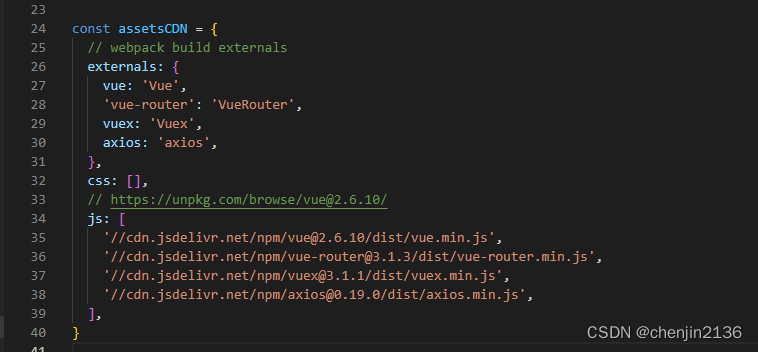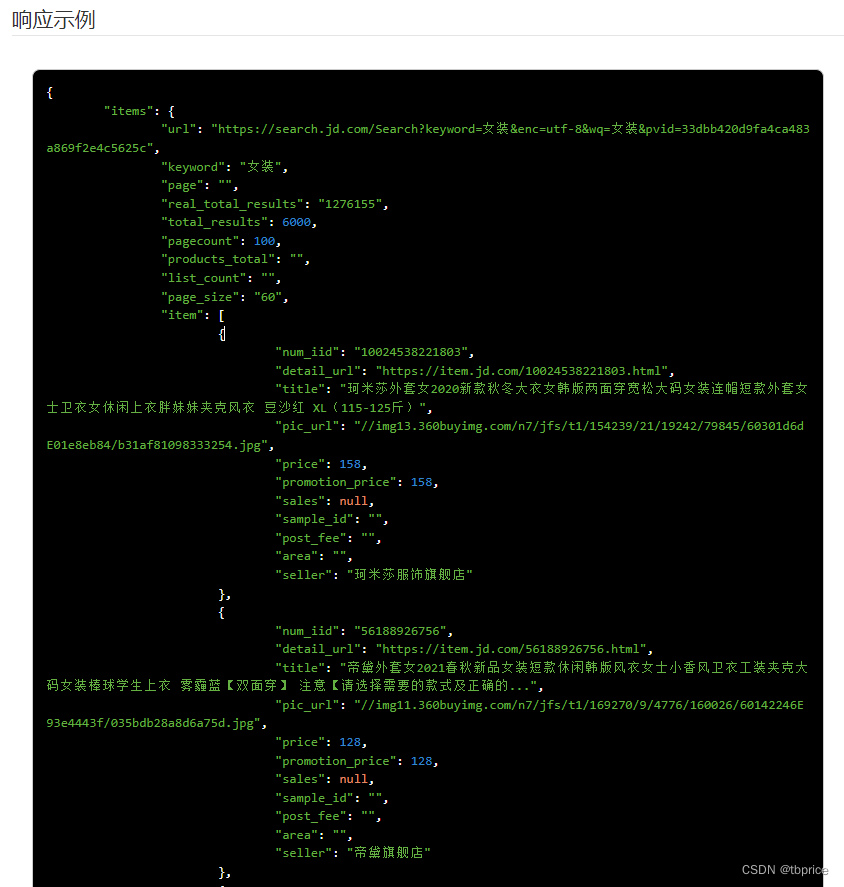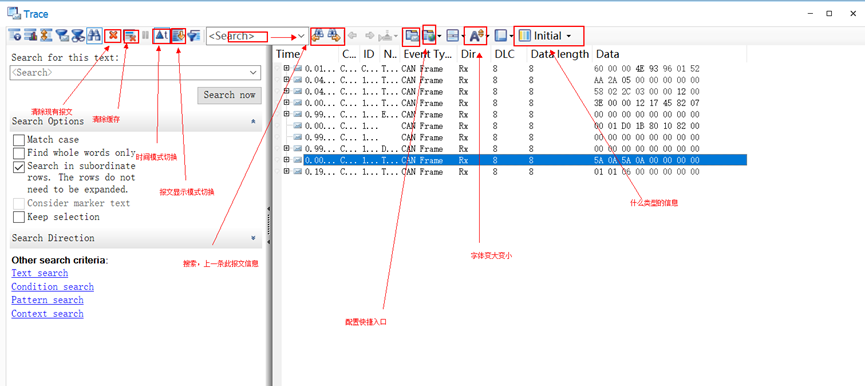接上一篇博客 Netty 源码解析(上)继续分析
上一篇博客中已经分析了绝大部分 ChannelFuture cf = bootstrap.bind(9000).sync(); 这一行代码,当这一行代码运行完时,Netty服务端就已经启动好了,接下来就是接收链接,处理数据的逻辑分析,但在测试之前还是先准备客户端代码 。
public class NettyClient {
public static void main(String[] args) throws Exception {
//客户端需要一个事件循环组
EventLoopGroup group = new NioEventLoopGroup();
try {
//创建客户端启动对象
//注意客户端使用的不是ServerBootstrap而是Bootstrap
Bootstrap bootstrap = new Bootstrap();
//设置相关参数
bootstrap.group(group) //设置线程组
.channel(NioSocketChannel.class) // 使用NioSocketChannel作为客户端的通道实现
.handler(new ChannelInitializer<SocketChannel>() {
@Override
protected void initChannel(SocketChannel ch) throws Exception {
//加入处理器
ch.pipeline().addLast(new NettyClientHandler());
}
});
System.out.println("netty client start。。");
//启动客户端去连接服务器端
ChannelFuture cf = bootstrap.connect("127.0.0.1", 9000).sync();
//对通道关闭进行监听
cf.channel().closeFuture().sync();
} finally {
group.shutdownGracefully();
}
}
}
public class NettyByteBuf {
public static void main(String[] args) {
// 创建byteBuf对象,该对象内部包含一个字节数组byte[10]
// 通过readerindex和writerIndex和capacity,将buffer分成三个区域
// 已经读取的区域:[0,readerindex)
// 可读取的区域:[readerindex,writerIndex)
// 可写的区域: [writerIndex,capacity)
ByteBuf byteBuf = Unpooled.buffer(1);
System.out.println("byteBuf=" + byteBuf);
for (int i = 0; i < 8; i++) {
byteBuf.writeByte(i);
}
System.out.println("byteBuf=" + byteBuf);
for (int i = 0; i < 5; i++) {
System.out.println(byteBuf.getByte(i));
}
System.out.println("byteBuf=" + byteBuf);
for (int i = 0; i < 5; i++) {
System.out.println(byteBuf.readByte());
}
System.out.println("byteBuf=" + byteBuf);
//用Unpooled工具类创建ByteBuf
ByteBuf byteBuf2 = Unpooled.copiedBuffer("hello,zhuge!", CharsetUtil.UTF_8);
//使用相关的方法
if (byteBuf2.hasArray()) {
byte[] content = byteBuf2.array();
//将 content 转成字符串
System.out.println(new String(content, CharsetUtil.UTF_8));
System.out.println("byteBuf2=" + byteBuf2);
System.out.println(byteBuf2.getByte(0)); // 获取数组0这个位置的字符h的ascii码,h=104
int len = byteBuf2.readableBytes(); //可读的字节数 12
System.out.println("len=" + len);
//使用for取出各个字节
for (int i = 0; i < len; i++) {
System.out.println((char) byteBuf2.getByte(i));
}
//范围读取
System.out.println(byteBuf2.getCharSequence(0, 6, CharsetUtil.UTF_8));
System.out.println(byteBuf2.getCharSequence(6, 6, CharsetUtil.UTF_8));
}
}
}
在上一篇博客中,已经分析了ServerSocketChannel的SelectKey已经注册了SelectionKey.OP_ACCEPT事件,既然已经注册了接收事件,那么可以接收客户端连接,又要回到之前的NioEventLoop()方法的select()方法的分析了,在之前NioEventLoop方法中,有一个processSelectedKeys()方法还没有分析,接下来进入此方法 。
private void processSelectedKeys() {
// 判断优化后的selectedKeys是否为空
if (selectedKeys != null) {
// 优化处理
processSelectedKeysOptimized();
} else {
// 原始处理
processSelectedKeysPlain(selector.selectedKeys());
}
}
processSelectedKeysOptimized()方法和processSelectedKeysPlain()方法差不多, 既然有优化处理方式,接下来进入优化处理方法 ,非优化方案,有兴趣的小伙伴自行去研究。
private void processSelectedKeysOptimized() {
for (int i = 0; i < selectedKeys.size; ++i) {
final SelectionKey k = selectedKeys.keys[i];
// null out entry in the array to allow to have it GC'ed once the Channel close
// See https://github.com/netty/netty/issues/2363
// 将selectedKeys.keys[i] = null;,并快速被JVM回收
// 无须等到调用其重置再去回收,因为Key 的attachement比较大,很容易千万内存泄漏
selectedKeys.keys[i] = null;
final Object a = k.attachment();
if (a instanceof AbstractNioChannel) {
// 根据key的就绪事件触发对应的事件方法
processSelectedKey(k, (AbstractNioChannel) a);
} else {
NioTask<SelectableChannel> task = (NioTask<SelectableChannel>) a;
processSelectedKey(k, task);
}
/**
* 判断是否应该再次轮询
* 每当256个Channel从Selector 上移除时
* 就标记needsToSelectAgain 为true
*/
if (needsToSelectAgain) {
// null out entries in the array to allow to have it GC'ed once the Channel close
// See https://github.com/netty/netty/issues/2363
// 清空 i + 1 之后的selectedKeys
selectedKeys.reset(i + 1);
// 重新调用selectNow()方法
selectAgain();
// -1 + 1 = 0 ,从0开始遍历
i = -1;
}
}
}
上面processSelectedKey()方法中,还有一个需要注意的是k.attachment()参数值,是什么时候设置的呢?请看之前的doRegister()方法,如果是NioServerSocketChannel,则此时的attachment值就是NioServerSocketChannel,如果是NioSocketChannel,则attachment的值就是NioSocketChannel。

无论是NioServerSocketChannel还是NioSocketChannel都是继承AbstractNioChannel,因此这里进入AbstractNioChannel相关的processSelectedKey进行分析 。

private void processSelectedKey(SelectionKey k, AbstractNioChannel ch) {
final AbstractNioChannel.NioUnsafe unsafe = ch.unsafe();
if (!k.isValid()) {
final EventLoop eventLoop;
try {
eventLoop = ch.eventLoop();
} catch (Throwable ignored) {
// If the channel implementation throws an exception because there is no event loop, we ignore this
// because we are only trying to determine if ch is registered to this event loop and thus has authority
// to close ch.
return;
}
// Only close ch if ch is still registered to this EventLoop. ch could have deregistered from the event loop
// and thus the SelectionKey could be cancelled as part of the deregistration process, but the channel is
// still healthy and should not be closed.
// See https://github.com/netty/netty/issues/5125
if (eventLoop != this || eventLoop == null) {
return;
}
// close the channel if the key is not valid anymore
unsafe.close(unsafe.voidPromise());
return;
}
try {
int readyOps = k.readyOps();
// We first need to call finishConnect() before try to trigger a read(...) or write(...) as otherwise
// the NIO JDK channel implementation may throw a NotYetConnectedException.
// 如果是OP_CONNECT事件,则设置为OP_READ ,OP_WRITE,OP_ACCEPT 事件
if ((readyOps & SelectionKey.OP_CONNECT) != 0) {
// remove OP_CONNECT as otherwise Selector.select(..) will always return without blocking
// See https://github.com/netty/netty/issues/924
int ops = k.interestOps();
ops &= ~SelectionKey.OP_CONNECT; // 非OP_CONNECT事件,即 OP_READ, OP_WRITE , OP_ACCEPT
k.interestOps(ops); // 可以通过interestOps(int ops)方法修改事件列表
unsafe.finishConnect();
}
// Process OP_WRITE first as we may be able to write some queued buffers and so free memory.
if ((readyOps & SelectionKey.OP_WRITE) != 0) {
// Call forceFlush which will also take care of clear the OP_WRITE once there is nothing left to write
ch.unsafe().forceFlush();
}
// Also check for readOps of 0 to workaround possible JDK bug which may otherwise lead
// to a spin loop
// 通过前面的学习,了解了Netty服务的启动过程,以及Netty服务 采用辅助类ServerBootstrap启动NioEventLoop线程,
// 并依次开启 Selector、创建ServerSocketChannel并注册到Selector上、设置监听 OP_ACCEPT事件的过程。那么
// 当有Socket通道接入时,Netty是如何处 理的呢?本节还是通过图、文字及Netty部分源码的方式对这块处理逻 辑进行详细的剖析。
// 下面先看一幅NioEventLoop处理就绪OP_ACCEPT事 件的时序图,如图5-3所示。
// 1. 当NioEventLoop中的多路复用器Selector轮询到就绪的 SelectionKey时,判断Key的readyOps类型是否为OP_ACCEPT,若是,
// 则5.1节提到的Key的attachment就是 NioServerSocketChannel本身,先获取SelectionKey的attachment对象,再触发此对象的辅助类
// Unsafe的实现类NioMessageUnsafe的read()方法进行处理。
// 处理读请求(断开连接)或接入连接
if ((readyOps & (SelectionKey.OP_READ | SelectionKey.OP_ACCEPT)) != 0 || readyOps == 0) {
// unsafe.read() 方法负责读取数据并通过pipeline.fireChannelRead(byteBuf ) 方法逐级的读取数据放入到处理程序流水线中 。
unsafe.read();
}
} catch (CancelledKeyException ignored) {
unsafe.close(unsafe.voidPromise());
}
}
先重点关心SelectionKey.OP_ACCEPT和SelectionKey.OP_READ事件,如果当前ch为NioServerSocketChannel,那么它对应的unsafe就是NioMessageUnsafe,为什么呢? 看NioServerSocketChannel的父类构造方法AbstractChannel。

而newUnsafe()方法是一个抽象方法,真正的实现是子类。 从NioServerSocketChannel的类结构来看。
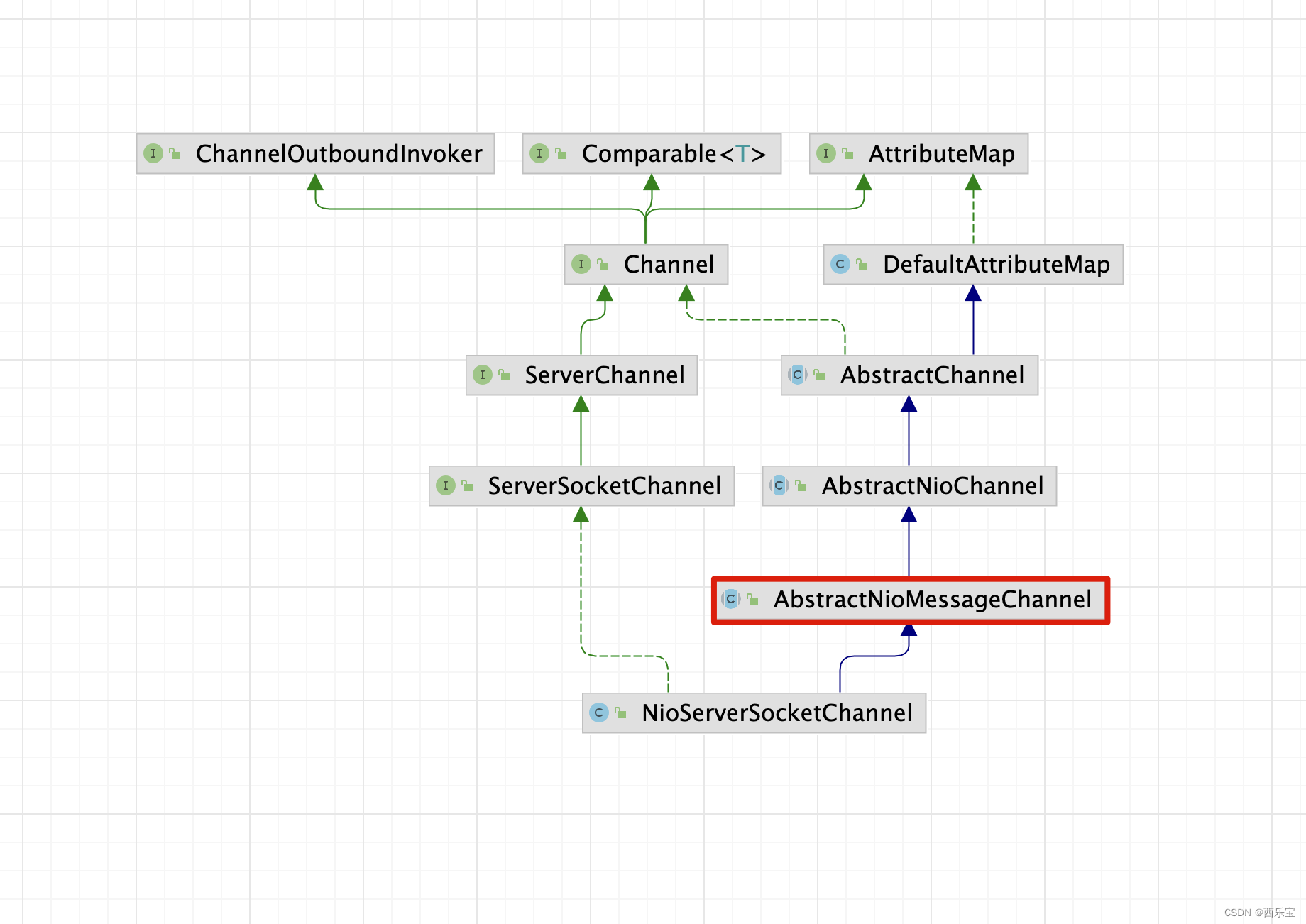
在AbstractNioMessageChannel的newUnsafe()方法中,创建了NioMessageUnsafe对象。
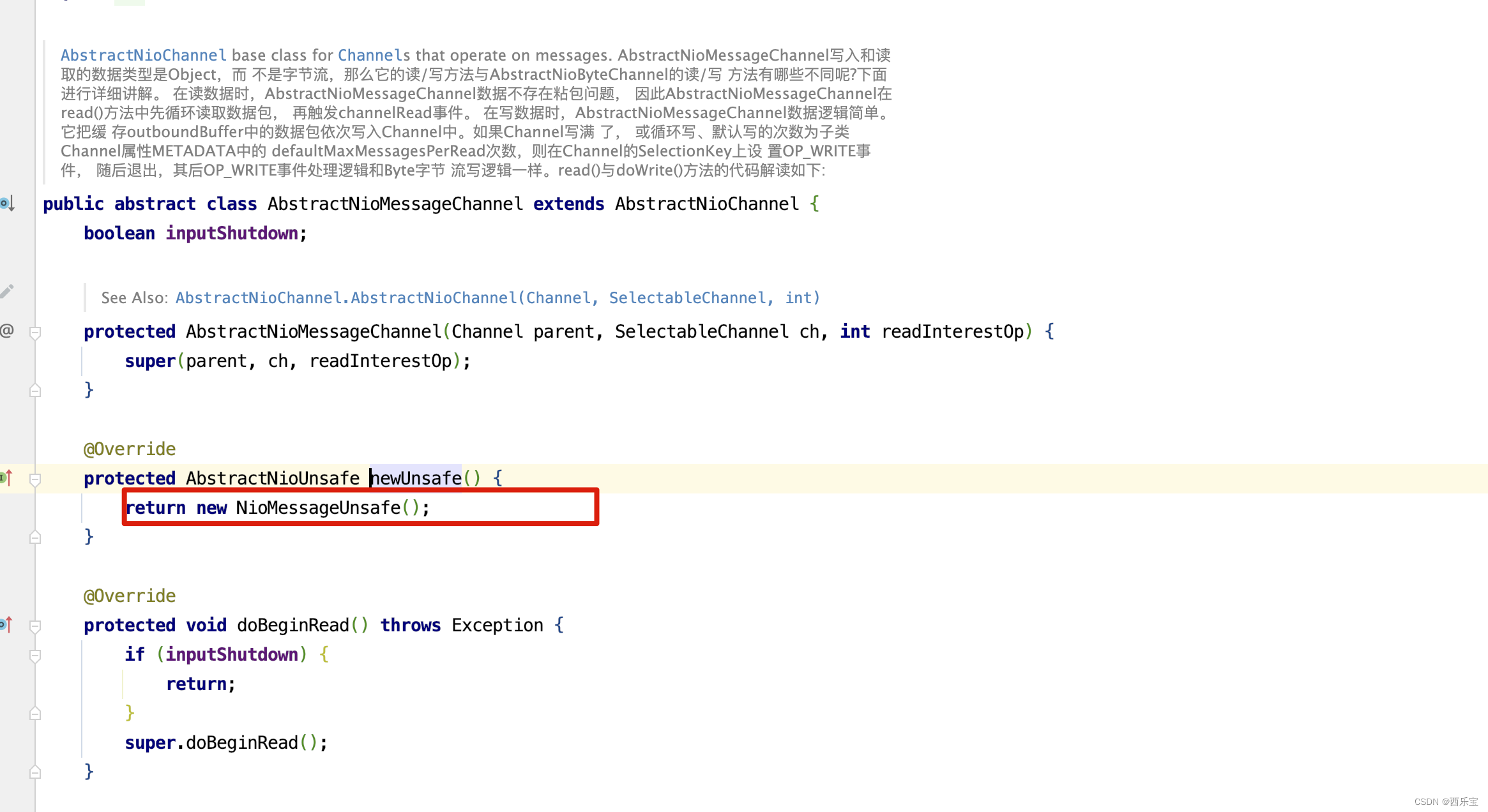
对于NioServerSocketChannel,则进入NioMessageUnsafe的read()方法 。
private final class NioMessageUnsafe extends AbstractNioUnsafe {
private final List<Object> readBuf = new ArrayList<Object>();
@Override
// 在 NioMessageUnsafe 的 read() 方 法 中 会 执 行 doReadMessages(此处用到了模板设计模式)。真正调用的是 AbstractNioMessageChannel
// 的 子 类 NioServerSocketChannel 的 doReadMessages() 方 法 。 此 方 法 最 终 调 用 ServerSocketChannel 的 accept()方法,
// 以获取接入的SocketChannel。将accept()方法在 AbstractNioChannel的构造方法中设置为非阻塞状态,不管是否有 Channel接入,
// 都会立刻返回,并且一次最多默认获取16个,可以通过 设 置 option 参 数 MAX_MESSAGES_PER_READ 来 调 整 。 获 取 到 SocketChannel 后 ,
// 构 建 NioSocketChannel , 并 把 构 建 好 的 NioSocketChannel对象作为消息msg传送给Handler(此Handler是 ServerBootstrapAcceptor ) ,
// 触 发 Pipeline 管 道 的 fireChannelRead()方法,进而触发read事件,最后会调用Handler的 channelRead()方法。
public void read() {
assert eventLoop().inEventLoop();
// 获取Channel的配置对象
final ChannelConfig config = config();
final ChannelPipeline pipeline = pipeline();
// 获取计算内存分配 Handle
final RecvByteBufAllocator.Handle allocHandle = unsafe().recvBufAllocHandle();
// 清空上次记录
allocHandle.reset(config);
boolean closed = false;
Throwable exception = null;
try {
try {
do {
/***
* 调用子类doReadMessages()方法
* 读取数据包, 并放入readBuf链表中
* 当成功读取时返回1
*/
int localRead = doReadMessages(readBuf);
// 已无数据,跳出循环
if (localRead == 0) {
break;
}
// 链路关闭,跳出循环
if (localRead < 0) {
closed = true;
break;
}
// 记录成功读取的次数
allocHandle.incMessagesRead(localRead);
// 默认循环不能超过16次
} while (allocHandle.continueReading());
} catch (Throwable t) {
exception = t;
}
int size = readBuf.size();
// 循环处理读取的数据包
for (int i = 0; i < size; i ++) {
readPending = false;
// 触发channelRead事件
pipeline.fireChannelRead(readBuf.get(i));
}
readBuf.clear();
// 记录当前读取记录,以便下次分配合理的内存
allocHandle.readComplete();
// 触发readComplete事件
pipeline.fireChannelReadComplete();
if (exception != null) {
// 处理Channel 异常关闭
closed = closeOnReadError(exception);
pipeline.fireExceptionCaught(exception);
}
if (closed) {
inputShutdown = true;
// 处理Channel正常关闭
if (isOpen()) {
close(voidPromise());
}
}
} finally {
// Check if there is a readPending which was not processed yet.
// This could be for two reasons:
// * The user called Channel.read() or ChannelHandlerContext.read() in channelRead(...) method
// * The user called Channel.read() or ChannelHandlerContext.read() in channelReadComplete(...) method
//
// See https://github.com/netty/netty/issues/2254
// 读操作完毕,且没有配置自动读
if (!readPending && !config.isAutoRead()) {
// 移除读操作事件
removeReadOp();
}
}
}
}
因为
final AbstractNioChannel.NioUnsafe unsafe = ch.unsafe();
unsafe.read();
,所以在read()方法的内部调用
int localRead = doReadMessages(readBuf);
方法,实际上还是调用NioServerSocketChannel的doReadMessages()方法 。
// NioMessageUnsafe先调 用 NioServerSocketChannel 的 doReadMessages() 方 法 读 取 接 入 的 Channel。
// 而本小节中的NioByteUnsafe不断地调用NioSocketChannel 的doReadBytes()方法从Channel中读取数据,
// 再把读取到的ByteBuf交 给管道Pipeline,并触发后续一系列ChannelInboundHandler的 channelRead()方法。
// 整个读取数据的过程涉及的Handler都是以 HeadContext开头的,按顺序运行用户自定义的各个解码器和服务端业 务逻辑处理Handler。
protected int doReadMessages(List<Object> buf) throws Exception {
// 调用serverSocketChannel.accept()监听新加入的链接
// 因此可以接收连接了,在服务器接收到连接之后,创建连接的过程就是创建SocketChannel
SocketChannel ch = SocketUtils.accept(javaChannel());
try {
if (ch != null) {
// 每个新链接都会构建一个NioSocketChannel
buf.add(new NioSocketChannel(this, ch));
return 1;
}
} catch (Throwable t) {
logger.warn("Failed to create a new channel from an accepted socket.", t);
try {
// 若连接出现异常, 则关闭
ch.close();
} catch (Throwable t2) {
logger.warn("Failed to close a socket.", t2);
}
}
return 0;
}
是不是看到了我们久违的方法 accept(),那这个方法的内部做了哪些事情呢?
public static SocketChannel accept(final ServerSocketChannel serverSocketChannel) throws IOException {
try {
return AccessController.doPrivileged(new PrivilegedExceptionAction<SocketChannel>() {
@Override
public SocketChannel run() throws IOException {
return serverSocketChannel.accept();
}
});
} catch (PrivilegedActionException e) {
throw (IOException) e.getCause();
}
}
是不是又找到了似曾相识的感觉。
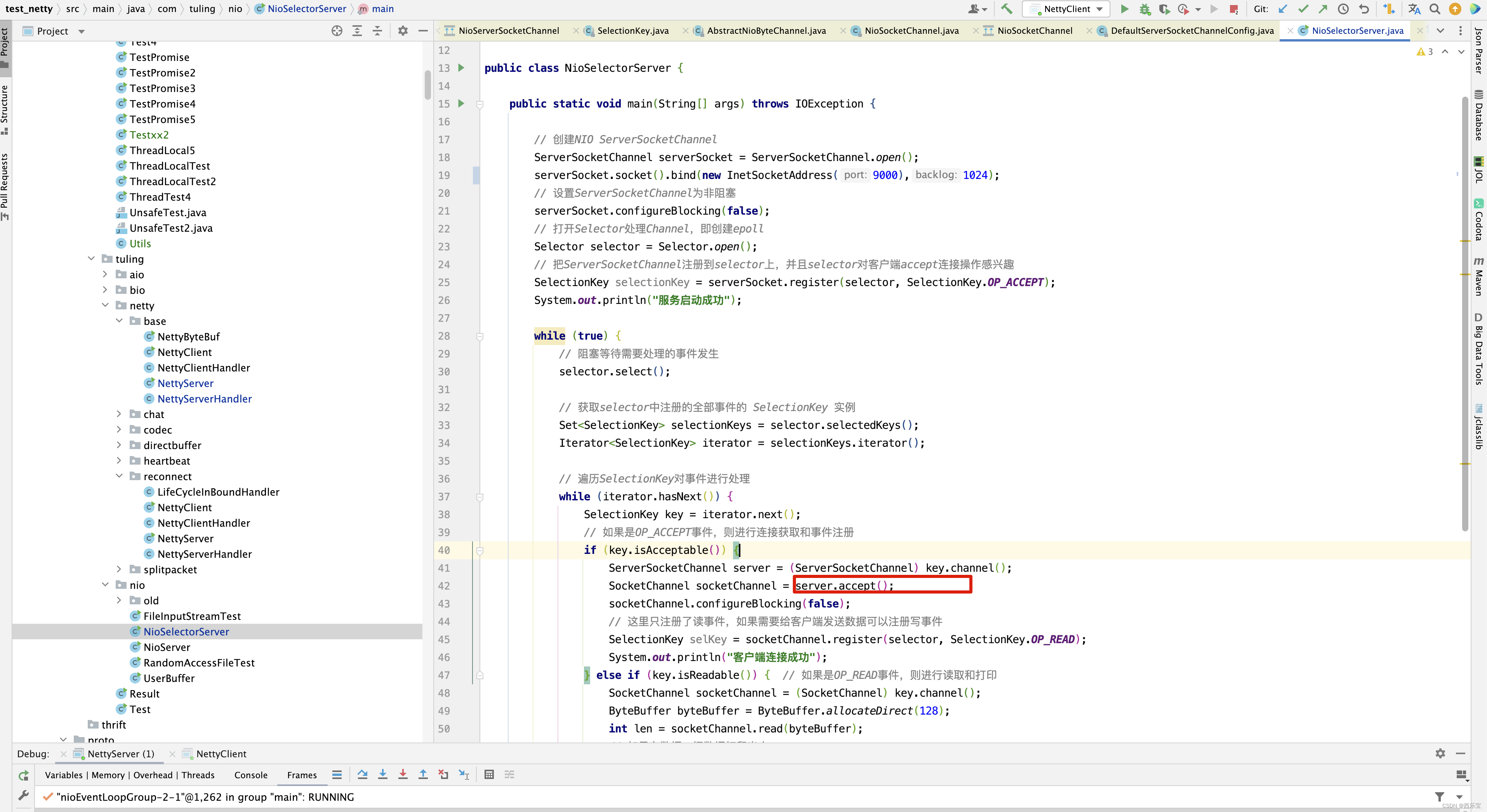
不就是ServerSocketChannel调用accept()方法不?那么接下来的代码就围绕着这两行分析 。
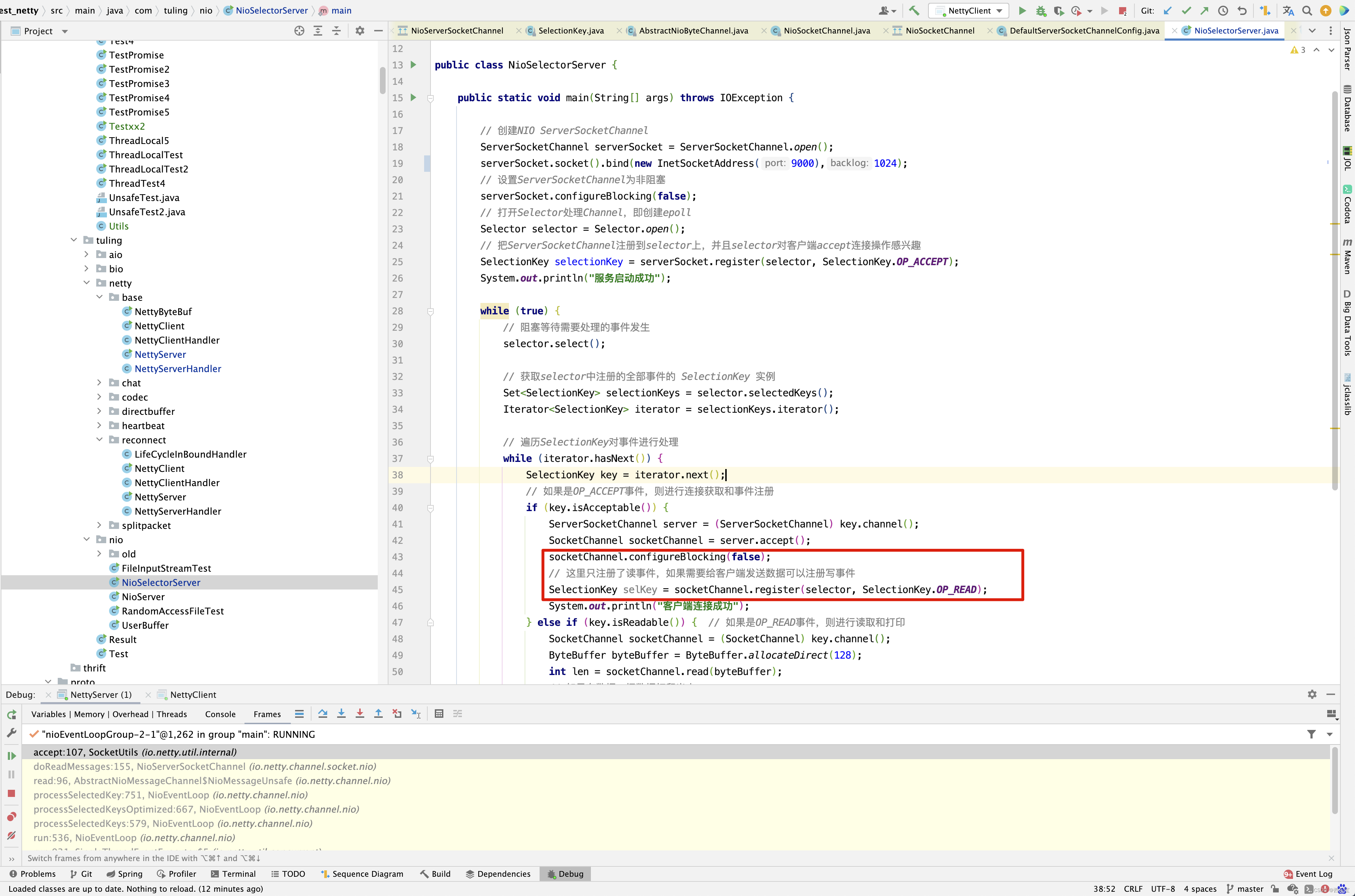
回顾之前的NioServerSocketChannel,我们是通过反射创建的,这里的NioSocketChannel是直接new创建。 而NioSocketChannel的内部做了哪些事情呢? 其实和NioServerSocketChannel类似,但有些参数的初始化还是需要注意,因此这里还是进入分析一下。
public NioSocketChannel(Channel parent, SocketChannel socket) {
super(parent, socket);
config = new NioSocketChannelConfig(this, socket.socket());
}
这里需要注意了,之前在NioServerSocketChannel
构造函数中,创建的config对象是NioServerSocketChannelConfig,而NioSocketChannel的构造函数中config对象是NioSocketChannelConfig,当然NioServerSocketChannel还指定了事件类型为SelectionKey.OP_ACCEPT,在NioServerSocketChannel的构造函数中,还没有看到指定,当然啦,NioSocketChannel指定了它的parent属性为NioServerSocketChannel, 跟进到NioServerSocketChannel的父类 。
protected AbstractNioByteChannel(Channel parent, SelectableChannel ch) {
super(parent, ch, SelectionKey.OP_READ);
}
看到没有,这里指定了NioSocketChannel的事件类型为SelectionKey.OP_READ,这点很重要,后面的注册方法分析到。
protected AbstractNioChannel(Channel parent, SelectableChannel ch, int readInterestOp) {
super(parent);
this.ch = ch;
this.readInterestOp = readInterestOp;
try {
ch.configureBlocking(false);
} catch (IOException e) {
try {
ch.close();
} catch (IOException e2) {
if (logger.isWarnEnabled()) {
logger.warn(
"Failed to close a partially initialized socket.", e2);
}
}
throw new ChannelException("Failed to enter non-blocking mode.", e);
}
}
在AbstractNioChannel中,是不是又看到我久违的代码,ch.configureBlocking(false);这一行代码已经看到过两次了吧。对应于例子中的下面两行代码 。

第一次见到是NioServerSocketChannel的初始化,第二次见到就是现在,NioSocketChannel的初始化 。接下来继续进入AbstractNioChannel的父类AbstractChannel的构造函数中。
protected AbstractChannel(Channel parent) {
this.parent = parent; // 父通道
id = newId();
unsafe = newUnsafe(); // 底层的NIO通道,完成的实际的IO操作
pipeline = newChannelPipeline(); // 一条通道,拥有一条流水线
}
在之前的分析中,已经知道了unsafe的重要性,因此这里继续分析newUnsafe()方法 ,因为NioSocketChannel本身就实现了newUnsafe()方法,因此进入其中 。
protected AbstractNioUnsafe newUnsafe() {
return new NioSocketChannelUnsafe();
}
这里我们终于明白了, NioServerSocketChannel创建的是NioMessageUnsafe,而NioSocketChannel创建的是NioSocketChannelUnsafe,将所有的NioSocketChannel存储于readBuf中,然后遍历readBuf中的元素,调用NioServerSocketChannel的pipeline的fireChannelRead()方法,这里需要注意,是NioServerSocketChannel的pipeline,而不是NioSocketChannel创建的pipeline。
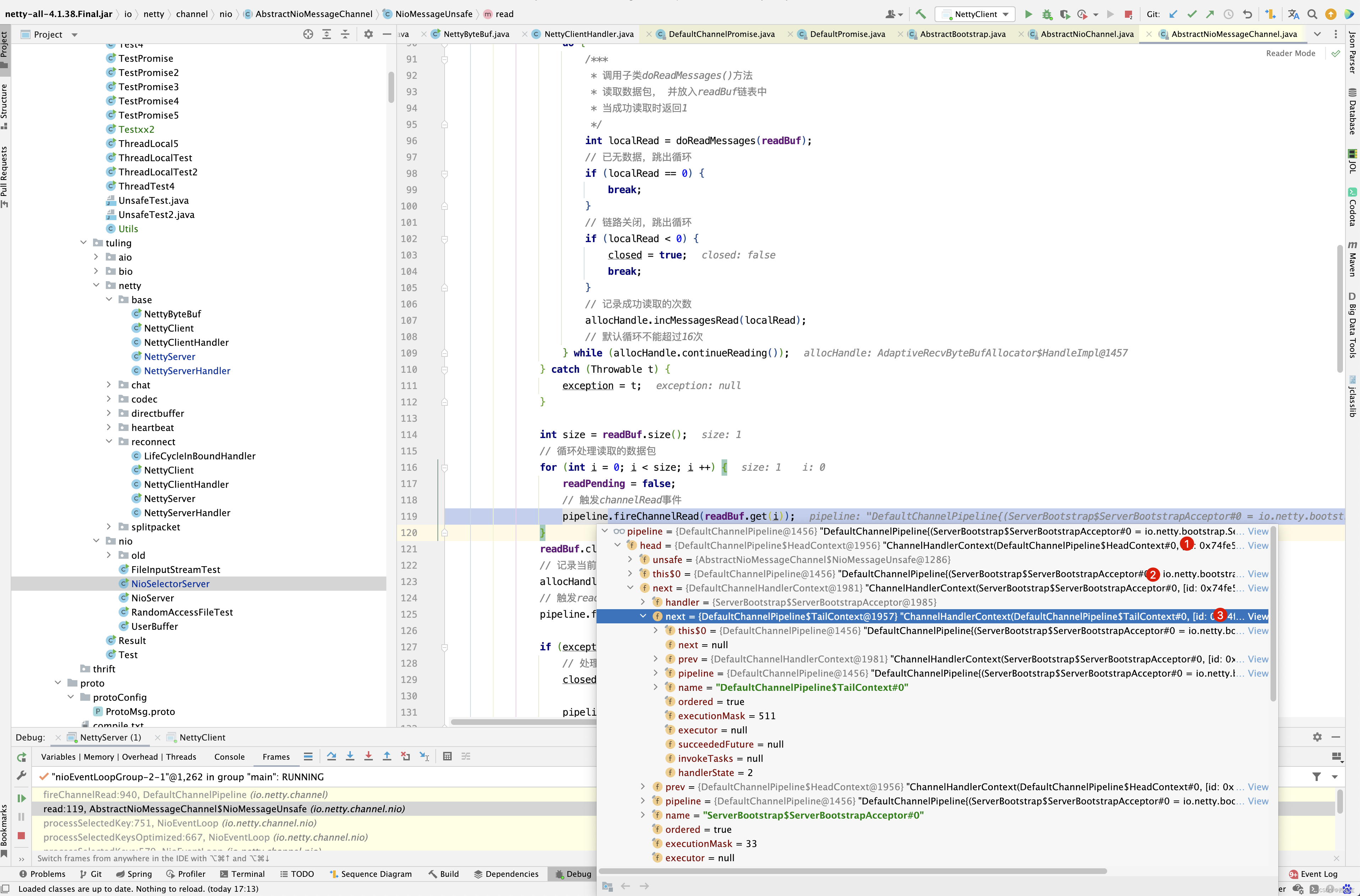
传入的参数就是刚刚创建的NioSocketChannel。

进入pipeline的fireChannelRead()方法 。
public final ChannelPipeline fireChannelRead(Object msg) {
AbstractChannelHandlerContext.invokeChannelRead(head, msg);
return this;
}
static void invokeChannelRead(final AbstractChannelHandlerContext next, Object msg) {
final Object m = next.pipeline.touch(ObjectUtil.checkNotNull(msg, "msg"), next);
EventExecutor executor = next.executor();
if (executor.inEventLoop()) {
next.invokeChannelRead(m);
} else {
executor.execute(new Runnable() {
@Override
public void run() {
next.invokeChannelRead(m);
}
});
}
}
private void invokeChannelRead(Object msg) {
if (invokeHandler()) {
try {
((ChannelInboundHandler) handler()).channelRead(this, msg);
} catch (Throwable t) {
notifyHandlerException(t);
}
} else {
fireChannelRead(msg);
}
}
上面调了那么多,最终还是从HeadContext的handler()开始调用 。
public void channelRead(ChannelHandlerContext ctx, Object msg) {
ctx.fireChannelRead(msg);
}
public ChannelHandlerContext fireChannelRead(final Object msg) {
invokeChannelRead(findContextInbound(MASK_CHANNEL_READ), msg);
return this;
}
private void invokeChannelRead(Object msg) {
if (invokeHandler()) {
try {
((ChannelInboundHandler) handler()).channelRead(this, msg);
} catch (Throwable t) {
notifyHandlerException(t);
}
} else {
fireChannelRead(msg);
}
}
之前分析过findContextInbound()方法。 从之前的分析得知,他会先跳过自己,也就是HeadContext。

而ServerBootstrapAcceptor 本身就实现了channelRead()方法 。
private static class ServerBootstrapAcceptor extends ChannelInboundHandlerAdapter {
private final EventLoopGroup childGroup;
private final ChannelHandler childHandler;
private final Entry<ChannelOption<?>, Object>[] childOptions;
private final Entry<AttributeKey<?>, Object>[] childAttrs;
private final Runnable enableAutoReadTask;
ServerBootstrapAcceptor(
final Channel channel, EventLoopGroup childGroup, ChannelHandler childHandler,
Entry<ChannelOption<?>, Object>[] childOptions, Entry<AttributeKey<?>, Object>[] childAttrs) {
this.childGroup = childGroup;
this.childHandler = childHandler;
this.childOptions = childOptions;
this.childAttrs = childAttrs;
// Task which is scheduled to re-enable auto-read.
// It's important to create this Runnable before we try to submit it as otherwise the URLClassLoader may
// not be able to load the class because of the file limit it already reached.
//
// See https://github.com/netty/netty/issues/1328
enableAutoReadTask = new Runnable() {
@Override
public void run() {
channel.config().setAutoRead(true);
}
};
}
@Override
@SuppressWarnings("unchecked")
// 在ServerBootstrapAcceptor的channelRead()方法中,把 NioSocketChannel注册到Worker线程上,同时绑定Channel的Handler 链。
// 这与5.1节中将NioServerSocketChannel注册到Boss线程上类似, 代码流程基本上都一样,只是实现的子类不一样,如后续添加的事件
// 由OP_ACCEPT换成了OP_READ。通过这一步的分析,读者可以思考, Netty为何要把Channel抽象化?
public void channelRead(ChannelHandlerContext ctx, Object msg) {
final Channel child = (Channel) msg;
child.pipeline().addLast(childHandler);
setChannelOptions(child, childOptions, logger);
for (Entry<AttributeKey<?>, Object> e: childAttrs) {
child.attr((AttributeKey<Object>) e.getKey()).set(e.getValue());
}
try {
// 这个方法负责对创建后的链接执行如下语句完成注册
childGroup.register(child).addListener(new ChannelFutureListener() {
@Override
public void operationComplete(ChannelFuture future) throws Exception {
if (!future.isSuccess()) {
forceClose(child, future.cause());
}
}
});
} catch (Throwable t) {
forceClose(child, t);
}
}
程序运行到这里,我相信大家都晕了, 这些参数是什么啊? 不要晕,回顾之前的代码。 找到ServerBootstrapAcceptor构造方法调用的地方。

这不就是我们之前调用ServerBootstrap的bind()时,init()方法中初始化的参数不? 而这些参数就是我们NettyServer 这个例子中的初始化的参数 。 当然上图中 4 标识的attrs,在本例中并没有设置值 。
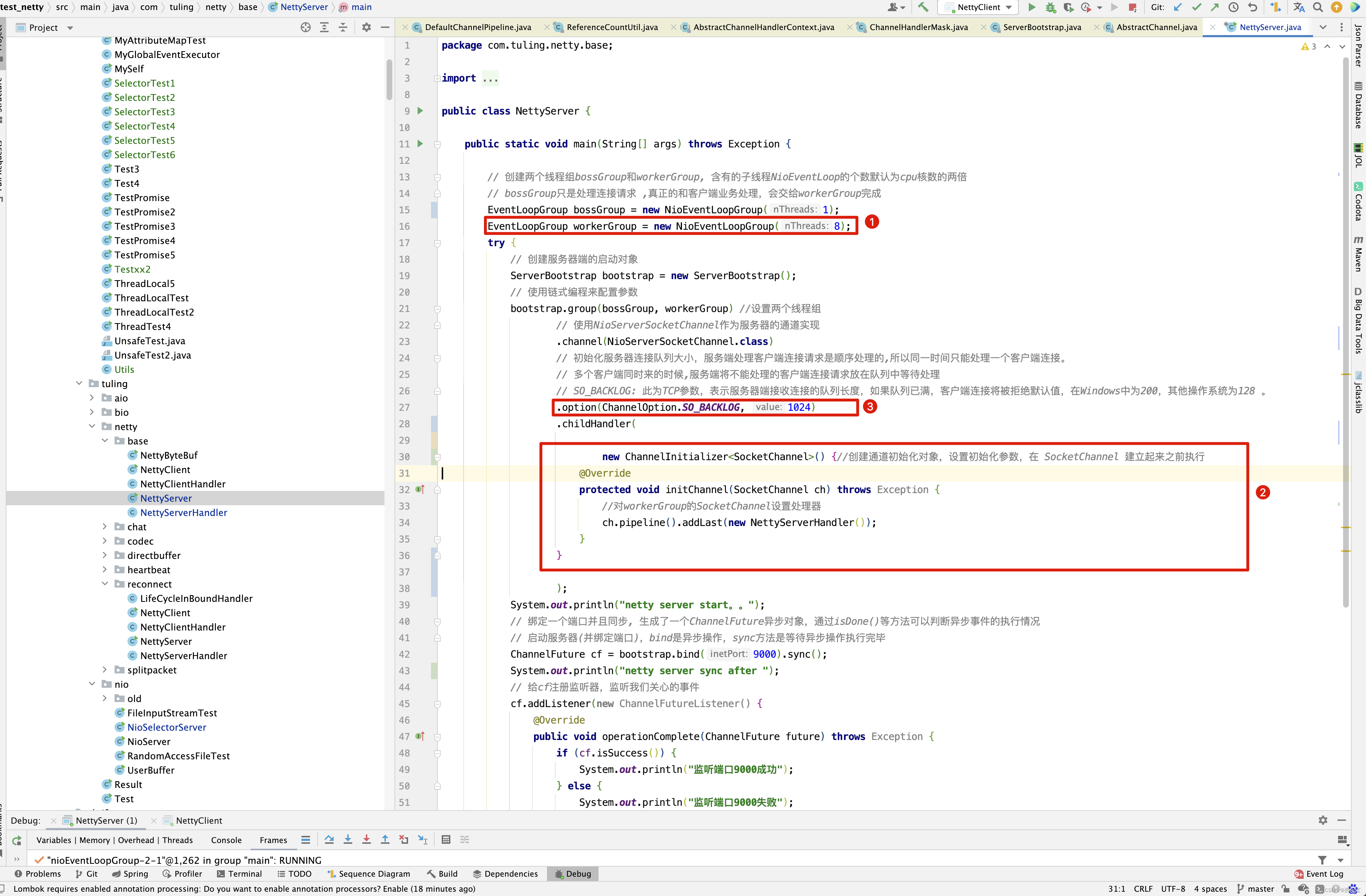
当然啦, 上述加粗代码childGroup.register(child),在上一篇博客中,已经做了详细的分析,唯一要注意的就是。

对应于之前例子中的socketChannel.register(selector, SelectionKey.OP_READ) 。
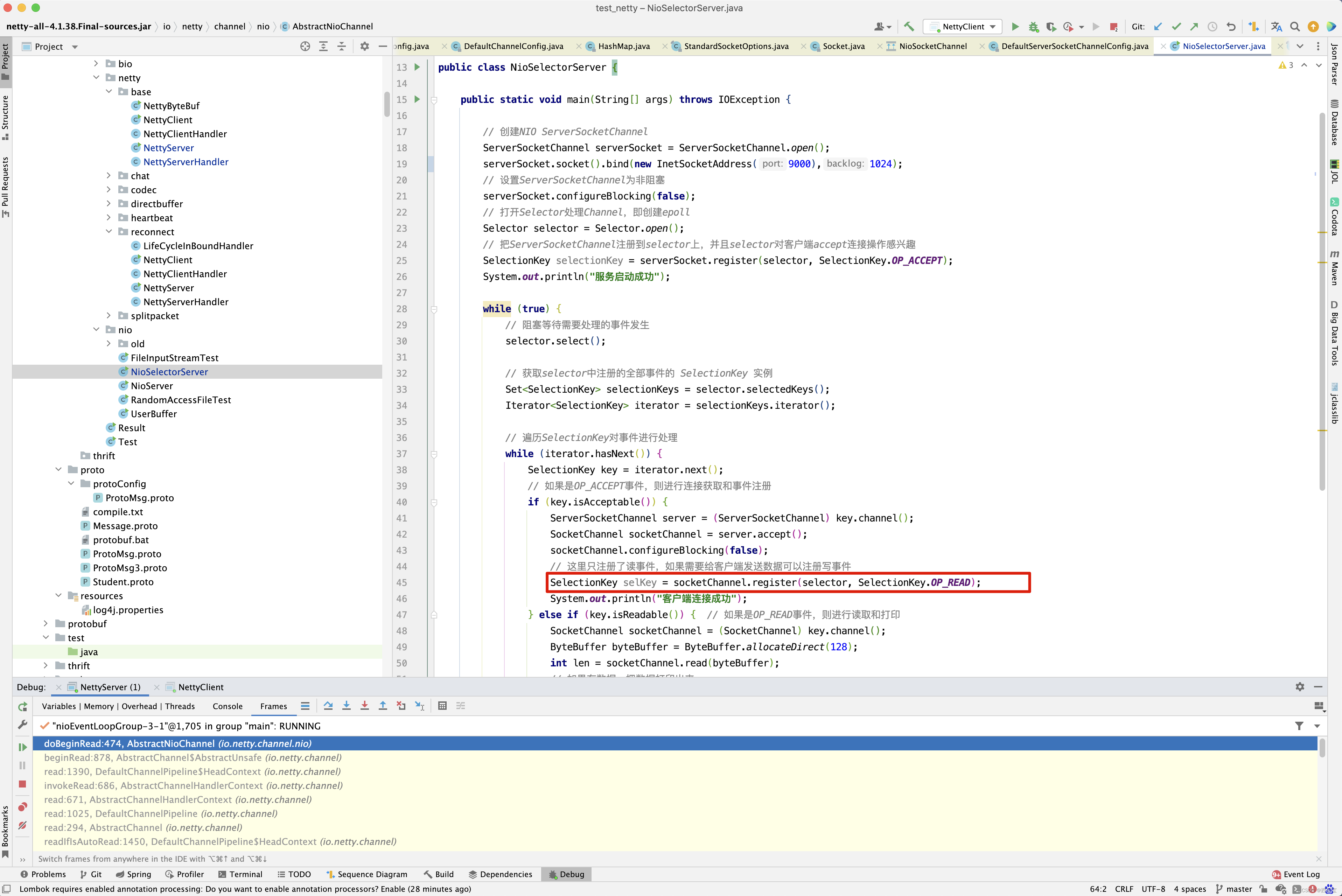
分析到这里,我觉得Netty的代码还是写得非常好的,为什么呢? bossGroup 和 workerGroup的区别
bossGroup:
channel : NioServerSocketChannel
config : ServerSocketChannelConfig
unsafe : NioMessageUnsafe
workerGroup
channel: NioSocketChannel
unsafe : NioByteUnsafe
而register()内部的其他方法的调用基本上都是一样。
接下来继续回到processSelectedKey()方法的分析,对于SelectionKey.OP_READ事件,此时会走unsafe.read()处理,但unsafe不再是NioMessageUnsafe,而是NioByteUnsafe类。
public final void read() {
// 获取pipeline通道配置,Channel管道
final ChannelConfig config = config();
// socketChannel已经关闭
if (shouldBreakReadReady(config)) {
clearReadPending();
return;
}
final ChannelPipeline pipeline = pipeline();
// 获取内存分配器,默认为PooledByteBufAllocator
final ByteBufAllocator allocator = config.getAllocator();
// 获取RecvByteBufAllocator内部的计算器Handle
final RecvByteBufAllocator.Handle allocHandle = recvBufAllocHandle();
// 清空上一次读取的字节数,每次读取时均重新计算
// 字节buf分配器, 并计算字节buf分配器Handler
allocHandle.reset(config);
ByteBuf byteBuf = null;
boolean close = false;
try {
do {
// 分配内存 ,allocator根据计算器Handle计算此次需要分配多少内存并从内存池中分配
byteBuf = allocHandle.allocate(allocator);
// 读取通道接收缓冲区的数据 , 设置最后一次分配内存大小加上每次读取的字节数
allocHandle.lastBytesRead(doReadBytes(byteBuf));
if (allocHandle.lastBytesRead() <= 0) {
// nothing was read. release the buffer.
// 若没有数据可读,则释放内存
byteBuf.release();
byteBuf = null;
close = allocHandle.lastBytesRead() < 0;
if (close) {
// There is nothing left to read as we received an EOF.
// 当读到-1时, 表示Channel 通道已经关闭
// 没有必要再继续
readPending = false;
}
break;
}
// 更新读取消息计数器
allocHandle.incMessagesRead(1);
readPending = false;
// 通知通道处理读取数据,触发Channel管道的fireChannelRead事件
pipeline.fireChannelRead(byteBuf);
byteBuf = null;
} while (allocHandle.continueReading());
// 读取操作完毕 ,读结束后调用,记录此次实际读取到的数据大小,并预测下一次内存分配大小
allocHandle.readComplete();
// 触发Channel管道的fireChannelReadComplete事件
pipeline.fireChannelReadComplete();
if (close) {
// 如果Socket通道关闭,则关闭读操作
closeOnRead(pipeline);
}
} catch (Throwable t) {
// 处理读取异常
handleReadException(pipeline, byteBuf, t, close, allocHandle);
} finally {
// Check if there is a readPending which was not processed yet.
// This could be for two reasons:
// * The user called Channel.read() or ChannelHandlerContext.read() in channelRead(...) method
// * The user called Channel.read() or ChannelHandlerContext.read() in channelReadComplete(...) method
//
// See https://github.com/netty/netty/issues/2254
if (!readPending && !config.isAutoRead()) {
// 若操作完毕,且没有配置自动读
// 则从选择Key兴趣集中移除读操作事件
removeReadOp();
}
}
}
}
NioByteUnsafe的read()方法的实现思路大概分为以下3步
- 获取Channel的配置对象、内存分配器ByteBufAllocator, 并计算内存分配器RecvByteBufAllocator.Handle。
- 进入for循环。循环体的作用:使用内存分配器获取数据容 器ByteBuf,调用doReadBytes()方法将数据读取到容器中,
如果本次 循环没有读到数据或链路已关闭,则跳出循环。另外,当循环次数达 到属性METADATA的defaultMaxMessagesPerRead次数(默认为16)时,
也会跳出循环。由于TCP传输会产生粘包问题,因此每次读取都会触发 channelRead事件,进而调用业务逻辑处理Handler。 - 跳出循环后,表示本次读取已完成。调用allocHandle的 readComplete()方法,并记录读取记录,用于下次分配合理内存。
NioEventLoop线程在处理OP_READ事件,进入NioByteUnsafe循环读取数据时,使用了两个类来处理内存的分配:一个是 ByteBufAllocator,PooledByteBufAllocator为它的默认实现类;另 一个是RecvByteBufAllocator,AdaptiveRecvByteBufAllocator是它 的默认实现类,在DefaultChannelConfig初始化时设置。 PooledByteBufAllocator主要用来处理内存的分配,并最终委托 PoolArena去完成。
AdaptiveRecvByteBufAllocator主要用来计算每次 读循环时应该分配多少内存。NioByteUnsafe之所以需要循环读取,主 要是因为分配的初始ByteBuf不一定能够容纳读取到的所有数据。 NioByteUnsafe循环读取的核心代码解读如下:
入站处理时, Netty 是如何自动创建入站的ByteBuf 的呢 ?
查看Netty源代码,我们可以看到,Netty 的Reactor反应器线程会在底层的Java NIO 通道读取数据时,也就是AbstractNioByteChannel.NioByteUnsafe.read()处,调用ByteBufAllocator方法,创建ByteBuf实例,从操作系统缓冲区把数据读取到ByteBuf 实例中, 然后调用pipeline.fireChannelRead(byteBuf)方法将读取到的数据包送入到入站处理流水线中。
之前写了近3篇博客 RecvByteBufAllocator内存分配计算 , Netty缓冲区ByteBuf源码解析 , Netty源码解析之内存管理-PooledByteBufAllocator-PoolArena 来分析上面read()方法相关的源码,如果读者源码也分析到这里,建议先去弄明白上面提到的三篇博客相关内存,再来看read()方法,不然你会觉得不知所云 。
对于lastBytesRead()和readComplete()方法,之前在 RecvByteBufAllocator内存分配计算 这篇博客中做了详细的分析,这里就再赘述了。 先来分析continueReading()这个方法 。
public boolean continueReading() {
return continueReading(defaultMaybeMoreSupplier);
}
public boolean continueReading(UncheckedBooleanSupplier maybeMoreDataSupplier) {
// ChannelConfig的设置为可自动读取。即,autoRead属性为1。
return config.isAutoRead() &&
// maybeMoreDataSupplier.get()返回为true,。也就是当‘最近一次读操作所期望读取的字节数’
// 与‘最近一次读操作真实读取的字节数’一样,则表示当前可能还有数据等待被读取。则就会返回true。
(!respectMaybeMoreData || maybeMoreDataSupplier.get()) &&
// totalMessages < maxMessagePerRead : 已经读取的消息次数 < 一个读循环最大能读取消息的次数
totalMessages < maxMessagePerRead &&
// totalBytesRead > 0 :因为totalBytesRead是int类型,所以totalBytesRead的最大值是’Integer.MAX_VALUE’(即,2147483647)。
// 所以,也限制了一个读循环最大能读取的字节数为2147483647。
totalBytesRead > 0;
}
private final UncheckedBooleanSupplier defaultMaybeMoreSupplier = new UncheckedBooleanSupplier() {
@Override
public boolean get() {
return attemptBytesRead == lastBytesRead;
}
};
上述加粗代码attemptBytesRead == lastBytesRead这一行代码是有意思的。 attemptBytesRead表示缓冲区剩余可读取字节容量,lastBytesRead表示本次实际读取的字节数,如果两者相等,表示本次读取将缓冲区填充满了,Channel中很大可能有未读取完的字节,因此需要继续while()循环读取字节到byteBuf中,什么时候设置attemptBytesRead的值的呢? 请看doReadBytes()方法 。
// 实现doReadBytes()方法,从SocketChannel中读取数据。
protected int doReadBytes(ByteBuf byteBuf) throws Exception {
// 获取计算内存分配器Handle
final RecvByteBufAllocator.Handle allocHandle = unsafe().recvBufAllocHandle();
// 设置尝试读取字节数组的buf的可写字节数
allocHandle.attemptedBytesRead(byteBuf.writableBytes());
// 从Channel中读取字节并写入到buf中,返回读取的字节数
return byteBuf.writeBytes(javaChannel(), allocHandle.attemptedBytesRead());
}
writableBytes()方法返回的容量减去写索引,因此得到的是可读字节数。
关于read()方法,大概也分析得差不多了, 接下来看他的一个重要的方法fireChannelRead()方法,在 RecvByteBufAllocator内存分配计算 这篇博客的结尾,我们留下了一些疑问,随着fireChannelRead()方法的分析,我希望这些疑问被解决 。
我们还是以最基础的NettyServer和NettyClient来分析 。
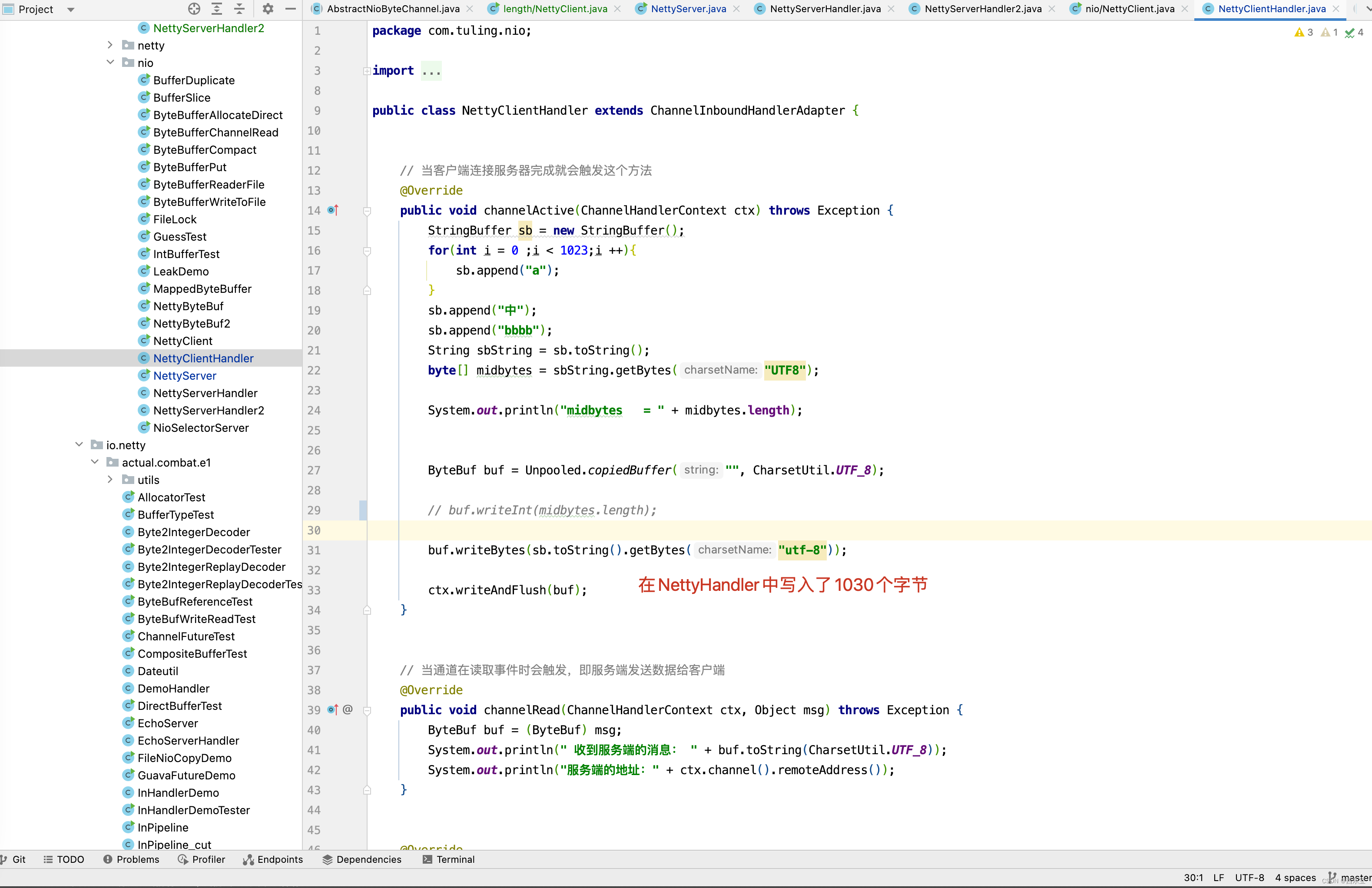
在NettyHandler中实现channelRead()方法,读取并打印出客户端发送过来的数据 。
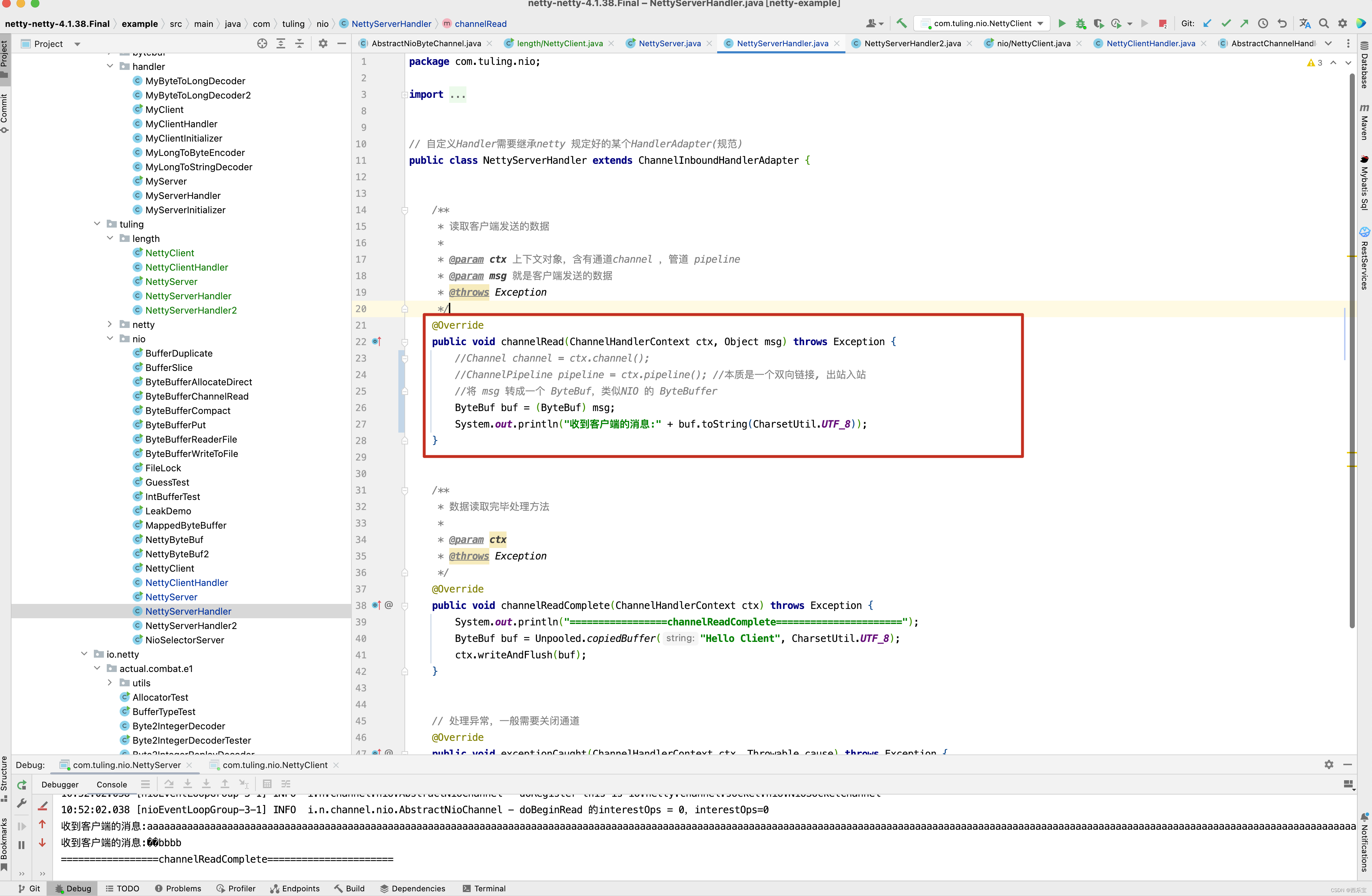
输出打印结果如下 。

毫无疑问,出现了中文乱码,出现中文乱码的原因是什么呢? 在 RecvByteBufAllocator内存分配计算 这篇博客中已经分析过出现问题的原因是Netty默认使用的PooledByteBufAllocator 分配器。
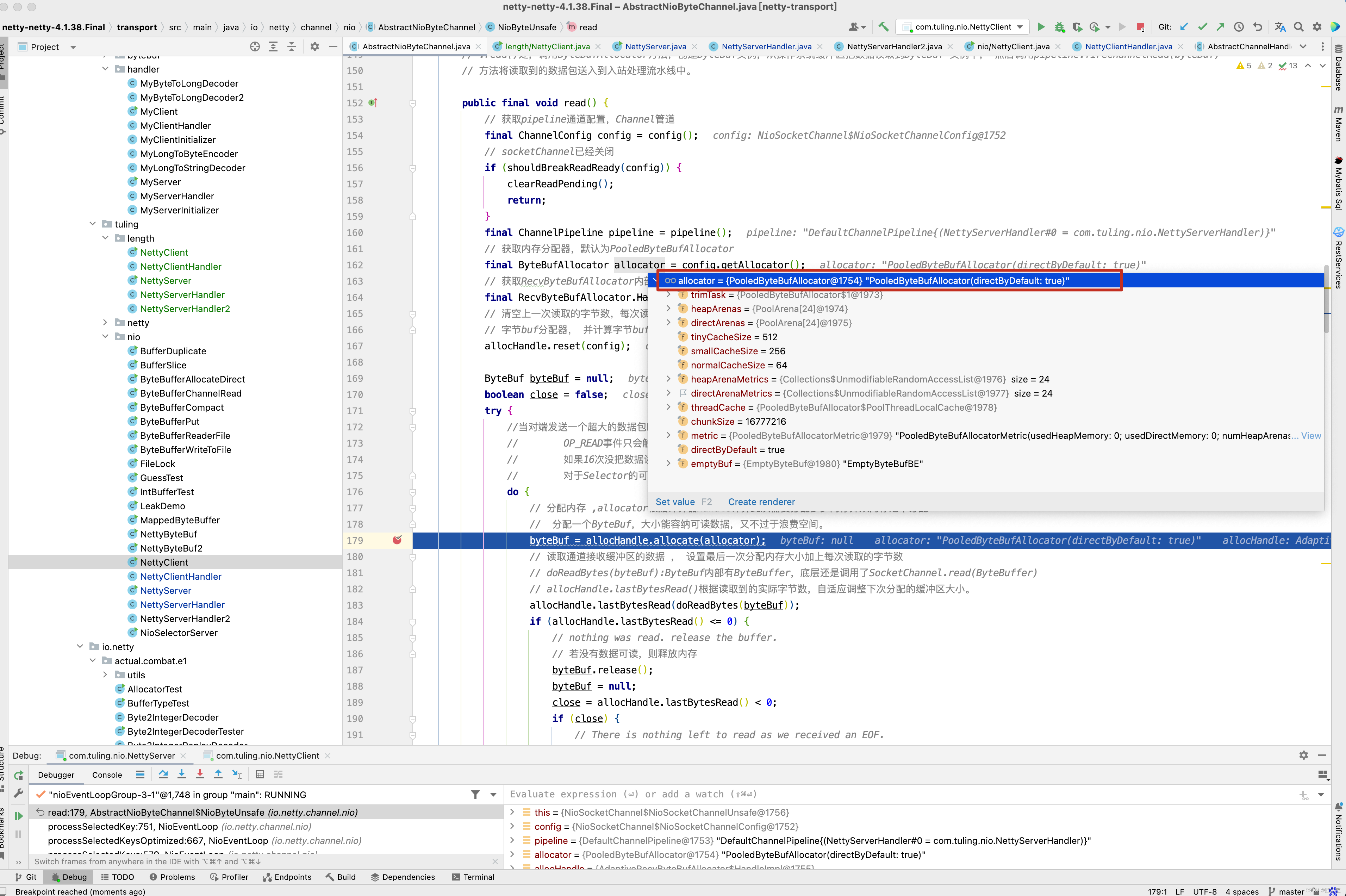
而在第一次调用byteBuf = allocHandle.allocate(allocator) 这一行代码时guess()方法猜测内存大小为1024B。
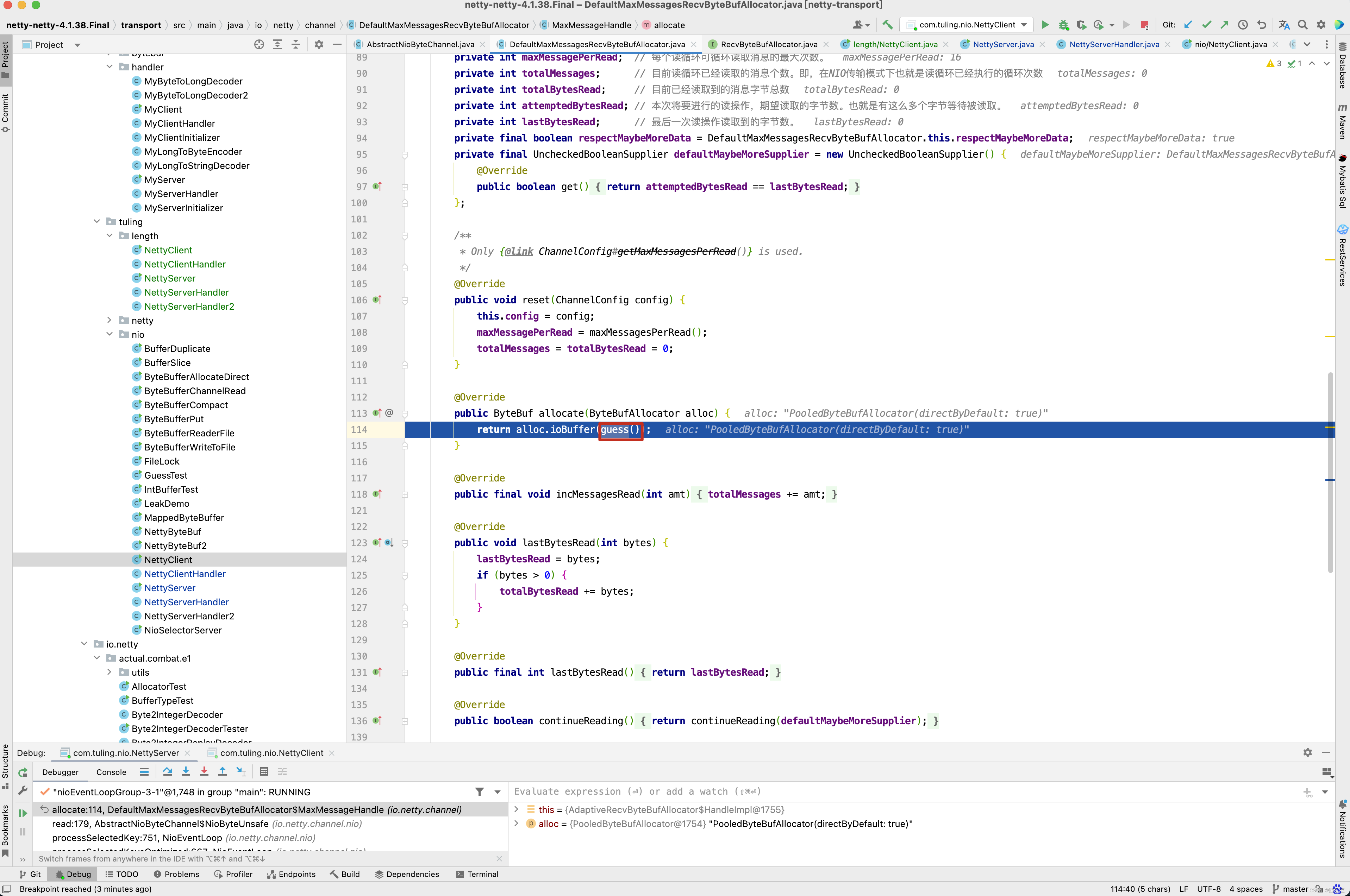
而刚好在传输数据的1024~1026个字节中写入了“中”字。

而PooledByteBufAllocator第一次只创建了一个容量为1024个字节的ByteBuf,因此打印byteBuf中的字节时,出现了中文乱码,在分析解决方案时,还是来看一下打印出乱码的具体细节,而最终调用NettyServerHandler处理器类是通过流水线调用的。
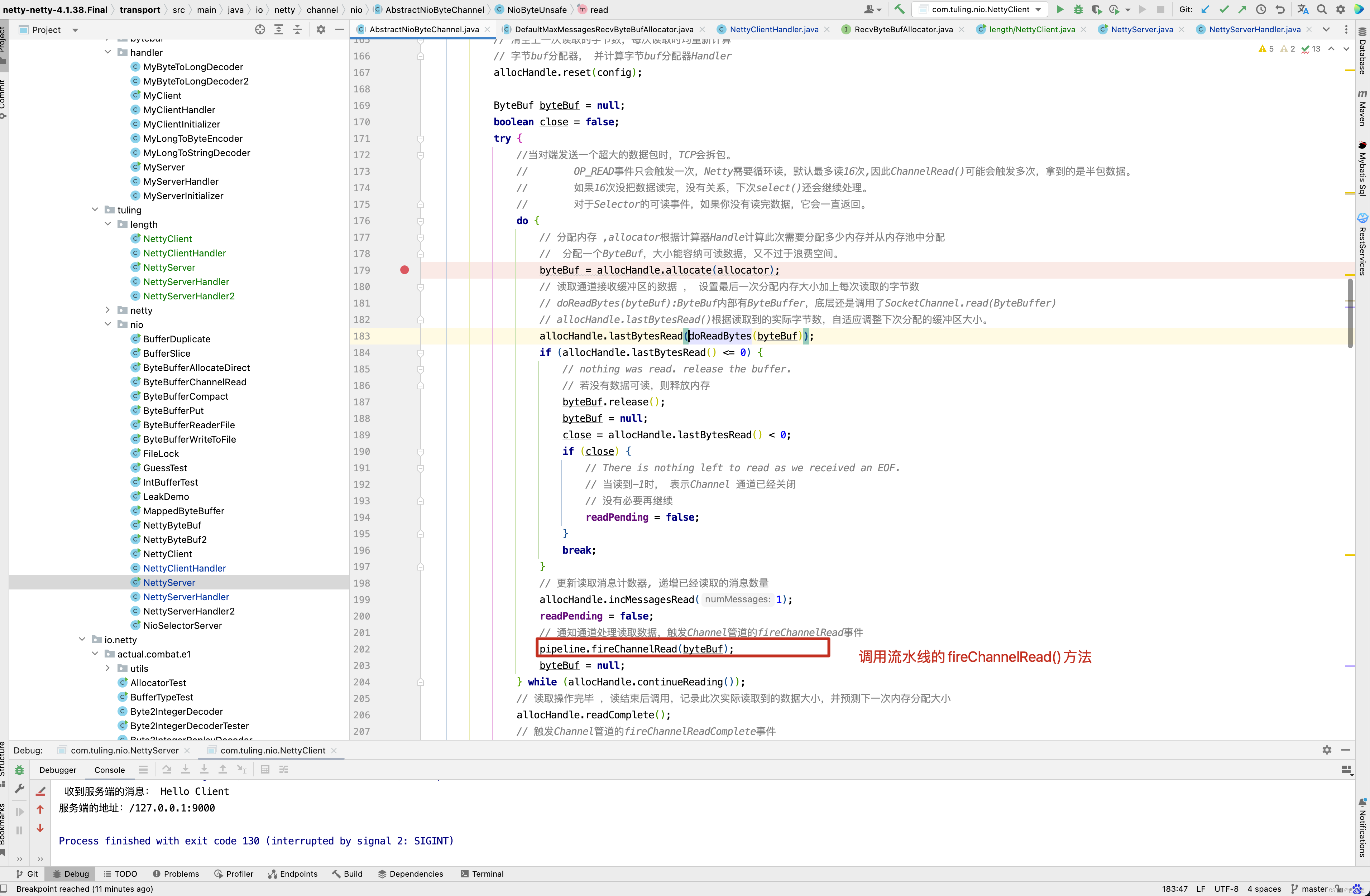
先回顾NettyServerHandler是何时被加入到流水线中的,在ChannelInitializer的initChannel()方法中打一个断点 。

看到了进入了断点,那这个方法时何时被调用的呢? 根据方法调用栈向前回溯 。

看到没有,是在NioSocketChannel的register0()方法中调用了pipeline的invokeHandlerAddedIfNeeded()方法 。 我们继续向前追溯,
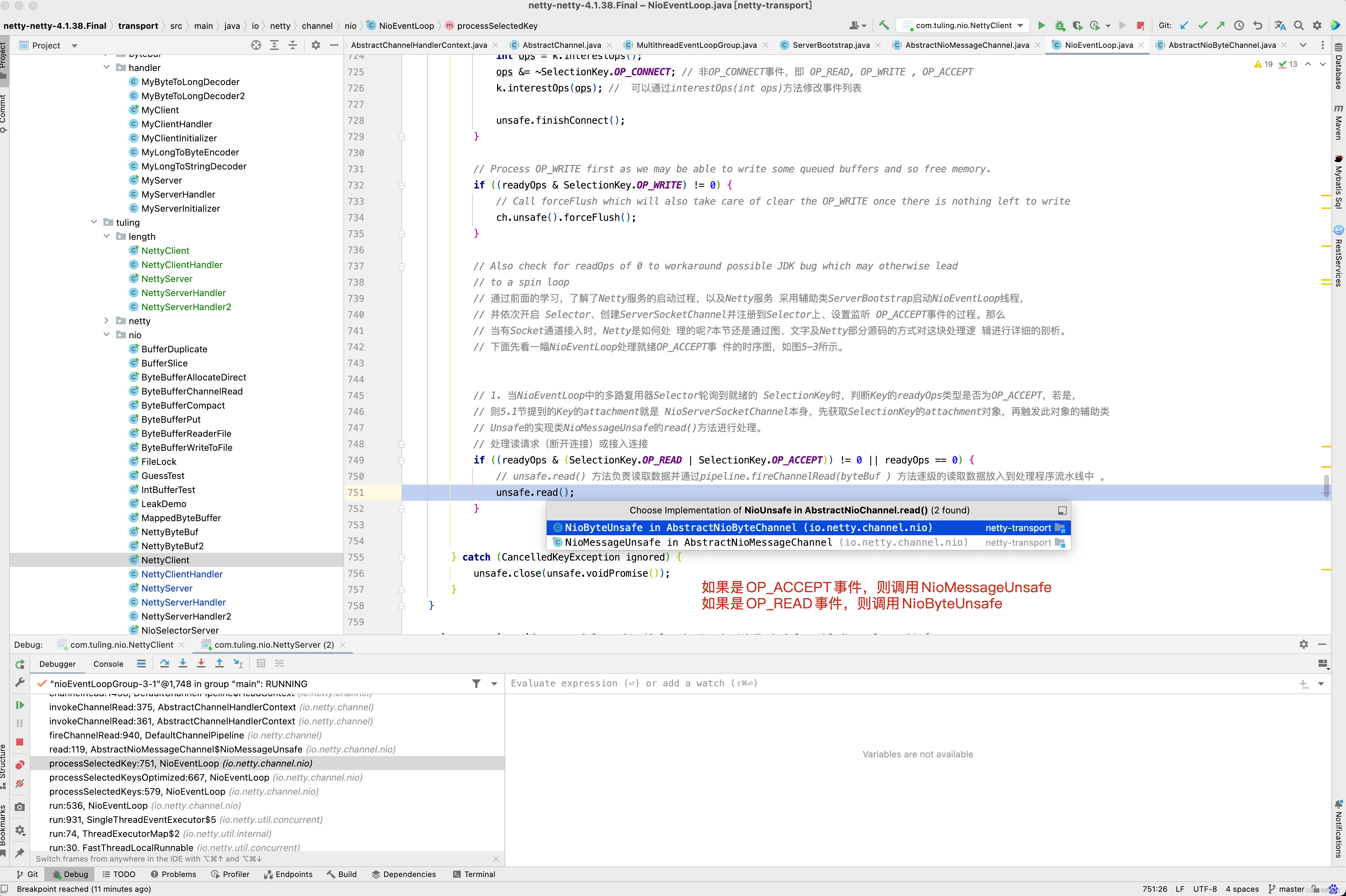
当Netty代码接收到 SelectionKey.OP_ACCEPT时, childGroup.register(child)进行注册,而最终调用了我们自定义的ChannelInitializer 的initChannel()方法,将自定义的handler加入到流水线中。

我们来分析这一块代码的整体逻辑。
-
首先调用了bootstrap.bind(9000)方法
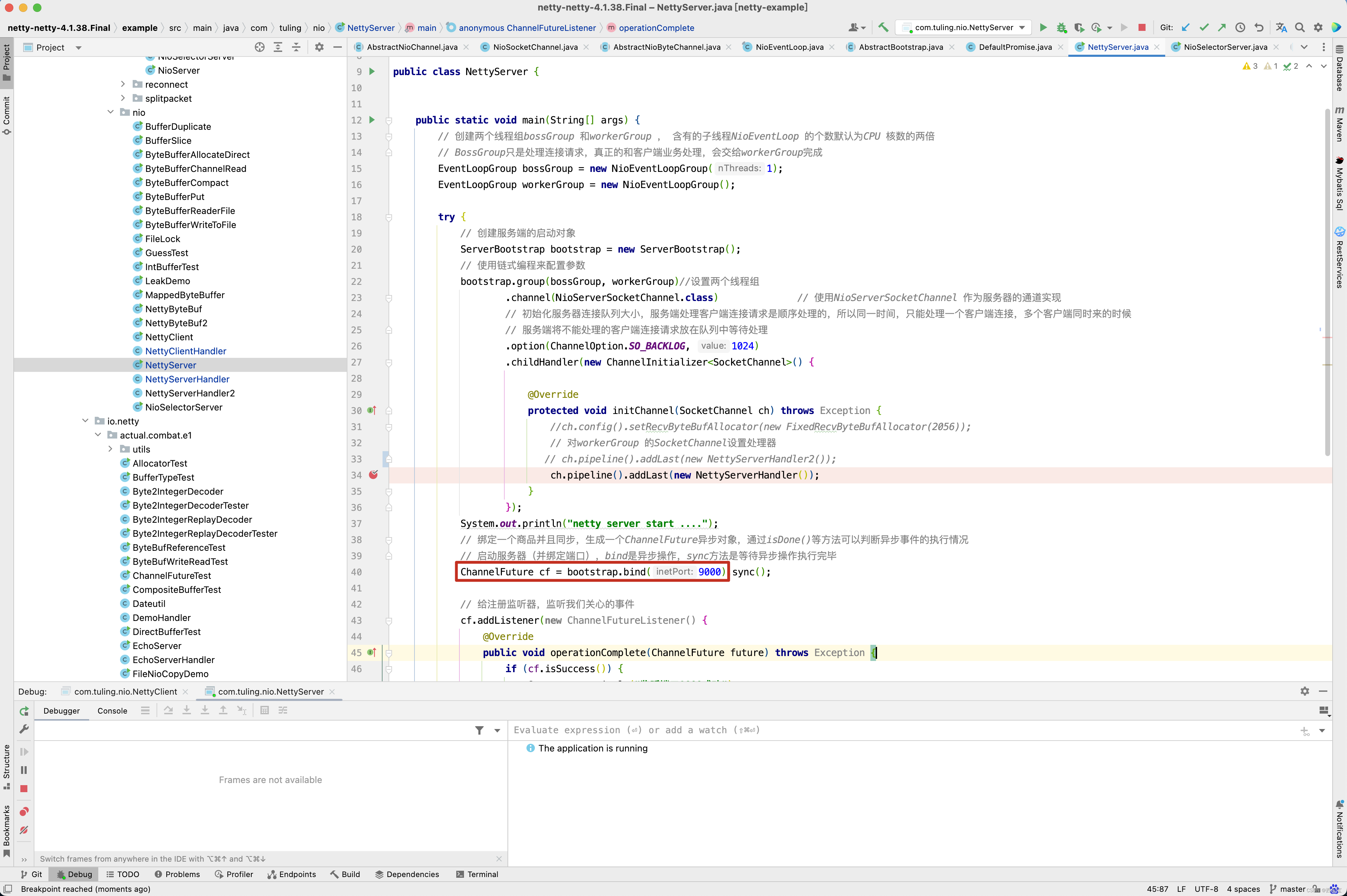
-
最终调用了NioSocketChannel的doBeginRead()方法注册了OP_ACCEPT事件 。
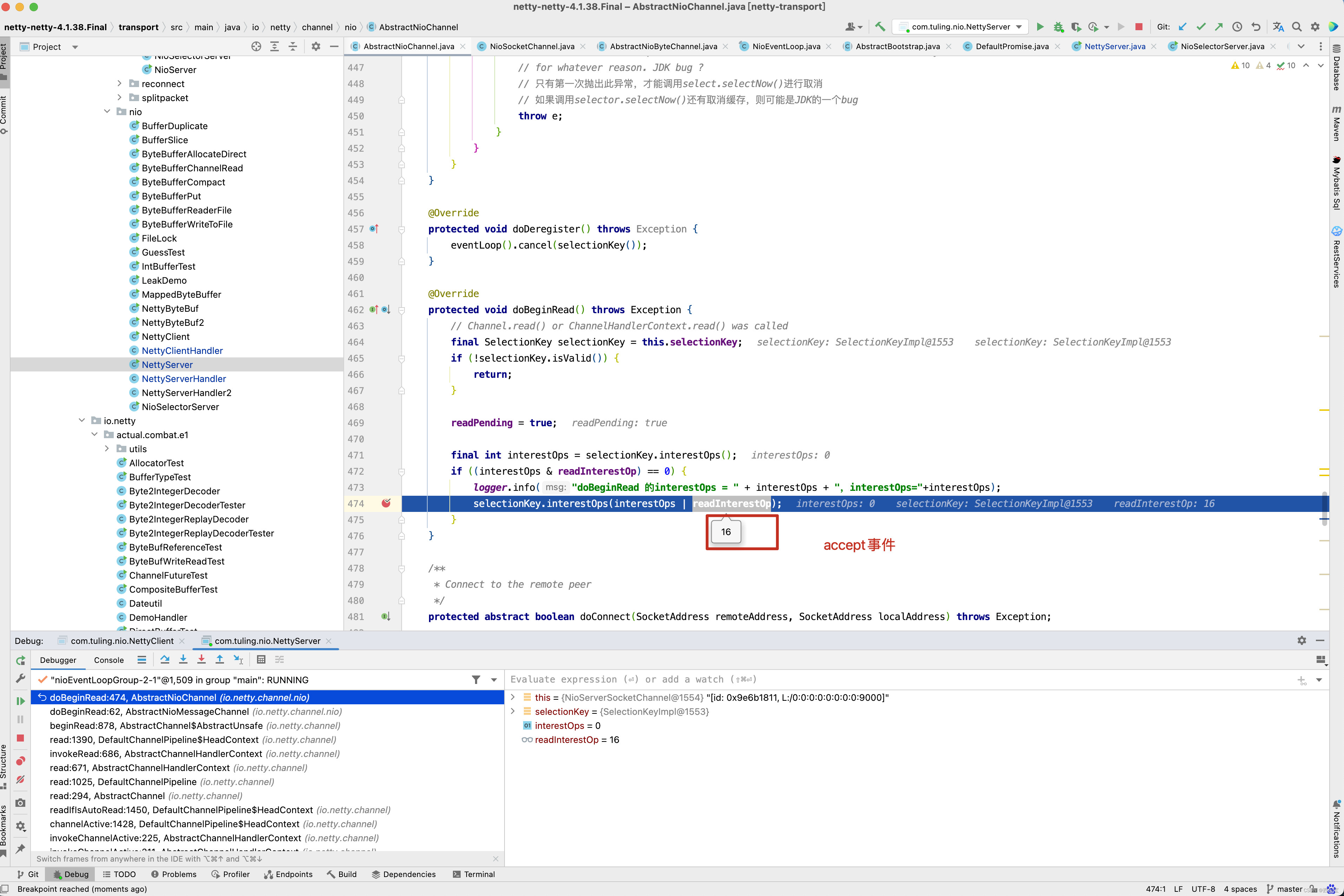
-
同时启动了一个线程,不断的死循环,监听OP_ACCEPT
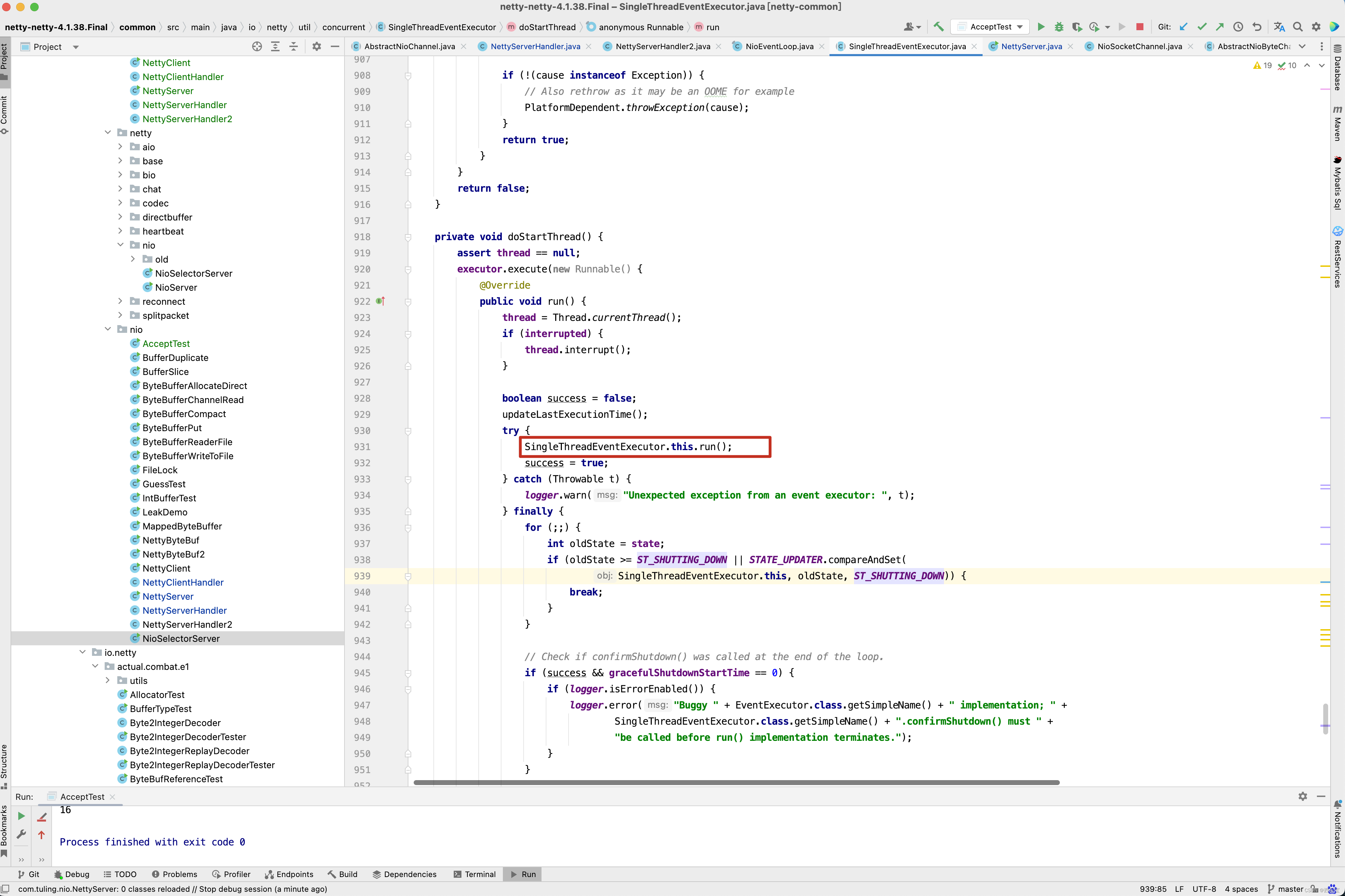
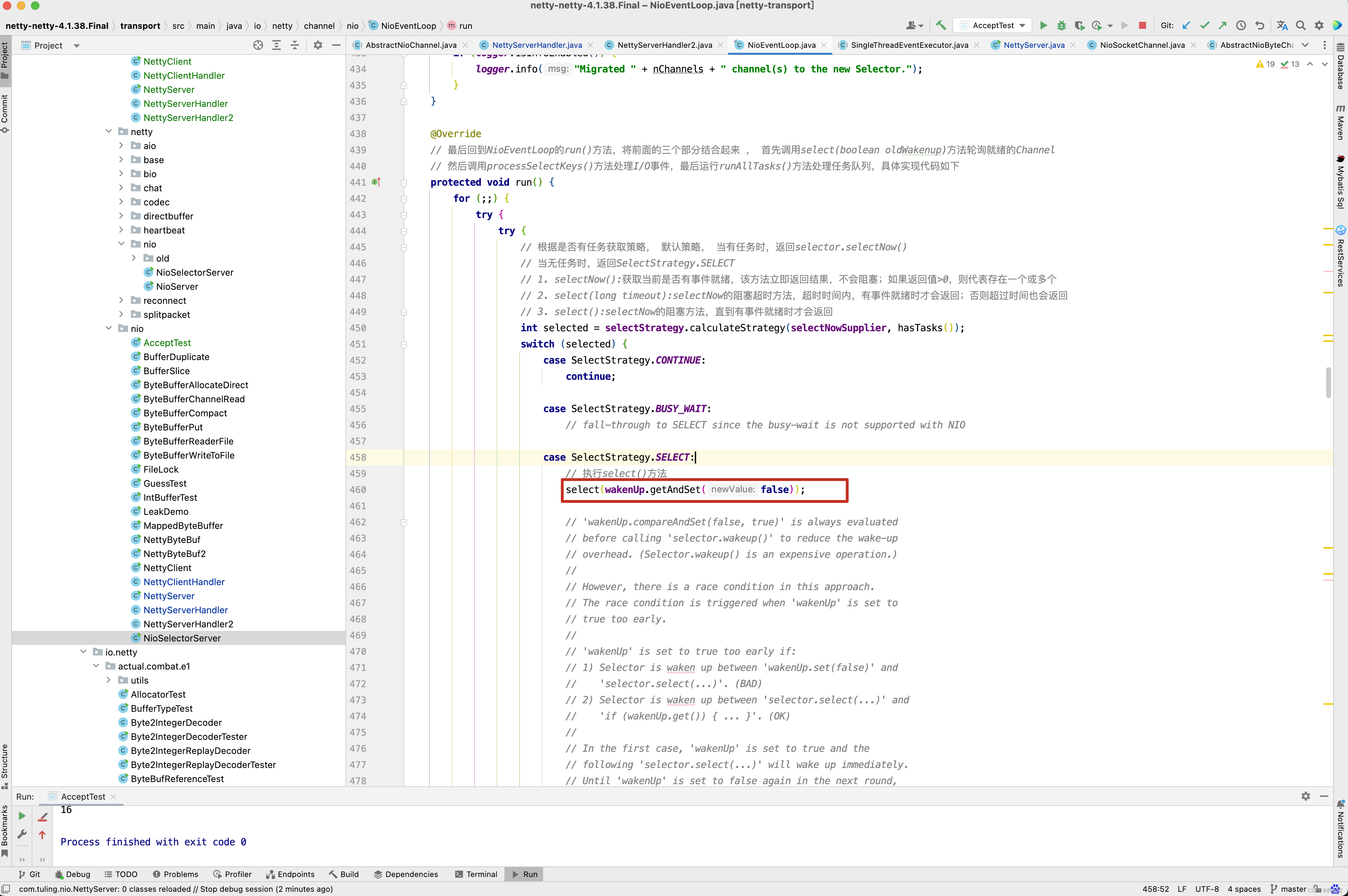
-
如果监听到了SelectionKey.OP_ACCEPT事件
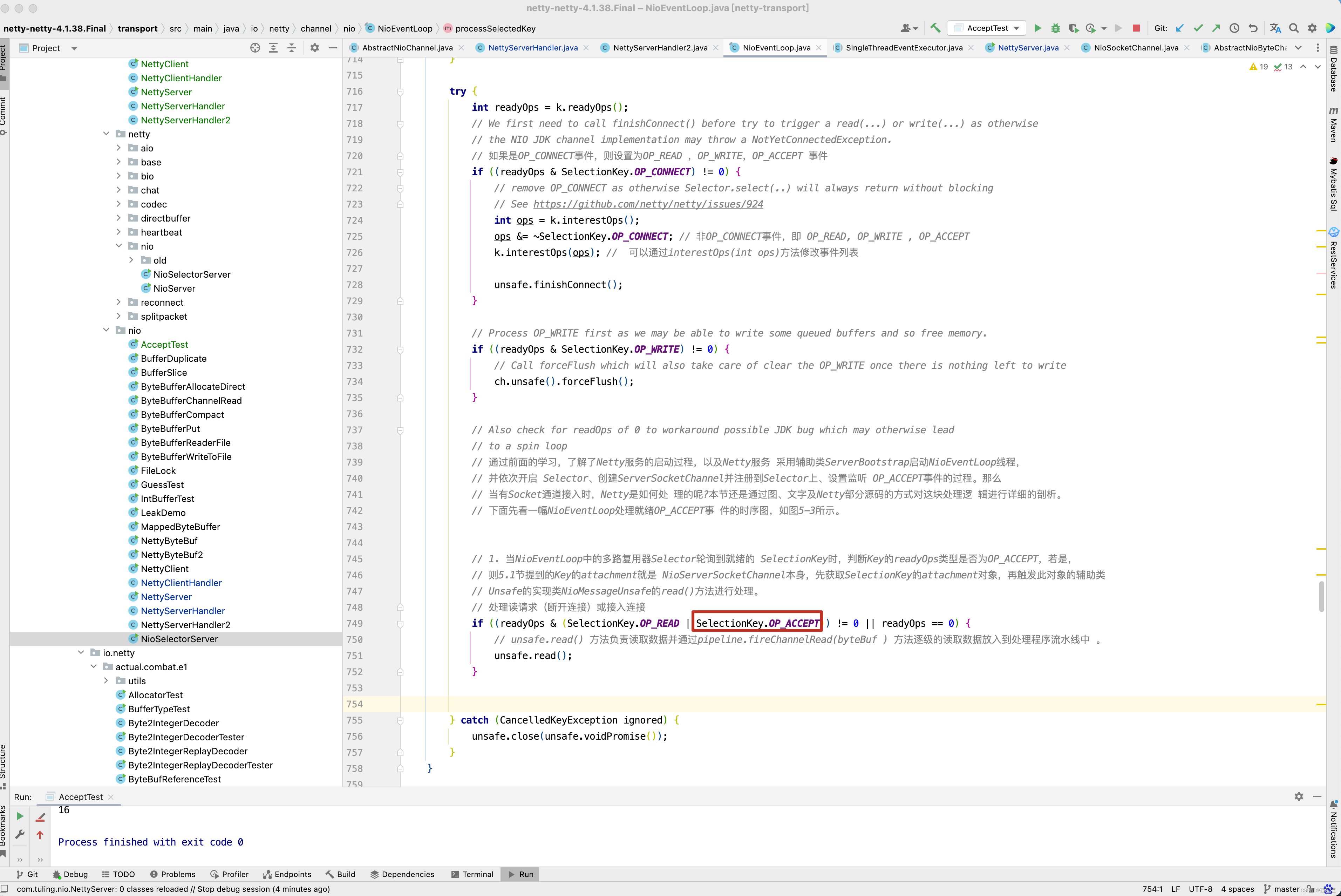
-
当有SelectionKey.OP_ACCEPT事件到来之时,会调用unsafe.read()方法。

-
此时会触发childGroup.register(child)方法调用 。
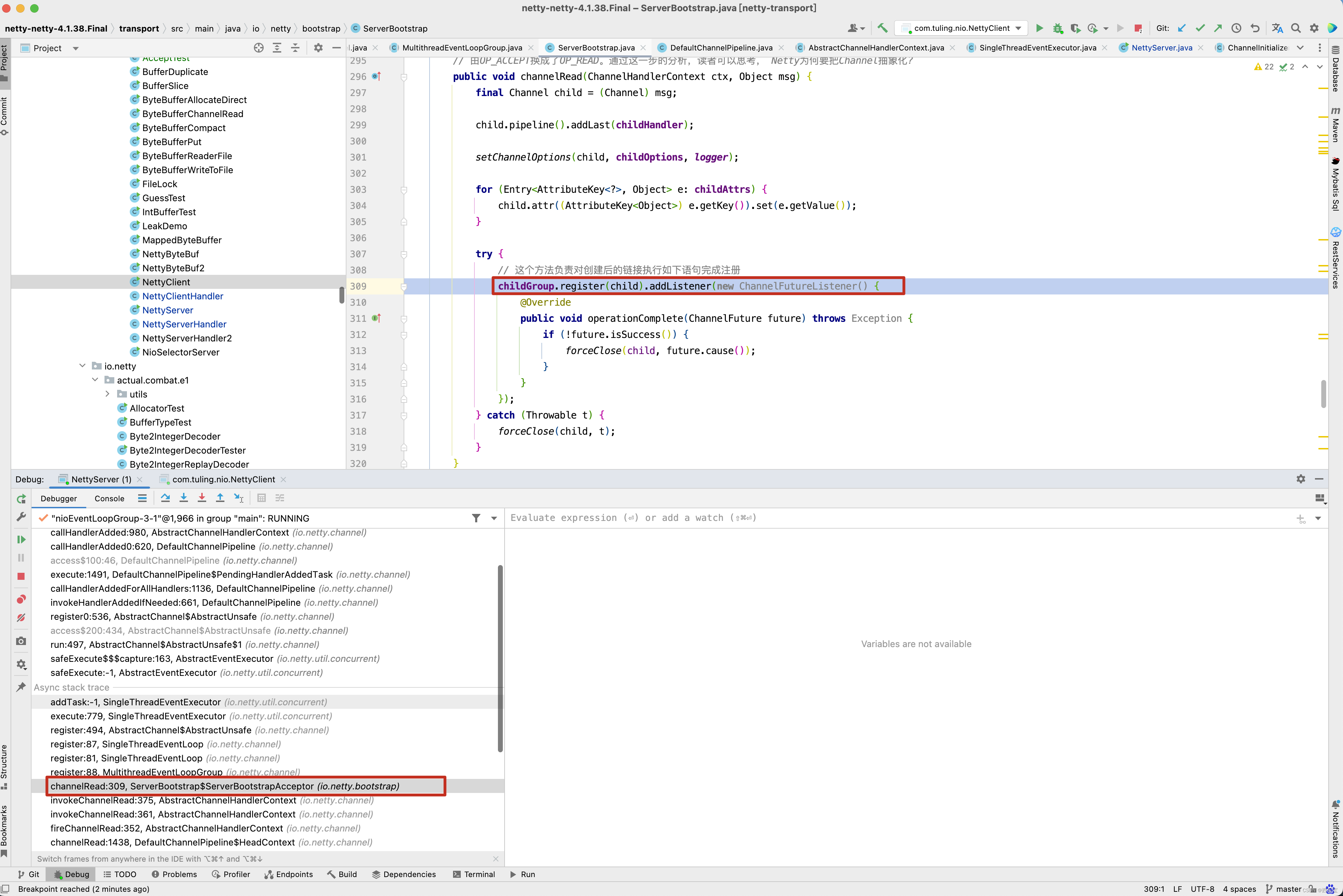
-
在childGroup的register0()方法中,先会触发pipeline.invokeHandlerAddedIfNeeded()调用,接着会调用我们自定义的ChannelInitializer的initChannel()方法。

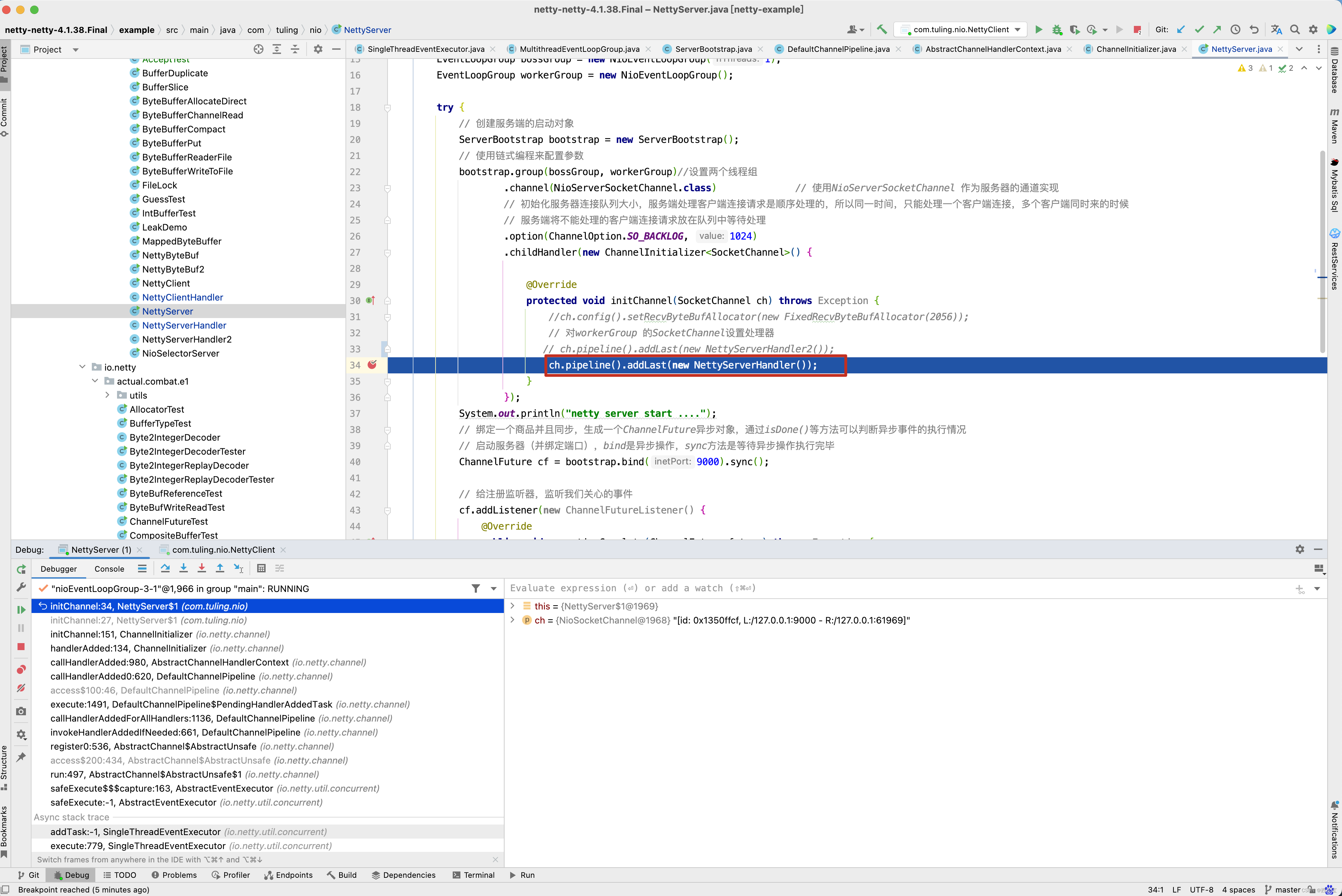
-
当然在此之前会注册一个ops=0 的无效事件。
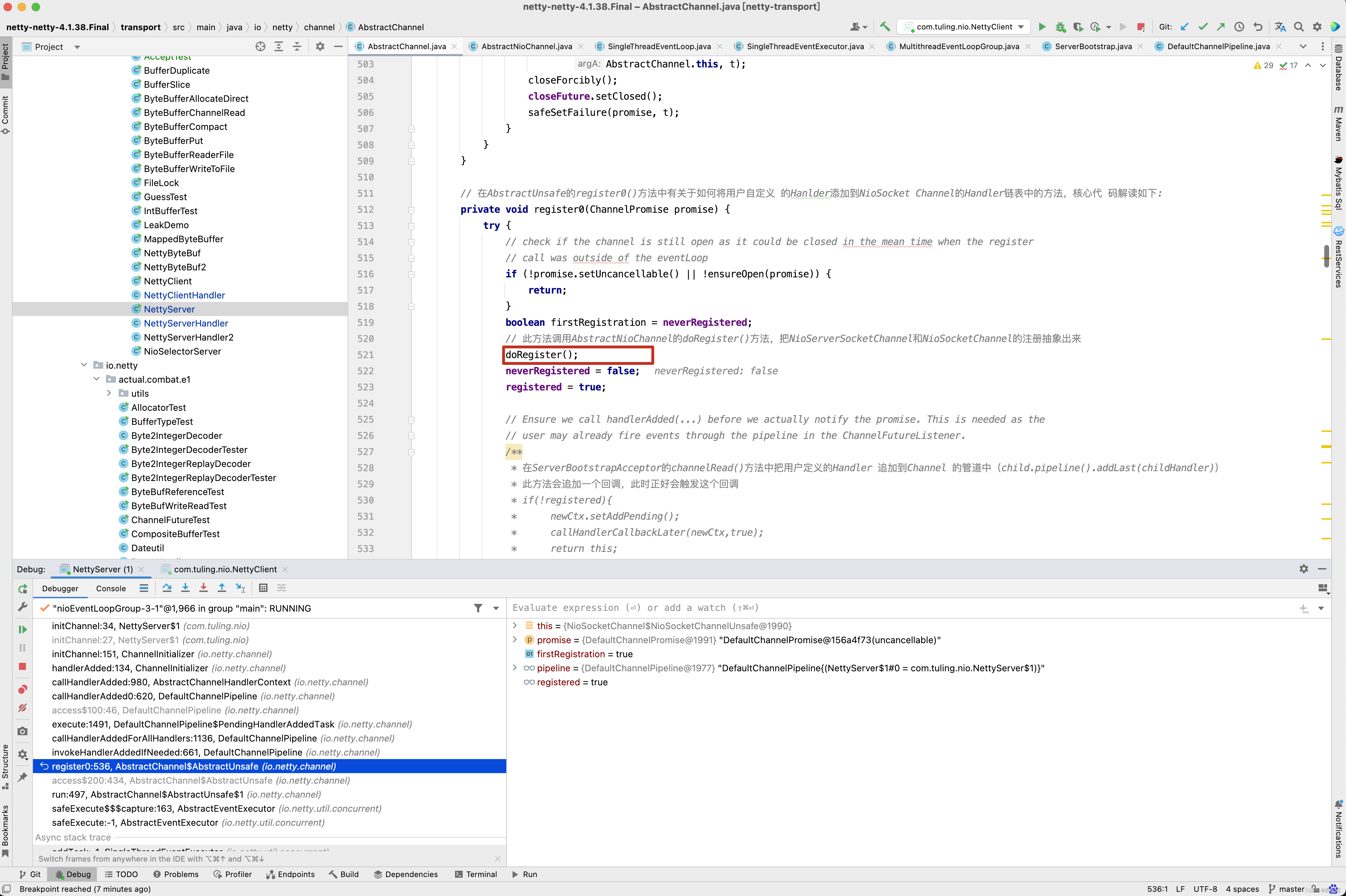
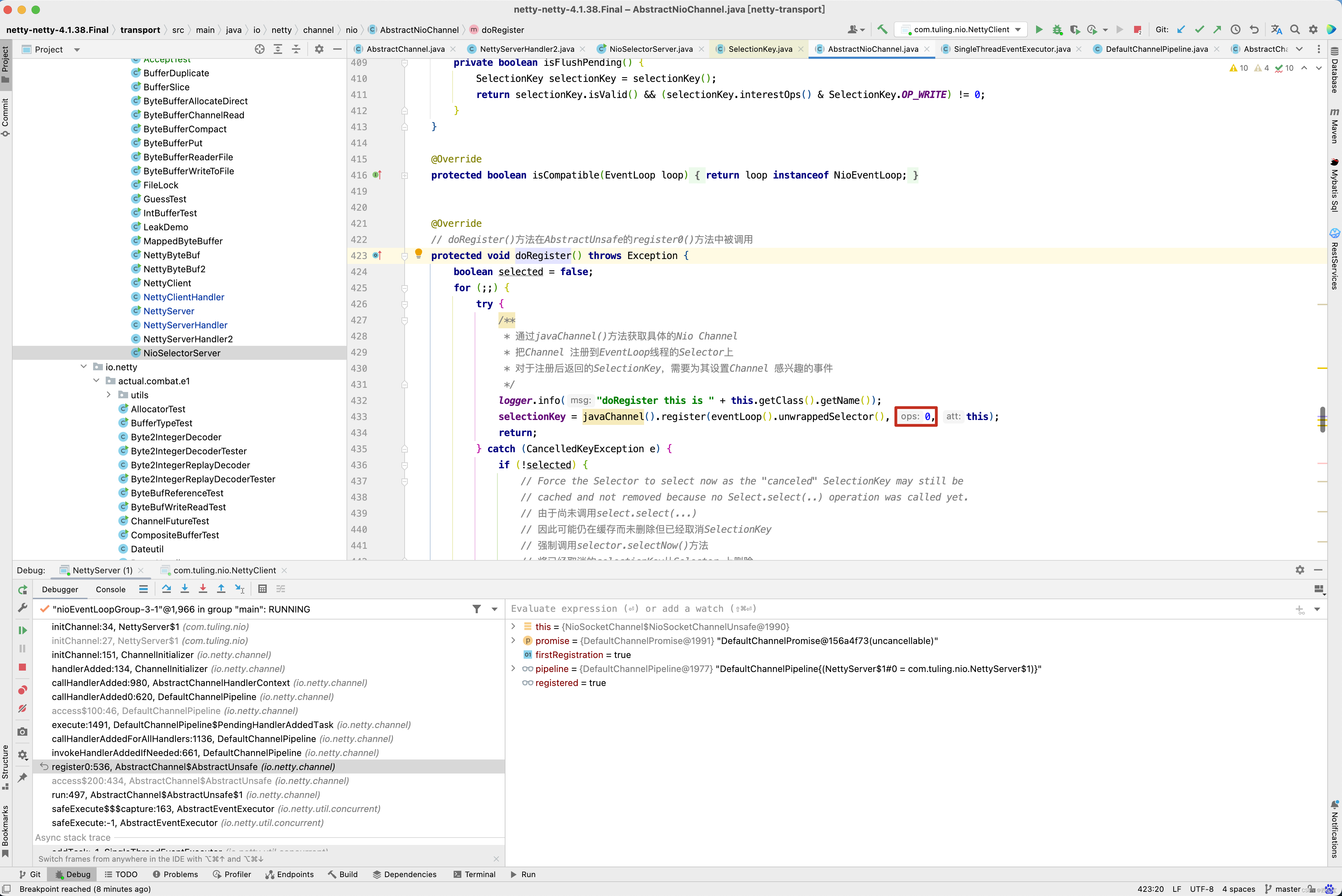
-
当然在最后的 pipeline.fireChannelActive() 方法中调用AbstractNioChannel的doBeginRead()方法注册监听OP_READ事件。
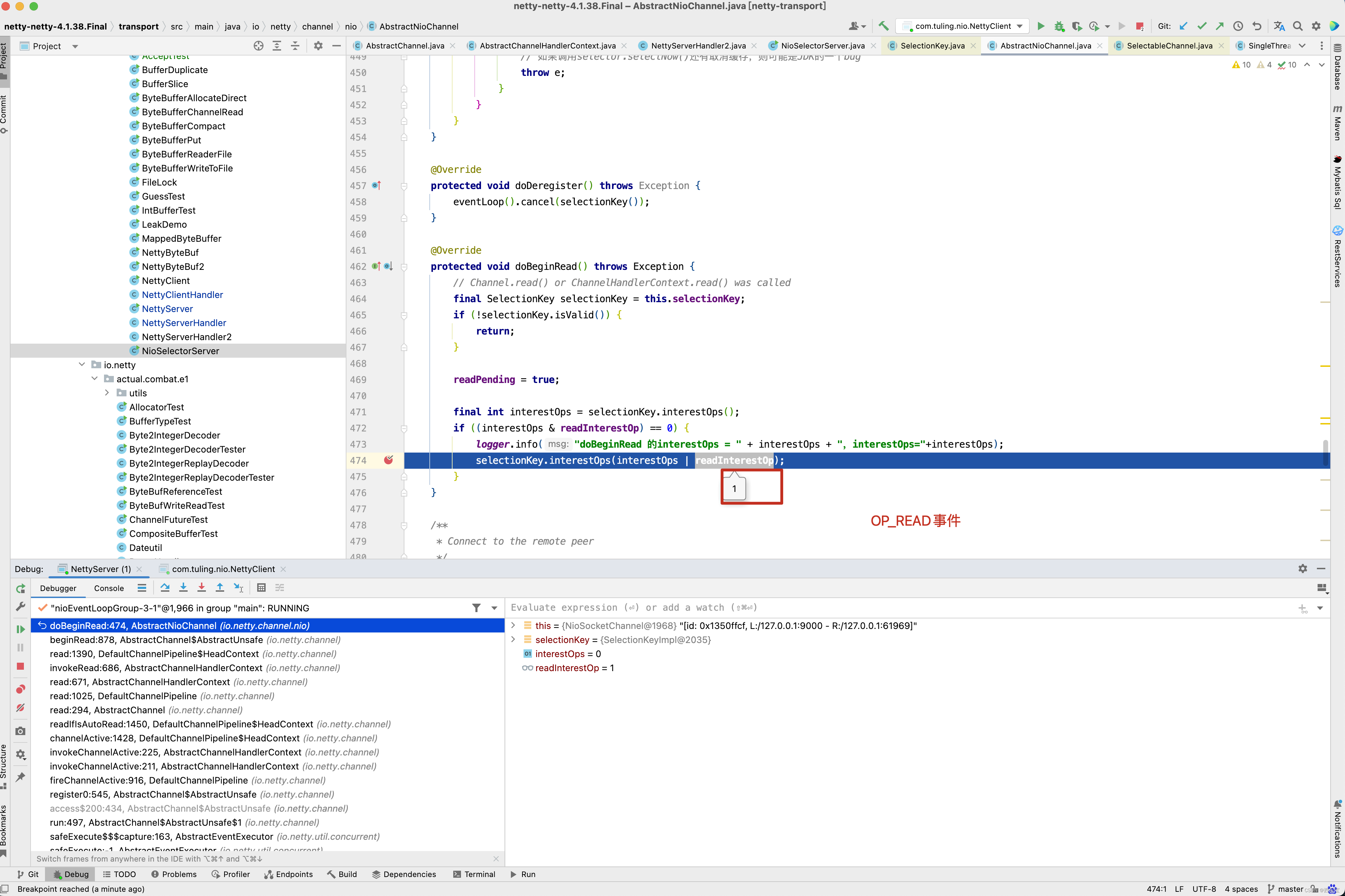
此时此刻,是不是已经有了OP_READ事件监听方法 ,当有OP_READ事件触发时。

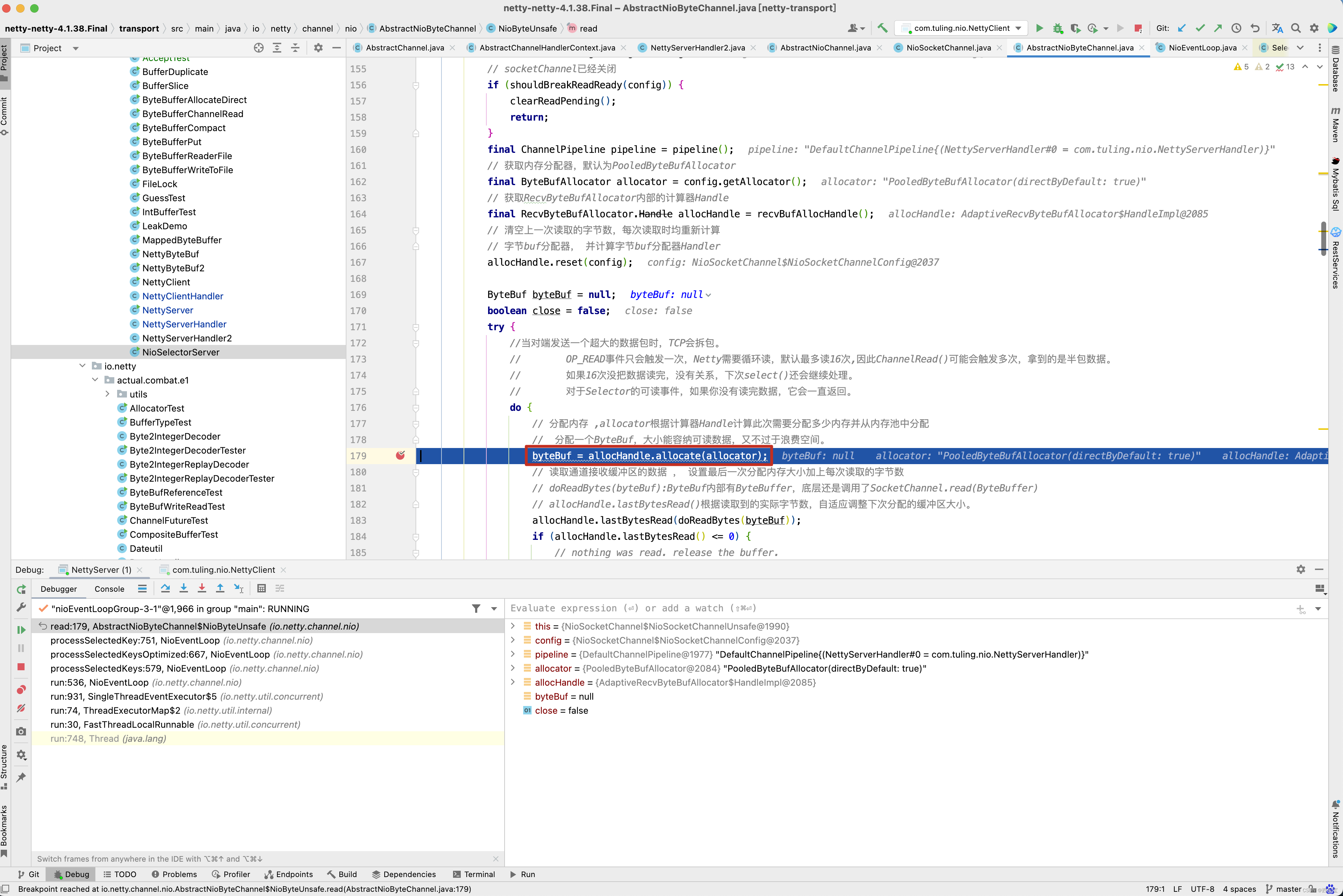
最终开始调用doReadBytes()将channel中的数据读取到byteBuf中。 前面的分析,是对之前代码的回顾,也是对接下来的源码分析做辅垫,接下来从ch.pipeline().addLast(new NettyServerHandler())中分析,看Netty如何将我们自定义的NettyServerHandler加入到流水线中。
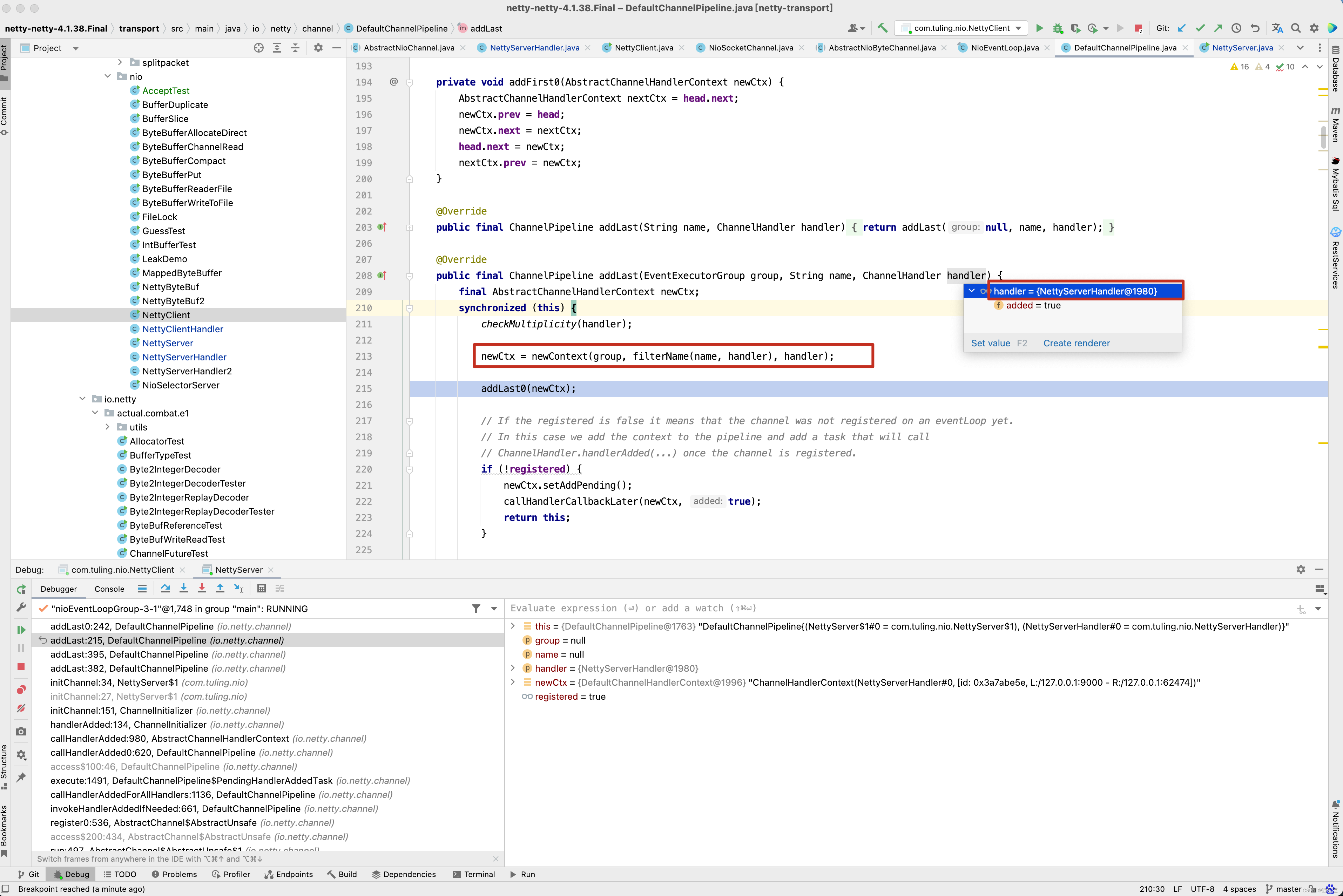
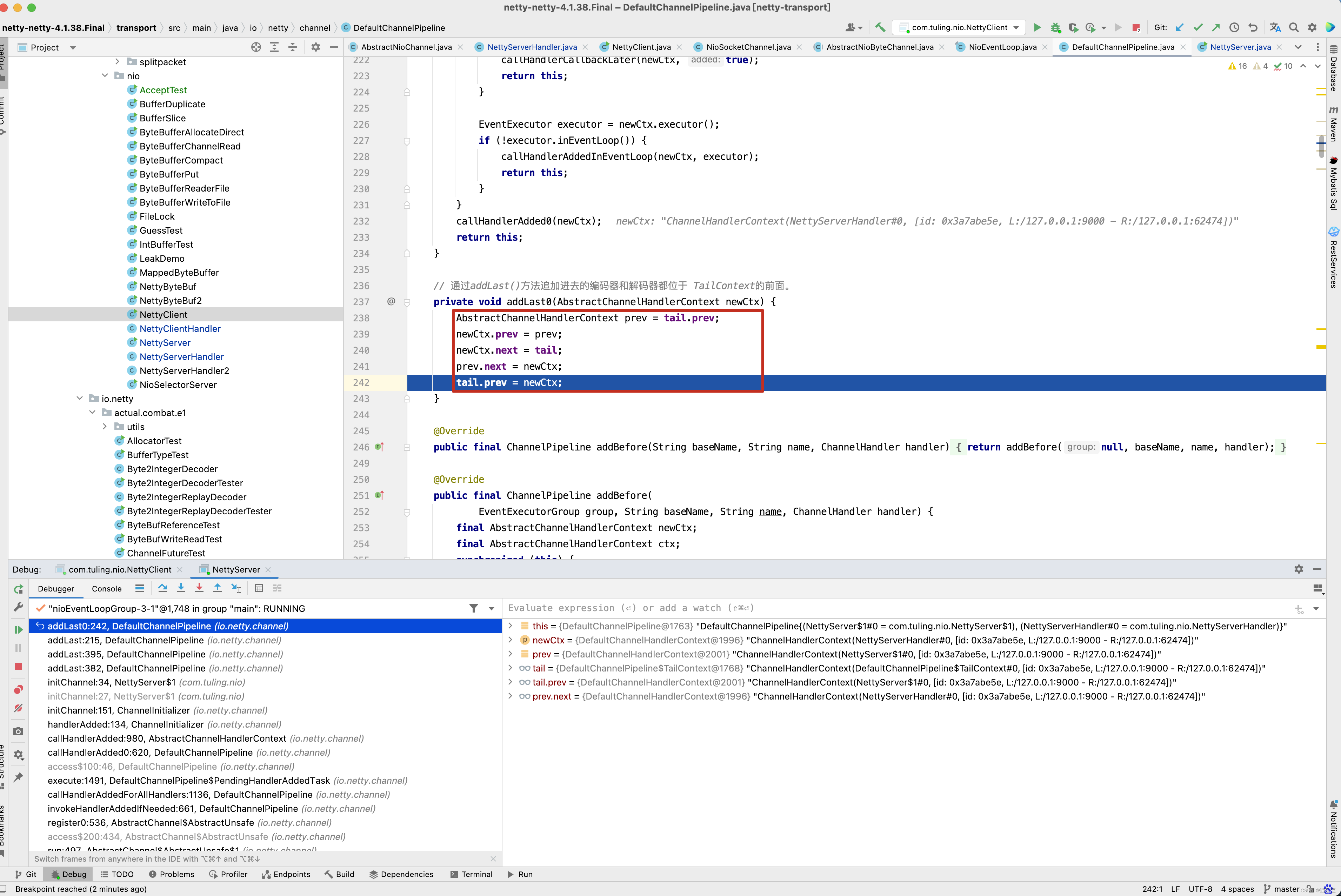
从截图中可以看出,我们自定义的NettyServerHandler首先封装成了一个DefaultChannelHandlerContext,添加到了tail节点有前面。
接下来在我们自定义的NettyServerHandler的channelRead()方法中打一个断点,从方法的调用栈中来看。 首先会调用 DefaultChannelPipeline的fireChannelRead(byteBuf)方法 。

接着通过反射调用head的channelRead()方法 ,如下图所示。
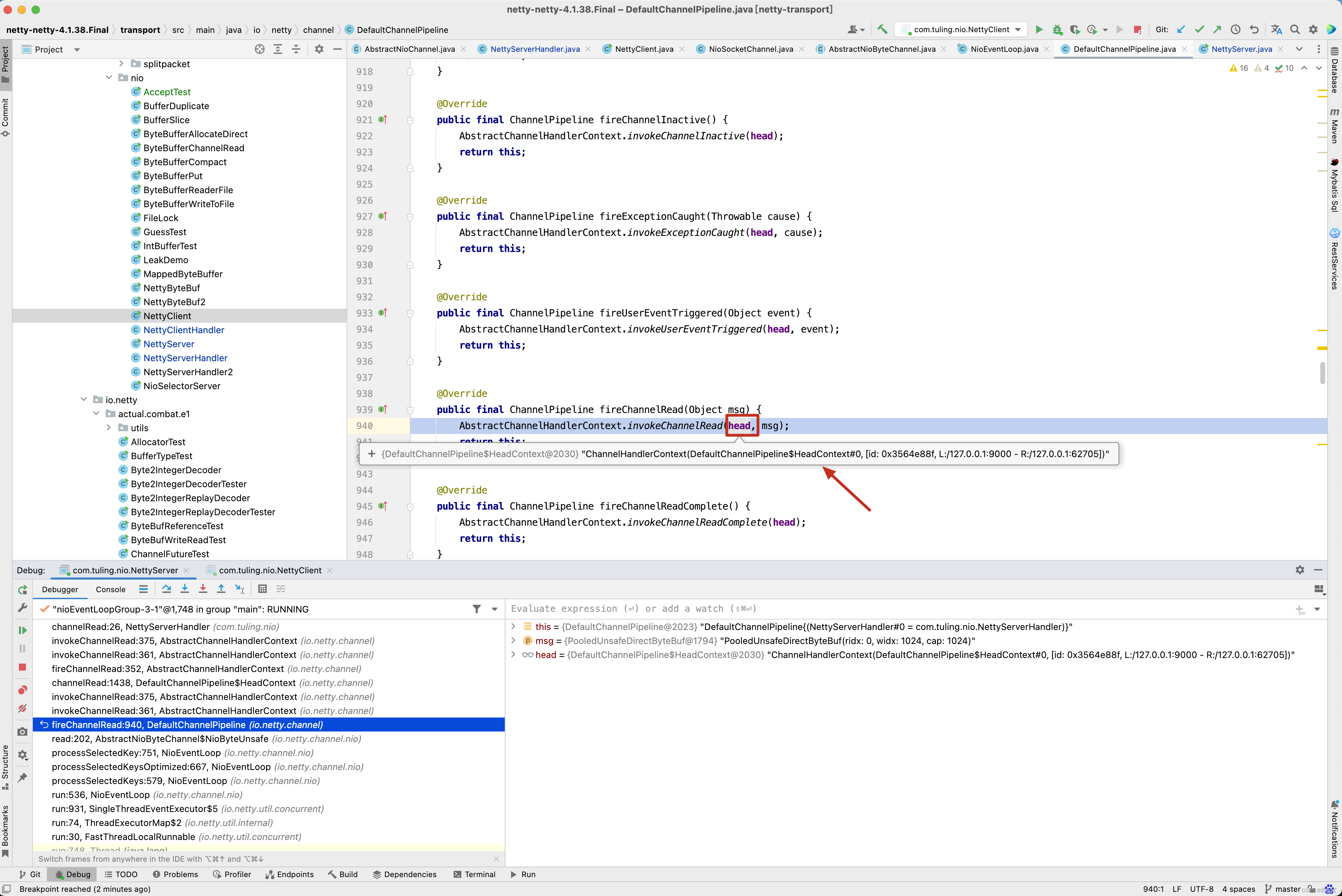
而在head的channelRead()方法中实际上是调用ctx.fireChannelRead(msg)方法,而fireChannelRead()方法实际上调用的是invokeChannelRead(findContextInbound(MASK_CHANNEL_READ), msg)方法,而findContextInbound()方法内部又是找到了next。

而next是一个Context,而Context就是获取到其Handler并调用Handler的channelRead(this, msg)方法。

再看下面的图。
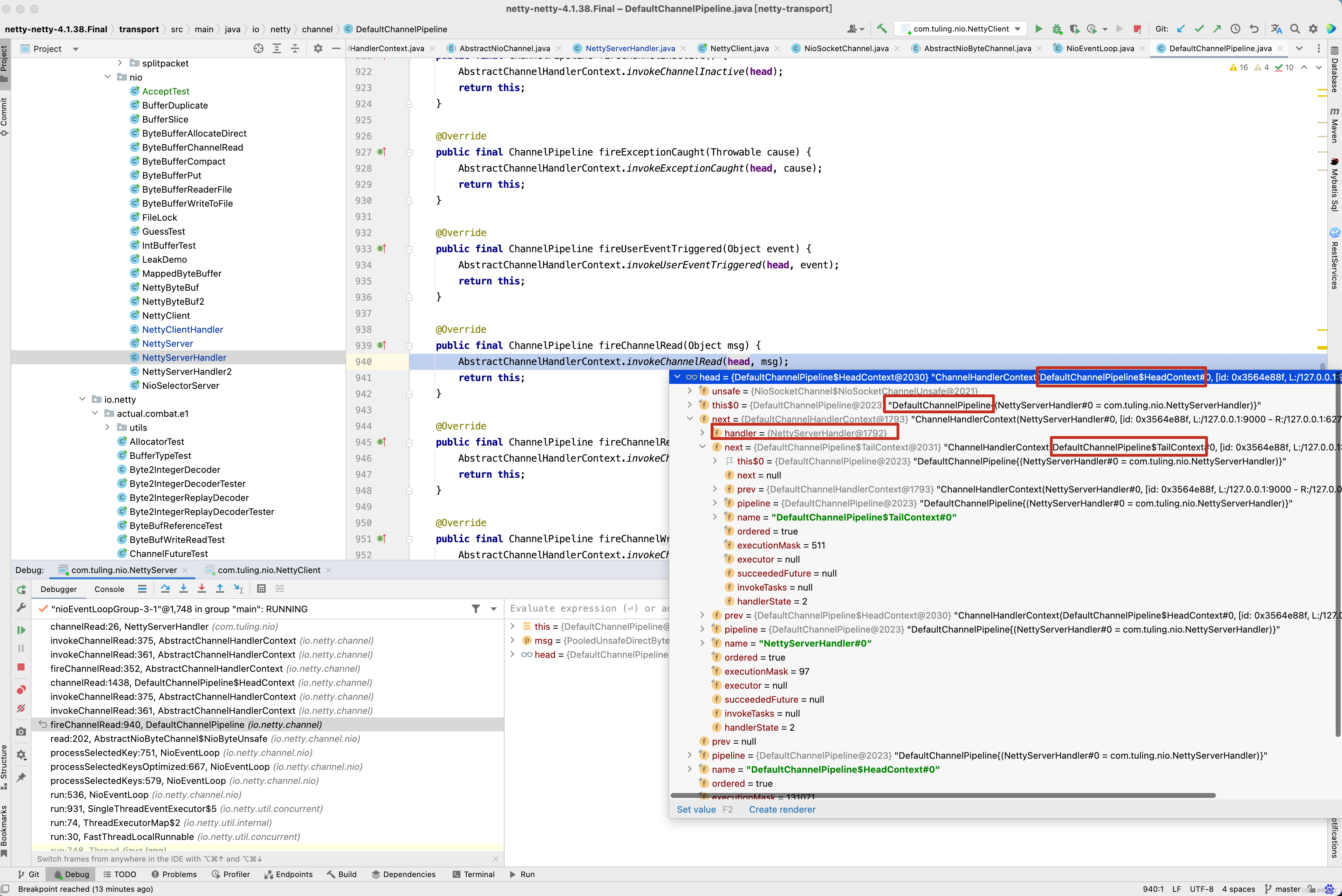
从下面的图中,已经很清楚整个流水线的执行流程了,调用pipeline的fireChannelRead()方法,而fireChannelRead()方法首先调用HeadContext的channelRead()方法,而HeadContext的channelRead()方法并没有做其他事情,而是找到next Context,并调用其invokeChannelRead()方法,而默认Context的内部实际上他的handler的channelRead()方法,当然,对于传递过来的ByteBuf数据,对于不同的业务做不同的处理,那么再写一个NettyServerHandler3,代码的实现逻辑一样,打印出ByteBuf的内容 。

并加入到流水线中。
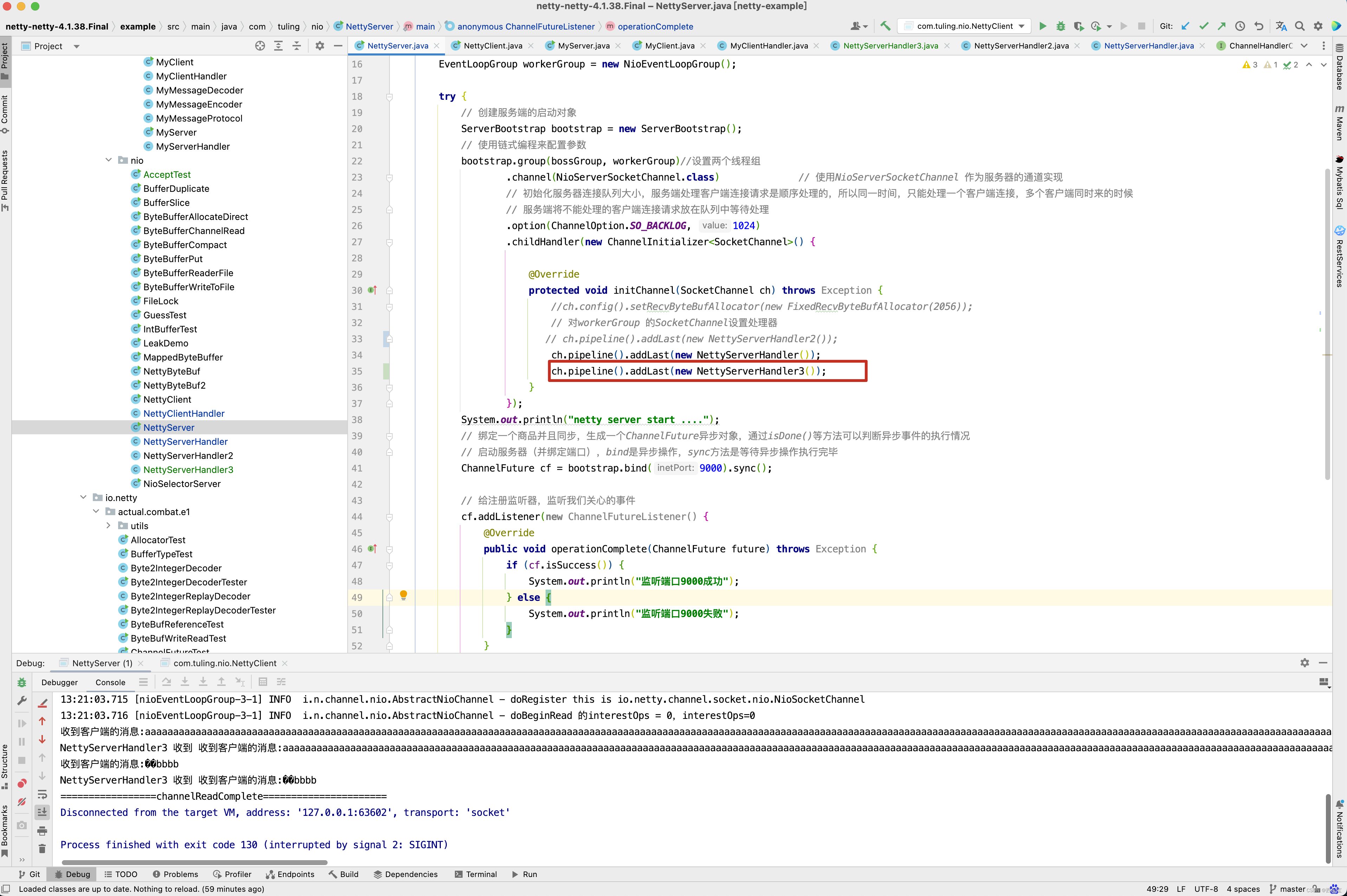
但遗憾的是, NettyServerHandler3中的channelRead()方法并没有执行。
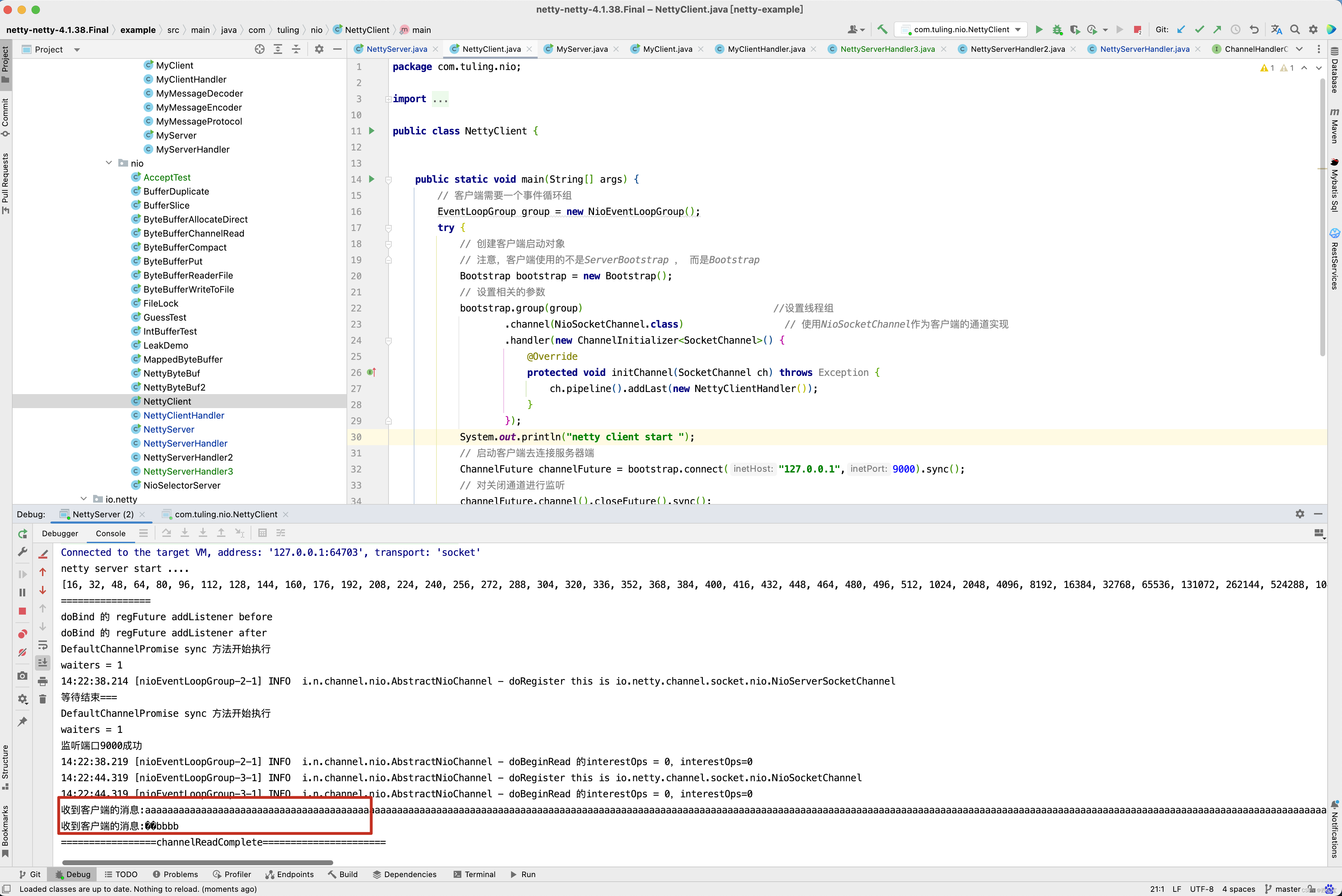
原因是什么呢? 还是回头看DefaultChannelHandlerContext方法 。invokeChannelRead()方法调用了Handler的channelRead()方法,此时就中断了。并没有调用next Context的fireChannelRead()方法。
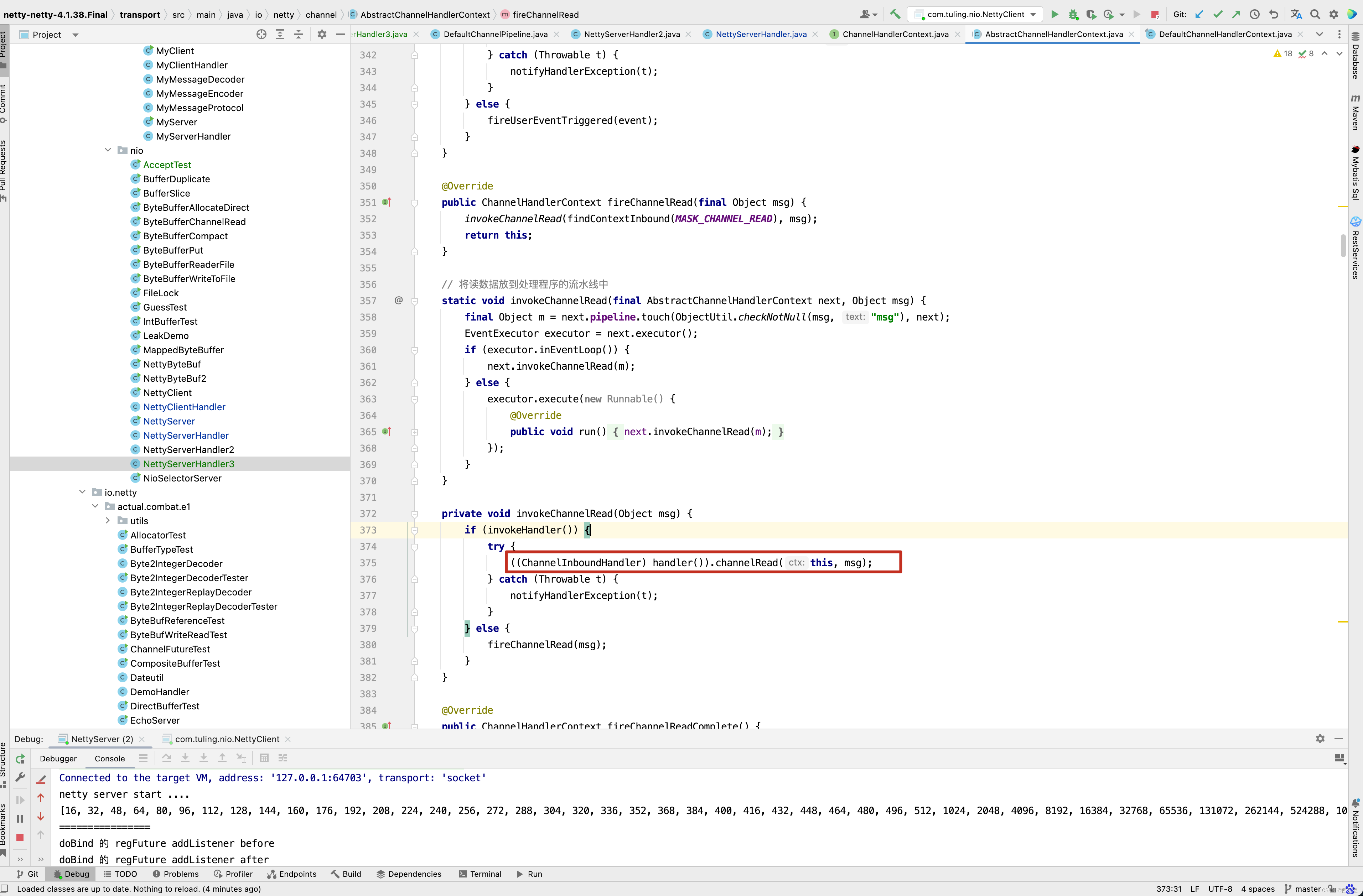
而为什么HeadContext会调用next Context的invokeChannelRead()方法呢?
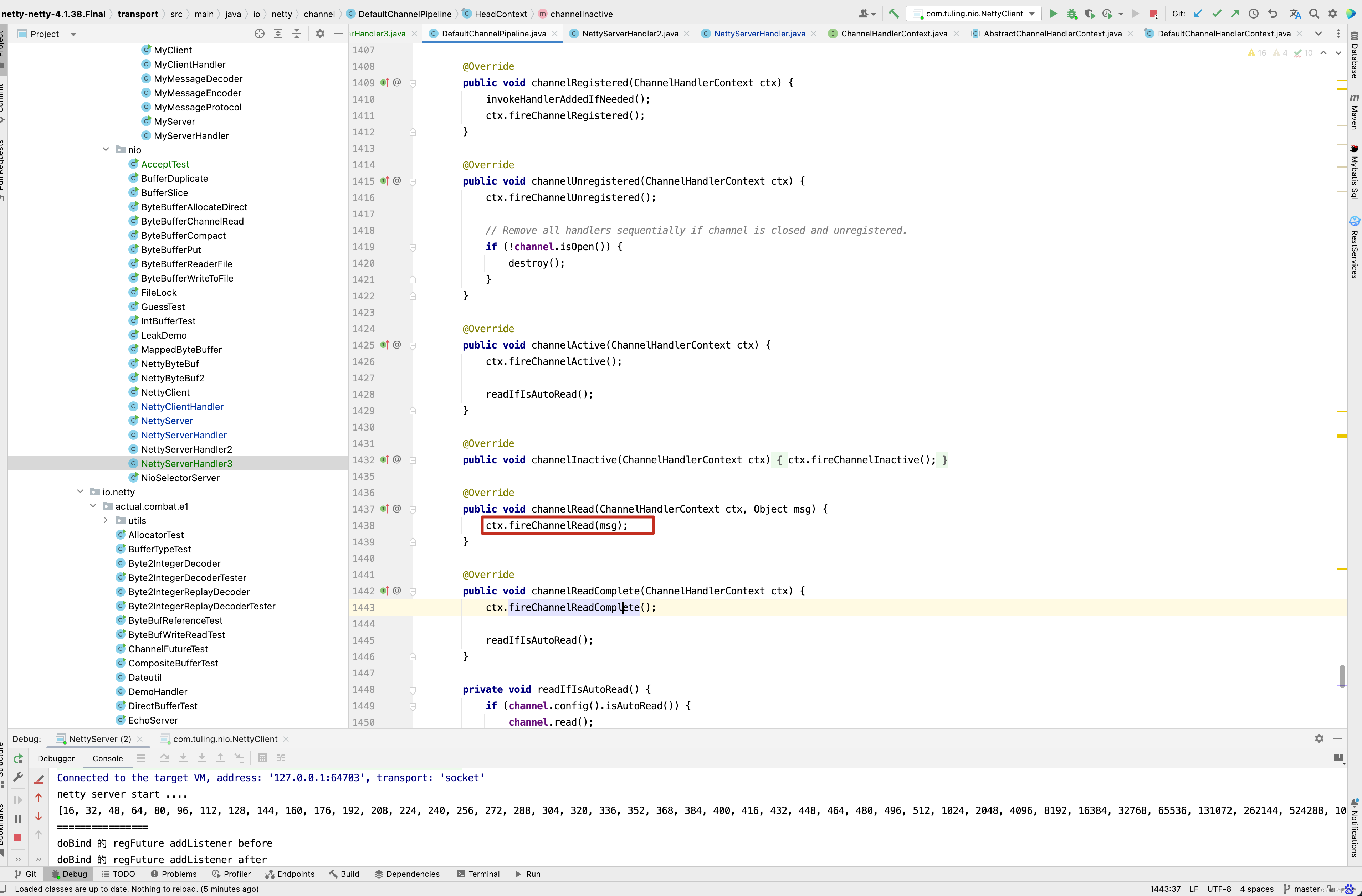
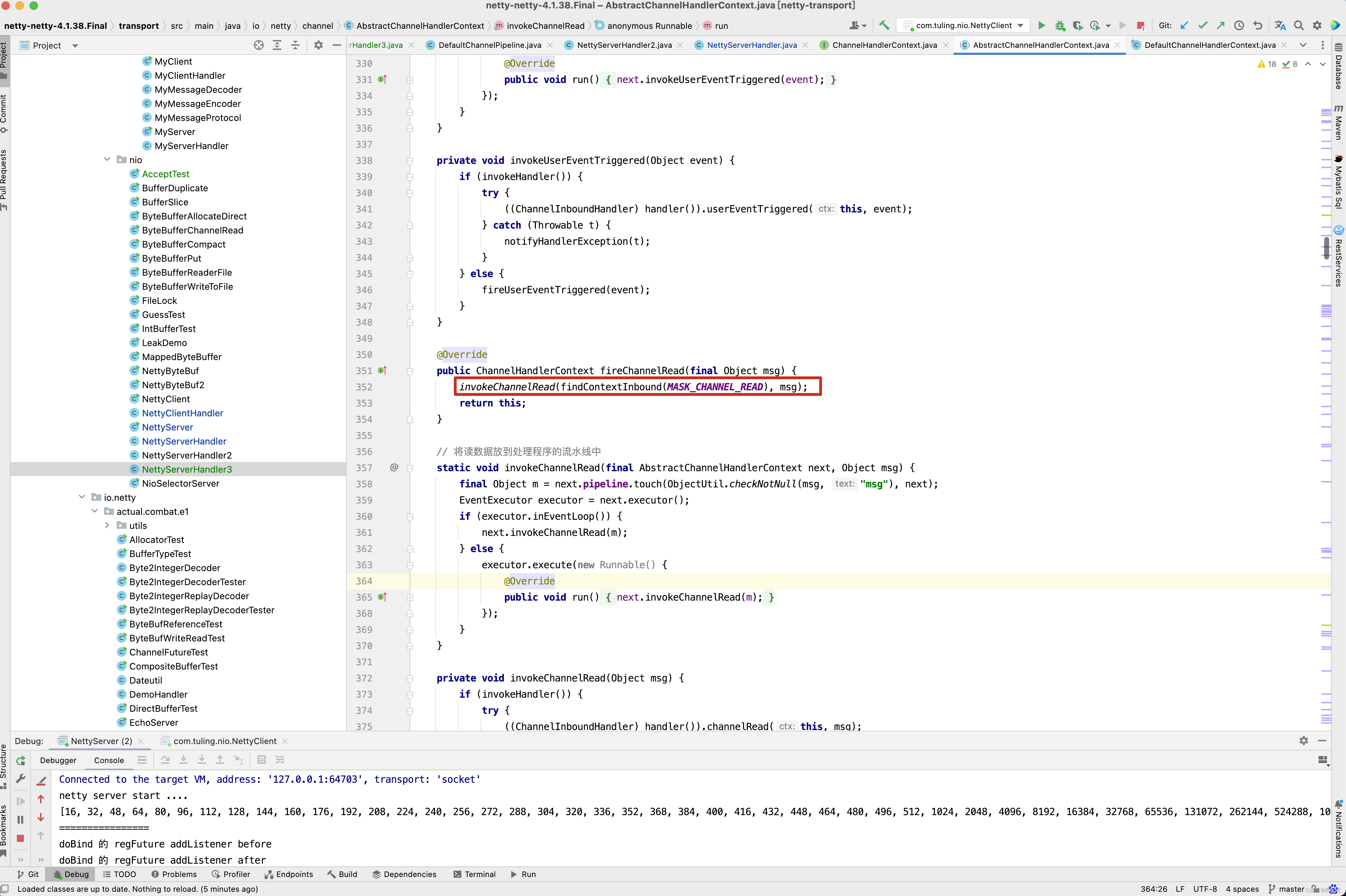
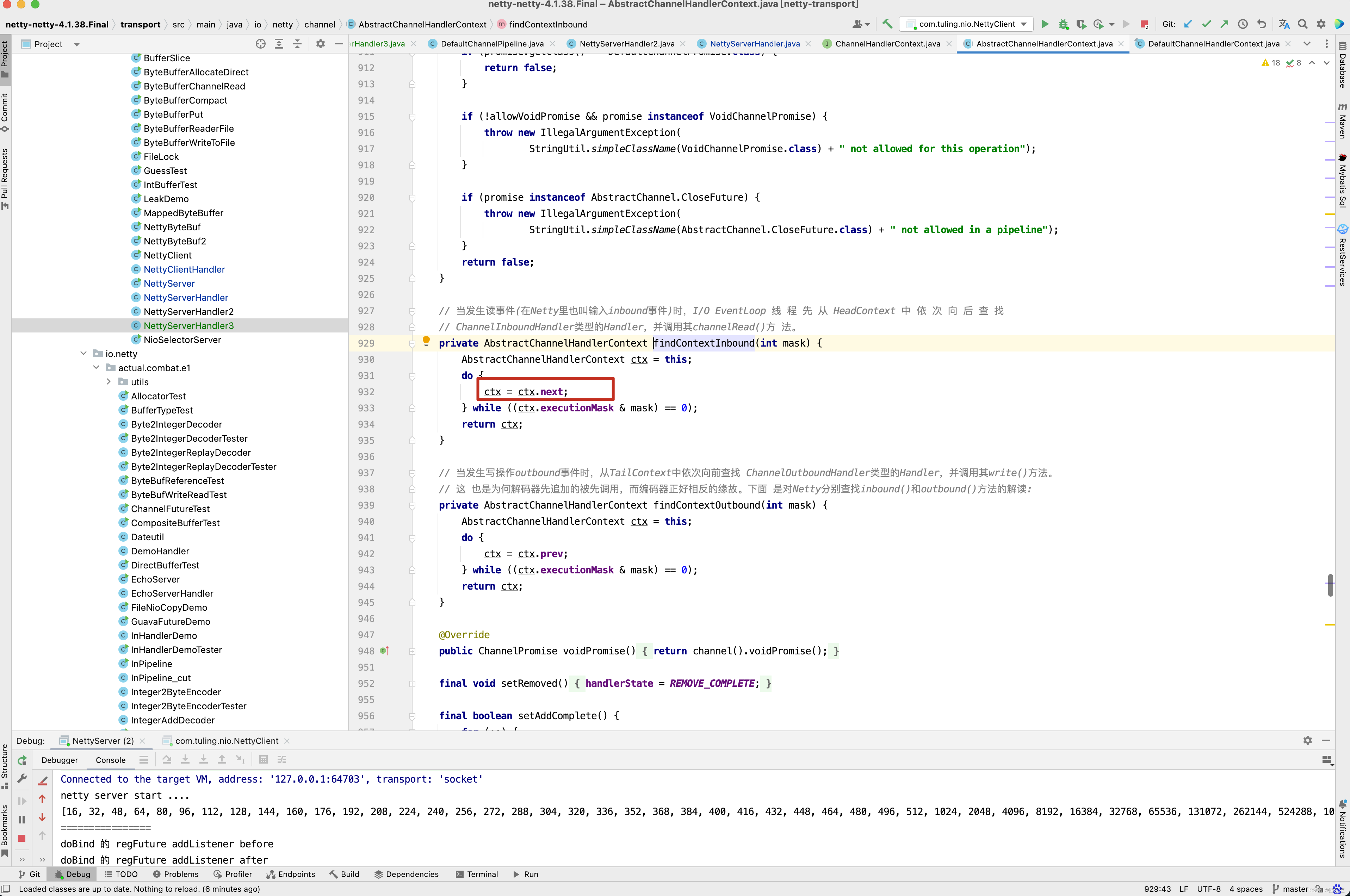
从上图中的三个截图中即可得知。 HeadContext的fireChannelRead()方法最终调用了 invokeChannelRead(findContextInbound(MASK_CHANNEL_READ), msg);这一行代码,而findContextInbound()找到下一下next Context并调用他的invokeChannelRead()方法,在invokeChannelRead()内部又会调用handler的channelRead()方法,因此想让NettyServerHandler3()也被加入到流水线中,只需要在NettyServerHandler中模拟HeadContext一样,加一行ctx.fireChannelRead(msg)代码即可。
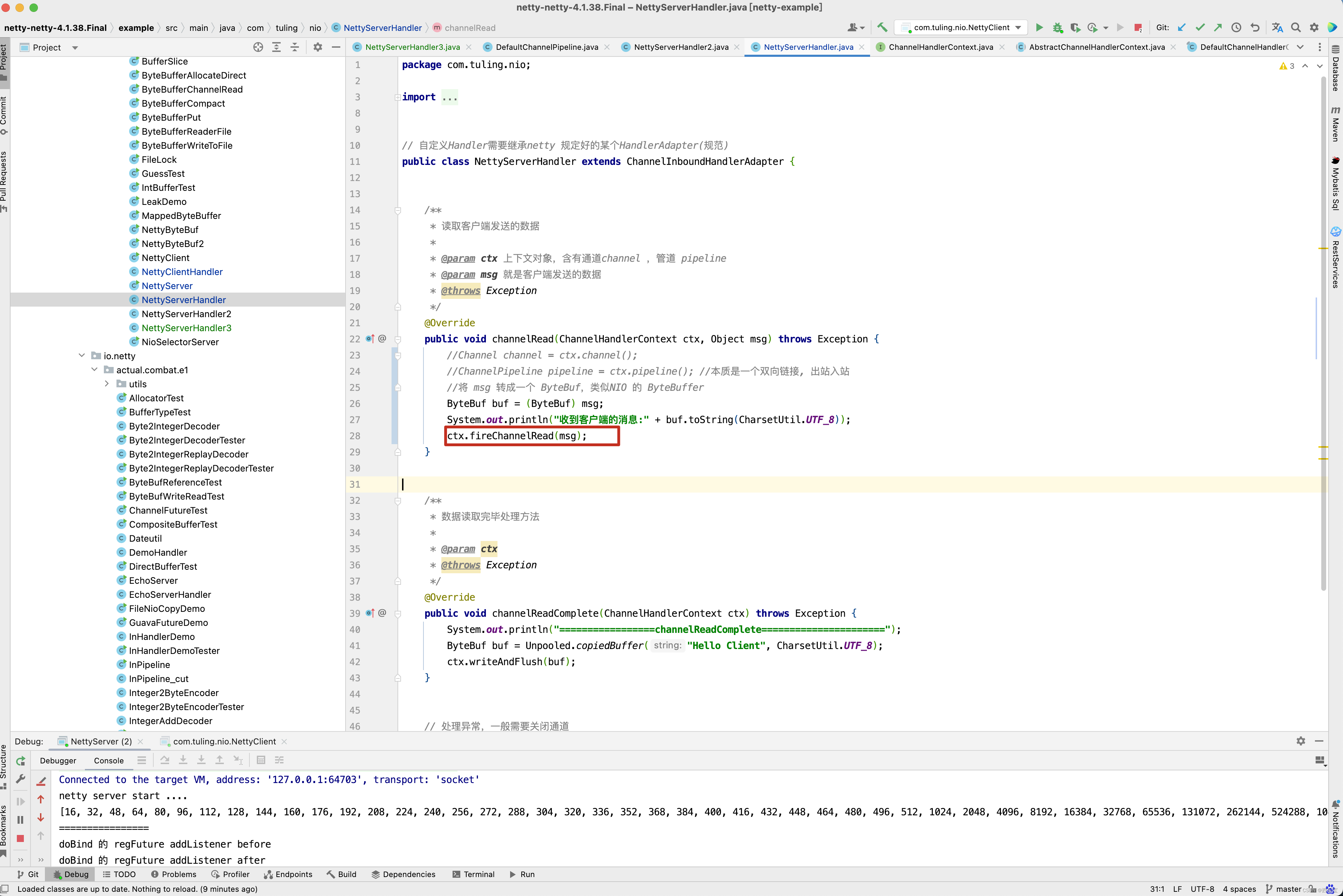
执行结果如下 。
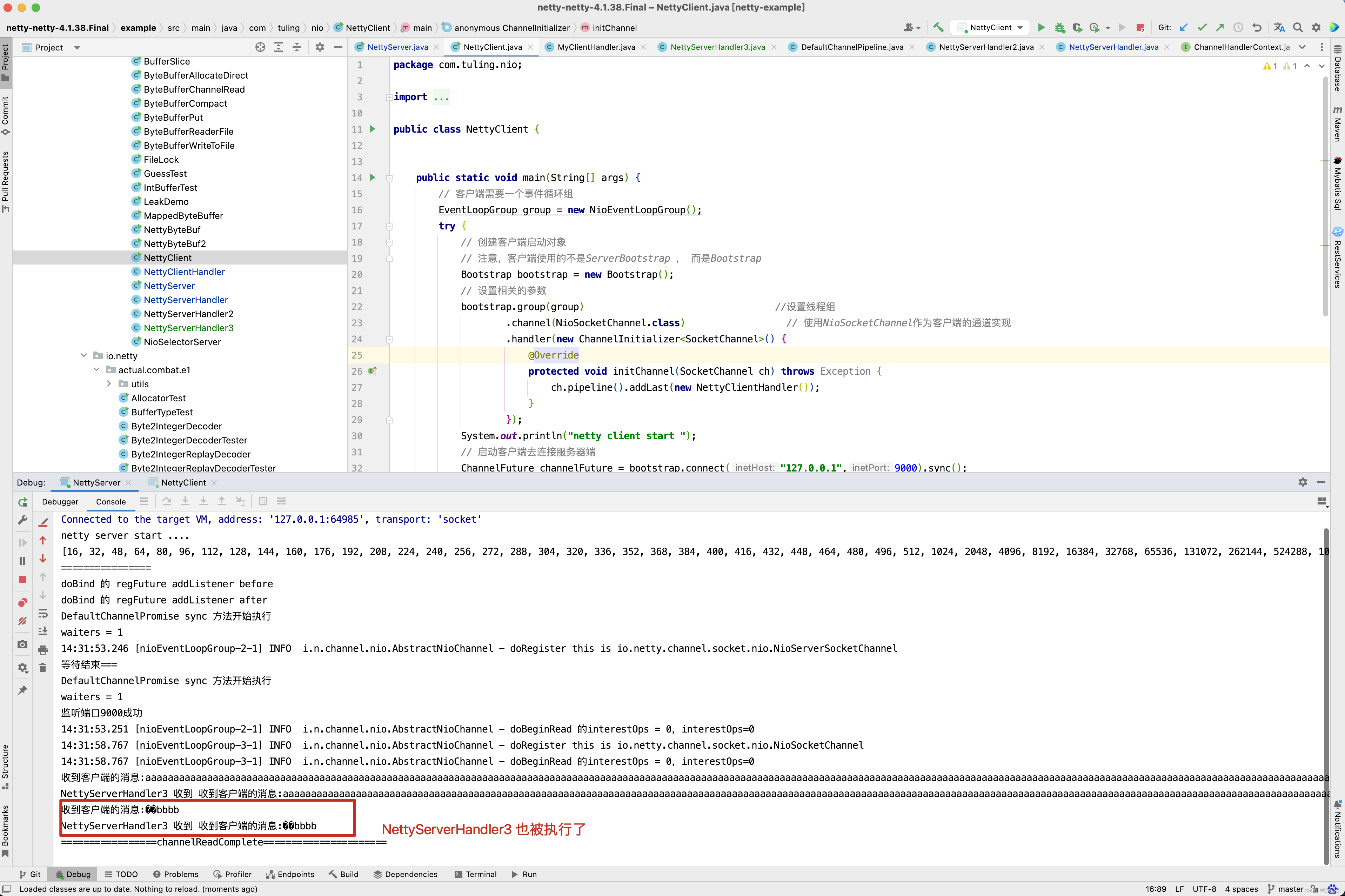
关于Netty从客户端读取数据的源码也分析得差不多了,接下来我们以一个个具体的例子来分析源码的实现。首先看第一个例子。
例子1
对于RecvByteBufAllocator内存分配计算 当第一次字节数大于1024,并且在1024~1026个字节中写的是一个utf-8的中文,此时打印ByteBuf会出现中文乱码。 在之前的博客中第一种方案中,在ChannelInitializer的initChannel()方法中加一行ch.config().setRecvByteBufAllocator(new FixedRecvByteBufAllocator(2056));

即可解决中文乱码问题,为什么呢? ,在read()方法的final RecvByteBufAllocator.Handle allocHandle = recvBufAllocHandle();这一行代码,recvBufAllocHandle()方法内部 ,config().getRecvByteBufAllocator()获取的实际上是我们自定义的FixedRecvByteBufAllocator分配器。
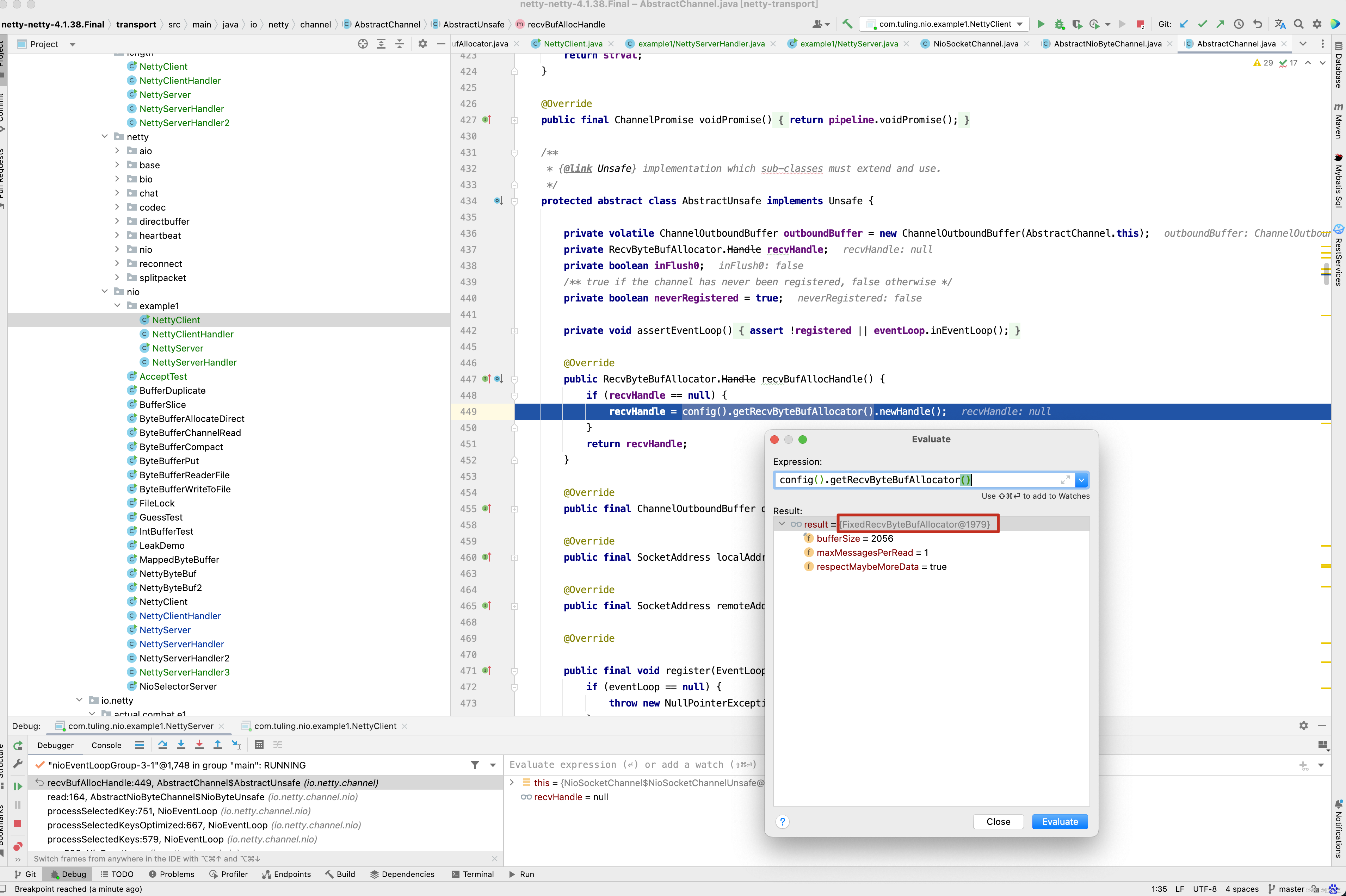
而newHandle()方法实际上是调用FixedRecvByteBufAllocator的newHandle()方法。
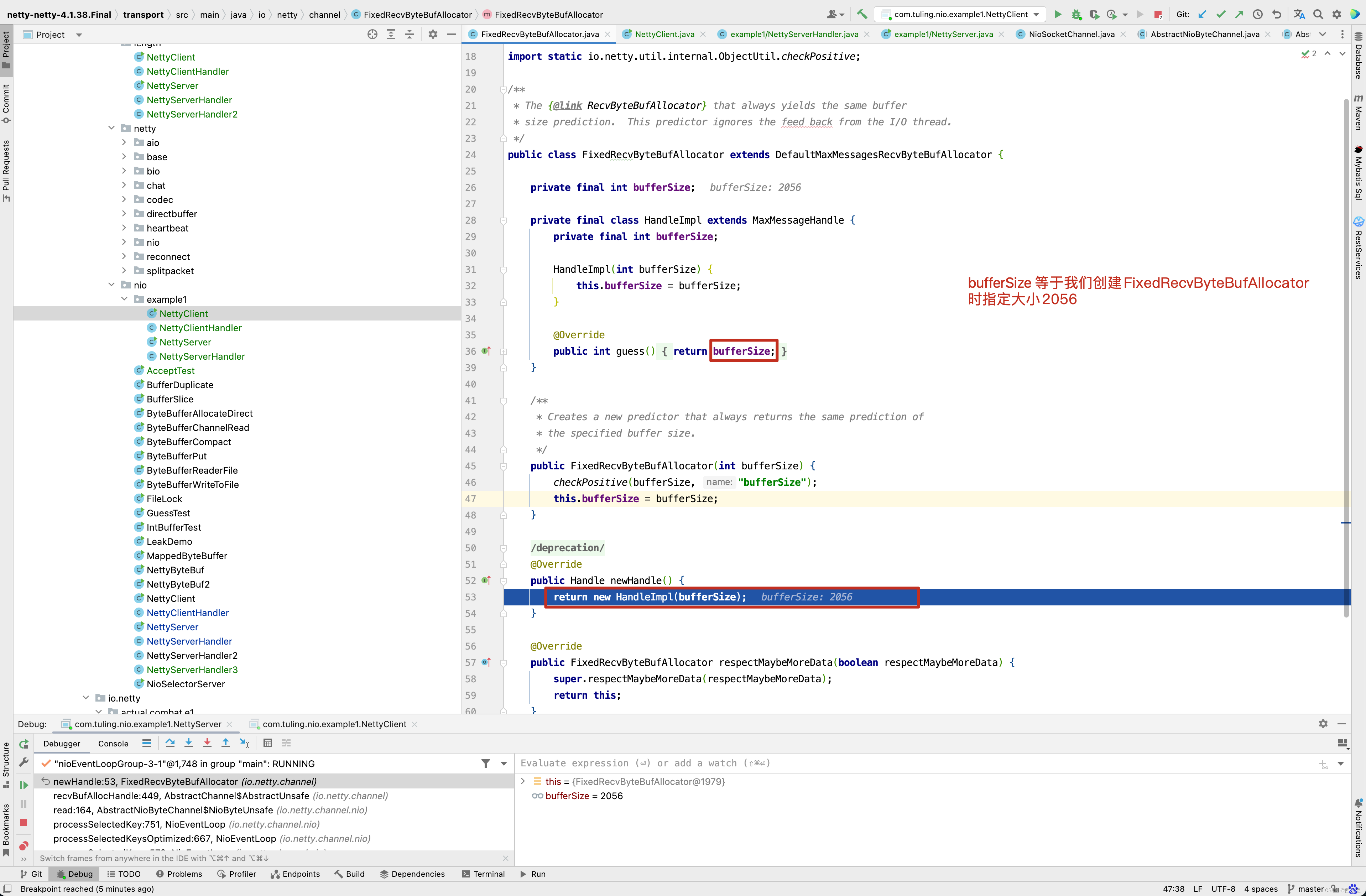
而创建的HandleImpl的bufferSize为我们创建FixedRecvByteBufAllocator指定bufferSize的大小为2056。
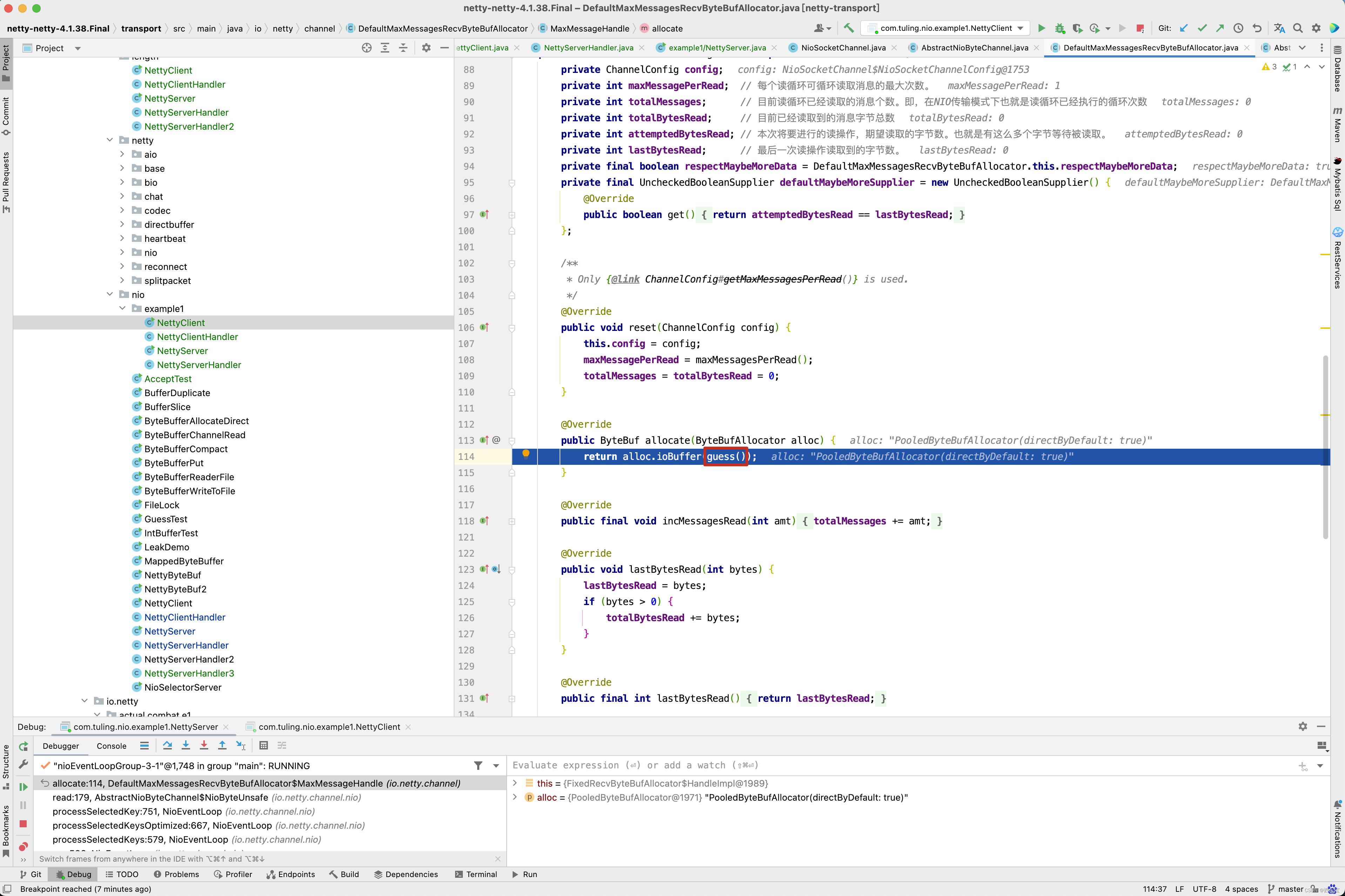
因此在调用 byteBuf = allocHandle.allocate(allocator)时,guess()方法实际上调用的是FixedRecvByteBufAllocator的内部类HandleImpl的guess()方法,返回2056。
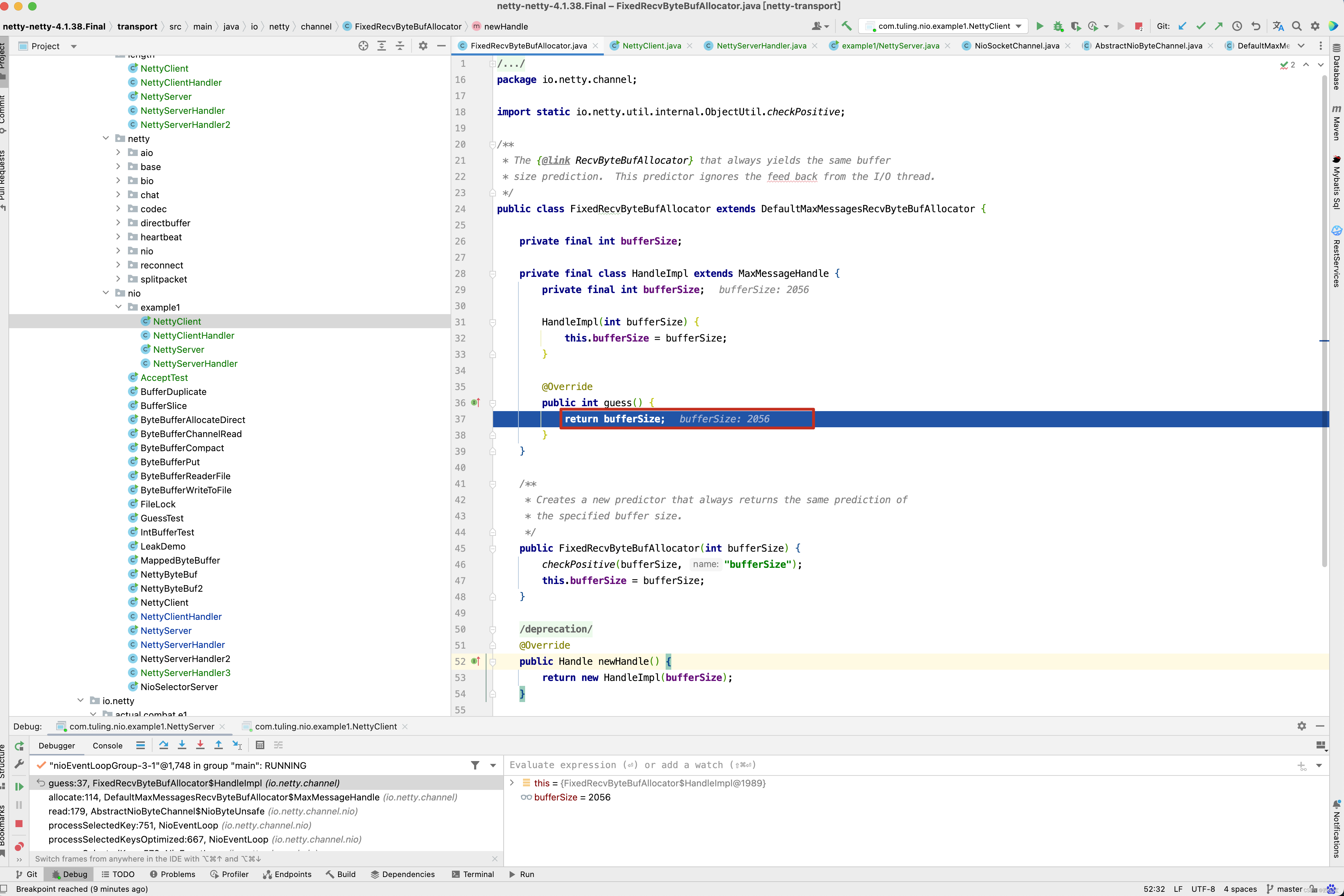
因此创建ByteBuf的容量就是2056个字节,读取1030个字节足足在余,所以不会出现中文乱码问题。
RecvByteBufAllocator内存分配计算 的第二种方案也是我自己瞎yy的,不知道能不能用于生产,因此关于他的源码我也不想分析了,有兴趣自己去论证,我们看第三种方案。
例子3
第三种方案创建了一个NettyServerHandler2类,并继承了LengthFieldBasedFrameDecoder,而LengthFieldBasedFrameDecoder继承了ByteToMessageDecoder类。
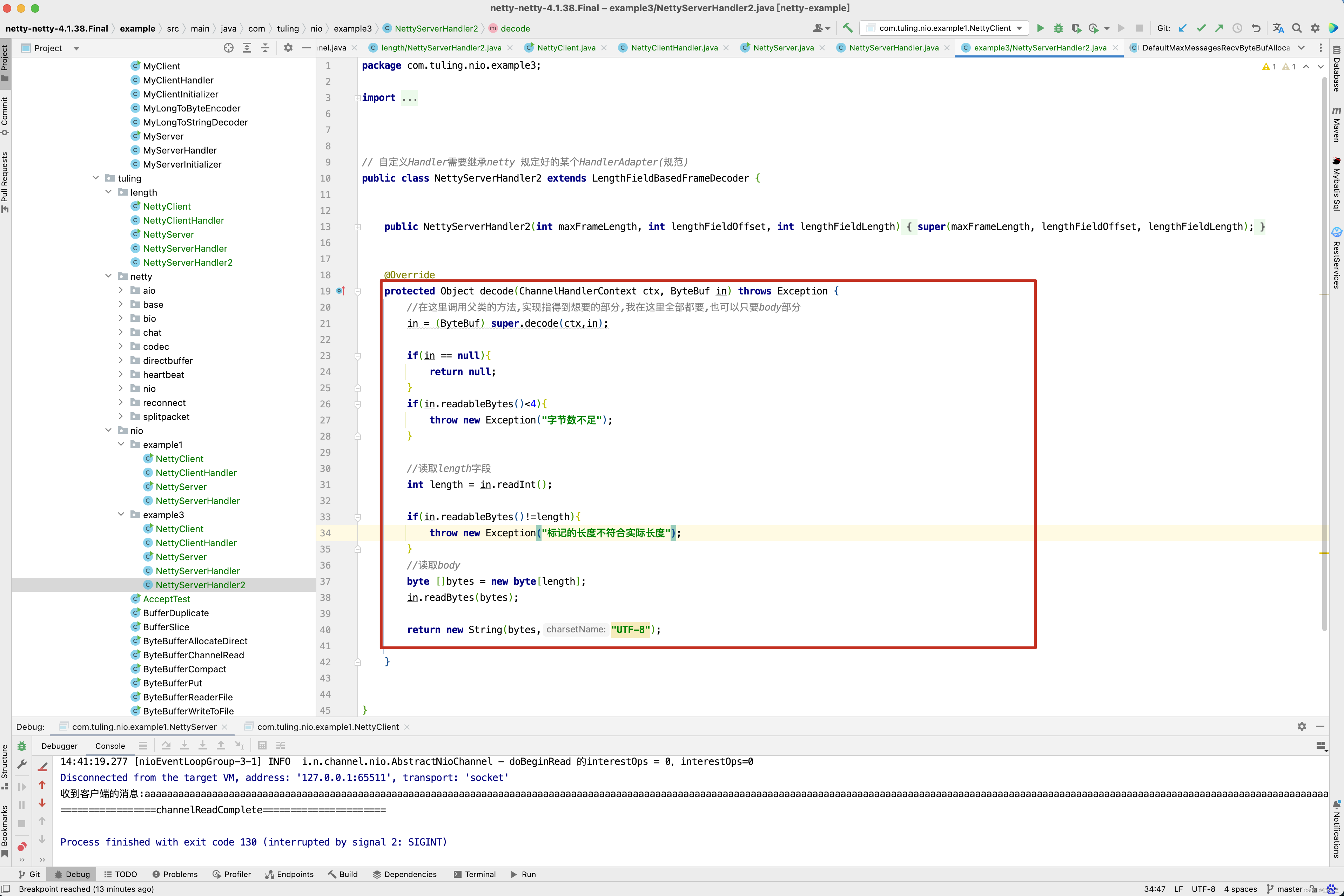
在客户端Handler中,在传输的字节头部加了一个int类型4个字节来记录传输数据的长度 。
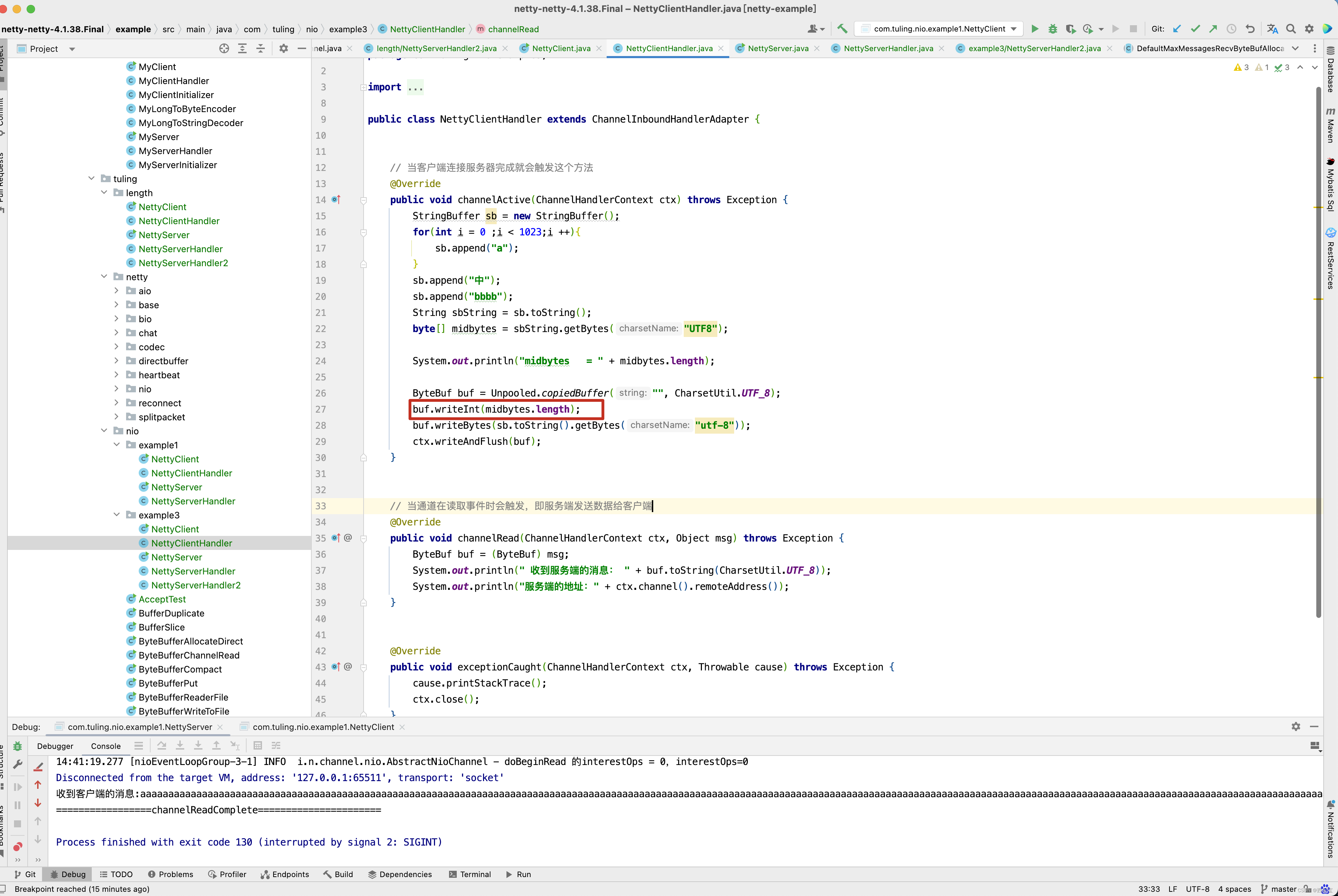
在服务端将之前创建的NettyServerHandler2添加到Server的处理流水线中。
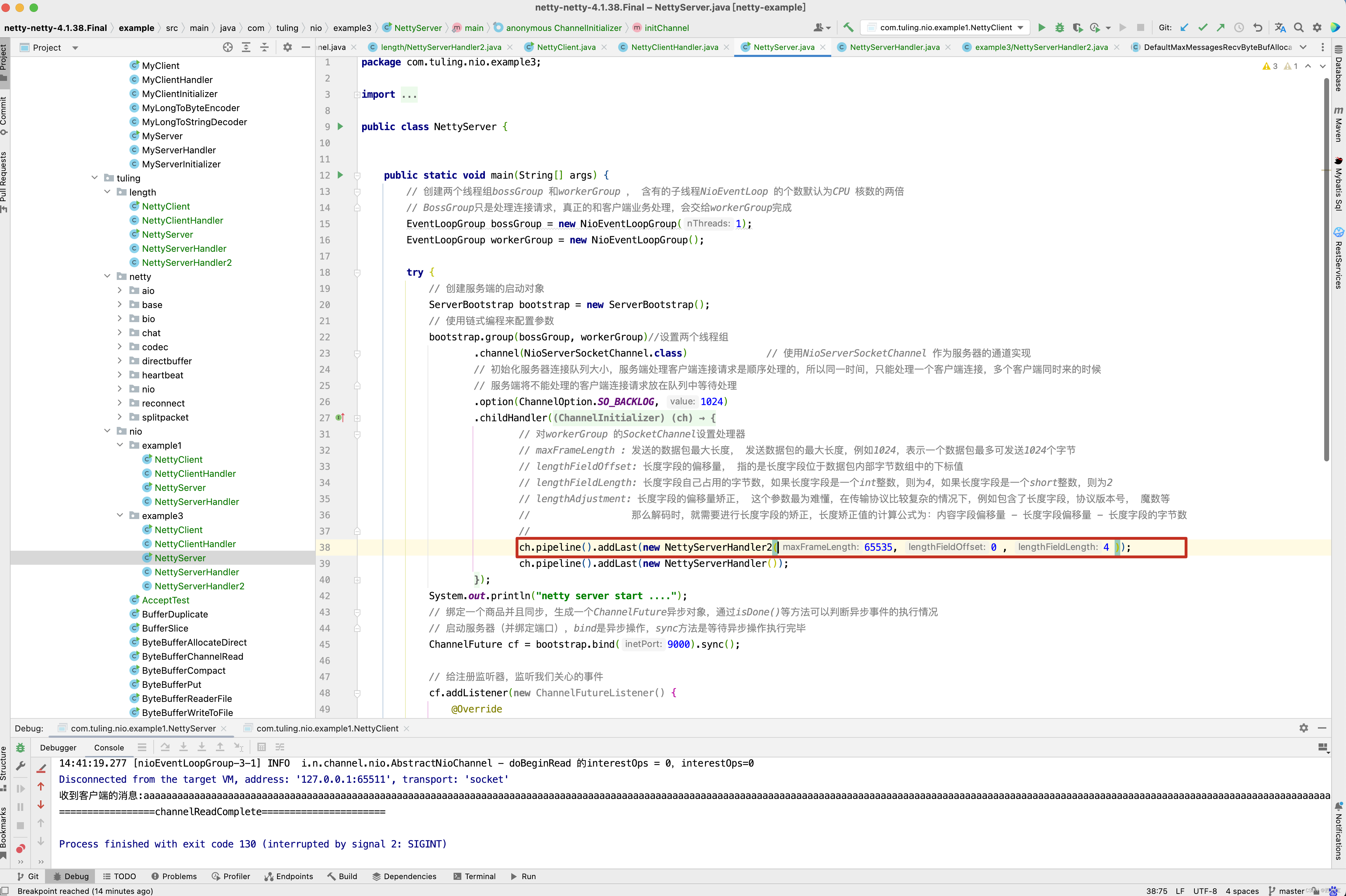
此时此刻 ,在NettyServerHandler打印ByteBuf数据时,就不会出现传输数据被切割的情况,不会出现中文乱码,原因是什么呢? 这个就需要研究LengthFieldBasedFrameDecoder的源代码了。 首先在NettyServerHandler2的decode()方法中打一个断点 。 最终进入了LengthFieldBasedFrameDecoder的decode()方法 。
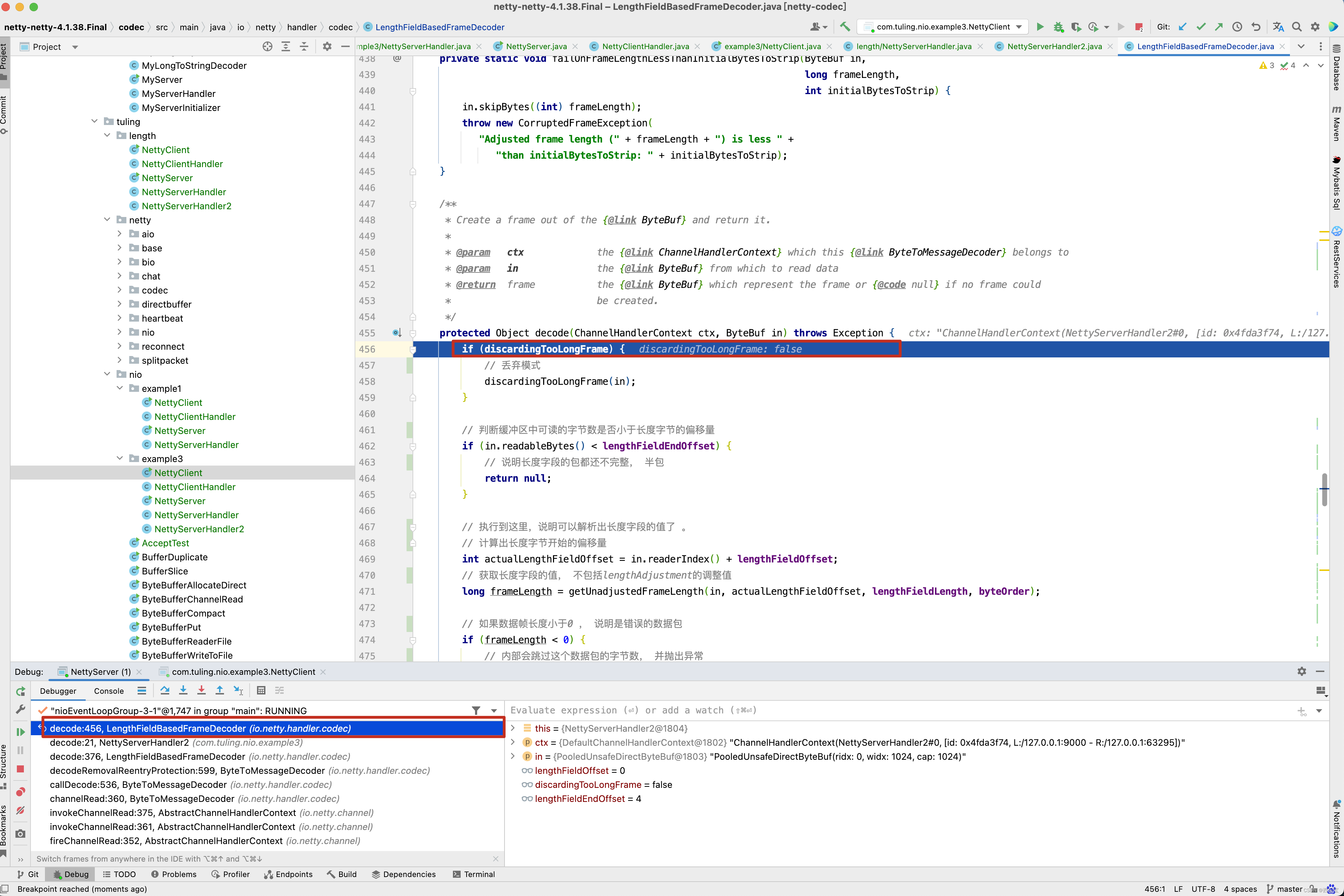
接下来不得不对LengthFieldBasedFrameDecoder源码进行分析了。 在网上看到其他人的一篇博客LengthFieldBasedFrameDecoder源码分析 ,我觉得还是写得非常好的,有兴趣可以自己去看看,我自己也是一个学习的过程 ,因此我将他的博客抄录到我的博客当中,证明我认认真真的研读过他的博客 。
看LengthFieldBasedFrameDecoder的构造函数 。
// maxFrameLength : 发送的数据包最大长度, 发送数据包的最大长度,例如1024,表示一个数据包最多可发送1024个字节
// lengthFieldOffset: 长度字段的偏移量, 指的是长度字段位于数据包内部字节数组中的下标值
// lengthFieldLength: 长度字段自己占用的字节数,如果长度字段是一个int整数,则为4,如果长度字段是一个short整数,则为2
// lengthAdjustment: 长度字段的偏移量矫正, 这个参数最为难懂,在传输协议比较复杂的情况下,例如包含了长度字段,协议版本号, 魔数等
// 那么解码时,就需要进行长度字段的矫正,长度矫正值的计算公式为:内容字段偏移量 - 长度字段偏移量 - 长度字段的字节数
//
// initialBytesToStrip: 丢弃的起始字节数 , 在有效数据字段Context 前面,还有一些其他的字段的字节,作为最终的解析结果,可以丢弃。
// 例如,上面的示例程序中, 前面有4个字节的长度字段,起到辅助作用,最终的结果中不需要这个长度,所以丢弃字节数为4 。
// LengthFieldBasedFrameDecoder spliter =
// new LengthFieldBasedFrameDecoder(1024, 0, 4, 0, 4)
public LengthFieldBasedFrameDecoder(
int maxFrameLength,
int lengthFieldOffset,
int lengthFieldLength,
int lengthAdjustment,
int initialBytesToStrip) {
this(
maxFrameLength,
lengthFieldOffset,
lengthFieldLength,
lengthAdjustment,
initialBytesToStrip, true);
}
可能上面maxFrameLength,lengthFieldOffset,lengthFieldLength,lengthAdjustment,initialBytesToStrip这几个字段的具体含义还不是很明白,接下来,根据具体的案例来学习LengthFieldBasedFrameDecoder的几个参数如何配置。
LengthFieldBasedFrameDecoder案例分析
案例1:
- lengthFieldOffset=0 长度字段从0开始
- lengthFieldLength=2 长度字段本身占2个字节
- lengthAdjustment=0 需要调整0字节
- initialBytesToStrip=0 解码后跳过0字节
整个包长度为14字节
| Length(长度) | Actual Content(真实数据) |
|---|---|
| 0x000C | HELLO, WORLD |
| 0x000C==12,该字段为2个字节 | 数据总共有12个字节,所以长度字段指的是数据的长度 |
解码后
| Length | Actual Content |
|---|---|
| 0x000C | HELLO, WORLD |
例1
服务端代码
public class NettyServer {
public static void main(String[] args) {
// 创建两个线程组bossGroup 和workerGroup , 含有的子线程NioEventLoop 的个数默认为CPU 核数的两倍
// BossGroup只是处理连接请求,真正的和客户端业务处理,会交给workerGroup完成
EventLoopGroup bossGroup = new NioEventLoopGroup(1);
EventLoopGroup workerGroup = new NioEventLoopGroup();
try {
// 创建服务端的启动对象
ServerBootstrap bootstrap = new ServerBootstrap();
// 使用链式编程来配置参数
bootstrap.group(bossGroup, workerGroup)//设置两个线程组
.channel(NioServerSocketChannel.class) // 使用NioServerSocketChannel 作为服务器的通道实现
// 初始化服务器连接队列大小,服务端处理客户端连接请求是顺序处理的,所以同一时间,只能处理一个客户端连接,多个客户端同时来的时候
// 服务端将不能处理的客户端连接请求放在队列中等待处理
.option(ChannelOption.SO_BACKLOG, 1024)
.childHandler(new ChannelInitializer<SocketChannel>() {
@Override
protected void initChannel(SocketChannel ch) throws Exception {
// 对workerGroup 的SocketChannel设置处理器
// maxFrameLength : 发送的数据包最大长度, 发送数据包的最大长度,例如1024,表示一个数据包最多可发送1024个字节
// lengthFieldOffset: 长度字段的偏移量, 指的是长度字段位于数据包内部字节数组中的下标值
// lengthFieldLength: 长度字段自己占用的字节数,如果长度字段是一个int整数,则为4,如果长度字段是一个short整数,则为2
// lengthAdjustment: 长度字段的偏移量矫正, 这个参数最为难懂,在传输协议比较复杂的情况下,例如包含了长度字段,协议版本号, 魔数等
// 那么解码时,就需要进行长度字段的矫正,长度矫正值的计算公式为:内容字段偏移量 - 长度字段偏移量 - 长度字段的字节数
//
ch.pipeline().addLast(new LengthFieldBasedFrameDecoder(65535, 0 , 4,0,0 ));
ch.pipeline().addLast(new NettyServerHandler());
}
});
System.out.println("netty server start ....");
// 绑定一个商品并且同步,生成一个ChannelFuture异步对象,通过isDone()等方法可以判断异步事件的执行情况
// 启动服务器(并绑定端口),bind是异步操作,sync方法是等待异步操作执行完毕
ChannelFuture cf = bootstrap.bind(9000).sync();
// 给注册监听器,监听我们关心的事件
cf.addListener(new ChannelFutureListener() {
@Override
public void operationComplete(ChannelFuture future) throws Exception {
if (cf.isSuccess()) {
System.out.println("监听端口9000成功");
} else {
System.out.println("监听端口9000失败");
}
}
});
// 对通道关闭进行监听,closeFuture是异步操作,监听通道关闭
// 通过sync方法同步等待通道关闭处理完毕,这里会阻塞等待通道关闭完成
cf.channel().closeFuture().sync();
} catch (Exception e) {
e.printStackTrace();
} finally {
bossGroup.shutdownGracefully();
workerGroup.shutdownGracefully();
}
}
}
// 自定义Handler需要继承netty 规定好的某个HandlerAdapter(规范)
public class NettyServerHandler extends ChannelInboundHandlerAdapter {
/**
* 读取客户端发送的数据
*
* @param ctx 上下文对象,含有通道channel ,管道 pipeline
* @param msg 就是客户端发送的数据
* @throws Exception
*/
@Override
public void channelRead(ChannelHandlerContext ctx, Object msg) throws Exception {
System.out.println("服务器读取的线程 :" + Thread.currentThread().getName());
ByteBuf buf = (ByteBuf) msg;
int length = buf.readInt();
System.out.println("传送的数据长度为" + length);
byte[] bytes = new byte[length];
buf.readBytes(bytes);
System.out.println("客户端发送的消息是: " + new String(bytes, "utf-8"));
}
/**
* 数据读取完毕处理方法
*
* @param ctx
* @throws Exception
*/
@Override
public void channelReadComplete(ChannelHandlerContext ctx) throws Exception {
System.out.println("=================channelReadComplete======================");
ByteBuf buf = Unpooled.copiedBuffer("Hello Client", CharsetUtil.UTF_8);
ctx.writeAndFlush(buf);
}
// 处理异常,一般需要关闭通道
@Override
public void exceptionCaught(ChannelHandlerContext ctx, Throwable cause) throws Exception {
ctx.close();
}
}
再来看客户端代码
public class NettyClient {
public static void main(String[] args) {
// 客户端需要一个事件循环组
EventLoopGroup group = new NioEventLoopGroup();
try {
// 创建客户端启动对象
// 注意,客户端使用的不是ServerBootstrap , 而是Bootstrap
Bootstrap bootstrap = new Bootstrap();
// 设置相关的参数
bootstrap.group(group) //设置线程组
.channel(NioSocketChannel.class) // 使用NioSocketChannel作为客户端的通道实现
.handler(new ChannelInitializer<SocketChannel>() {
@Override
protected void initChannel(SocketChannel ch) throws Exception {
ch.pipeline().addLast(new NettyClientHandler());
}
});
System.out.println("netty client start ");
// 启动客户端去连接服务器端
ChannelFuture channelFuture = bootstrap.connect("127.0.0.1",9000).sync();
// 对关闭通道进行监听
channelFuture.channel().closeFuture().sync();
}catch (Exception e ){
e.printStackTrace();
}finally {
group.shutdownGracefully();
}
}
public class NettyClientHandler extends ChannelInboundHandlerAdapter {
// 当客户端连接服务器完成就会触发这个方法
@Override
public void channelActive(ChannelHandlerContext ctx) throws Exception {
byte[] midbytes = "HELLO, WORLD".getBytes("UTF8");
ByteBuf buf = Unpooled.copiedBuffer("", CharsetUtil.UTF_8);
buf.writeInt(midbytes.length);
buf.writeBytes(midbytes);
ctx.writeAndFlush(buf);
}
// 当通道在读取事件时会触发,即服务端发送数据给客户端
@Override
public void channelRead(ChannelHandlerContext ctx, Object msg) throws Exception {
ByteBuf buf = (ByteBuf) msg;
System.out.println(" 收到服务端的消息: " + buf.toString(CharsetUtil.UTF_8));
System.out.println("服务端的地址:" + ctx.channel().remoteAddress());
}
@Override
public void exceptionCaught(ChannelHandlerContext ctx, Throwable cause) throws Exception {
cause.printStackTrace();
ctx.close();
}
}
客户端代码很好理解,向服务端发送了长度和真实数据,而服务端也收到了真实数据的长度和真实数据 。

案例2
- lengthFieldOffset=0 长度字段从0开始
- lengthFieldLength=2 长度字段本身占2个字节
- lengthAdjustment=0 需要调整0字节
- initialBytesToStrip=2 解码后跳过2字节
整个包长度为14字节
| Length 长度 | ActualContent(真实数据) |
|---|---|
| 0x000C | HELLO, WORLD |
| 0x000C==12 , 该字段为2个字节 | 数据总共12个字节,所以长度字段指的是数据的长度 |
这个时候initialBytesToStrip字段就起作用了, 在解码后会将前面的2个字节跳过 , 所以解码后只剩余了数据部分。 解码后
| Actual Content(真实的数据) |
|---|
| HELLO, WORLD |
由于很多的测试代码和例1中的一样,因此这里只将不同的部分截图出来。
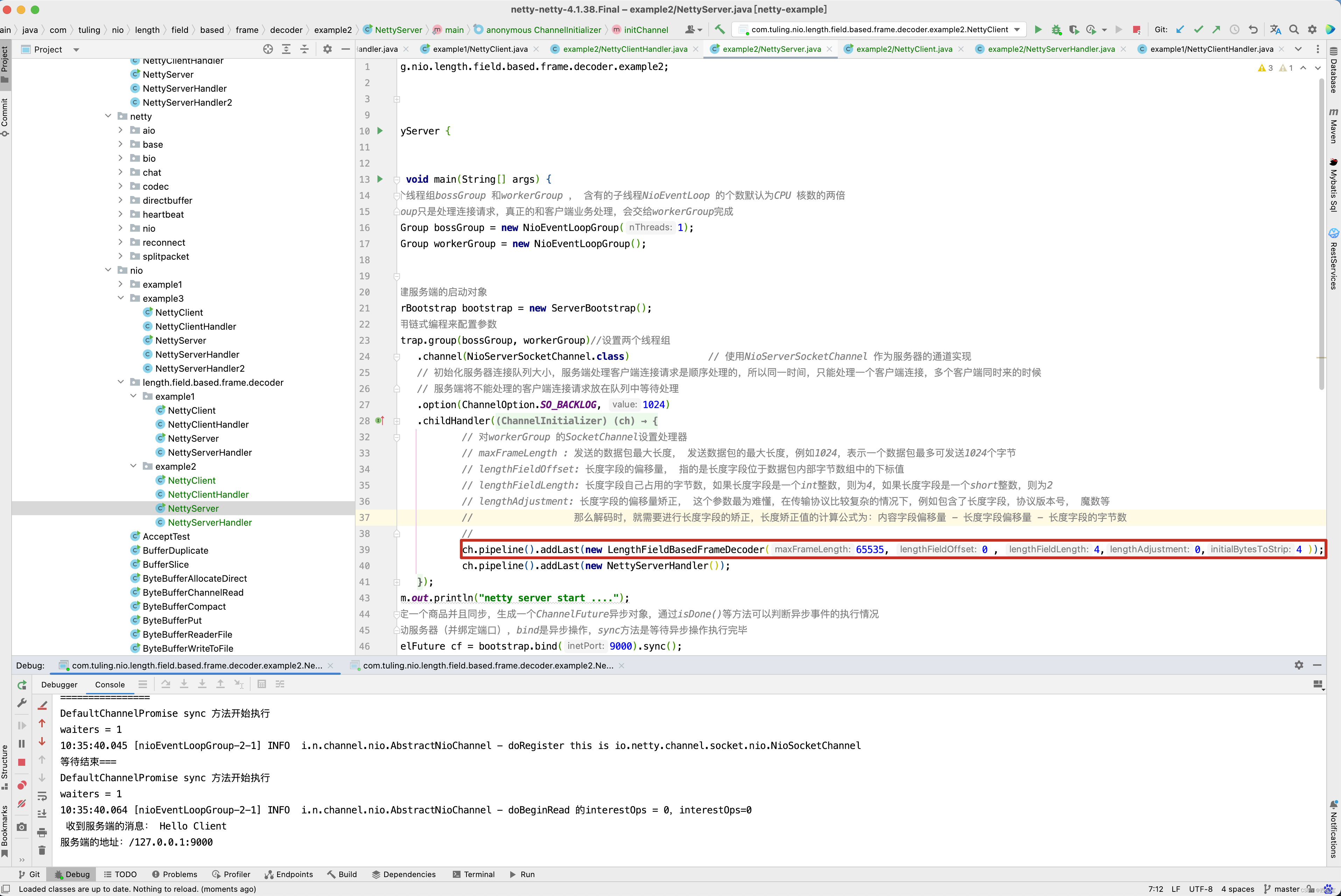
客户端写了两份数据
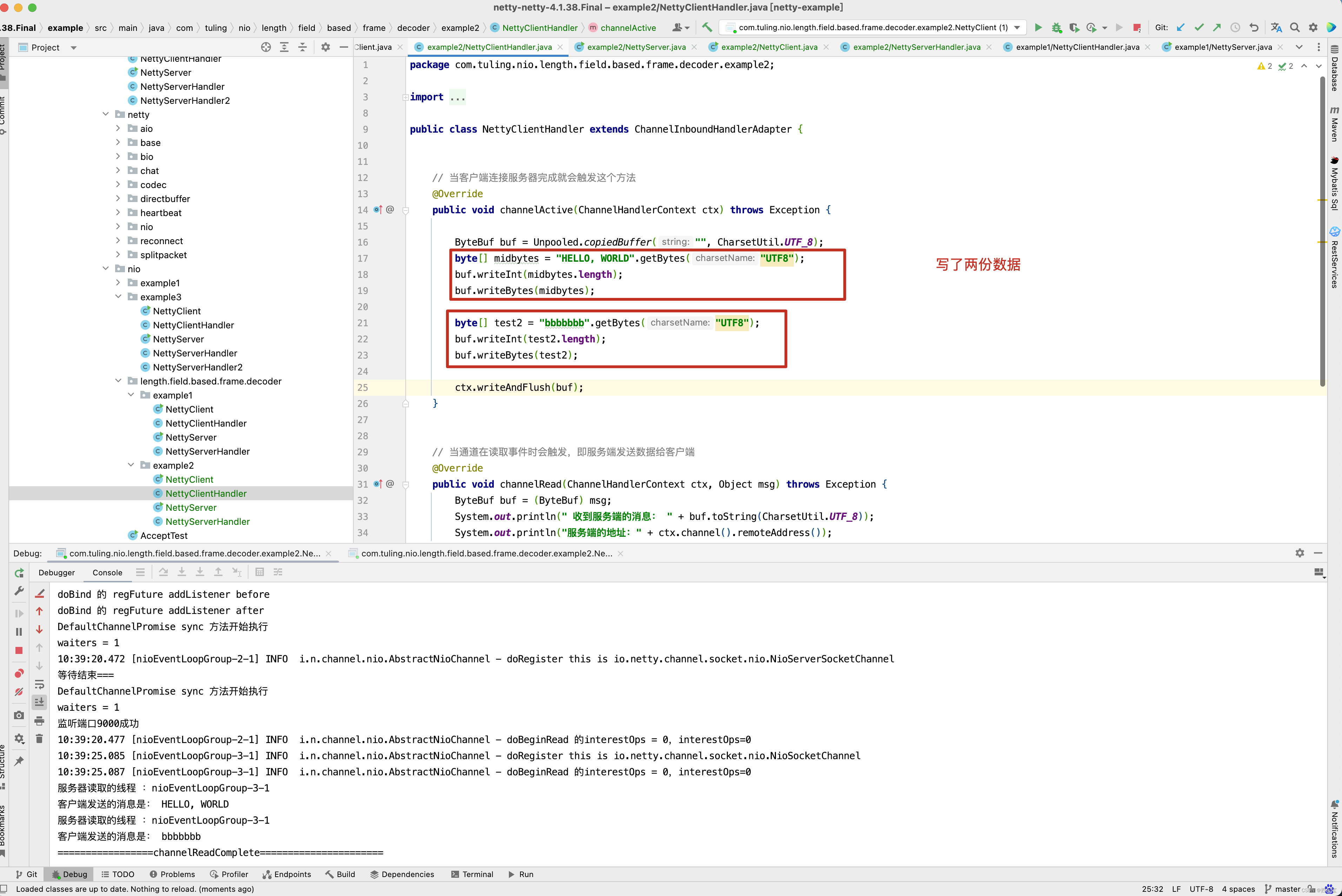
NettyServerHandler代码及测试结果如下
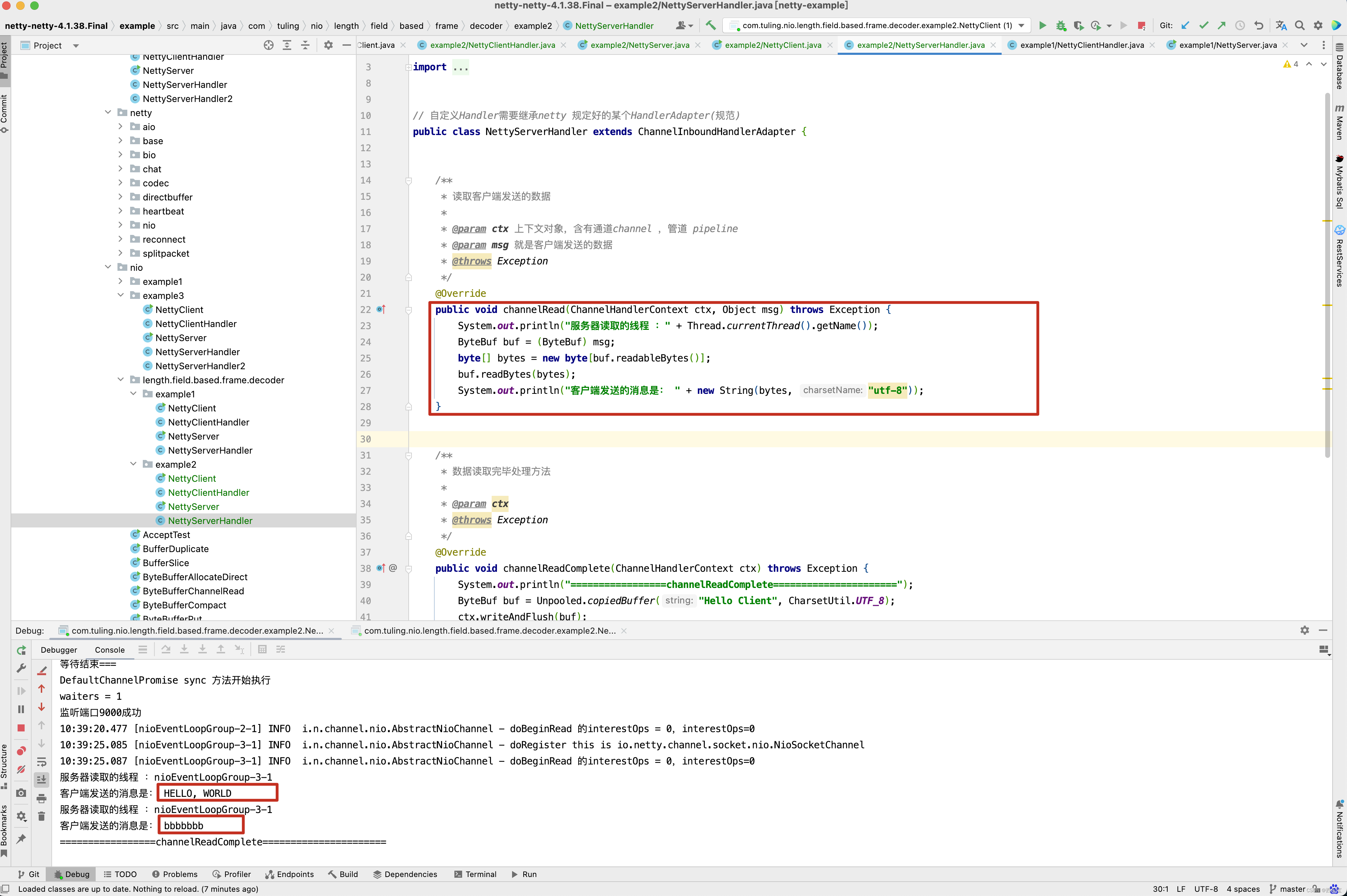
案例3
- lengthFieldOffset=0 长度字段从0开始
- lengthFieldLength=2 长度字段本身占2个字节
- lengthAdjustment= -2 需要调整 -2 字节
- initialBytesToStrip=0 解码后跳过2字节
整个包的长度为14个字节
| Length(长度) | Actual Content(真实数据) |
|---|---|
| 0x000E | HELLO, WORLD |
| 0x000E==14,该字段为2字节 | 数据总共12字节,长度字段指的是整个包的长度 |
这时lengthAdjustment起作用了, 因为长度字节的值包含了长度字段本身的2个字节,如果要获取数据的字节数, 需要加上lengthAdjustment的值,就是14 + (-2 ) = 12 ,这样才算出来数据的长度 。
解码后
| Length | Actual Content |
|---|---|
| 0x000E | HELLO, WORLD |
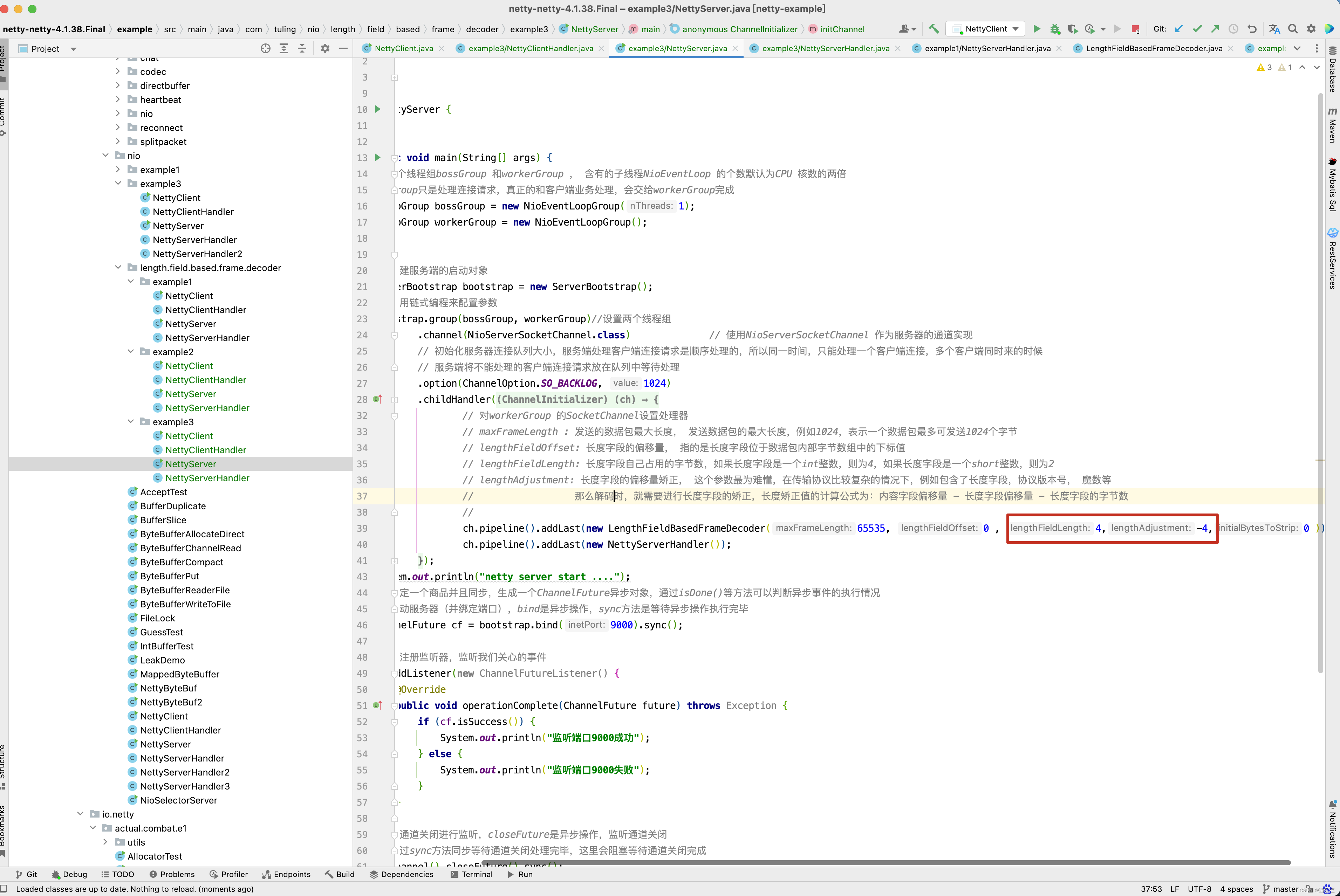

结果输出

案例4:
- lengthFieldOffset=2 长度字段从第2个字节开始
- lengthFieldLength=3 长度字段本身占3个字节
- lengthAdjustment=0 需要调整0字节
- initialBytesToStrip=0 解码后跳过0字节
整个包长度为17字节
| Header(头) | Length(长度) | Actual Content(真实数据) |
|---|---|---|
| OxCAFE | 0x00000C | HELLO, WORLD |
| 2个字节 | 0x00000C==12,该字段为3字节 | 数据总共12个字节, 长度字段指的是数据的长度 |
由于数据包最前面加了2个字节的Header, 所以lengthFieldOffset为2 , 说明长度字段是从第2个字节开始的,然后lengthFieldLength为3,说明长度字段本身占3个字节 。
解码后
| Header | Length | Actual Content |
|---|---|---|
| 0xCAFE | 0x000C | HELLO, WORLD |
设置请求头为32个字节, Length 为4个字节 。
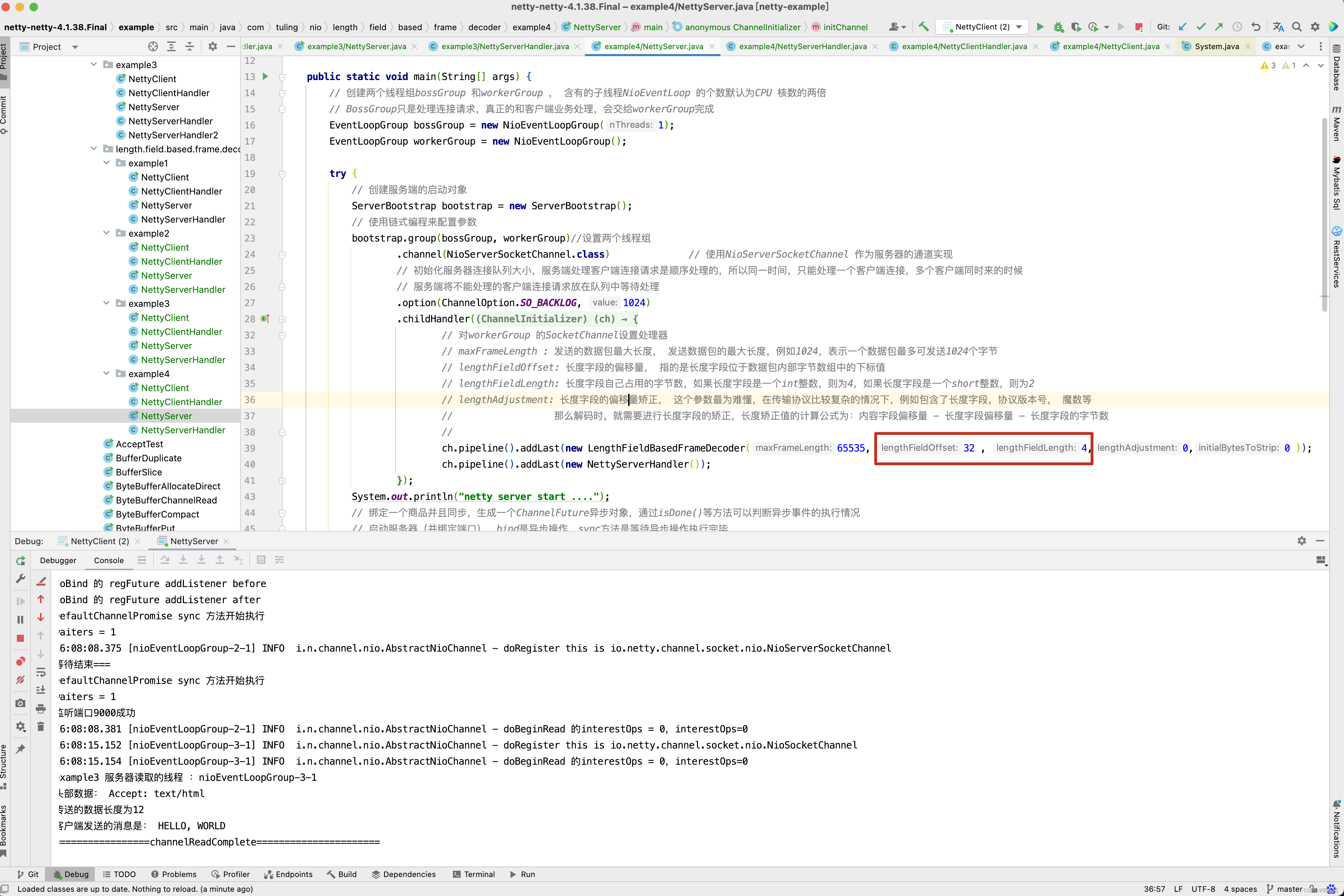
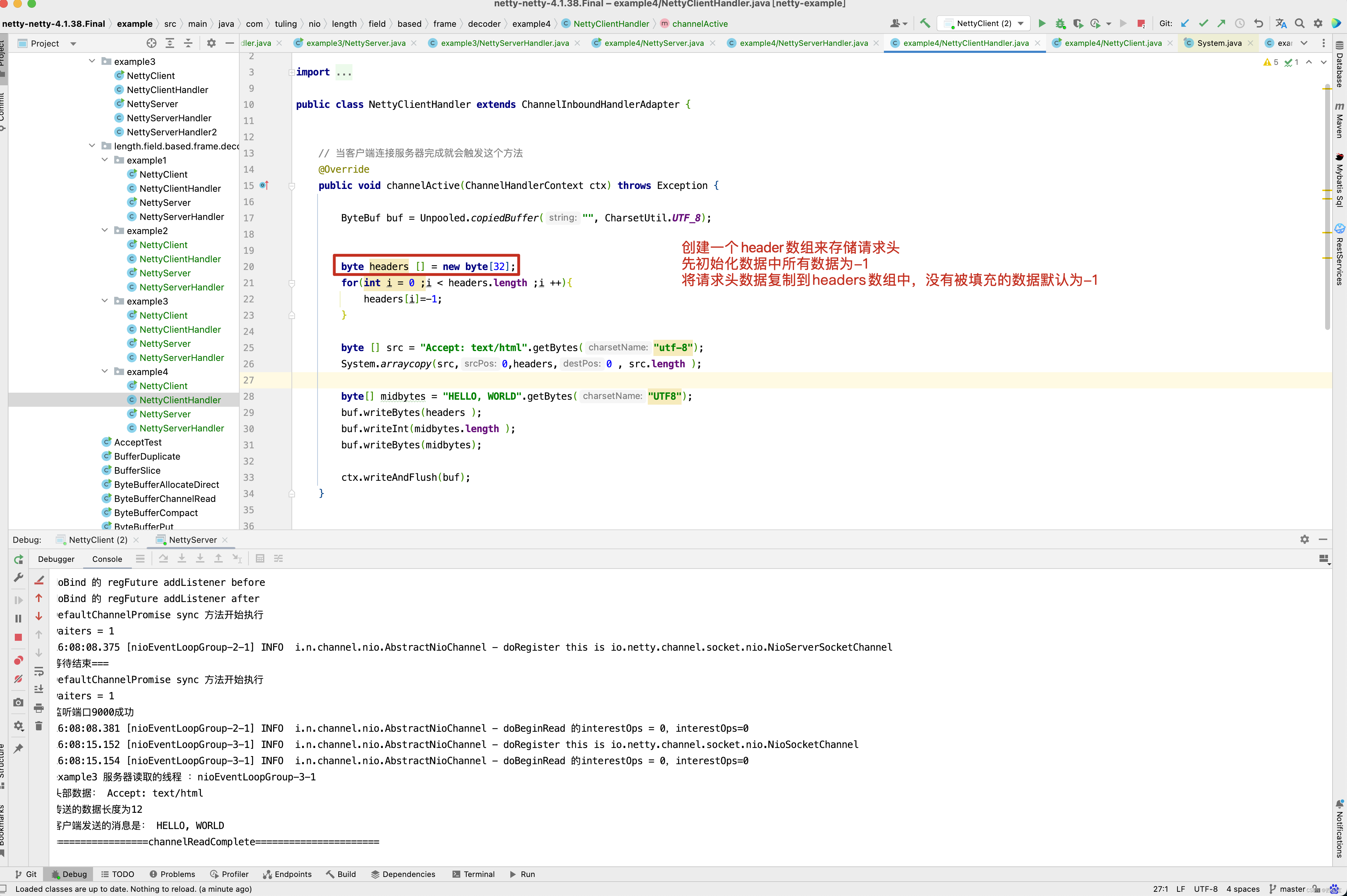
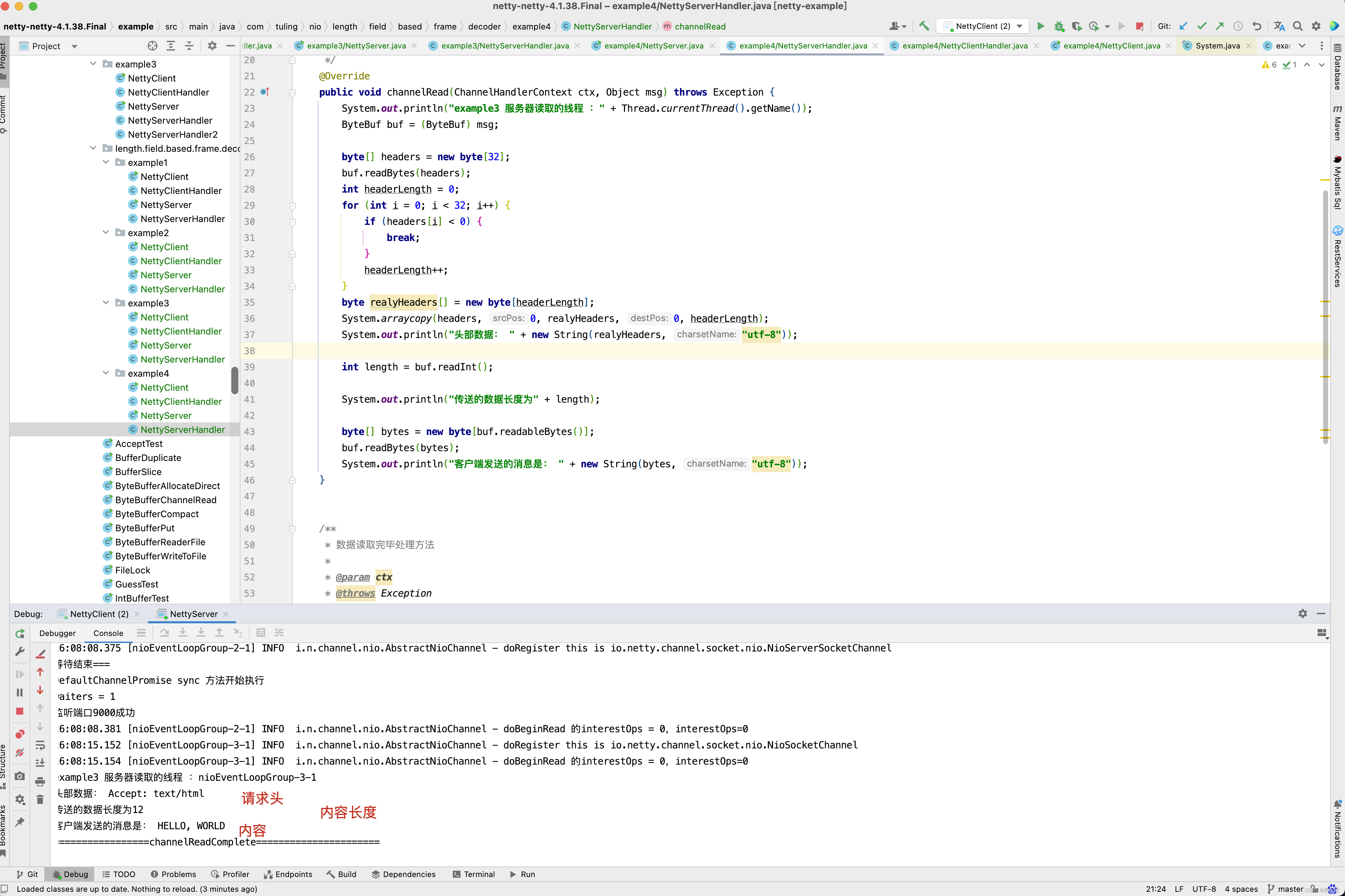
案例5
- lengthFieldOffset=0 长度字段从第0个字节开始
- lengthFieldLength=3 长度字段本身占3个字节
- lengthAdjustment=2 需要调整2字节
- initialBytesToStrip=0 解码后跳过0字节
整个包长度为17字节
| Length(长度) | Header(头) | Actual Content(真实的数据) |
|---|---|---|
| 0x00000C | OxCAFE | HELLO, WORLD |
| 0x00000C==12,该字段为3字节 | 2字节 | 数据总共12字节,长度字段指的是数据的长度 |
lengthFieldOffset为0 ,所以长度字段从0字节开始,lengthFieldLength为3,长度总共占3个字节,因为长度字段后面还剩余14个字节的总长度,但是长度字段的值为12,只表示了数据的长度,不包含头的长度,所以lengthAdjustment为2,就是12 + 2 = 14 ,计算出Header + Content的总长度 。
解码后
| Length(长度) | Header(头) | Actual Content(真实的数据) |
|---|---|---|
| 0x00000C | OxCAFE | HELLO, WORLD |

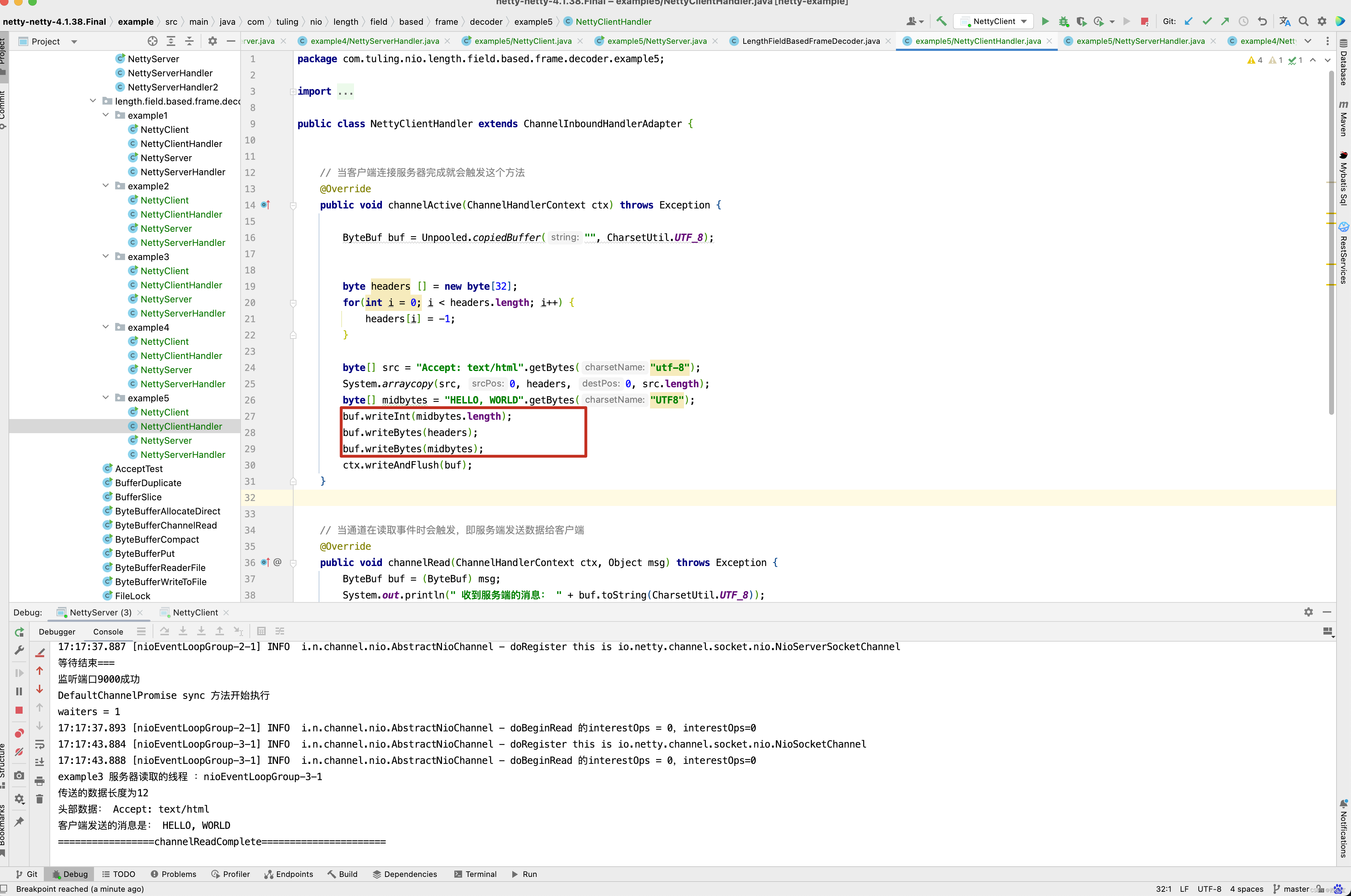
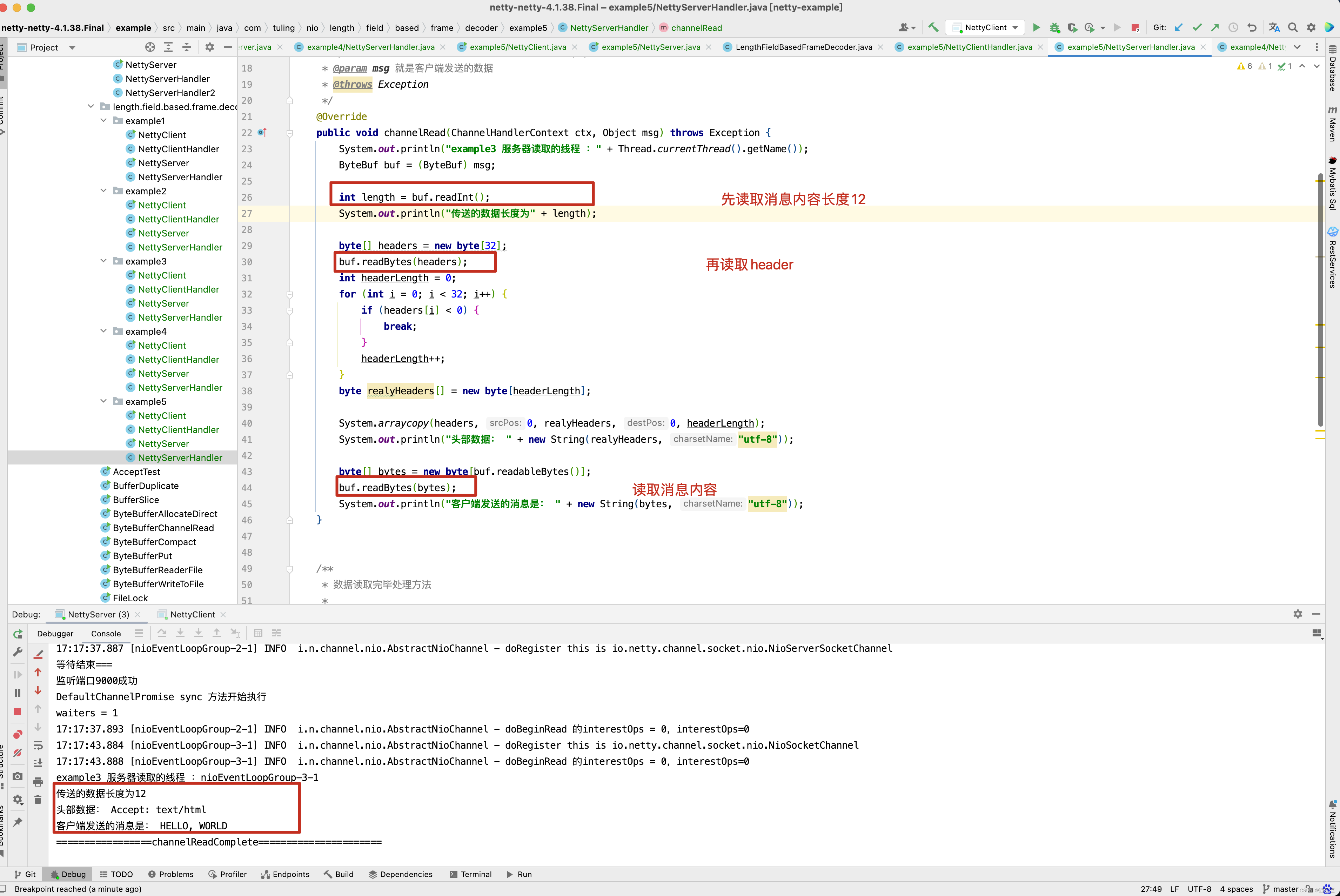
案例6:
- lengthFieldOffset=1 长度字段从第1个字节开始
- lengthFieldLength=2 长度字段本身占2个字节
- lengthAdjustment=1 需要调整1字节
- initialBytesToStrip=3 解码后跳过3字节
整个包的长度为16个字节
| Header(头) | Length(长度) | Header(头) | Actual Content(真实的数据) |
|---|---|---|---|
| oxCA | 0x000C | 0xFE | HELLO, WORLD |
| 1个字节 | 0x000C==12,该字段为2个字节 | 1个字节 | 数据总共12个字节,长度字段指的是数据的长度 |
这一次将Header分为两个1字节的部分,lengthFieldOffset为1表示长度从第1个字节开始,lenghFieldLength为2表示长度字段占2个字节,因为长度字段的值为12,只表示数据的长度,所以lenghAdjustment为1,12 + 1 = 13 ,表示Header 的第二部分加上数据总长度为13 , 因为initialBytesToStrip为3,所以解码后跳过前3个字节 。
解码后
| Header (头) | Actual Content(真实的数据) |
|---|---|
| 0xFE | HELLO, WORLD |
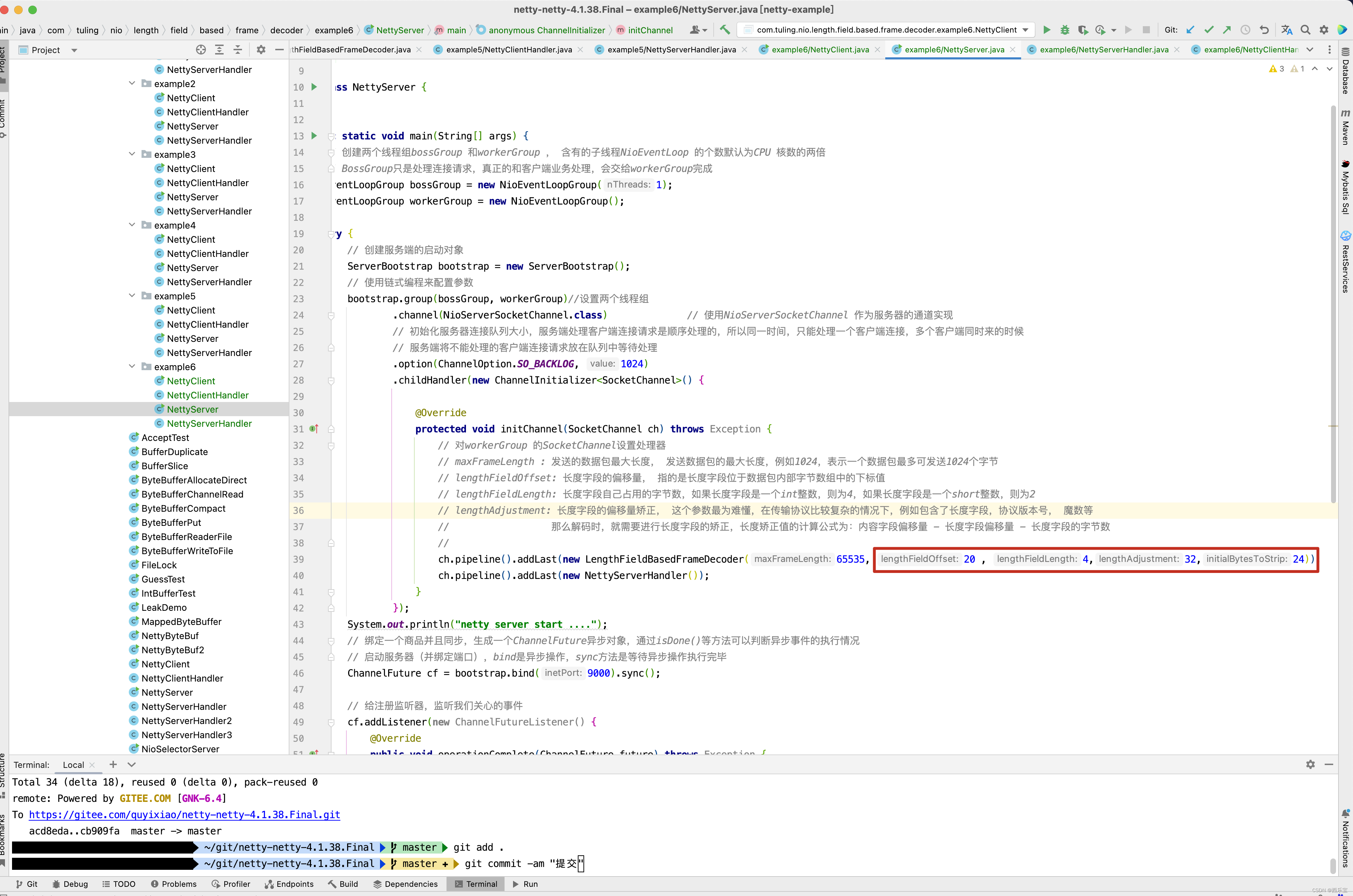
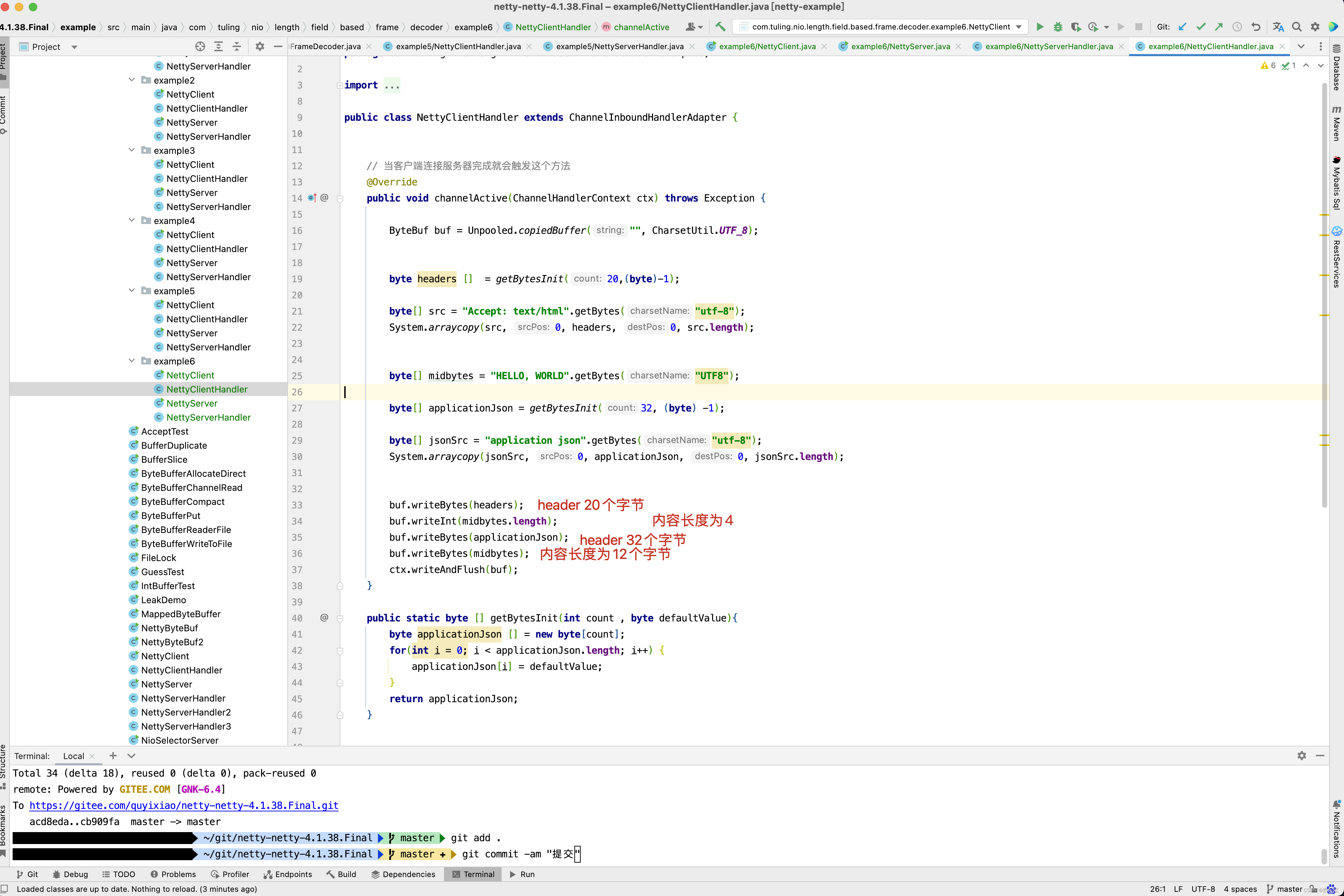

案例7:
- lengthFieldOffset=1 长度字段从第1个字节开始
- lengthFieldLength=2 长度字段本身占2个字节
- lengthAdjustment=-3 需要调整 -3 字节
- initialBytesToStrip=3 解码后跳过3字节
整个包的长度为16字节
| Header(头) | Length(长度) | Header(头) | Actual Content(真实的数据) |
|---|---|---|---|
| 0xCA | 0x0010 | 0xFE | HELLO, WORLD |
| 1字节 | 0x0010==16,该字段为2字节 | 1字节 | 数据总共12字节,长度字段指的是包的总长度 |
这一次长度字段的值为16 , 表示包的总长度 , 所以lengthAdjustment为 -3 , 16+ (-3)=13,表示Header的第二部分加数据部分的总长度为13字节。initialBytesToStrip为3,解码后跳过前3个字节。
解码后
| Header(头) | Actual Content ( 真实的数据) |
|---|---|
| 0xFE | HELLO, WORLD |
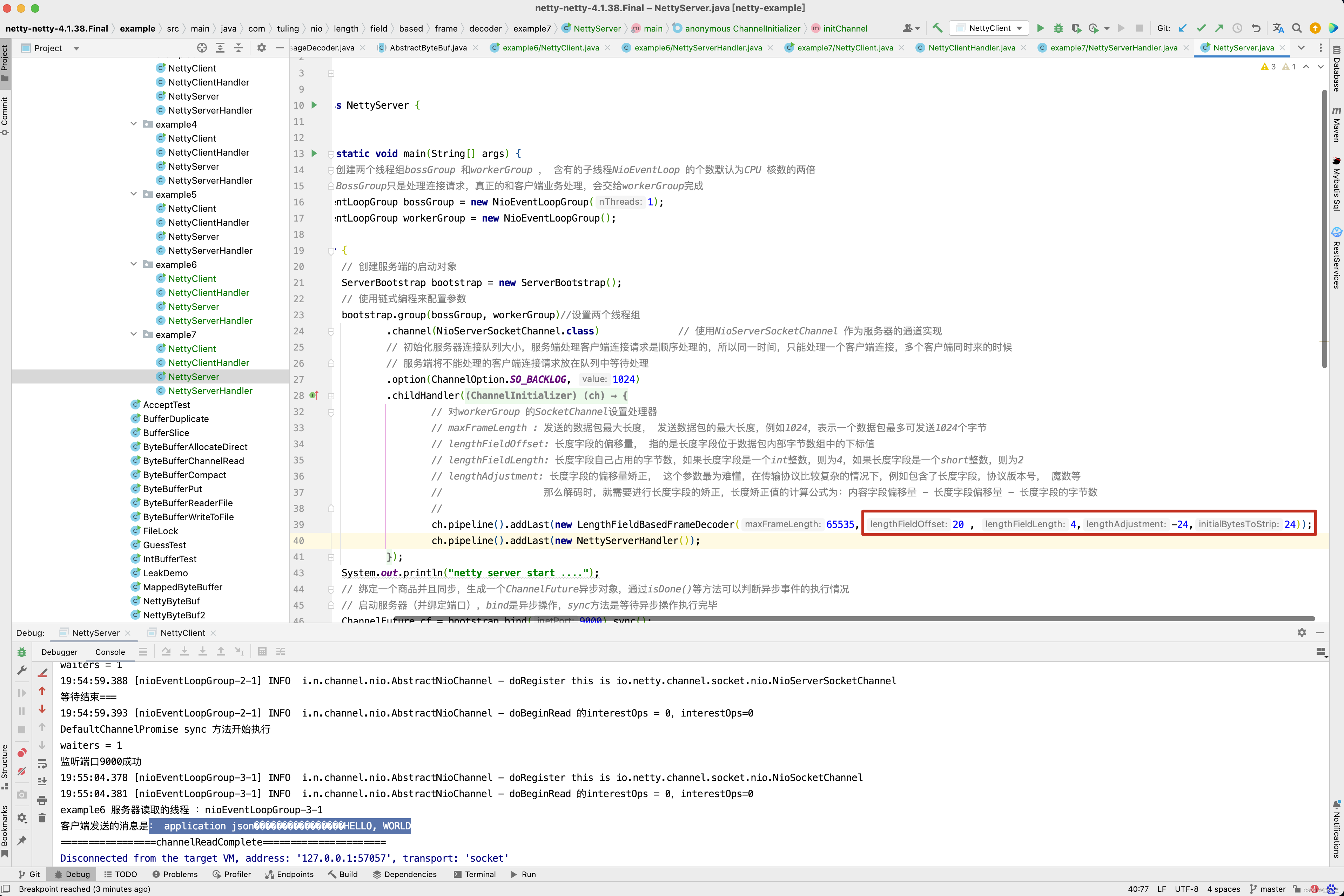
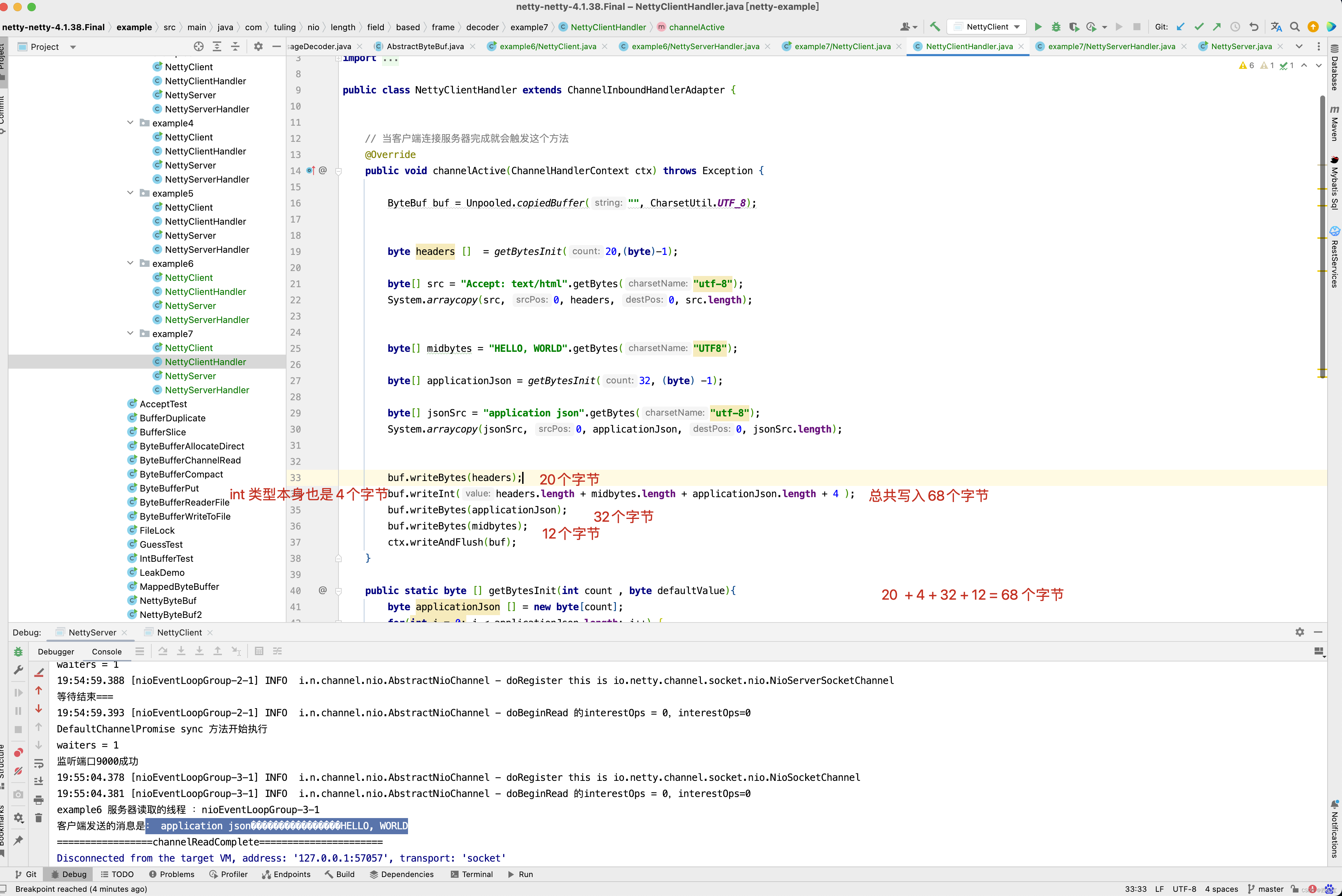
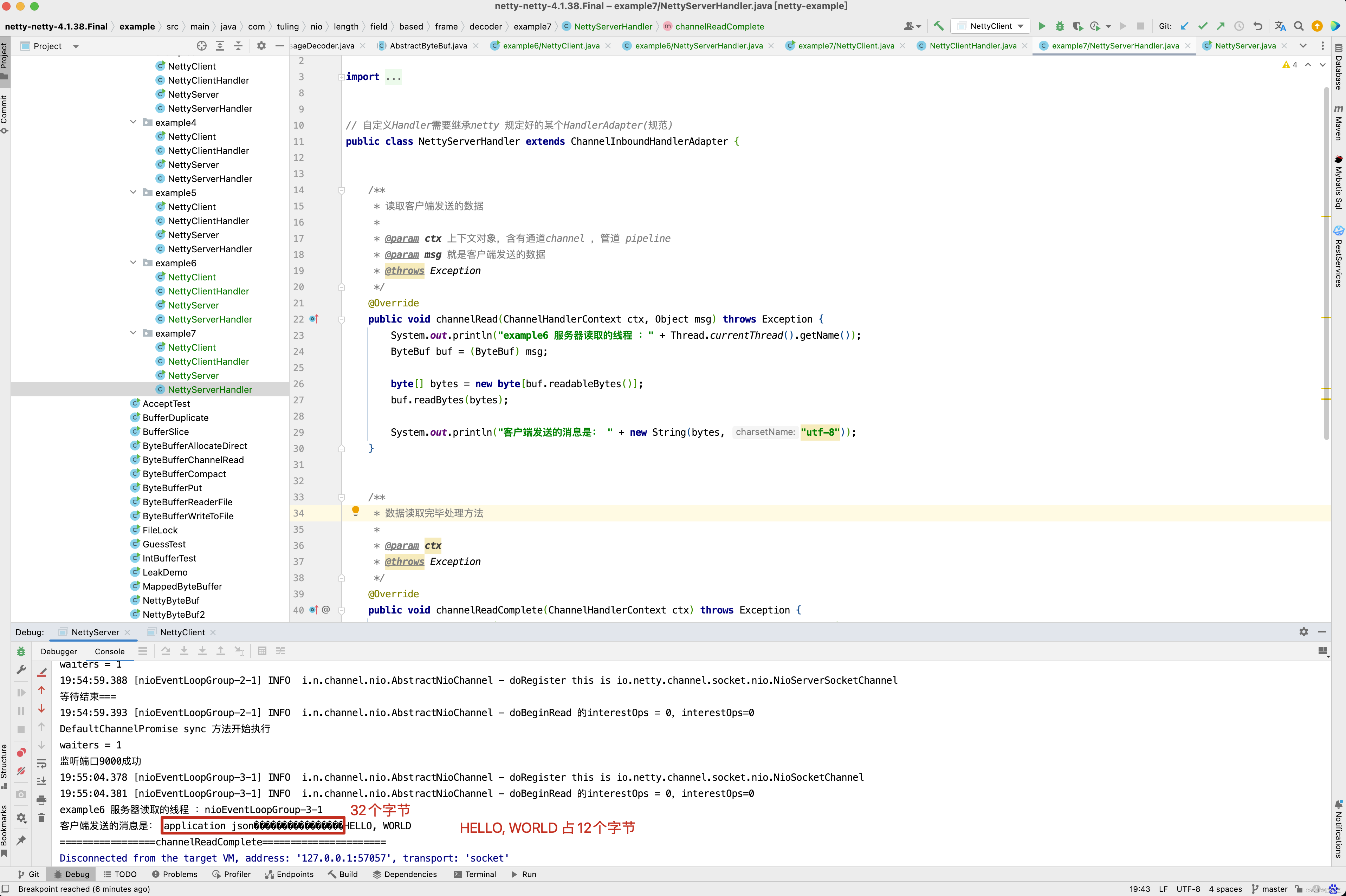
7 个案例,每一个案例都举了一个例子,如果还不懂,可以将源代码下载下来,自己打断点调试。 此时再来分析LengthFieldBasedFrameDecoder的源码就很简单了。 LengthFieldBasedFrameDecoder继承了ByteToMessageDecoder。
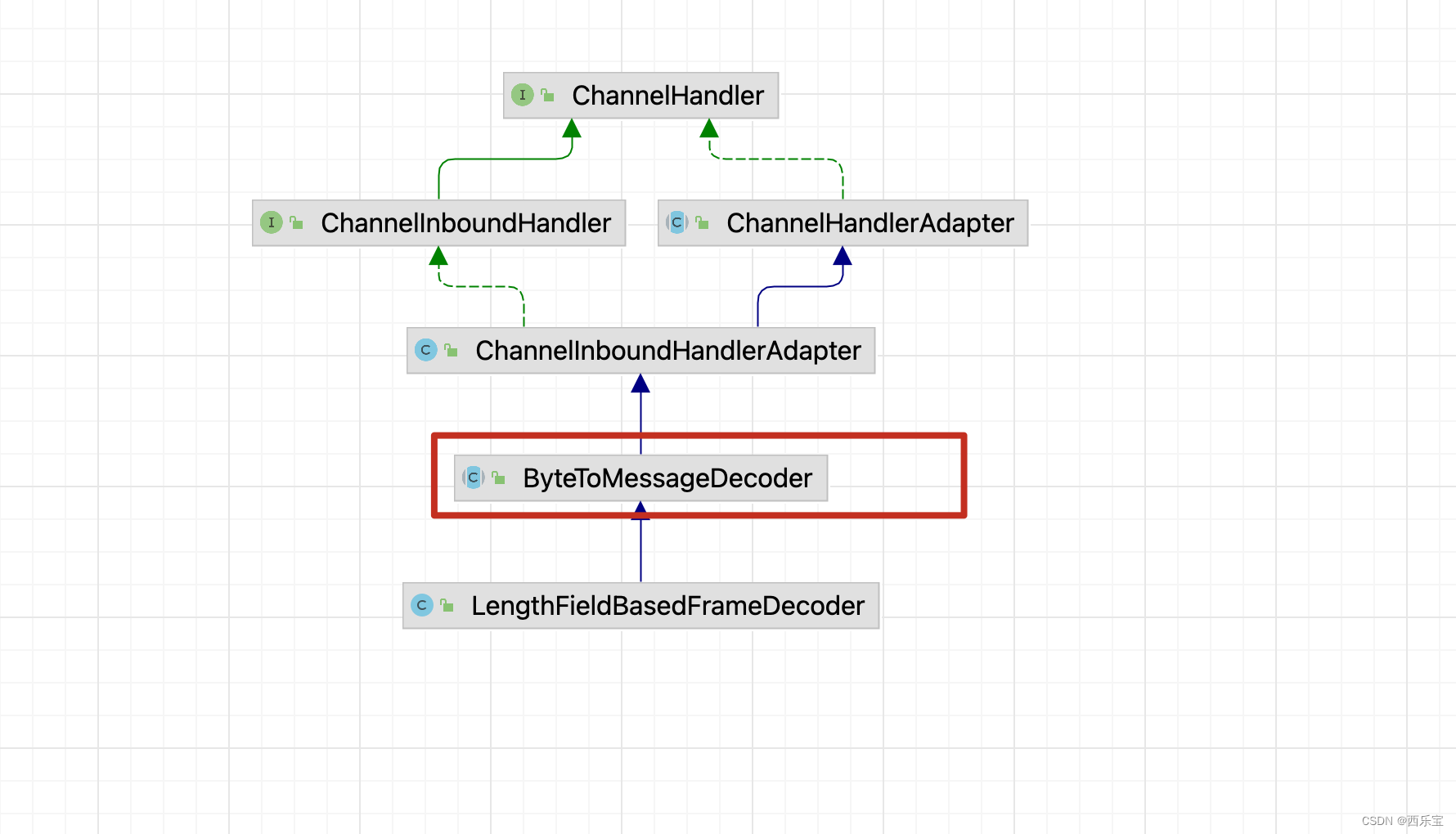
这一行代码ch.pipeline().addLast(new LengthFieldBasedFrameDecoder(65535, 20 , 4,-24,24)) 会将LengthFieldBasedFrameDecoder加入到流水线中。

因此会调用LengthFieldBasedFrameDecoder的channelRead()方法 。
public void channelRead(ChannelHandlerContext ctx, Object msg) throws Exception {
// 1. channelRead()方法首先会判断msg是否为ByteBuf类型,只 有在是的情况下才会进行解码。这也是为什么将StringDecoder等
// MessageToMessageCodec解码器放在ByteToMessageDecoder子类解码器 后面的原因,这时的msg一般是堆外直接内存DirectByteBuf,
// 因为采 用堆外直接内存在传输时可以少一次复制。然后判断是否为第一次解 码,若是,则直接把msg赋值给cumulation(cumulation是读半包字节
// 容器);若不是,则需要把msg写入cumulation中,写入之前要判断是 否需要扩容。
if (msg instanceof ByteBuf) {
// 解码后消息列表
CodecOutputList out = CodecOutputList.newInstance();
try {
ByteBuf data = (ByteBuf) msg;
// 是否为第一次解码
first = cumulation == null;
if (first) {
// 在第一次解码时需要把data(data是msg的类型强转)赋给字节容器即可
cumulation = data;
} else {
// 若不是第一次解码,则需要把msg 写入到cumulation中,写入前需要判断是否需要扩容
cumulation = cumulator.cumulate(ctx.alloc(), cumulation, data);
}
// 从cumulation字节中解码出消息
// 2. 把新读取到的数据写入cumulation后,调用callDecode()方 法。在callDecode()方法中会不断地调用子类的decode()方法,
// 直到 当前cumulation无法继续解码。无法继续解码分两种情况:第一种情 况是无可读字节;第二种情况是经历过decode()方法后,可读字节数 没有任何变化。
callDecode(ctx, cumulation, out);
} catch (DecoderException e) {
throw e;
} catch (Exception e) {
throw new DecoderException(e);
} finally {
// 3. 执行完callDecode()方法后,进入finally代码块进行收尾 工作。若cumulation不为空,且不可读时,需要把cumulation释放掉
// 并赋空值,若连续16次(discardAfterReads的默认值)字节容器 cumulation中仍然有未被业务拆包器读取的数据,则需要进行一次压缩:
// 将有效数据段整体移到容器首部,同时用一个成员变量 firedChannelRead来标识本次读取数据是否拆到了一个业务数据包,
// 并触发fireChannelRead事件,将拆到的业务数据包传递给后续的 Handler,最后把out放回对象池中。
// 当字节容器不为空且不可读时,需要释放,并置空,直接回收,将下次解码认为是第一次
if (cumulation != null && !cumulation.isReadable()) {
numReads = 0;
cumulation.release();
cumulation = null;
} else if (++ numReads >= discardAfterReads) {
// We did enough reads already try to discard some bytes so we not risk to see a OOME.
// See https://github.com/netty/netty/issues/4275
// 如果读取的字节数大于或等于discardAfterReads,则设置读取字节数为0 , 并移除字节容器中的一部分读取的字节
numReads = 0;
discardSomeReadBytes();
}
int size = out.size();
// firedChannelRead 属性在channelReadComplete()方法中被调用
firedChannelRead |= out.insertSinceRecycled();
// 遍历解码消息集合,转发消息到下一个Handler 处理器中
fireChannelRead(ctx, out, size);
// 回收解码消息集合,以便下次循环利用
out.recycle();
}
} else {
ctx.fireChannelRead(msg);
}
}
在上述channelRead()方法中,我们需要注意的是cumulation = cumulator.cumulate(ctx.alloc(), cumulation, data) 这一行代码,那什么时候会进入到这一行代码中去呢? 我们回顾之前的例子。 之前是不是写过这样一个例子,来解决第一次发送 ByteBuf数据长度大于1024个字节时中文乱码问题不?
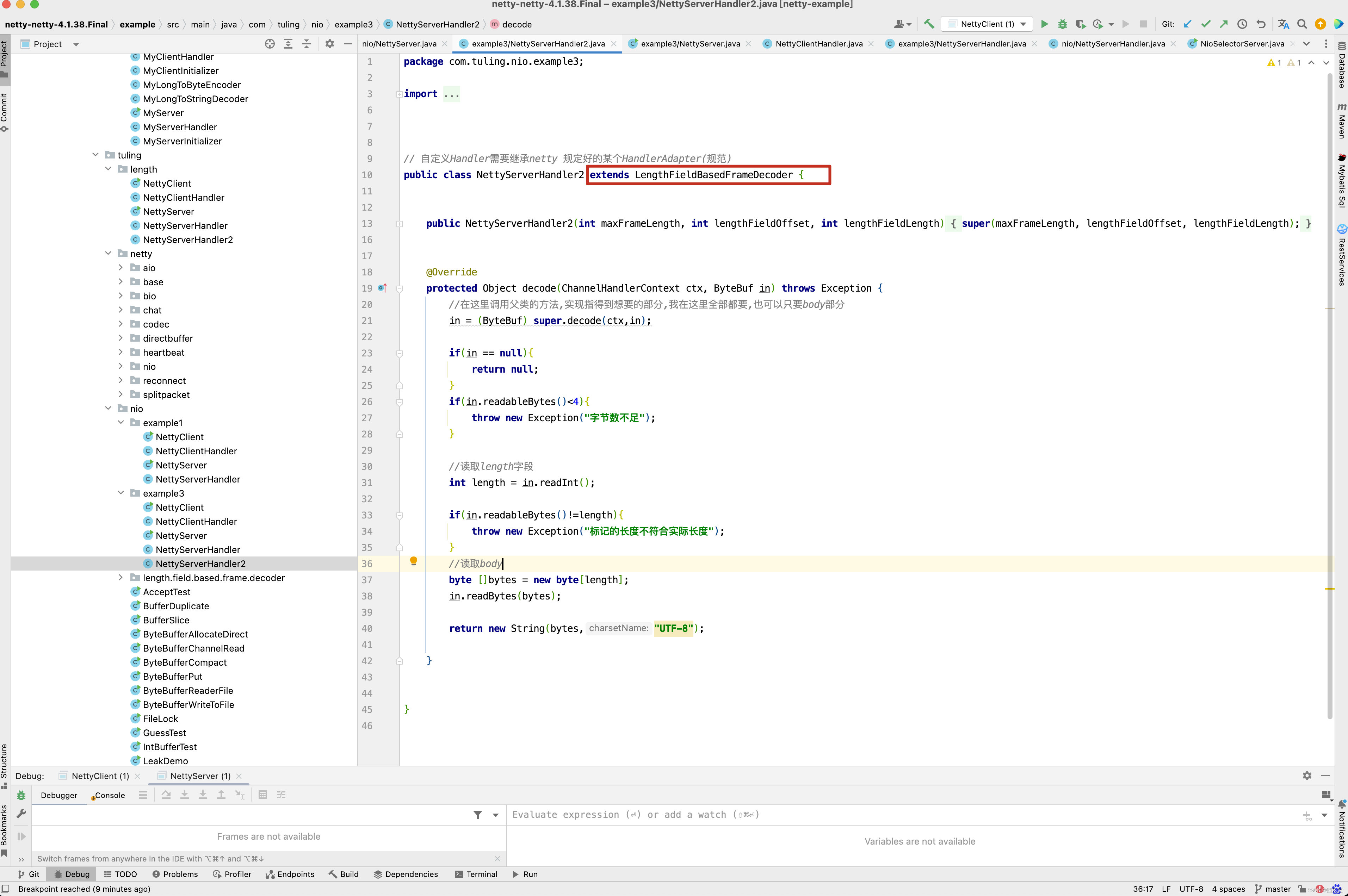
之前知道,在NioSocketChannel的read()方法中,第一次读取数据时,默认情况下初始化ByteBuf的容量为1024,当客户端发送的数据大于1024时,此时就会分两次读取,在我们的例子中,第二次读取就会走cumulator.cumulate(ctx.alloc(), cumulation, data) 这一行代码 。

cumulator的默认值为MERGE_CUMULATOR,接下来进入cumulate()方法。
public static final Cumulator MERGE_CUMULATOR = new Cumulator() {
@Override
public ByteBuf cumulate(ByteBufAllocator alloc, ByteBuf cumulation, ByteBuf in) {
try {
final ByteBuf buffer;
// 判断是否需要扩容 , 其逻辑与组合缓冲区类似
if (cumulation.writerIndex() > cumulation.maxCapacity() - in.readableBytes()
|| cumulation.refCnt() > 1 || cumulation.isReadOnly()) {
// Expand cumulation (by replace it) when either there is not more room in the buffer
// or if the refCnt is greater then 1 which may happen when the user use slice().retain() or
// duplicate().retain() or if its read-only.
//
// See:
// - https://github.com/netty/netty/issues/2327
// - https://github.com/netty/netty/issues/1764
buffer = expandCumulation(alloc, cumulation, in.readableBytes());
} else {
buffer = cumulation;
}
// 把需要解码的字节写入读半包字节容器中
buffer.writeBytes(in);
return buffer;
} finally {
// We must release in in all cases as otherwise it may produce a leak if writeBytes(...) throw
// for whatever release (for example because of OutOfMemoryError)
// 非组合缓冲区,需要释放buf
in.release();
}
}
};
cumulate()方法的主要目的就是合并ByteBuf,为什么呢? 就以本例子为分析对象。 在第一次从Channel中读取1024个字节时。

会调用LengthFieldBasedFrameDecoder的decode()方法,而ByteBuf中可读字节数只有1024,而在NettyClientHandler的channelActive()中,我们写入到Buf中的数据为一个int数4个字节 + 1030 实际内容 ,总共为1034个字节,因此达不到读取条件,因此会将ByteBuf存储在cumulation,当第二次从Channel中读取数据时,此时会将上一次未读取的ByteBuf合并到本次读取的ByteBuf中,而cumulate()方法就是做这件事情 ,接下来进入callDecode()方法 。
protected void callDecode(ChannelHandlerContext ctx, ByteBuf in, List<Object> out) {
try {
// 循环解码
while (in.isReadable()) {
int outSize = out.size();
// 判断是否已经有可用的消息
if (outSize > 0) {
// 触发下一个Handler 去处理这些解码出来的消息
fireChannelRead(ctx, out, outSize);
out.clear();
// Check if this handler was removed before continuing with decoding.
// If it was removed, it is not safe to continue to operate on the buffer.
//
// See:
// - https://github.com/netty/netty/issues/4635
// 检测Handler是否被从通道处理器上下文移除了,若被移除了,则不能继续操作
if (ctx.isRemoved()) {
break;
}
outSize = 0;
}
// 获取字节容器的可读字节数
int oldInputLength = in.readableBytes();
// 解码字节buf中的数据为消息对象,并将其放入out 中,如果解码器被从通道处理器上下文移除了,则处理移除事件
decodeRemovalReentryProtection(ctx, in, out);
// Check if this handler was removed before continuing the loop.
// If it was removed, it is not safe to continue to operate on the buffer.
//
// See https://github.com/netty/netty/issues/1664
if (ctx.isRemoved()) {
break;
}
if (outSize == out.size()) {
// 如果可读字节数无变化,则说明解码失败,无须继续解码
if (oldInputLength == in.readableBytes()) {
break;
} else {
continue;
}
}
// 异常
if (oldInputLength == in.readableBytes()) {
throw new DecoderException(
StringUtil.simpleClassName(getClass()) +
".decode() did not read anything but decoded a message.");
}
// 是否只能解码一次
if (isSingleDecode()) {
break;
}
}
} catch (DecoderException e) {
throw e;
} catch (Exception cause) {
throw new DecoderException(cause);
}
}
如果decodeRemovalReentryProtection()方法前后可读取字节数没有变化,则说明解码失败,直接退出循环。 那decodeRemovalReentryProtection()方法做了哪些事情呢?
final void decodeRemovalReentryProtection(ChannelHandlerContext ctx, ByteBuf in, List<Object> out)
throws Exception {
decodeState = STATE_CALLING_CHILD_DECODE;
try {
// 由子类完成
decode(ctx, in, out);
} finally {
// Channel 的处理器是否正在移除
boolean removePending = decodeState == STATE_HANDLER_REMOVED_PENDING;
decodeState = STATE_INIT;
if (removePending) {
// 处理Handler 从通道处理器移除事件
handlerRemoved(ctx);
}
}
}
我们以LengthFieldBasedFrameDecoder为例子,分析decode()方法 。
protected final void decode(ChannelHandlerContext ctx, ByteBuf in, List<Object> out) throws Exception {
Object decoded = decode(ctx, in);
if (decoded != null) {
out.add(decoded);
}
}
protected Object decode(ChannelHandlerContext ctx, ByteBuf in) throws Exception {
if (discardingTooLongFrame) {
// 丢弃模式
discardingTooLongFrame(in);
}
// 判断缓冲区中可读的字节数是否小于长度字节的偏移量
if (in.readableBytes() < lengthFieldEndOffset) {
// 说明长度字段的包都还不完整, 半包
return null;
}
// 执行到这里,说明可以解析出长度字段的值了 。
// 计算出长度字节开始的偏移量
int actualLengthFieldOffset = in.readerIndex() + lengthFieldOffset;
// 获取长度字段的值, 不包括lengthAdjustment的调整值
long frameLength = getUnadjustedFrameLength(in, actualLengthFieldOffset, lengthFieldLength, byteOrder);
// 如果数据帧长度小于0 , 说明是错误的数据包
if (frameLength < 0) {
// 内部会跳过这个数据包的字节数, 并抛出异常
failOnNegativeLengthField(in, frameLength, lengthFieldEndOffset);
}
// 套用前面的公式,长度字段后的数据字节数 = 长度字段的值 + lengthAdjustment
// frameLength就是长度字段的值, 加上 lengthAdjustment等于长度字段后的数据字节数
// lengthFieldEndOffset为lengthFieldOffset+lengthFieldLength
// 那说明最后计算出的frameLength就是整个数据包的长度
frameLength += lengthAdjustment + lengthFieldEndOffset;
// 判断是否为错误的数据包
if (frameLength < lengthFieldEndOffset) {
failOnFrameLengthLessThanLengthFieldEndOffset(in, frameLength, lengthFieldEndOffset);
}
// 整个数据包的长度是否大于最大帧长度
// 丢弃模式就是在这里开启的
// 如果数据包长度大于最大长度
if (frameLength > maxFrameLength) {
// 丢弃超出的部分,丢弃模式 。 对超出部分进行处理
exceededFrameLength(in, frameLength);
return null;
}
// never overflows because it's less than maxFrameLength
// 执行到这里说明是正常模式
// 数据包的大小
int frameLengthInt = (int) frameLength;
/// 判断缓冲区可读字节数是否小于数据包的字节数
if (in.readableBytes() < frameLengthInt) {
// 半包,等于再来解析
return null;
}
// 执行到这里说明缓冲区数据已经包含了数据包
// 跳过的字节数是否大于数据包的长度
if (initialBytesToStrip > frameLengthInt) {
failOnFrameLengthLessThanInitialBytesToStrip(in, frameLength, initialBytesToStrip);
}
// 跳过的字节数是否大于数据包的长度
in.skipBytes(initialBytesToStrip);
// extract frame
// 解码
// 获取当前可读下标
int readerIndex = in.readerIndex();
// 获取跳过后的真实数据长度
int actualFrameLength = frameLengthInt - initialBytesToStrip;
// 更新一下可读下标
ByteBuf frame = extractFrame(ctx, in, readerIndex, actualFrameLength);
// 返回数据
in.readerIndex(readerIndex + actualFrameLength);
return frame;
}
private void discardingTooLongFrame(ByteBuf in) {
// 保存还需要丢弃多少字节
long bytesToDiscard = this.bytesToDiscard;
// 获取当前可以丢弃的字节数, 有可能出现半包情况
int localBytesToDiscard = (int) Math.min(bytesToDiscard, in.readableBytes());
// 丢弃
in.skipBytes(localBytesToDiscard);
// 更新还需要丢弃的字节数
bytesToDiscard -= localBytesToDiscard;
this.bytesToDiscard = bytesToDiscard;
// 是否需要快速失败,回到上面的逻辑
failIfNecessary(false);
}
/**
* Decodes the specified region of the buffer into an unadjusted frame length. The default implementation is
* capable of decoding the specified region into an unsigned 8/16/24/32/64 bit integer. Override this method to
* decode the length field encoded differently. Note that this method must not modify the state of the specified
* buffer (e.g. {@code readerIndex}, {@code writerIndex}, and the content of the buffer.)
*
* @throws DecoderException if failed to decode the specified region
* 解析长度字段的值
* offset : 长度字段开始的偏移量
* length : 长度字节的字节数
*/
protected long getUnadjustedFrameLength(ByteBuf buf, int offset, int length, ByteOrder order) {
// 大小端排序
buf = buf.order(order);
// 长度字段的值
long frameLength;
// 根据长度字段的字节数,获取长度字段的值
switch (length) {
case 1:
// byte
frameLength = buf.getUnsignedByte(offset);
break;
case 2:
// short
frameLength = buf.getUnsignedShort(offset);
break;
case 3:
// int 占32位,这里取出后24位,返回int类型
frameLength = buf.getUnsignedMedium(offset);
break;
case 4:
// int
frameLength = buf.getUnsignedInt(offset);
break;
case 8:
// long
frameLength = buf.getLong(offset);
break;
default:
throw new DecoderException(
"unsupported lengthFieldLength: " + lengthFieldLength + " (expected: 1, 2, 3, 4, or 8)");
}
// 返回长度字段的值
return frameLength;
}
// frameLength :数据包的长度
private void exceededFrameLength(ByteBuf in, long frameLength) {
// 数据包长度-可读字节数 两种模式
// 1.数据包总长度为100,可读字节数为50 , 说明还剩下50个字节需要丢弃但还未接收到
// 2.数据包总长度为100,可读的字节数为150,说明缓冲区已经包含了整个数据包
long discard = frameLength - in.readableBytes();
// 记录一下最大的数据包的长度
tooLongFrameLength = frameLength;
if (discard < 0) {
// buffer contains more bytes then the frameLength so we can discard all now
// 说明是第二种情况,直接丢弃当前数据包
in.skipBytes((int) frameLength);
} else {
// 说明是第一种情况,还有部分数据未接收到。
// Enter the discard mode and discard everything received so far.
// 开启丢弃模式
discardingTooLongFrame = true;
// 记录下次还需要丢弃多少字节
bytesToDiscard = discard;
// 丢弃缓冲区所有的数据
in.skipBytes(in.readableBytes());
}
// 跟进去
failIfNecessary(true);
}
// 程序最终会执行fail()方法并抛出TooLongFrameException异常
private void fail(long frameLength) {
// 丢弃完成或未完成都抛出异常
if (frameLength > 0) {
throw new TooLongFrameException(
"Adjusted frame length exceeds " + maxFrameLength +
": " + frameLength + " - discarded");
} else {
throw new TooLongFrameException(
"Adjusted frame length exceeds " + maxFrameLength +
" - discarding");
}
}
// 获取真实的数据
// index : 可读的下标
// length : 要读取的长度
protected ByteBuf extractFrame(ChannelHandlerContext ctx, ByteBuf buffer, int index, int length) {
return buffer.retainedSlice(index, length);
}
private void failIfNecessary(boolean firstDetectionOfTooLongFrame) {
if (bytesToDiscard == 0) {
// Reset to the initial state and tell the handlers that
// the frame was too large.
// 说明需要丢弃的数据已经丢弃完成
// 保存一下被丢弃的数据包的长度
long tooLongFrameLength = this.tooLongFrameLength;
this.tooLongFrameLength = 0;
// 关闭丢弃模式
discardingTooLongFrame = false;
// failFast : 默认为true
// firstDetectionOfTooLongFrame : 传入true
if (!failFast || firstDetectionOfTooLongFrame) {
// 快速失败
fail(tooLongFrameLength);
}
} else {
// 说明还未丢弃完成
// Keep discarding and notify handlers if necessary.
if (failFast && firstDetectionOfTooLongFrame) {
// 快速失败
fail(tooLongFrameLength);
}
}
}
在整个分析过程中,我们着重注意LengthFieldBasedFrameDecoder的decode()方法 。

如果本次解析得到的对象不为空,则表明解析成功,将对象添加到out集合中。 而在LengthFieldBasedFrameDecoder的父类ByteToMessageDecoder的channelRead()的finally代码块中,有一个fireChannelRead()方法。
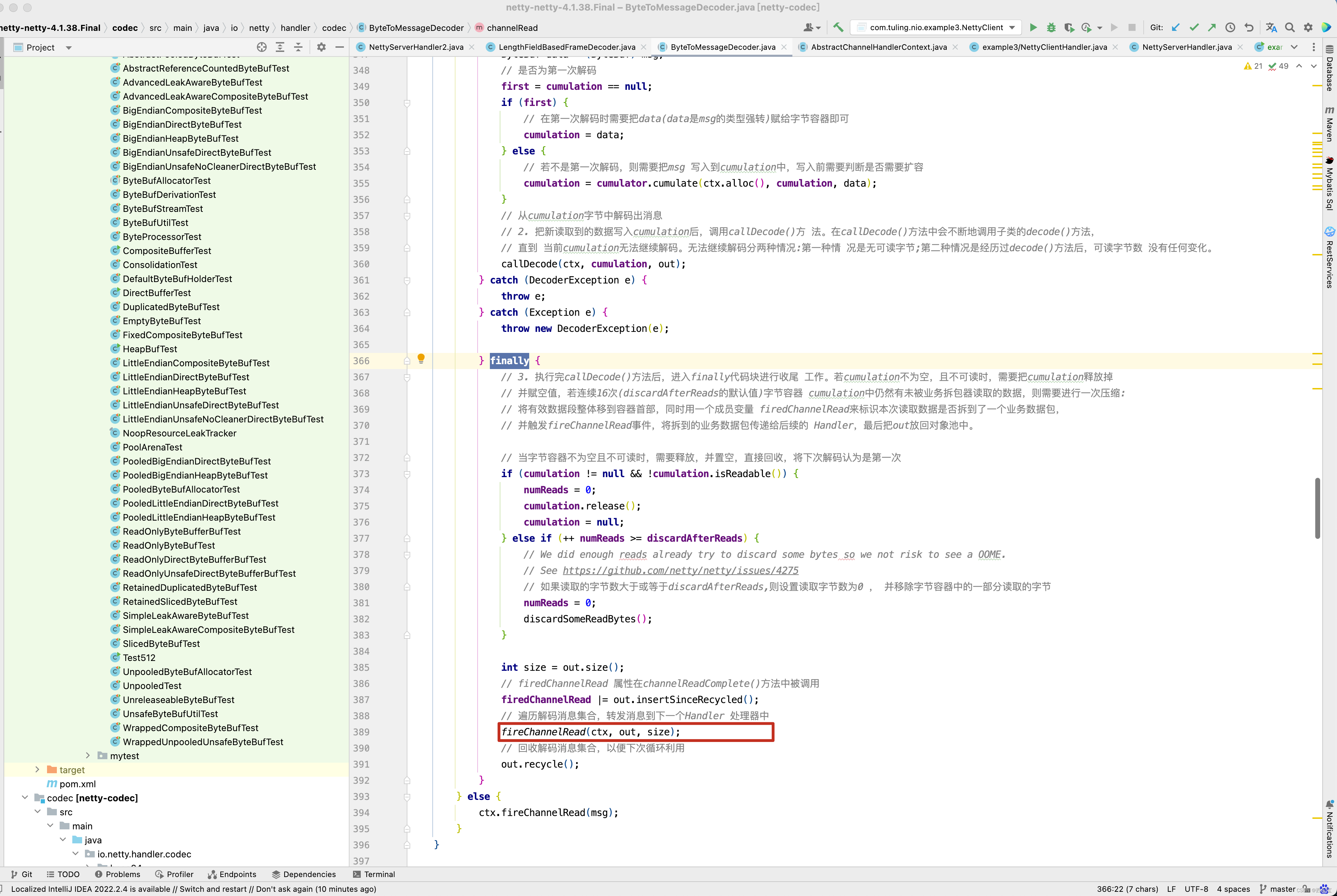
这个方法会遍历所有的out集合中的对象,并传递给一下个Handler。并调用下一个Handler的channelRead()方法 。
static void fireChannelRead(ChannelHandlerContext ctx, CodecOutputList msgs, int numElements) {
for (int i = 0; i < numElements; i ++) {
ctx.fireChannelRead(msgs.getUnsafe(i));
}
}
程序执行到这里,我们应该对LengthFieldBasedFrameDecoder的源码有一定的了解,对于解决之前乱码问题的原理也知道了,在这里总节一下,当第一次从Channel中读取到1024个字节到ByteBuf中,先将这个ByteBuf缓存在LengthFieldBasedFrameDecoder的cumulation字段中,再通过decode()方法进行解码,解码前先读取4个字节,注意这里调用的是getUnsignedInt()方法,不存在读索引的移动,而4个字节的内容长度为1030,而本次发送的内容总长度为1030 + 4(头部int占4个字节) = 1034个字节,而ByteBuf中总共只有1024个字节,因此本次解析失败,等待下一次从Channel中读取ByteBuf ,当第二次从Channel中读取字节时,此时ButeBuf中有10个字节,先调用cumulator.cumulate(ctx.alloc(), cumulation, data)方法将本次读取的字节和上一次读取的字节合并,再调用LengthFieldBasedFrameDecoder的decode进行解码,解码时,发现合并后的ByteBuf中有1034个字节,已经达到解析条件,因此调用buffer.retainedSlice(index, length) 方法,返回读取的ByteBuf并添加到out中,在ByteToMessageDecoder的channelRead()方法中的finally中,调用fireChannelRead(ctx, out, size)方法,将新组装的ByteBuf传递到一下个Handler中。 当然,到这里,我们已经对 RecvByteBufAllocator内存分配计算 这篇博客的第三种方案的原理已经做了详细的解析。关于LengthFieldBasedFrameDecoder这一块的源码解析也告一段落 。
DelimiterBasedFrameDecoder源码解析
先来看一个例子。
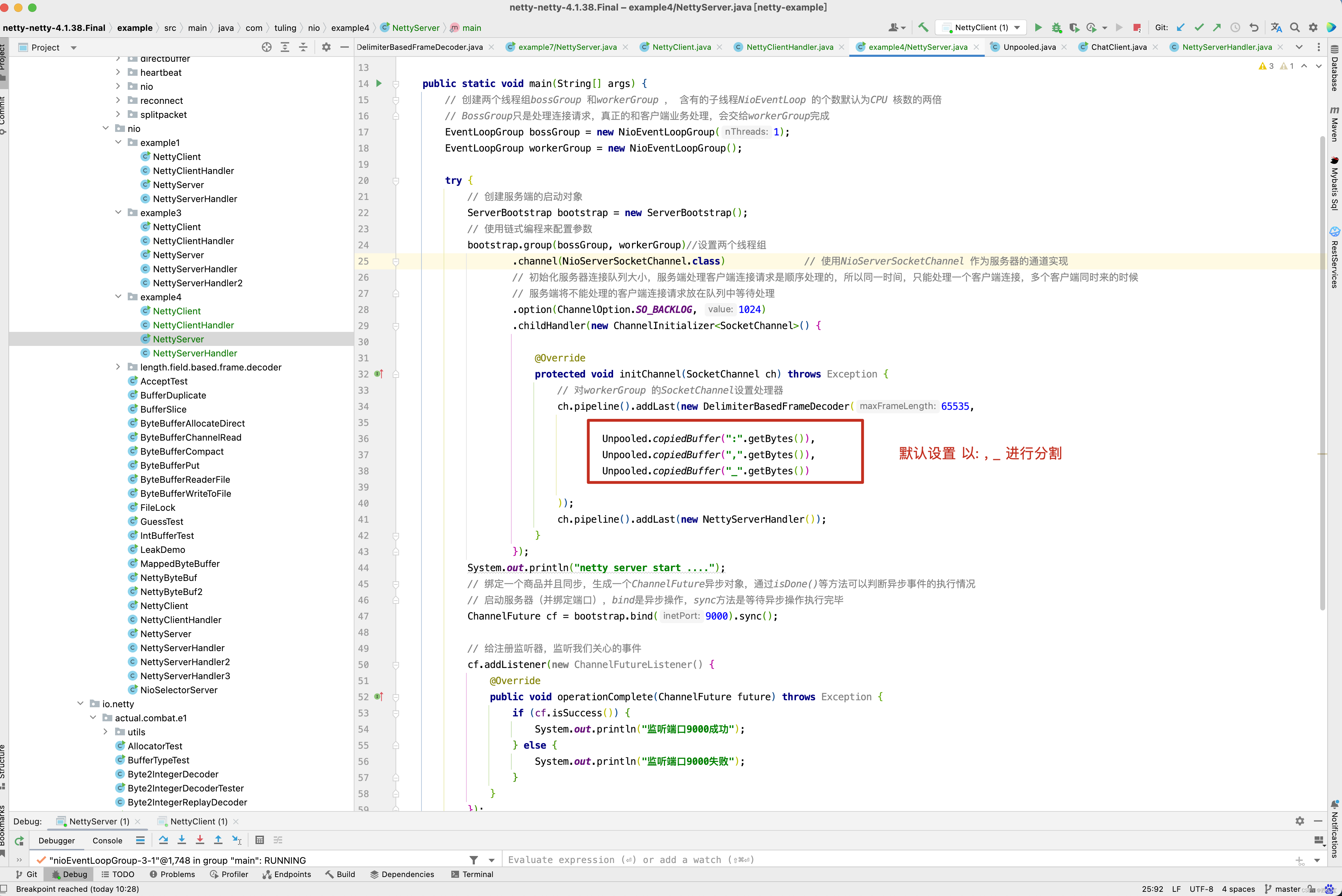
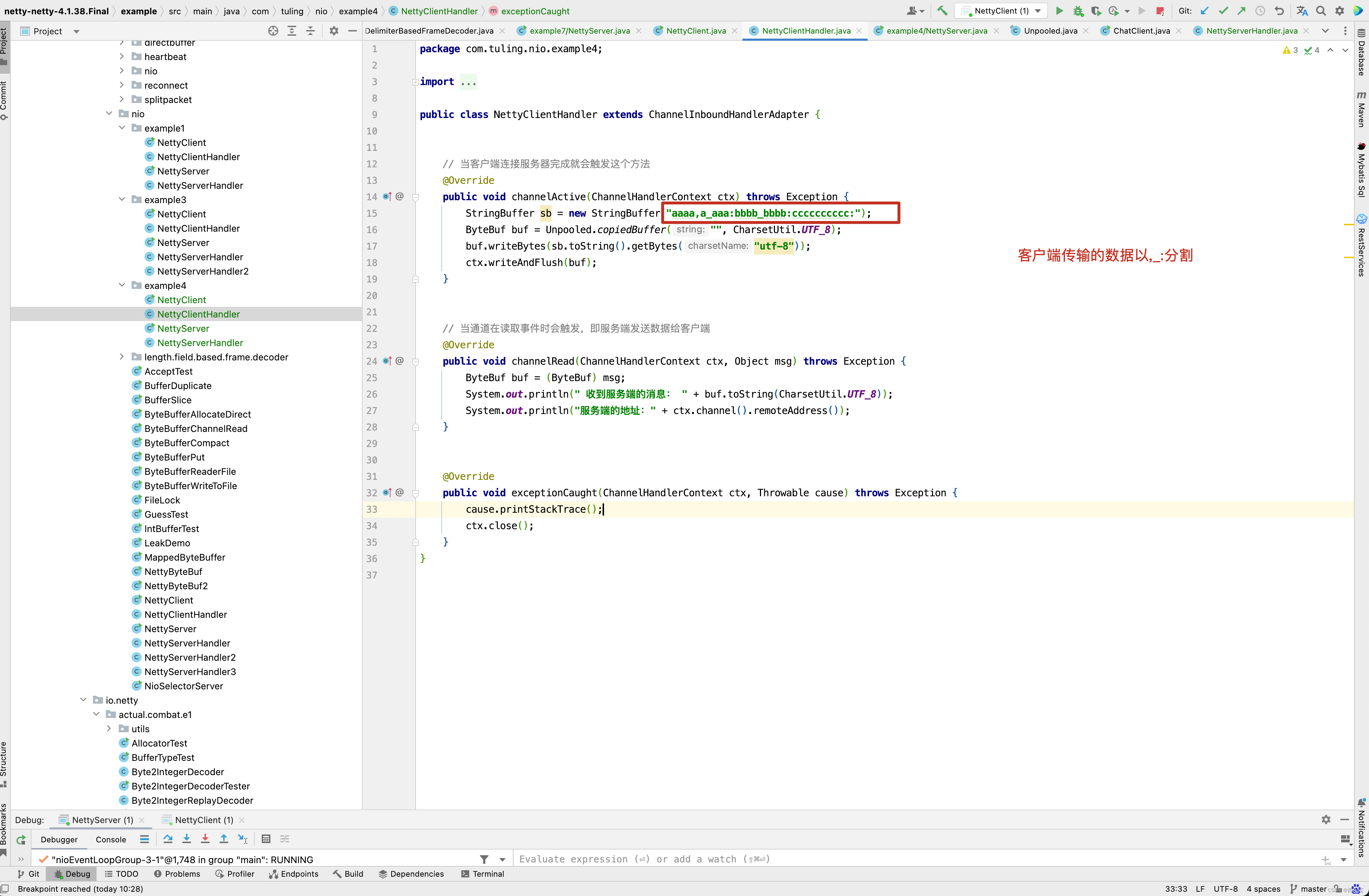
最终打印数据如下:

自定义分隔符解码器DelimiterBasedFrameDecoder也是实现了ByteToMessageDecoder,他的源码和LengthFieldBasedFrameDecoder非常类似 。
public class DelimiterBasedFrameDecoder extends ByteToMessageDecoder {
private final ByteBuf[] delimiters; //自定义多个分隔符,可以使用多个
private final int maxFrameLength; // 每个消息段落的最大长度
private final boolean stripDelimiter; // 解码消息时,是否丢弃分隔符
private final boolean failFast; // 遇到错误时,是否抛出异常
private boolean discardingTooLongFrame; // 状态变量,是否正在丢弃一个段的消息
private int tooLongFrameLength; //丢弃总长度
/** Set only when decoding with "\n" and "\r\n" as the delimiter. */
private final LineBasedFrameDecoder lineBasedDecoder; // \r \n 的解码器
public DelimiterBasedFrameDecoder(
int maxFrameLength, boolean stripDelimiter, boolean failFast, ByteBuf... delimiters) {
validateMaxFrameLength(maxFrameLength);
if (delimiters == null) {
throw new NullPointerException("delimiters");
}
if (delimiters.length == 0) {
throw new IllegalArgumentException("empty delimiters");
}
// delimiters里的分隔符是否是 \r \n
if (isLineBased(delimiters) && !isSubclass()) {
lineBasedDecoder = new LineBasedFrameDecoder(maxFrameLength, stripDelimiter, failFast);
this.delimiters = null;
} else {
// 创建数组
this.delimiters = new ByteBuf[delimiters.length];
for (int i = 0; i < delimiters.length; i ++) {
ByteBuf d = delimiters[i];
validateDelimiter(d);
// 创建d的分区放入数组
this.delimiters[i] = d.slice(d.readerIndex(), d.readableBytes());
}
lineBasedDecoder = null;
}
this.maxFrameLength = maxFrameLength;
this.stripDelimiter = stripDelimiter;
this.failFast = failFast;
}
}
/** Returns true if the delimiters are "\n" and "\r\n". */
// 判断是否是以 \r \n 分割
private static boolean isLineBased(final ByteBuf[] delimiters) {
if (delimiters.length != 2) {
return false;
}
ByteBuf a = delimiters[0];
ByteBuf b = delimiters[1];
if (a.capacity() < b.capacity()) {
a = delimiters[1];
b = delimiters[0];
}
return a.capacity() == 2 && b.capacity() == 1
&& a.getByte(0) == '\r' && a.getByte(1) == '\n'
&& b.getByte(0) == '\n';
}
接下来看他的decode()方法和LengthFieldBasedFrameDecoder一样,都是先进行解码,如果解码成功,则将解码后的对象添加到out中。
protected final void decode(ChannelHandlerContext ctx, ByteBuf in, List<Object> out) throws Exception {
Object decoded = decode(ctx, in);
if (decoded != null) {
out.add(decoded);
}
}
protected Object decode(ChannelHandlerContext ctx, ByteBuf buffer) throws Exception {
// 如果分割符是以\r\n,则用lineBasedDecoder解码器解析
if (lineBasedDecoder != null) {
// 此类相当于lineBasedDecoder
return lineBasedDecoder.decode(ctx, buffer);
}
// Try all delimiters and choose the delimiter which yields the shortest frame.
int minFrameLength = Integer.MAX_VALUE;
ByteBuf minDelim = null;
// 循环所有的分隔符, 挨个去匹配
for (ByteBuf delim: delimiters) {
// 匹配分隔符的起始位置
int frameLength = indexOf(buffer, delim);
// 大于0 , 并且小于int最大值,说明匹配成功
if (frameLength >= 0 && frameLength < minFrameLength) {
minFrameLength = frameLength;
minDelim = delim;
}
}
// 如果匹配成功
if (minDelim != null) {
// 分隔符的capacity 就代表了分配符的长度
int minDelimLength = minDelim.capacity();
ByteBuf frame;
// 如果之前已经开始丢弃字节
if (discardingTooLongFrame) {
// We've just finished discarding a very large frame.
// Go back to the initial state.
// 恢复标记位
discardingTooLongFrame = false;
// 跳过minFrameLength + 分隔符的长度,表示丢弃了前一个完整的消息
buffer.skipBytes(minFrameLength + minDelimLength);
int tooLongFrameLength = this.tooLongFrameLength;
// 丢弃的字节总数
this.tooLongFrameLength = 0;
if (!failFast) {
fail(tooLongFrameLength);
}
return null;
}
// 消息的长度大于阈值
if (minFrameLength > maxFrameLength) {
// Discard read frame.
// 丢弃一个消息
buffer.skipBytes(minFrameLength + minDelimLength);
fail(minFrameLength);
return null;
}
// 丢弃分隔符
if (stripDelimiter) {
// 返回一个消息的frame
frame = buffer.readRetainedSlice(minFrameLength);
// 丢弃分隔符
buffer.skipBytes(minDelimLength);
} else {
// 返回一个消息,包括了分隔符
frame = buffer.readRetainedSlice(minFrameLength + minDelimLength);
}
return frame;
} else { // 没找到分隔符的位置
// 正常情况
if (!discardingTooLongFrame) {
// 如果可读字节大于最大长度限制
if (buffer.readableBytes() > maxFrameLength) {
// Discard the content of the buffer until a delimiter is found.
tooLongFrameLength = buffer.readableBytes();
// 丢弃字节
buffer.skipBytes(buffer.readableBytes());
// 标记丢弃的状态
discardingTooLongFrame = true;
if (failFast) {
fail(tooLongFrameLength);
}
}
} else {
// 之前discardingTooLongFrame已经设置为true
// Still discarding the buffer since a delimiter is not found.
// 增加总丢弃的数量
tooLongFrameLength += buffer.readableBytes();
// 继续丢弃字节
buffer.skipBytes(buffer.readableBytes());
}
return null;
}
}
private void fail(long frameLength) {
if (frameLength > 0) {
throw new TooLongFrameException(
"frame length exceeds " + maxFrameLength +
": " + frameLength + " - discarded");
} else {
throw new TooLongFrameException(
"frame length exceeds " + maxFrameLength +
" - discarding");
}
}
/**
* Returns the number of bytes between the readerIndex of the haystack and
* the first needle found in the haystack. -1 is returned if no needle is
* found in the haystack.
*/
private static int indexOf(ByteBuf haystack, ByteBuf needle) {
// 循环输入的字节流缓冲区,假设为 a b c d e
for (int i = haystack.readerIndex(); i < haystack.writerIndex(); i ++) {
// 从a[0]位置开始找
int haystackIndex = i;
int needleIndex;
// 循环分隔符
for (needleIndex = 0; needleIndex < needle.capacity(); needleIndex ++) {
// 如果分隔符与haystack.getByte(haystackIndex) 不同,则结束当前循环
// haystack.getByte(haystackIndex) 从b开始继续查询
if (haystack.getByte(haystackIndex) != needle.getByte(needleIndex)) {
break;
} else {
haystackIndex ++;
// 依次拿出bcde进行匹配,如果输出的缓冲区达到了末尾 , 并且分隔符缓冲区还没有达到末尾,说明匹配失败
if (haystackIndex == haystack.writerIndex() &&
needleIndex != needle.capacity() - 1) {
return -1;
}
}
}
// 如果分隔符缓冲区达到末尾 ,还没有发生上面的情况,说明匹配到了
if (needleIndex == needle.capacity()) {
// Found the needle from the haystack!
// i 减去haystack.readerIndex()的位置就是分隔符的位置
return i - haystack.readerIndex();
}
}
return -1;
}
从之前的例4来看。
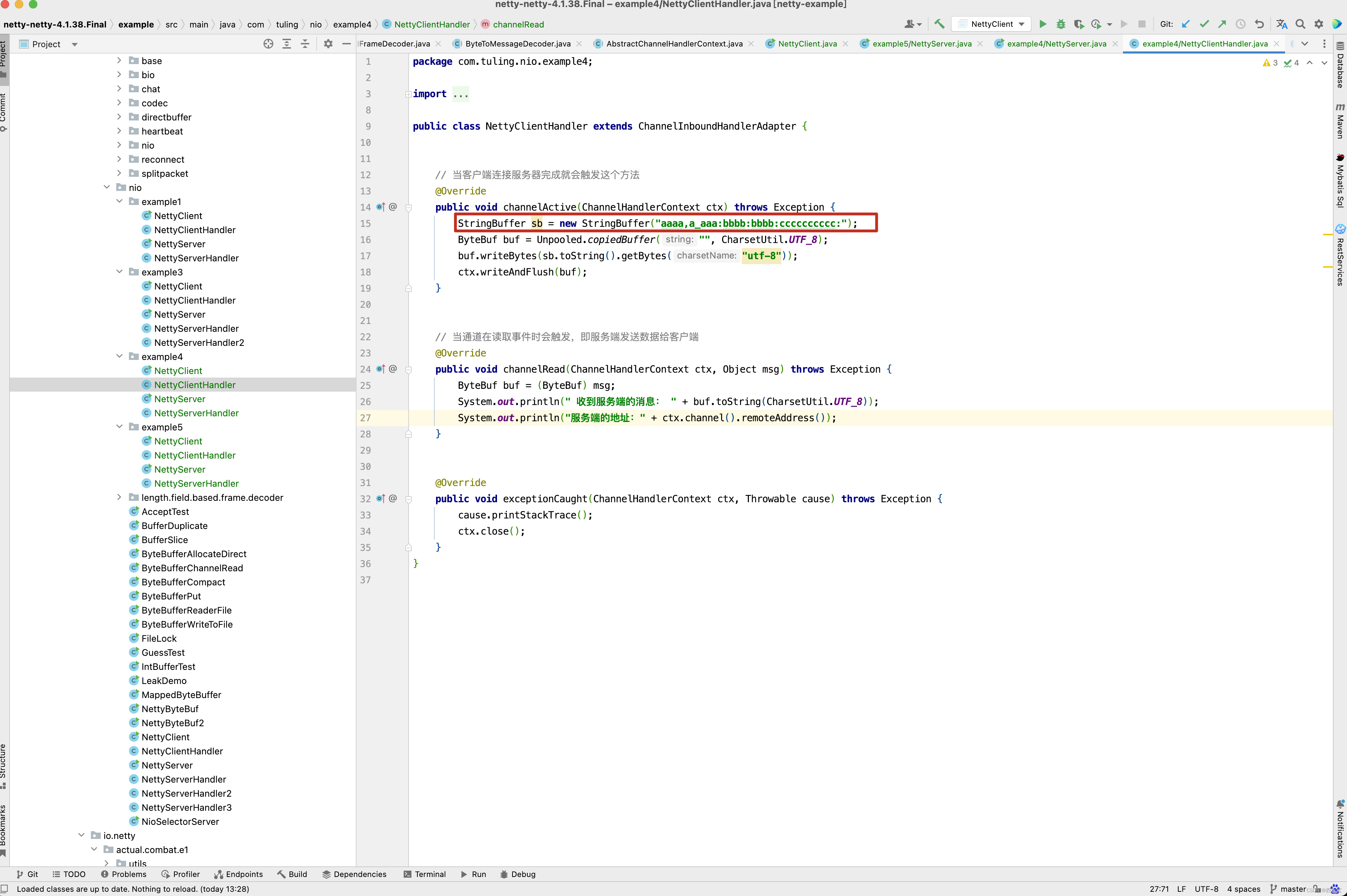
客户端写了一个字符串aaaa,a_aaa:bbbb:bbbb:cccccccccc:,而我们DelimiterBasedFrameDecoder中定义的分割符为 : , _ ,因此他会遍历我们的分隔符 : , _ ,从传入的ByteBuf (内容为 aaaa,a_aaa:bbbb:bbbb:cccccccccc: )中找到分割符索引最小的位置同,如 aaaa,a_aaa:bbbb:bbbb:cccccccccc: 字符串,分隔符索引最小的位置为红色逗号位置为4 ,因此会调用readRetainedSlice()方法,获取本次读取到的ByteBuf,此时未读取的字符串内容为 a_aaa:bbbb:bbbb:cccccccccc: ,同样的方式,分隔符索引最小的位置为红色下划线位置为1,因此第二次读取的字符为a,其他情况以此类推,这个例子中主要运行的代码在decode()方法的加粗代码。当然啦,有人可能对丢弃这一块的逻辑有所困惑,可以通过一个例子来分析上述源码,如果要测试丢弃这一块的逻辑,在创建DelimiterBasedFrameDecoder时,需要设置maxFrameLength参数。
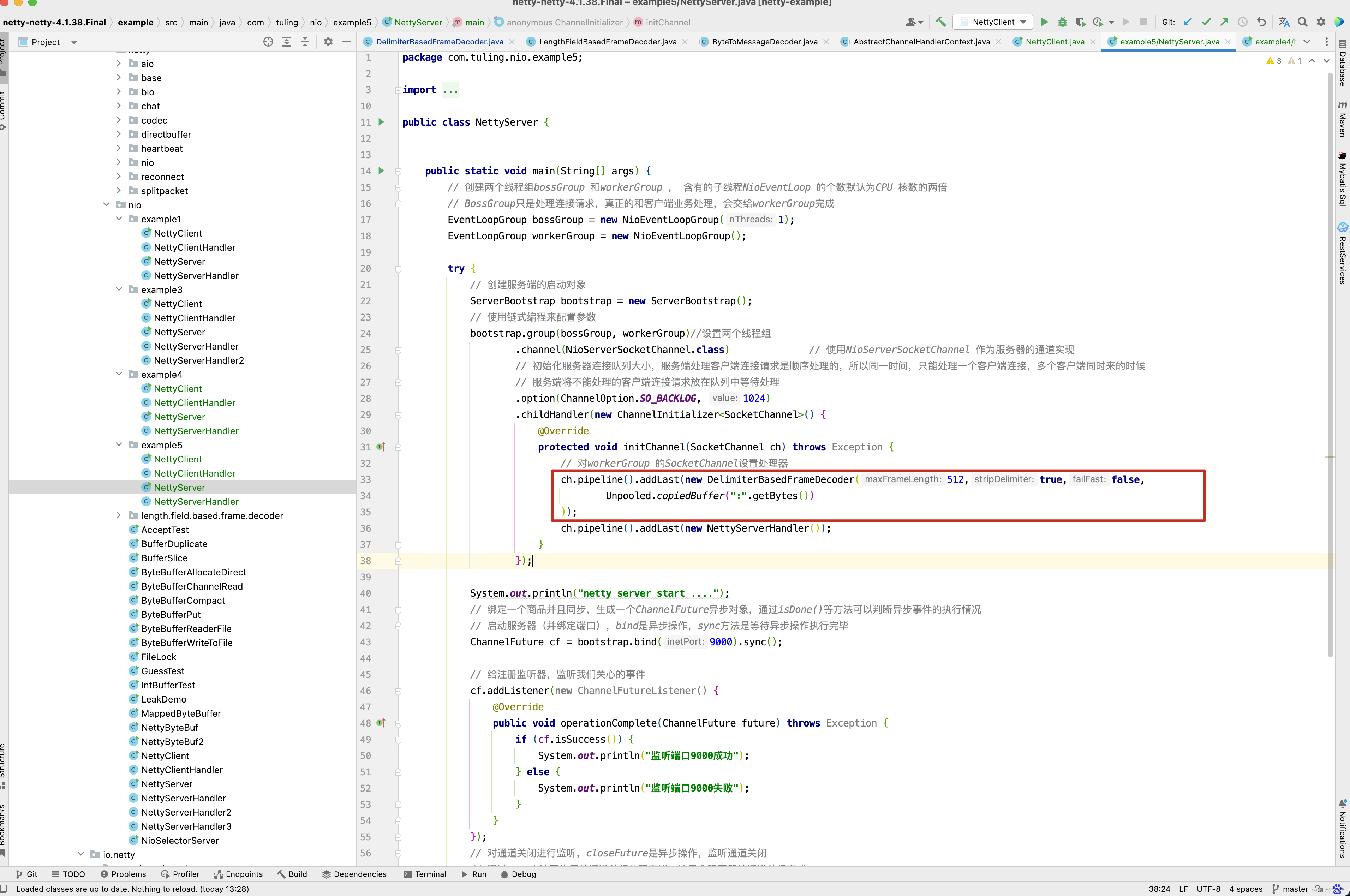
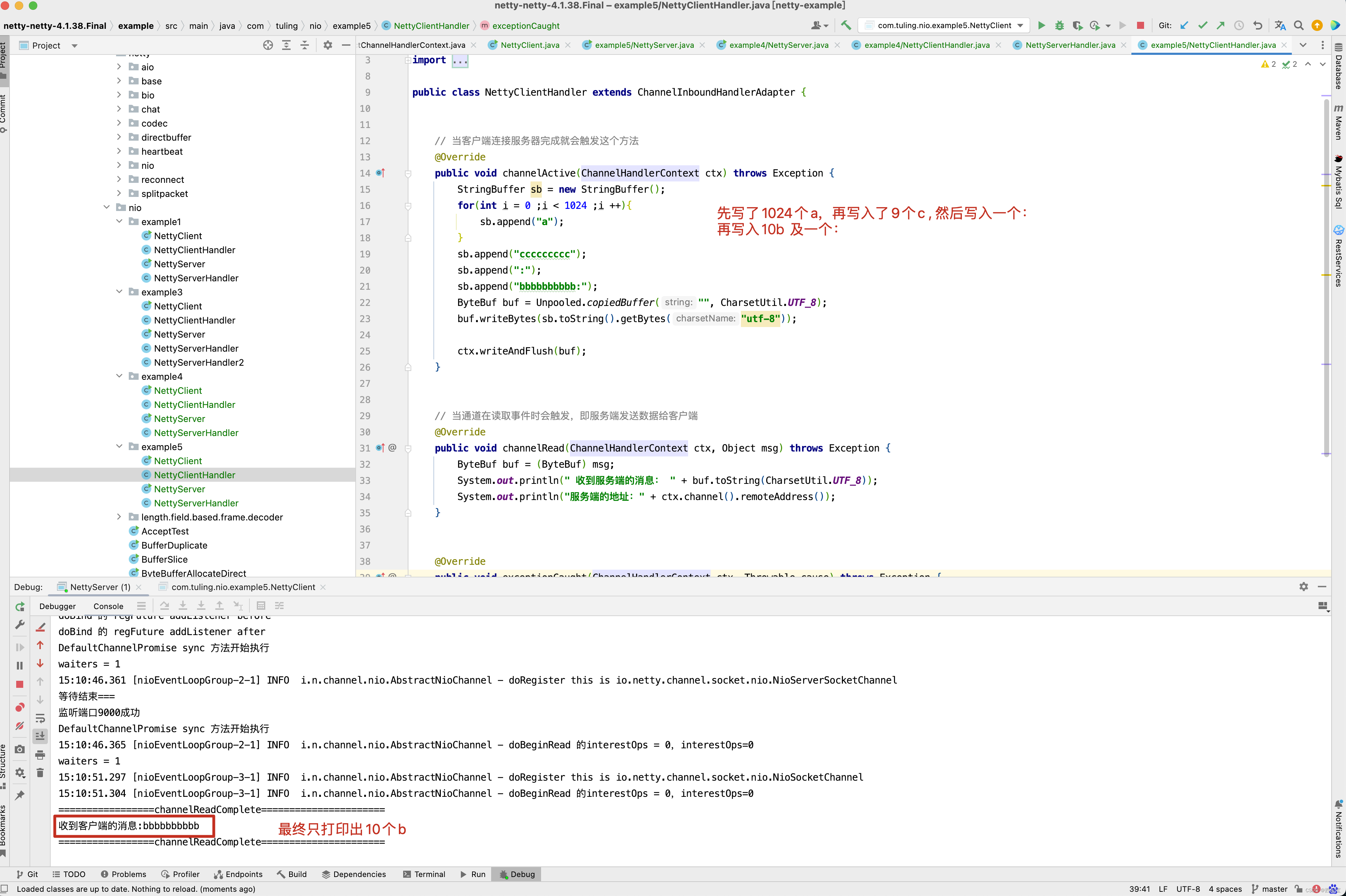
关于这一块代码的源码理解方面,小伙伴可以将代码下载下来,然后打断点调试去理解,注释也写得非常清楚了,这里就不再赘述 。
这里还有一点需要注意,在NettyServerHandler中实现了exceptionCaught()异常。

那这个异常什么时候调用呢? 我们还是以DelimiterBasedFrameDecoder为例子来测试异常处理流程。

和example5例子的区别是DelimiterBasedFrameDecoder的failFast参数设置为true,而这个字段的含义是遇到错误时,是否抛出异常。
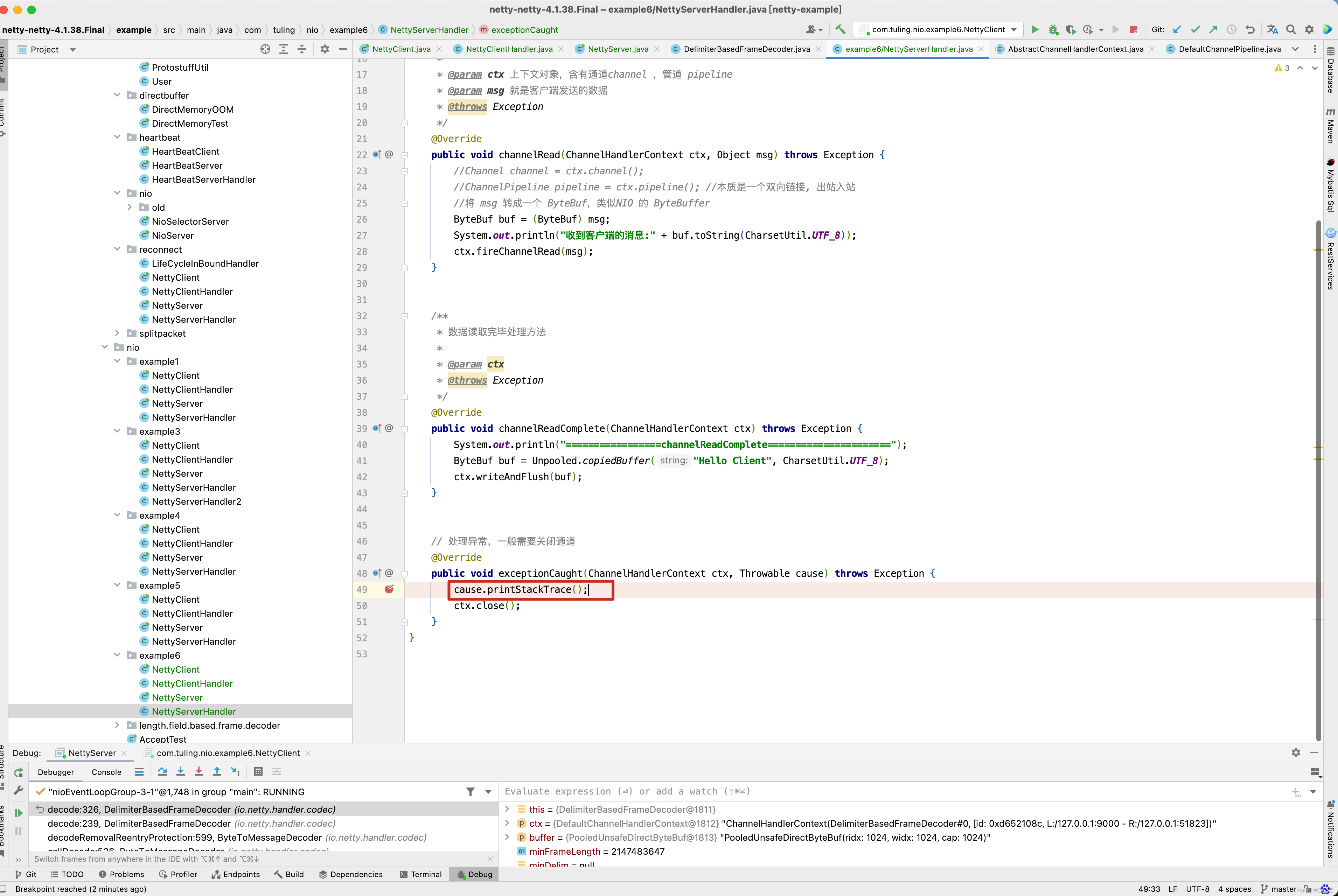
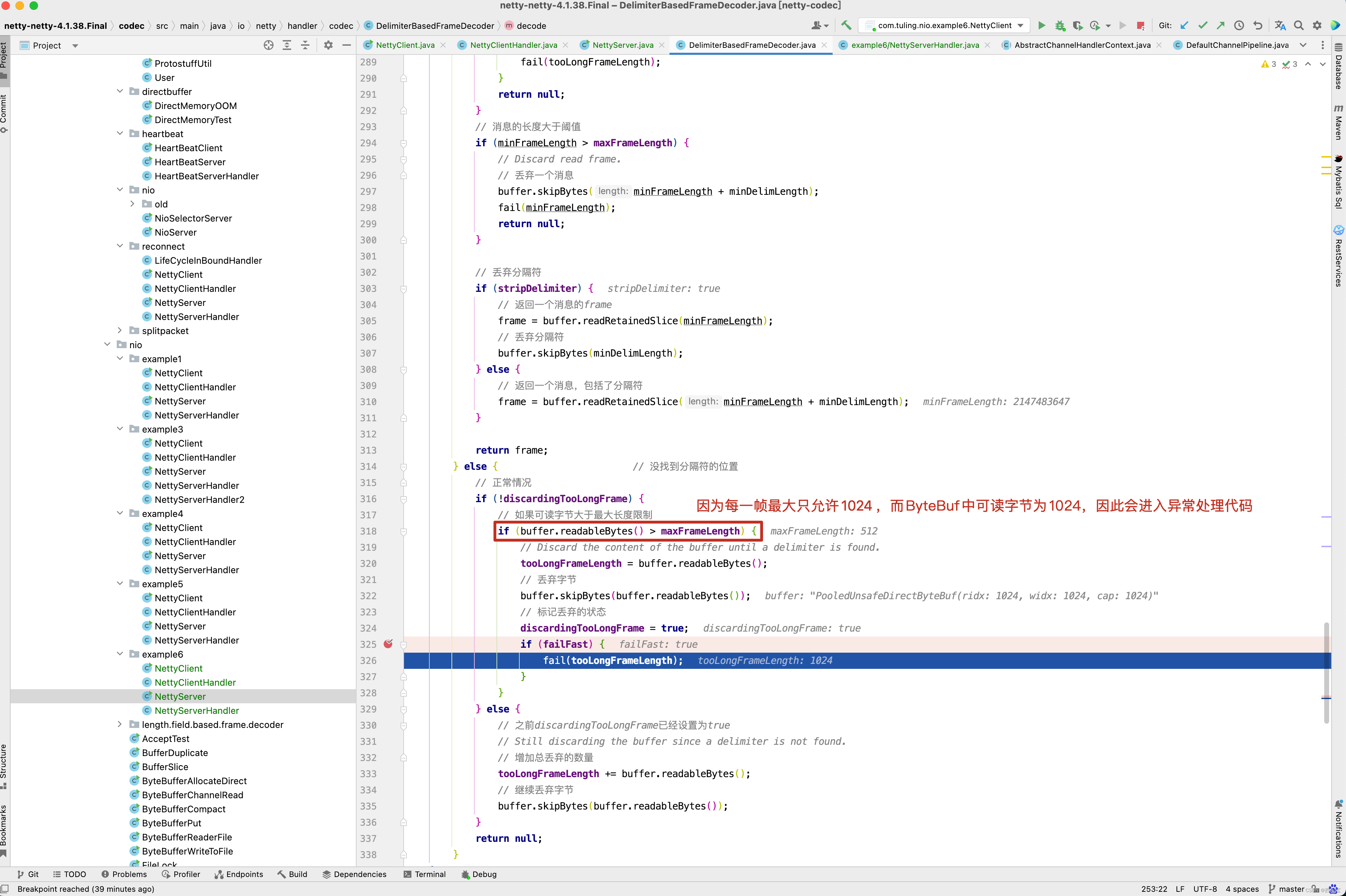
进入fail()方法。 抛出TooLongFrameException异常
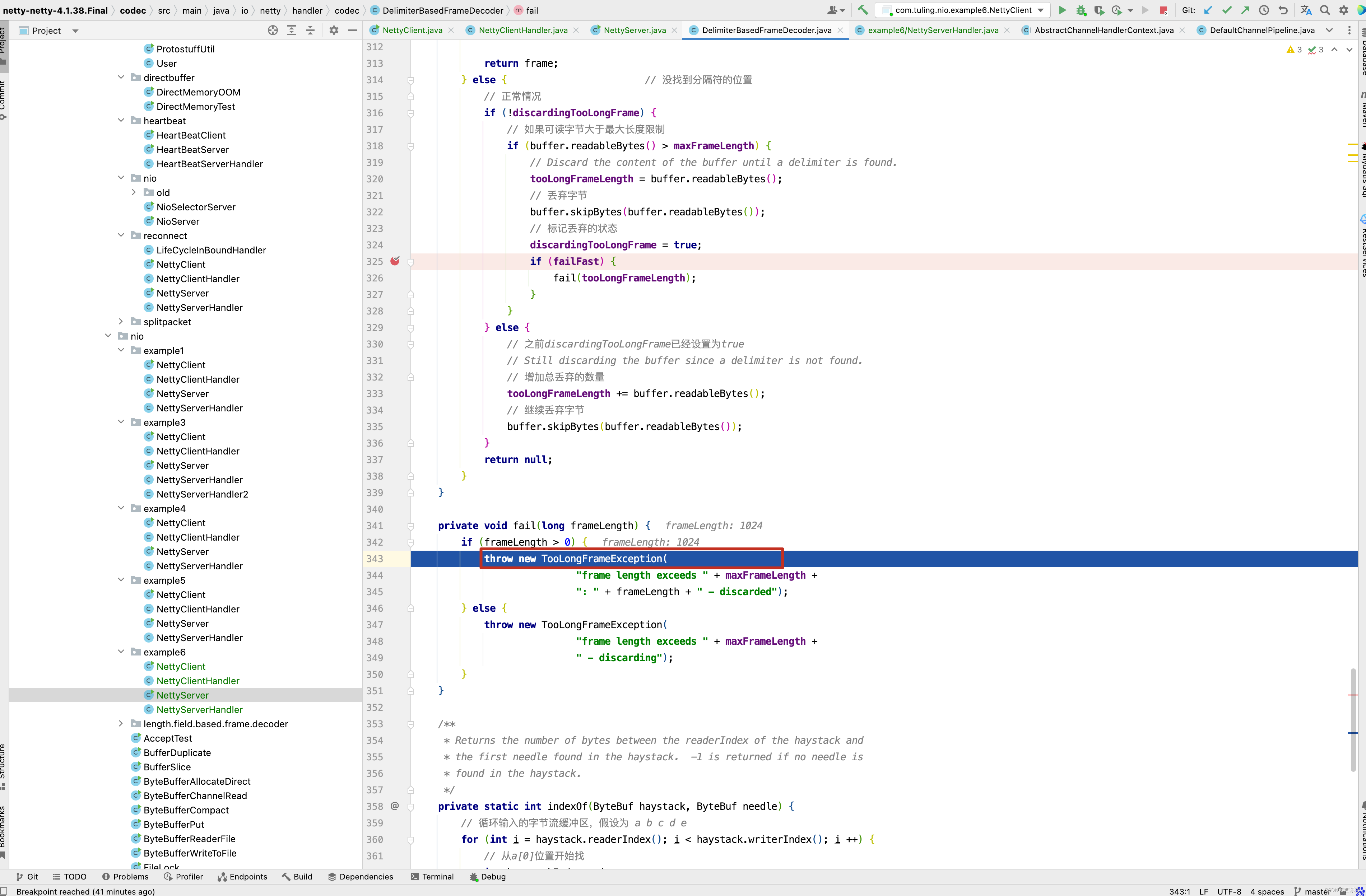
最终被invokeChannelRead()方法异常捕获,进入

private void invokeChannelRead(Object msg) {
if (invokeHandler()) {
try {
((ChannelInboundHandler) handler()).channelRead(this, msg);
} catch (Throwable t) {
notifyHandlerException(t);
}
} else {
fireChannelRead(msg);
}
}
private void notifyHandlerException(Throwable cause) {
if (inExceptionCaught(cause)) {
if (logger.isWarnEnabled()) {
logger.warn(
"An exception was thrown by a user handler " +
"while handling an exceptionCaught event", cause);
}
return;
}
invokeExceptionCaught(cause);
}
private void invokeExceptionCaught(final Throwable cause) {
if (invokeHandler()) {
try {
handler().exceptionCaught(this, cause);
} catch (Throwable error) {
if (logger.isDebugEnabled()) {
logger.debug(
"An exception {}" +
"was thrown by a user handler's exceptionCaught() " +
"method while handling the following exception:",
ThrowableUtil.stackTraceToString(error), cause);
} else if (logger.isWarnEnabled()) {
logger.warn(
"An exception '{}' [enable DEBUG level for full stacktrace] " +
"was thrown by a user handler's exceptionCaught() " +
"method while handling the following exception:", error, cause);
}
}
} else {
fireExceptionCaught(cause);
}
}
// 最终调用我们的业务方法处理异常
public void exceptionCaught(ChannelHandlerContext ctx, Throwable cause) throws Exception {
cause.printStackTrace();
ctx.close();
}
心跳检测用例源码分析
这个用例的主要功能就是每3秒检测一次是否没有读事件,如果连续3次没有检测到读事件,通知客户端关闭链接,先看服务端代码 。
public class HeartBeatServer {
public static void main(String[] args) throws Exception {
EventLoopGroup boss = new NioEventLoopGroup();
EventLoopGroup worker = new NioEventLoopGroup();
try {
ServerBootstrap bootstrap = new ServerBootstrap();
bootstrap.group(boss, worker)
.channel(NioServerSocketChannel.class)
.childHandler(new ChannelInitializer<SocketChannel>() {
@Override
protected void initChannel(SocketChannel ch) throws Exception {
ChannelPipeline pipeline = ch.pipeline();
pipeline.addLast("decoder", new StringDecoder());
pipeline.addLast("encoder", new StringEncoder());
//IdleStateHandler的readerIdleTime参数指定超过3秒还没收到客户端的连接,
//会触发IdleStateEvent事件并且交给下一个handler处理,下一个handler必须
//实现userEventTriggered方法处理对应事件
pipeline.addLast(new IdleStateHandler(3, 0, 0, TimeUnit.SECONDS));
pipeline.addLast(new HeartBeatServerHandler());
}
});
System.out.println("netty server start。。");
ChannelFuture future = bootstrap.bind(9000).sync();
future.channel().closeFuture().sync();
} catch (Exception e) {
e.printStackTrace();
} finally {
worker.shutdownGracefully();
boss.shutdownGracefully();
}
}
}
public class HeartBeatServerHandler extends SimpleChannelInboundHandler<String> {
int readIdleTimes = 0;
@Override
public void channelReadComplete(ChannelHandlerContext ctx) throws Exception {
super.channelReadComplete(ctx);
// 保证连续3次都没有读事件,因此每次发生读完成事件,就重置readIdleTimes
readIdleTimes = 0 ;
}
@Override
protected void channelRead0(ChannelHandlerContext ctx, String s) throws Exception {
System.out.println(" ====== > [server] message received : " + s);
if ("Heartbeat Packet".equals(s)) {
ctx.channel().writeAndFlush("ok");
} else {
System.out.println(" 其他信息处理 ... ");
}
}
@Override
public void userEventTriggered(ChannelHandlerContext ctx, Object evt) throws Exception {
IdleStateEvent event = (IdleStateEvent) evt;
String eventType = null;
switch (event.state()) {
case READER_IDLE:
eventType = "读空闲";
readIdleTimes++; // 读空闲的计数加1
break;
case WRITER_IDLE:
eventType = "写空闲";
// 不处理
break;
case ALL_IDLE:
eventType = "读写空闲";
// 不处理
break;
}
System.out.println(ctx.channel().remoteAddress() + "超时事件:" + eventType);
if (readIdleTimes > 3) {
System.out.println(" [server]读空闲超过3次,关闭连接,释放更多资源");
ctx.channel().writeAndFlush("idle close");
ctx.channel().close();
}
}
@Override
public void channelActive(ChannelHandlerContext ctx) throws Exception {
System.err.println("=== " + ctx.channel().remoteAddress() + " is active ===");
}
}
接下来看客户端代码 。
public class HeartBeatClient {
public static void main(String[] args) throws Exception {
EventLoopGroup eventLoopGroup = new NioEventLoopGroup();
try {
Bootstrap bootstrap = new Bootstrap();
bootstrap.group(eventLoopGroup).channel(NioSocketChannel.class)
.handler(new ChannelInitializer<SocketChannel>() {
@Override
protected void initChannel(SocketChannel ch) throws Exception {
ChannelPipeline pipeline = ch.pipeline();
pipeline.addLast("decoder", new StringDecoder());
pipeline.addLast("encoder", new StringEncoder());
pipeline.addLast(new HeartBeatClientHandler());
}
});
System.out.println("netty client start。。");
Channel channel = bootstrap.connect("127.0.0.1", 9000).sync().channel();
String text = "Heartbeat Packet";
Random random = new Random();
while (channel.isActive()) {
int num = random.nextInt(8);
Thread.sleep(num * 1000);
channel.writeAndFlush(text);
}
} catch (Exception e) {
e.printStackTrace();
} finally {
eventLoopGroup.shutdownGracefully();
}
}
static class HeartBeatClientHandler extends SimpleChannelInboundHandler<String> {
@Override
protected void channelRead0(ChannelHandlerContext ctx, String msg) throws Exception {
System.out.println(" client received :" + msg);
if (msg != null && msg.equals("idle close")) {
// 服务端告诉客户端关闭链接,客户端也关闭链接
System.out.println(" 服务端关闭连接,客户端也关闭");
ctx.channel().closeFuture();
}
}
}
}
先看IdleStateHandler的构造方法 。
public IdleStateHandler(
long readerIdleTime, long writerIdleTime, long allIdleTime,
TimeUnit unit) {
this(false, readerIdleTime, writerIdleTime, allIdleTime, unit);
}
public IdleStateHandler(boolean observeOutput,
long readerIdleTime, long writerIdleTime, long allIdleTime,
TimeUnit unit) {
if (unit == null) {
throw new NullPointerException("unit");
}
this.observeOutput = observeOutput;
if (readerIdleTime <= 0) {
readerIdleTimeNanos = 0;
} else {
readerIdleTimeNanos = Math.max(unit.toNanos(readerIdleTime), MIN_TIMEOUT_NANOS);
}
if (writerIdleTime <= 0) {
writerIdleTimeNanos = 0;
} else {
writerIdleTimeNanos = Math.max(unit.toNanos(writerIdleTime), MIN_TIMEOUT_NANOS);
}
if (allIdleTime <= 0) {
allIdleTimeNanos = 0;
} else {
allIdleTimeNanos = Math.max(unit.toNanos(allIdleTime), MIN_TIMEOUT_NANOS);
}
}
本例中,主要设置读超时时间,readerIdleTimeNanos存储的是纳秒值,接下来看IdleStateHandler的initialize()方法,先理清楚什么时候调用initialize()方法,可以在initialize()方法中打一个断点。
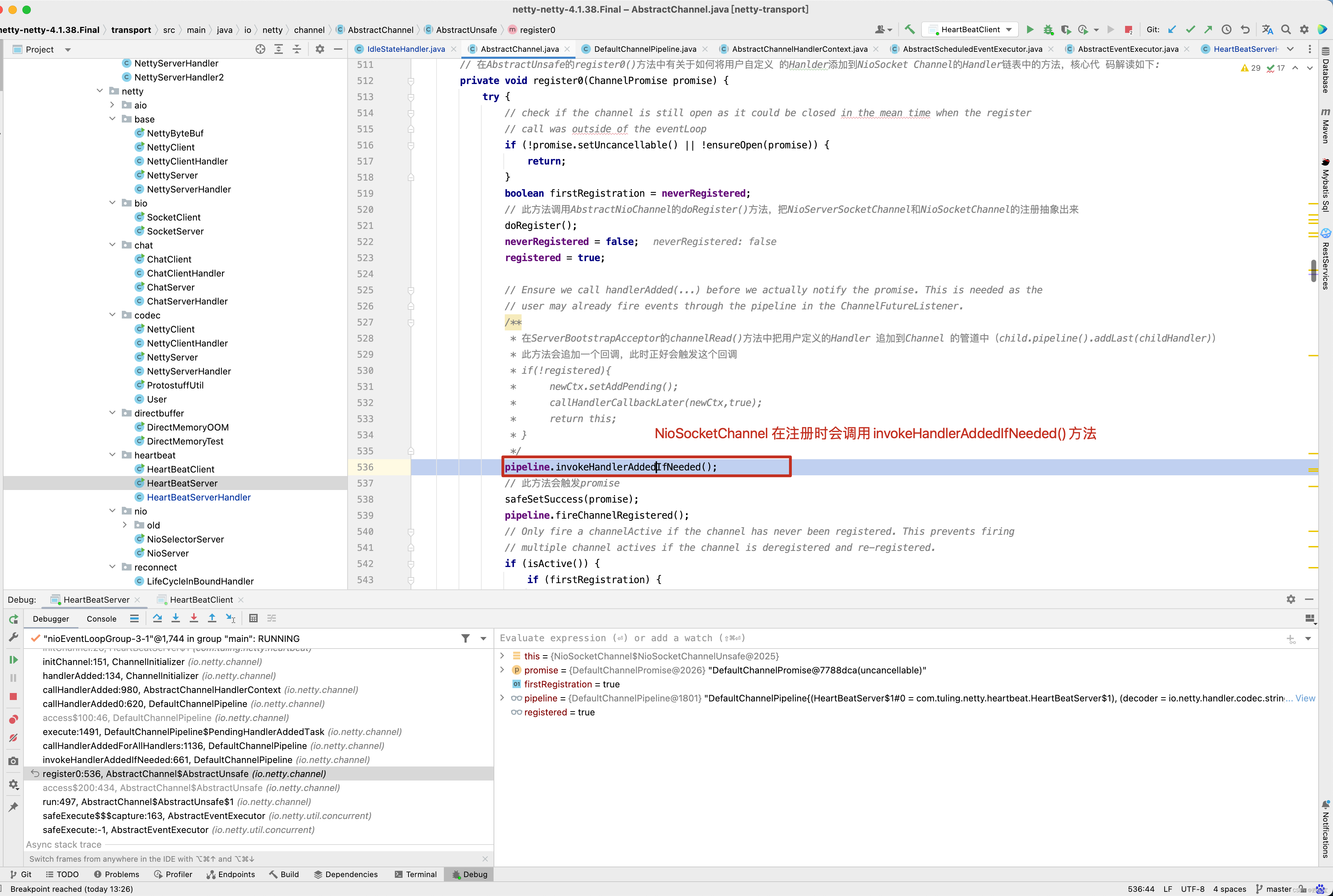
而这个方法会调用我们自定义的ChannelInitializer的initChannel()方法 。
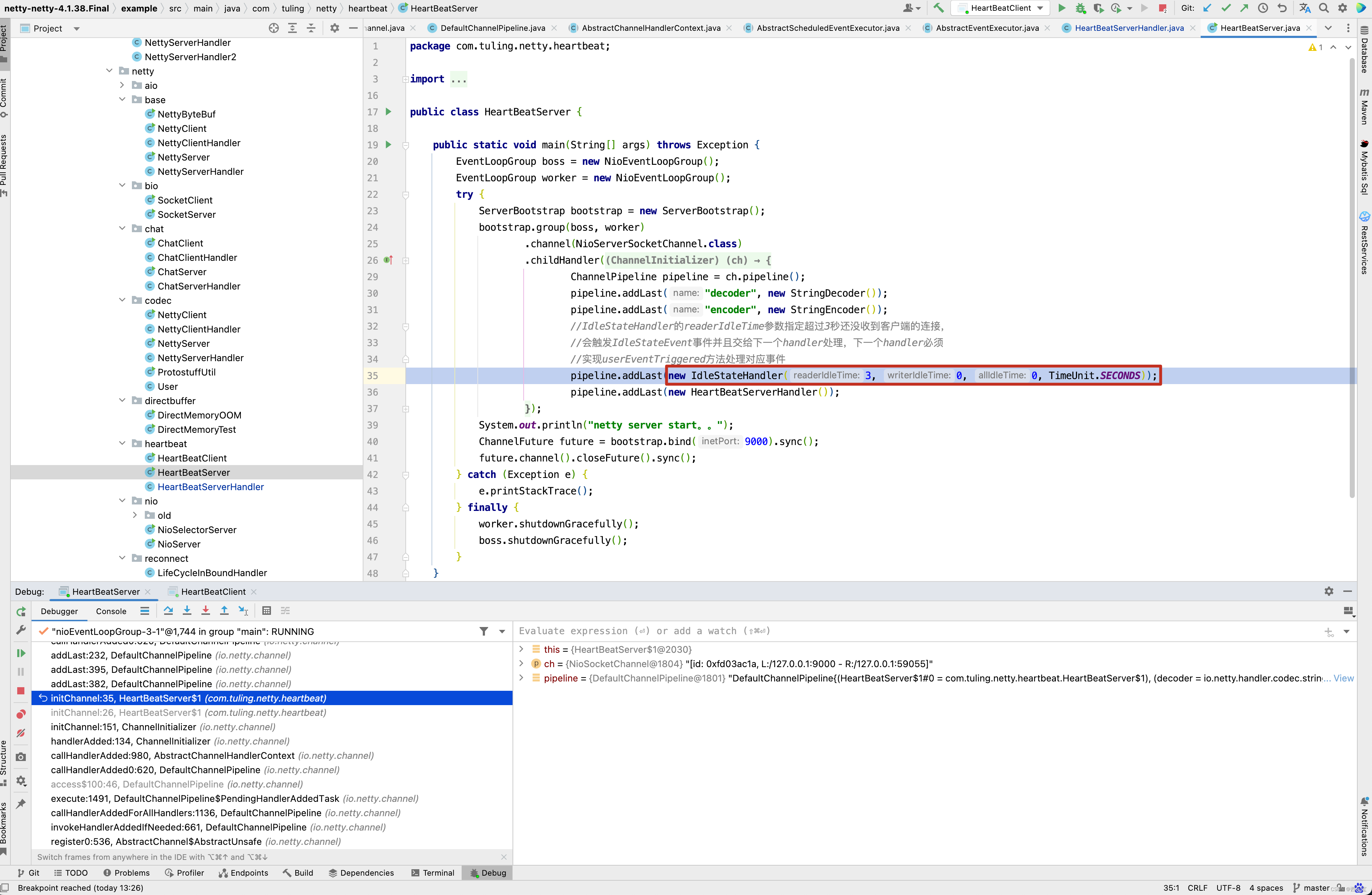
而pipeline.addLast(new IdleStateHandler(3, 0, 0, TimeUnit.SECONDS)) 这一行代码会初始化IdleStateHandler,并且将IdleStateHandler添加到流水线中,之前在分析addLast()方法时,还漏掉了一个方法callHandlerAdded0()没有分析 。
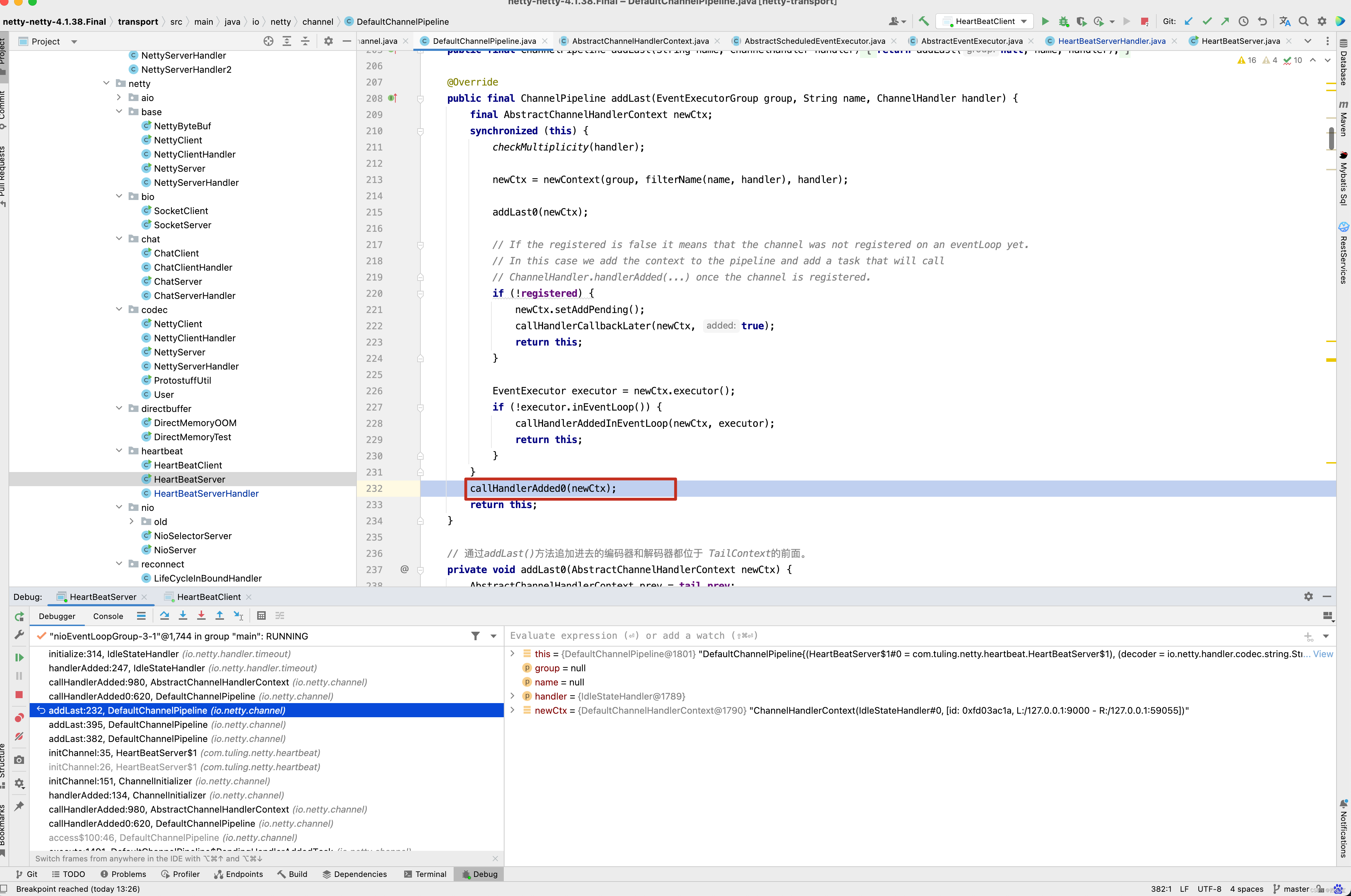
接下来看callHandlerAdded0()方法的具体实现。
private void callHandlerAdded0(final AbstractChannelHandlerContext ctx) {
try {
ctx.callHandlerAdded();
} catch (Throwable t) {
boolean removed = false;
try {
remove0(ctx);
ctx.callHandlerRemoved();
removed = true;
} catch (Throwable t2) {
if (logger.isWarnEnabled()) {
logger.warn("Failed to remove a handler: " + ctx.name(), t2);
}
}
if (removed) {
fireExceptionCaught(new ChannelPipelineException(
ctx.handler().getClass().getName() +
".handlerAdded() has thrown an exception; removed.", t));
} else {
fireExceptionCaught(new ChannelPipelineException(
ctx.handler().getClass().getName() +
".handlerAdded() has thrown an exception; also failed to remove.", t));
}
}
}
final void callHandlerAdded() throws Exception {
// We must call setAddComplete before calling handlerAdded. Otherwise if the handlerAdded method generates
// any pipeline events ctx.handler() will miss them because the state will not allow it.
if (setAddComplete()) {
handler().handlerAdded(this);
}
}
public void handlerAdded(ChannelHandlerContext ctx) throws Exception {
if (ctx.channel().isActive() && ctx.channel().isRegistered()) {
// channelActive() event has been fired already, which means this.channelActive() will
// not be invoked. We have to initialize here instead.
initialize(ctx);
} else {
// channelActive() event has not been fired yet. this.channelActive() will be invoked
// and initialization will occur there.
}
}
private void initialize(ChannelHandlerContext ctx) {
// Avoid the case where destroy() is called before scheduling timeouts.
// See: https://github.com/netty/netty/issues/143
switch (state) {
case 1: // 初始化进行中或者已经完成
case 2: // 销毁进行中或者已经完成
return;
}
state = 1;
initOutputChanged(ctx);
// 初始化的工作较为简单,设定最近一次读取时间lastReadTime为当前系统时间,然后在用户设置的读超时时间readerIdleTimeNanos截止时,
// 执行一个ReaderIdleTimeoutTask进行检测。
lastReadTime = lastWriteTime = ticksInNanos();
if (readerIdleTimeNanos > 0) {
readerIdleTimeout = schedule(ctx, new ReaderIdleTimeoutTask(ctx),
readerIdleTimeNanos, TimeUnit.NANOSECONDS);
}
if (writerIdleTimeNanos > 0) {
writerIdleTimeout = schedule(ctx, new WriterIdleTimeoutTask(ctx),
writerIdleTimeNanos, TimeUnit.NANOSECONDS);
}
if (allIdleTimeNanos > 0) {
allIdleTimeout = schedule(ctx, new AllIdleTimeoutTask(ctx),
allIdleTimeNanos, TimeUnit.NANOSECONDS);
}
}
首先要明白 initialize()方法是何时调用,他是流水线在调用addLast()方法的结尾时调用了callHandlerAdded0()方法,而这个方法会调用Handler的handlerAdded()方法。最终会调用initialize()方法,而initialize()最重要的是做了lastReadTime = lastWriteTime = ticksInNanos() 这件事情,将最后读取时间和最后写时间初始化为当前时间,如果我们在初始化IdleStateHandler设置了readerIdleTime空闲时间监控,此时会创建一个任务并添加到NioEventLoop的任务列表中,关于创建一个任务并添加到NioEventLoop的任务列表这一块的代码,我们跟进分析分析 。
ScheduledFuture<?> schedule(ChannelHandlerContext ctx, Runnable task, long delay, TimeUnit unit) {
return ctx.executor().schedule(task, delay, unit);
}
ScheduledFuture<?> schedule(ChannelHandlerContext ctx, Runnable task, long delay, TimeUnit unit) {
return ctx.executor().schedule(task, delay, unit);
}
public ScheduledFuture<?> schedule(Runnable command, long delay, TimeUnit unit) {
ObjectUtil.checkNotNull(command, "command");
ObjectUtil.checkNotNull(unit, "unit");
if (delay < 0) {
delay = 0;
}
validateScheduled0(delay, unit);
return schedule(new ScheduledFutureTask<Void>(
this, command, null, ScheduledFutureTask.deadlineNanos(unit.toNanos(delay))));
}
<V> ScheduledFuture<V> schedule(final ScheduledFutureTask<V> task) {
if (inEventLoop()) {
scheduledTaskQueue().add(task);
} else {
execute(new Runnable() {
@Override
public void run() {
scheduledTaskQueue().add(task);
}
});
}
return task;
}
PriorityQueue<ScheduledFutureTask<?>> scheduledTaskQueue;
public PriorityQueue<ScheduledFutureTask<?>> scheduledTaskQueue() {
if (scheduledTaskQueue == null) {
scheduledTaskQueue = new DefaultPriorityQueue<ScheduledFutureTask<?>>(
SCHEDULED_FUTURE_TASK_COMPARATOR,
// Use same initial capacity as java.util.PriorityQueue
11);
}
return scheduledTaskQueue;
}
scheduledTaskQueue这个队列是不是特别熟悉了,首先scheduledTaskQueue队列是一个优先级队列,之前写过一篇博客 ArrayBlockingQueue&LinkedBlockingQueue&DelayQueue&SynchronousQueue&PriorityBlockingQueue源码解析 专门分析优先级队列的原理,有兴趣可以去看看,但有一个结论需要记住,如设置延迟时间为3秒,3秒之后一定能从PriorityQueue中poll()中得到元素,在之前的博客中 Netty 源码解析(上) 对NioEventLoop的select()方法中了详细的分析 。
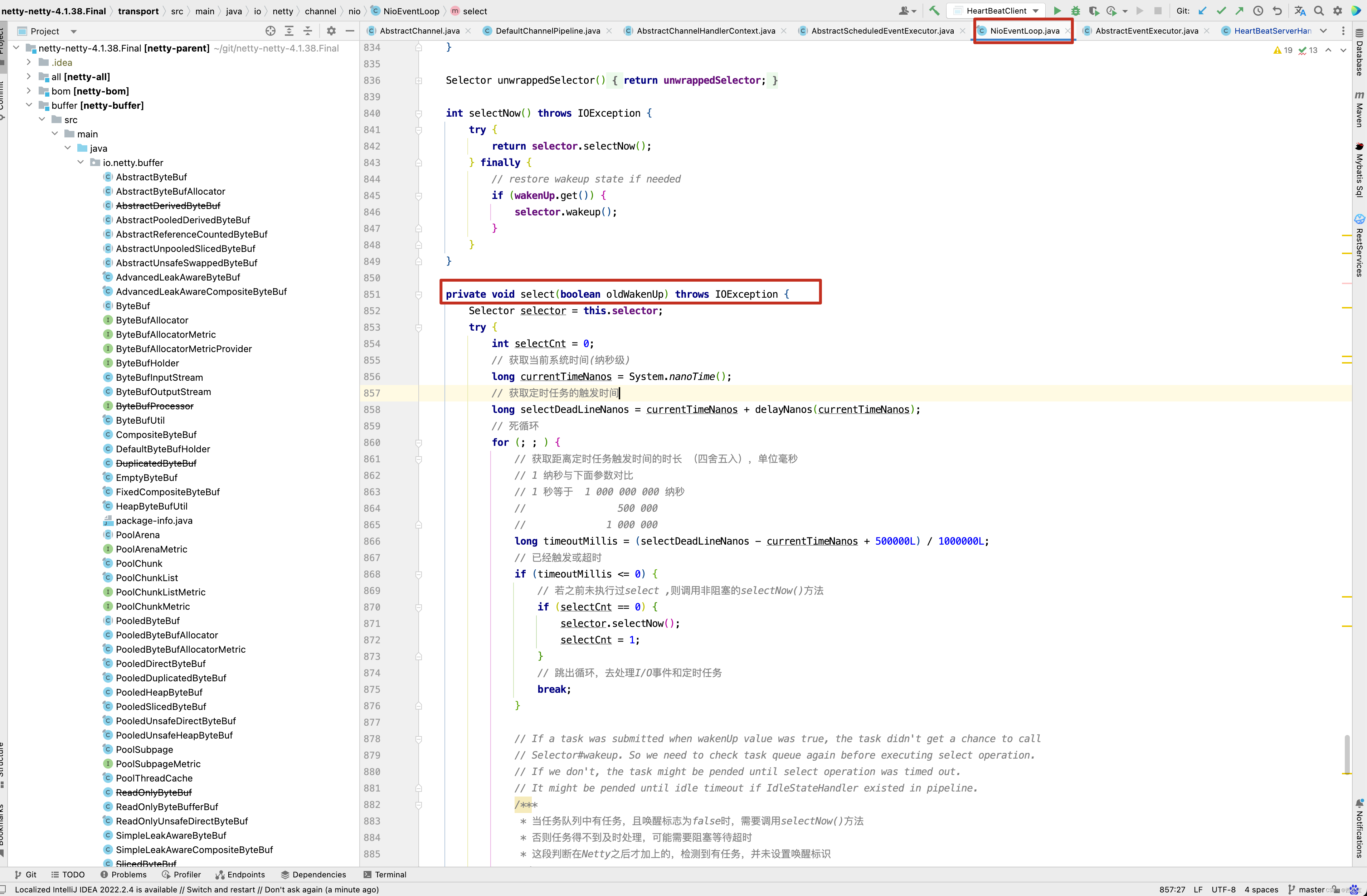
而在schedule()方法中ctx.executor()获得的是NioEventLoop对象。
ScheduledFuture<?> schedule(ChannelHandlerContext ctx, Runnable task, long delay, TimeUnit unit) {
return ctx.executor().schedule(task, delay, unit);
}
也就是最后,在IdleStateHandler的初始化方法中创建的ReaderIdleTimeoutTask任务被添加到NioEventLoop的scheduledTaskQueue队列中。 我们再回顾之前的select()方法 。
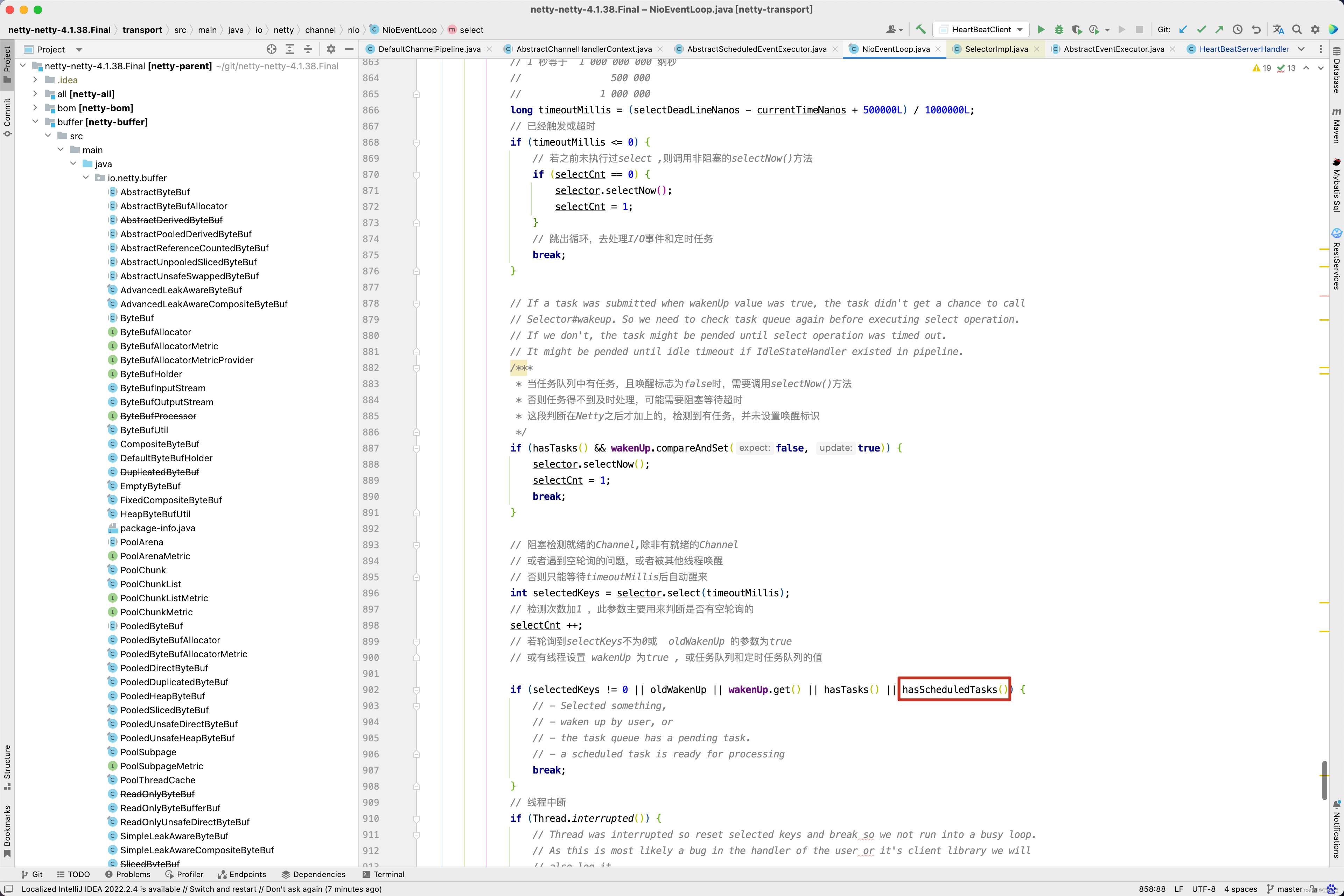
在select()方法,如果scheduledTaskQueue中有任务,则会执行后面的runAllTasks()方法。
protected final boolean hasScheduledTasks() {
Queue<ScheduledFutureTask<?>> scheduledTaskQueue = this.scheduledTaskQueue;
ScheduledFutureTask<?> scheduledTask = scheduledTaskQueue == null ? null : scheduledTaskQueue.peek();
return scheduledTask != null && scheduledTask.deadlineNanos() <= nanoTime();
}
runAllTasks()方法中又通过fetchFromScheduledTaskQueue()从scheduledTaskQueue中拉取所有的任务添加到taskQueue中,最后再调用safeExecute(task)方法运行scheduledTask,当执行完后调用pollTask()方法,继续从taskQueue中拉取任务,如果任务不为空,则继续调用safeExecute(task)方法执行任务…

现在终于知道任务的执行过程了吧,接着看ReaderIdleTimeoutTask源码。
protected IdleStateEvent newIdleStateEvent(IdleState state, boolean first) {
switch (state) {
case ALL_IDLE:
return first ? IdleStateEvent.FIRST_ALL_IDLE_STATE_EVENT : IdleStateEvent.ALL_IDLE_STATE_EVENT;
case READER_IDLE:
return first ? IdleStateEvent.FIRST_READER_IDLE_STATE_EVENT : IdleStateEvent.READER_IDLE_STATE_EVENT;
case WRITER_IDLE:
return first ? IdleStateEvent.FIRST_WRITER_IDLE_STATE_EVENT : IdleStateEvent.WRITER_IDLE_STATE_EVENT;
default:
throw new IllegalArgumentException("Unhandled: state=" + state + ", first=" + first);
}
}
private final class ReaderIdleTimeoutTask extends AbstractIdleTask {
ReaderIdleTimeoutTask(ChannelHandlerContext ctx) {
super(ctx);
}
@Override
protected void run(ChannelHandlerContext ctx) {
long nextDelay = readerIdleTimeNanos;
if (!reading) {
nextDelay -= ticksInNanos() - lastReadTime;
}
// nextDelay<=0 说明在设置的超时时间内没有读取数据
if (nextDelay <= 0) {
// Reader is idle - set a new timeout and notify the callback.
// 超时时间已到,则再次调度该任务本身
readerIdleTimeout = schedule(ctx, this, readerIdleTimeNanos, TimeUnit.NANOSECONDS);
boolean first = firstReaderIdleEvent;
firstReaderIdleEvent = false;
try {
IdleStateEvent event = newIdleStateEvent(IdleState.READER_IDLE, first);
channelIdle(ctx, event); // 模板方法处理
} catch (Throwable t) {
ctx.fireExceptionCaught(t);
}
} else {
// 如果正在读取中
// Read occurred before the timeout - set a new timeout with shorter delay.
// 注意此处的nextDelay值,会跟随着lastReadTime刷新
readerIdleTimeout = schedule(ctx, this, nextDelay, TimeUnit.NANOSECONDS);
}
}
}
ReaderIdleTimeoutTask中的run()方法写得非常巧妙,首先看reading字段,什么情况不会走nextDelay -= ticksInNanos() - lastReadTime 这一行代码呢 ? 也就是reading为true的时候,那什么时候reading会被设置为true呢 ?我们看IdleStateHandler的channelRead()方法。如果正在读取ByteBuf中的数据时, reading会被设置为true。

如果reading为true,会走下面的情况。
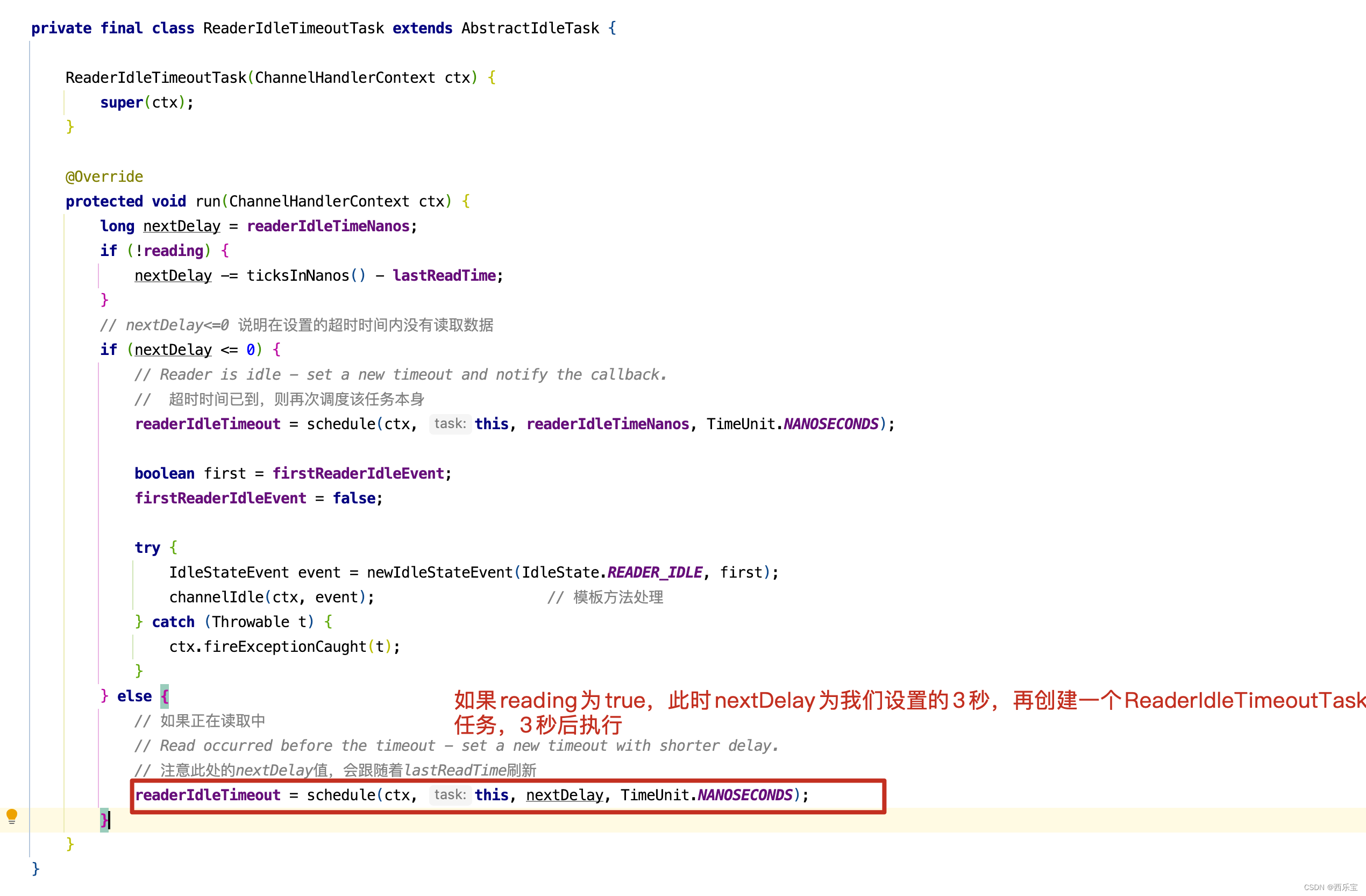
当然,nextDelay -= ticksInNanos() - lastReadTime还有一种情况,我们设置的是3秒检测一个读空闲,但在1秒前Netty有数据读取完成,在IdleStateHandler的channelReadComplete()方法中。
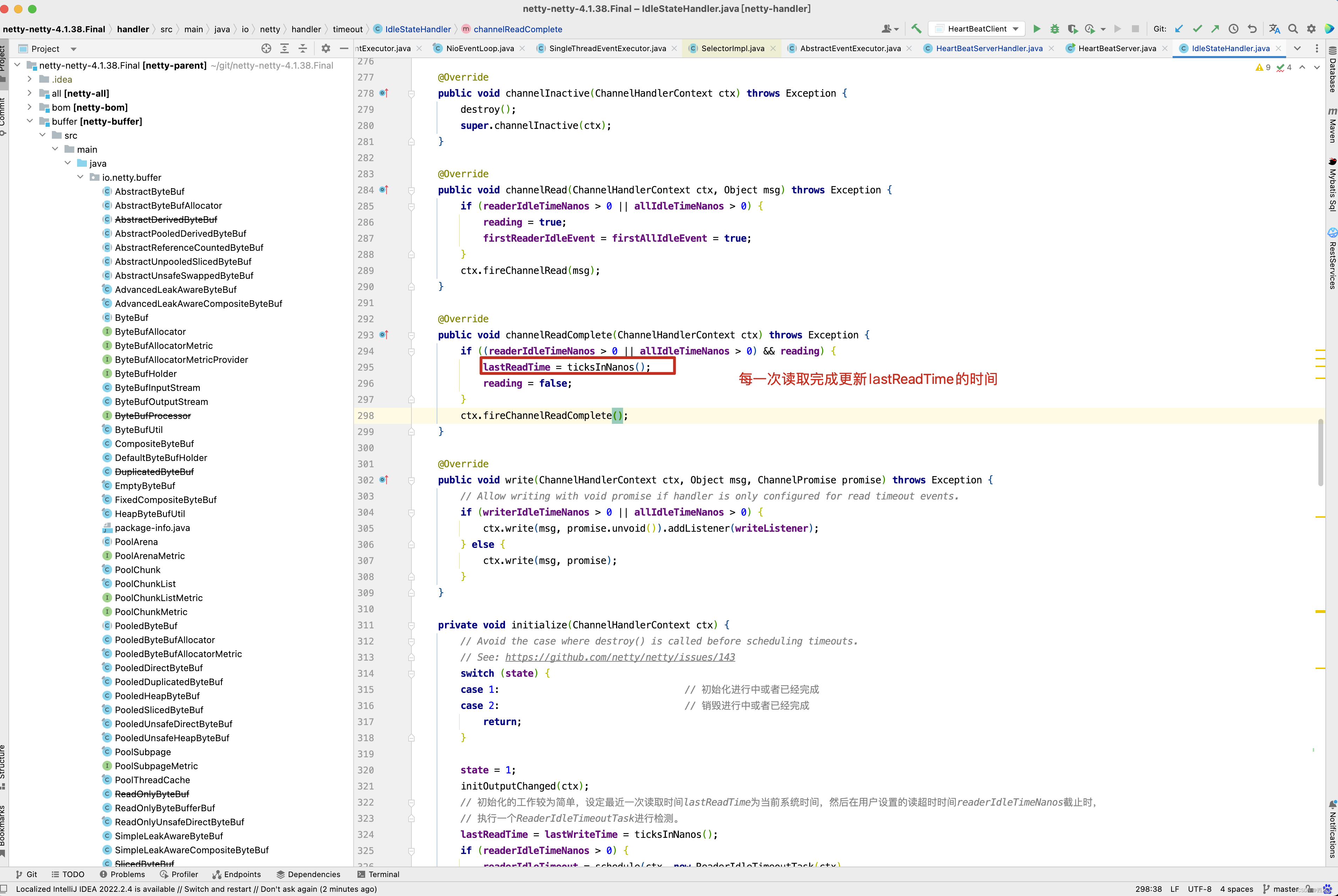
会修改lastReadTime = ticksInNanos()的值,因此此时nextDelay -= ticksInNanos() - lastReadTime的值为2秒,即使再走readerIdleTimeout = schedule(ctx, this, nextDelay, TimeUnit.NANOSECONDS) 代码,也是创建一个任务 ,2秒后再执行读空闲检查。当然,如果读空闲检测超时,此时会走nextDelay <= 0的分支 。
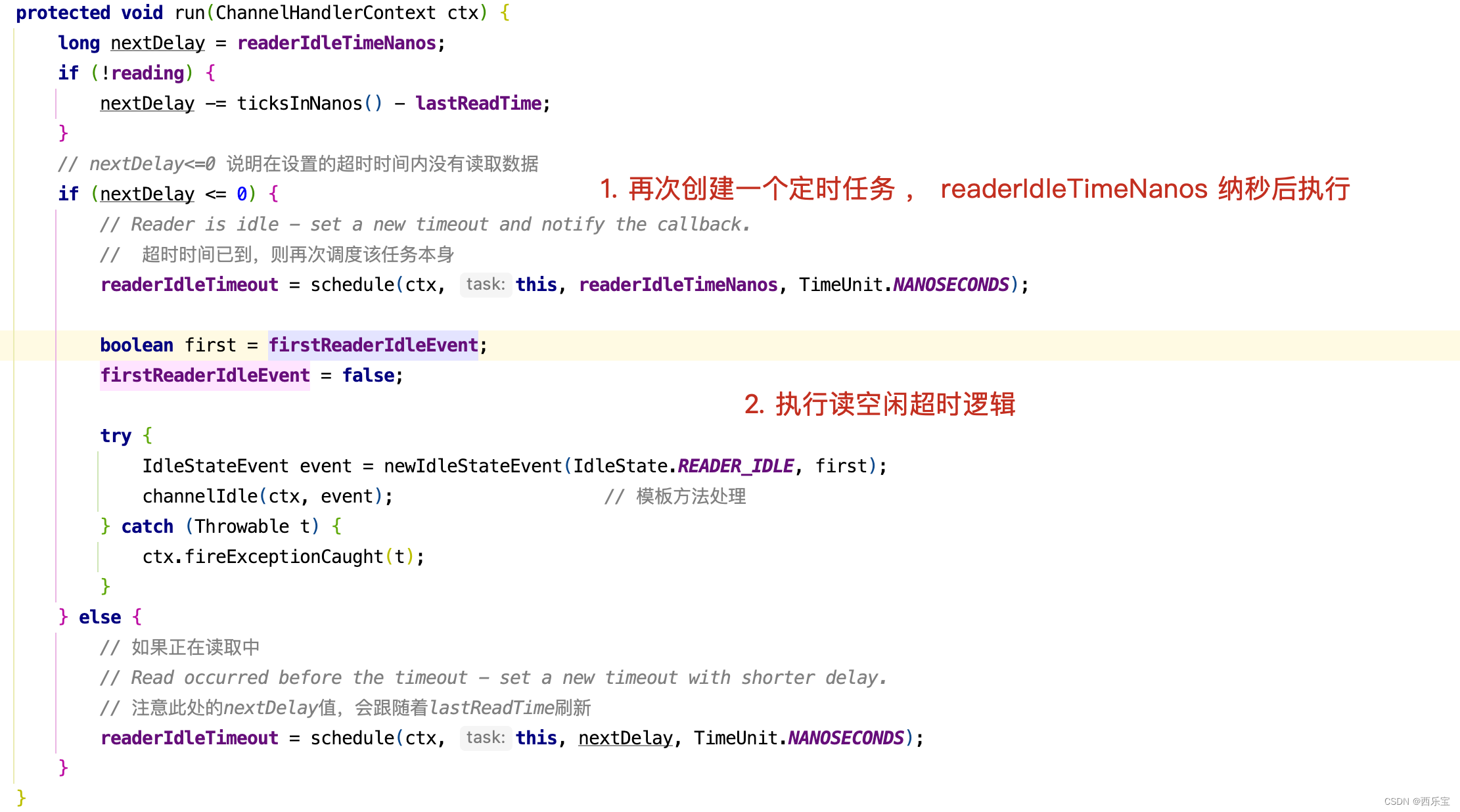
protected void channelIdle(ChannelHandlerContext ctx, IdleStateEvent evt) throws Exception {
ctx.fireUserEventTriggered(evt);
}
public ChannelHandlerContext fireUserEventTriggered(final Object event) {
invokeUserEventTriggered(findContextInbound(MASK_USER_EVENT_TRIGGERED), event);
return this;
}
static void invokeUserEventTriggered(final AbstractChannelHandlerContext next, final Object event) {
ObjectUtil.checkNotNull(event, "event");
EventExecutor executor = next.executor();
if (executor.inEventLoop()) {
next.invokeUserEventTriggered(event);
} else {
executor.execute(new Runnable() {
@Override
public void run() {
next.invokeUserEventTriggered(event);
}
});
}
private void invokeUserEventTriggered(Object event) {
if (invokeHandler()) {
try {
((ChannelInboundHandler) handler()).userEventTriggered(this, event);
} catch (Throwable t) {
notifyHandlerException(t);
}
} else {
fireUserEventTriggered(event);
}
}
userEventTriggered()这个方法,是不是很熟悉了,这不就是自定义的HeartBeatServerHandler中继承的userEventTriggered()方法不? 这个方法可以根据IdleStateEvent事件,做不同的业务处理。 当然啦,在本例中,如果连续3次读空闲了,此时向客户端发送一个idle close消息,客户端收到idle close消息,会调用 ctx.channel().closeFuture() 关闭链接 。在研究源码的过程中,我们发现很多地方使用了channelActive(), channelRead(),channelReadComplete(), handlerAdded(),这些方法何时被调用的呢?写一个统一的例子来学习。
先看服务端代码 。
public class NettyServer {
public static void main(String[] args) throws Exception {
// 创建两个线程组bossGroup和workerGroup, 含有的子线程NioEventLoop的个数默认为cpu核数的两倍
// bossGroup只是处理连接请求 ,真正的和客户端业务处理,会交给workerGroup完成
EventLoopGroup bossGroup = new NioEventLoopGroup(1);
EventLoopGroup workerGroup = new NioEventLoopGroup(8);
try {
// 创建服务器端的启动对象
ServerBootstrap bootstrap = new ServerBootstrap();
// 使用链式编程来配置参数
bootstrap.group(bossGroup, workerGroup) //设置两个线程组
// 使用NioServerSocketChannel作为服务器的通道实现
.channel(NioServerSocketChannel.class)
// 初始化服务器连接队列大小,服务端处理客户端连接请求是顺序处理的,所以同一时间只能处理一个客户端连接。
// 多个客户端同时来的时候,服务端将不能处理的客户端连接请求放在队列中等待处理
.option(ChannelOption.SO_BACKLOG, 1024)
.childHandler(new ChannelInitializer<SocketChannel>() {//创建通道初始化对象,设置初始化参数,在 SocketChannel 建立起来之前执行
@Override
protected void initChannel(SocketChannel ch) throws Exception {
//对workerGroup的SocketChannel设置处理器
ch.pipeline().addLast(new LifeCycleInBoundHandler());
ch.pipeline().addLast(new NettyServerHandler());
}
});
System.out.println("netty server start。。");
// 绑定一个端口并且同步, 生成了一个ChannelFuture异步对象,通过isDone()等方法可以判断异步事件的执行情况
// 启动服务器(并绑定端口),bind是异步操作,sync方法是等待异步操作执行完毕
ChannelFuture cf = bootstrap.bind(9000).sync();
// 给cf注册监听器,监听我们关心的事件
/*cf.addListener(new ChannelFutureListener() {
@Override
public void operationComplete(ChannelFuture future) throws Exception {
if (cf.isSuccess()) {
System.out.println("监听端口9000成功");
} else {
System.out.println("监听端口9000失败");
}
}
});*/
// 等待服务端监听端口关闭,closeFuture是异步操作
// 通过sync方法同步等待通道关闭处理完毕,这里会阻塞等待通道关闭完成,内部调用的是Object的wait()方法
cf.channel().closeFuture().sync();
} finally {
bossGroup.shutdownGracefully();
workerGroup.shutdownGracefully();
}
}
}
/**
* 自定义Handler需要继承netty规定好的某个HandlerAdapter(规范)
*/
public class NettyServerHandler extends ChannelInboundHandlerAdapter {
/**
* 读取客户端发送的数据
*
* @param ctx 上下文对象, 含有通道channel,管道pipeline
* @param msg 就是客户端发送的数据
* @throws Exception
*/
@Override
public void channelRead(ChannelHandlerContext ctx, Object msg) throws Exception {
System.out.println("服务器读取线程 " + Thread.currentThread().getName());
//Channel channel = ctx.channel();
//ChannelPipeline pipeline = ctx.pipeline(); //本质是一个双向链接, 出站入站
//将 msg 转成一个 ByteBuf,类似NIO 的 ByteBuffer
ByteBuf buf = (ByteBuf) msg;
System.out.println("客户端发送消息是:" + buf.toString(CharsetUtil.UTF_8));
}
/**
* 数据读取完毕处理方法
*
* @param ctx
* @throws Exception
*/
@Override
public void channelReadComplete(ChannelHandlerContext ctx) throws Exception {
ByteBuf buf = Unpooled.copiedBuffer("HelloClient".getBytes(CharsetUtil.UTF_8));
ctx.writeAndFlush(buf);
}
/**
* 处理异常, 一般是需要关闭通道
*
* @param ctx
* @param cause
* @throws Exception
*/
@Override
public void exceptionCaught(ChannelHandlerContext ctx, Throwable cause) throws Exception {
ctx.close();
}
}
/**
* handler的生命周期回调接口调用顺序:
* handlerAdded -> channelRegistered -> channelActive -> channelRead -> channelReadComplete
* -> channelInactive -> channelUnRegistered -> handlerRemoved
*
* handlerAdded: 新建立的连接会按照初始化策略,把handler添加到该channel的pipeline里面,也就是channel.pipeline.addLast(new LifeCycleInBoundHandler)执行完成后的回调;
* channelRegistered: 当该连接分配到具体的worker线程后,该回调会被调用。
* channelActive:channel的准备工作已经完成,所有的pipeline添加完成,并分配到具体的线上上,说明该channel准备就绪,可以使用了。
* channelRead:客户端向服务端发来数据,每次都会回调此方法,表示有数据可读;
* channelReadComplete:服务端每次读完一次完整的数据之后,回调该方法,表示数据读取完毕;
* channelInactive:当连接断开时,该回调会被调用,说明这时候底层的TCP连接已经被断开了。
* channelUnRegistered: 对应channelRegistered,当连接关闭后,释放绑定的workder线程;
* handlerRemoved: 对应handlerAdded,将handler从该channel的pipeline移除后的回调方法。
*/
public class LifeCycleInBoundHandler extends ChannelInboundHandlerAdapter {
@Override
// 该连接分配到具体的worker线程后,该回调会被调用。
public void channelRegistered(ChannelHandlerContext ctx)
throws Exception {
System.out.println("channelRegistered: channel注册到NioEventLoop");
super.channelRegistered(ctx);
}
@Override
// 对应channelRegistered,当连接关闭后,释放绑定的workder线程;
public void channelUnregistered(ChannelHandlerContext ctx)
throws Exception {
System.out.println("channelUnregistered: channel取消和NioEventLoop的绑定");
super.channelUnregistered(ctx);
}
@Override
// channelActive:channel的准备工作已经完成,所有的pipeline添加完成,并分配到具体的线上上,说明该channel准备就绪,可以使用了。
public void channelActive(ChannelHandlerContext ctx)
throws Exception {
System.out.println("channelActive: channel准备就绪");
super.channelActive(ctx);
}
// 当连接断开时,该回调会被调用,说明这时候底层的TCP连接已经被断开了。
@Override
public void channelInactive(ChannelHandlerContext ctx)
throws Exception {
System.out.println("channelInactive: channel被关闭");
super.channelInactive(ctx);
}
// 客户端向服务端发来数据,每次都会回调此方法,表示有数据可读;
@Override
public void channelRead(ChannelHandlerContext ctx, Object msg)
throws Exception {
System.out.println("channelRead: channel中有可读的数据" );
super.channelRead(ctx, msg);
}
// 服务端每次读完一次完整的数据之后,回调该方法,表示数据读取完毕;
@Override
public void channelReadComplete(ChannelHandlerContext ctx)
throws Exception {
System.out.println("channelReadComplete: channel读数据完成");
super.channelReadComplete(ctx);
}
@Override
// handlerAdded: 新建立的连接会按照初始化策略,把handler添加到该channel的pipeline里面,也就是channel.pipeline.addLast(new LifeCycleInBoundHandler)执行完成后的回调;
public void handlerAdded(ChannelHandlerContext ctx)
throws Exception {
System.out.println("handlerAdded: handler被添加到channel的pipeline");
super.handlerAdded(ctx);
}
// handlerRemoved: 对应handlerAdded,将handler从该channel的pipeline移除后的回调方法。
@Override
public void handlerRemoved(ChannelHandlerContext ctx)
throws Exception {
System.out.println("handlerRemoved: handler从channel的pipeline中移除");
super.handlerRemoved(ctx);
}
}
如何研究这些源码呢? 我们可以在方法的内部打一个断点 。
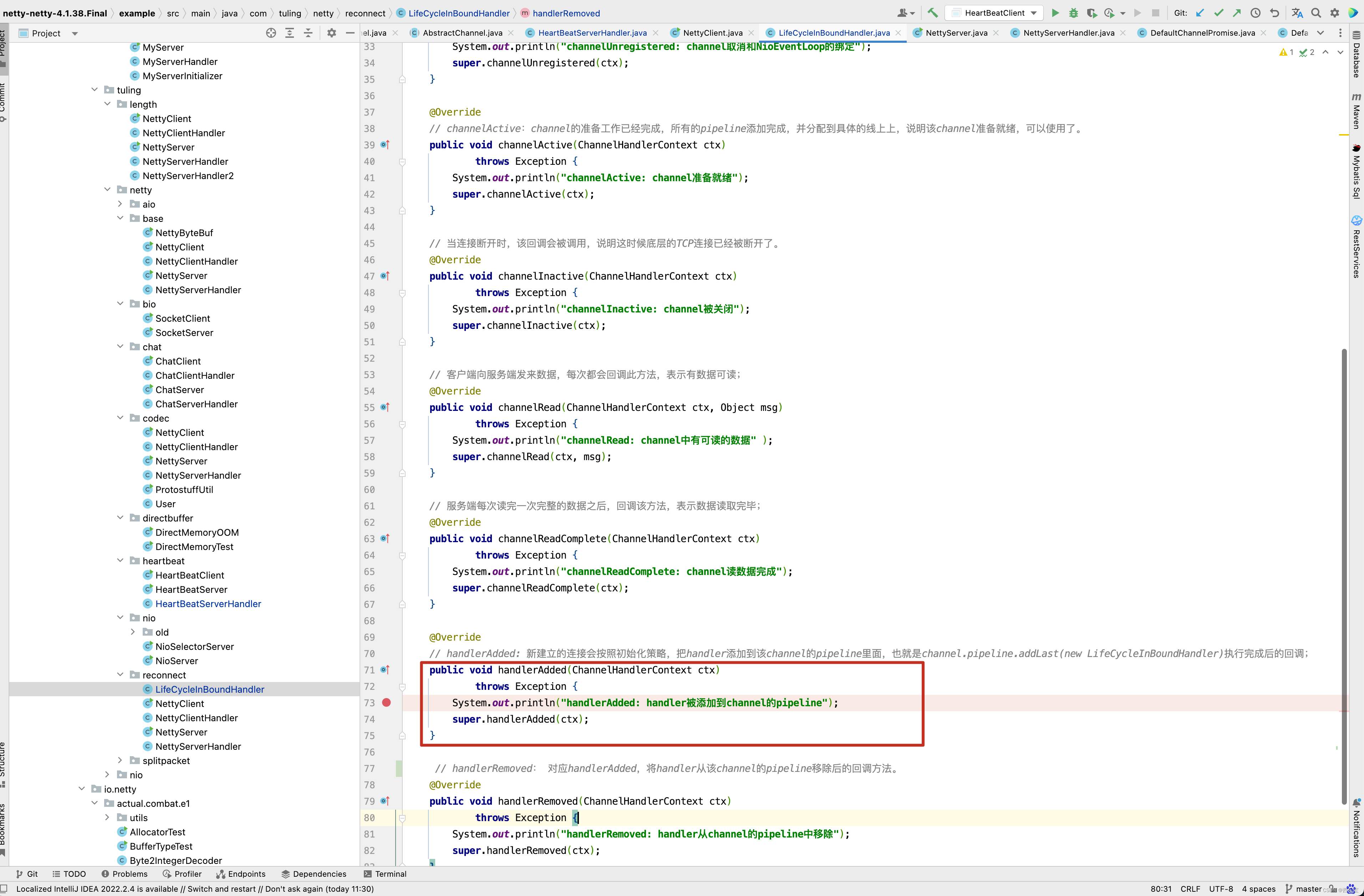
然后通过断点查询调用栈, 回溯源码的执行过程,通过这种方法研究源码是一个不错的选择。 接下来看另外的例子。
用Netty实现聊天程序
public class ChatServer {
public static void main(String[] args) throws Exception {
EventLoopGroup bossGroup = new NioEventLoopGroup(1);
EventLoopGroup workerGroup = new NioEventLoopGroup(8);
try {
ServerBootstrap bootstrap = new ServerBootstrap();
bootstrap.group(bossGroup, workerGroup)
.channel(NioServerSocketChannel.class)
.option(ChannelOption.SO_BACKLOG, 1024)
.childHandler(new ChannelInitializer<SocketChannel>() {
@Override
protected void initChannel(SocketChannel ch) throws Exception {
ChannelPipeline pipeline = ch.pipeline();
//加入特殊分隔符分包解码器
//pipeline.addLast(new DelimiterBasedFrameDecoder(1024, Unpooled.copiedBuffer("_"
// .getBytes())));
//向pipeline加入解码器
pipeline.addLast("decoder", new StringDecoder());
//向pipeline加入编码器
pipeline.addLast("encoder", new StringEncoder());
//加入自己的业务处理handler
pipeline.addLast(new ChatServerHandler());
}
});
System.out.println("聊天室server启动。。");
ChannelFuture channelFuture = bootstrap.bind(9000).sync();
//关闭通道
channelFuture.channel().closeFuture().sync();
} finally {
bossGroup.shutdownGracefully();
workerGroup.shutdownGracefully();
}
}
}
public class ChatServerHandler extends SimpleChannelInboundHandler<String> {
//GlobalEventExecutor.INSTANCE 是全局的事件执行器,是一个单例
private static ChannelGroup channelGroup = new DefaultChannelGroup(GlobalEventExecutor.INSTANCE);
SimpleDateFormat sdf = new SimpleDateFormat("yyyy-MM-dd HH:mm:ss");
//表示 channel 处于就绪状态, 提示上线
@Override
public void channelActive(ChannelHandlerContext ctx) {
Channel channel = ctx.channel();
//将该客户加入聊天的信息推送给其它在线的客户端
//该方法会将 channelGroup 中所有的 channel 遍历,并发送消息
channelGroup.writeAndFlush("[ 客户端 ]" + channel.remoteAddress() + " 上线了 " + sdf.format(new
java.util.Date()) + "\n");
//将当前 channel 加入到 channelGroup
channelGroup.add(channel);
System.out.println(ctx.channel().remoteAddress() + " 上线了" + "\n");
}
//表示 channel 处于不活动状态, 提示离线了
@Override
public void channelInactive(ChannelHandlerContext ctx) {
Channel channel = ctx.channel();
//将客户离开信息推送给当前在线的客户
channelGroup.writeAndFlush("[ 客户端 ]" + channel.remoteAddress() + " 下线了" + "\n");
System.out.println(ctx.channel().remoteAddress() + " 下线了" + "\n");
System.out.println("channelGroup size=" + channelGroup.size());
}
//读取数据
@Override
protected void channelRead0(ChannelHandlerContext ctx, String msg) {
//获取到当前 channel
Channel channel = ctx.channel();
//这时我们遍历 channelGroup, 根据不同的情况, 回送不同的消息
channelGroup.forEach(ch -> {
if (channel != ch) { //不是当前的 channel,转发消息
ch.writeAndFlush("[ 客户端 ]" + channel.remoteAddress() + " 发送了消息:" + msg + "\n");
} else {//回显自己发送的消息给自己
ch.writeAndFlush("[ 自己 ]发送了消息:" + msg + "\n");
}
});
}
@Override
public void exceptionCaught(ChannelHandlerContext ctx, Throwable cause) {
//关闭通道
ctx.close();
}
}
再看客户端代码 。
public class ChatClient {
public static void main(String[] args) throws Exception {
EventLoopGroup group = new NioEventLoopGroup();
try {
Bootstrap bootstrap = new Bootstrap();
bootstrap.group(group)
.channel(NioSocketChannel.class)
.handler(new ChannelInitializer<SocketChannel>() {
@Override
protected void initChannel(SocketChannel ch) throws Exception {
ChannelPipeline pipeline = ch.pipeline();
//pipeline.addLast(new DelimiterBasedFrameDecoder(1024, Unpooled.copiedBuffer("_"
// .getBytes())));
//向pipeline加入解码器
pipeline.addLast("decoder", new StringDecoder());
//向pipeline加入编码器
pipeline.addLast("encoder", new StringEncoder());
//加入自己的业务处理handler
pipeline.addLast(new ChatClientHandler());
}
});
ChannelFuture channelFuture = bootstrap.connect("127.0.0.1", 9000).sync();
//得到 channel
Channel channel = channelFuture.channel();
System.out.println("========" + channel.localAddress() + "========");
//客户端需要输入信息, 创建一个扫描器
Scanner scanner = new Scanner(System.in);
while (scanner.hasNextLine()) {
String msg = scanner.nextLine();
//通过 channel 发送到服务器端
channel.writeAndFlush(msg);
}
/*for (int i = 0; i < 200; i++) {
channel.writeAndFlush("hello,诸葛!" + "_");
}*/
} finally {
group.shutdownGracefully();
}
}
}
public class ChatClientHandler extends SimpleChannelInboundHandler<String> {
@Override
protected void channelRead0(ChannelHandlerContext ctx, String msg){
System.out.println(msg.trim());
}
}
服务端channelActive(), channelRead0() 方法还是很好理解的,如果有用户上线,将channel添加到ChannelGroup中,当有用户发消息时,遍历ChannelGroup中的所有channel写一条消息,这一块的逻辑还是很好理解的,但channelInactive()方法就不好理解了,为什么有用户下线时,并没有将channel从ChannelGroup中移除呢? 我们看一下channelGroup的add()方法的实现逻辑 。
public boolean add(Channel channel) {
ConcurrentMap<ChannelId, Channel> map =
channel instanceof ServerChannel? serverChannels : nonServerChannels;
boolean added = map.putIfAbsent(channel.id(), channel) == null;
if (added) {
channel.closeFuture().addListener(remover);
}
if (stayClosed && closed) {
// First add channel, than check if closed.
// Seems inefficient at first, but this way a volatile
// gives us enough synchronization to be thread-safe.
//
// If true: Close right away.
// (Might be closed a second time by ChannelGroup.close(), but this is ok)
//
// If false: Channel will definitely be closed by the ChannelGroup.
// (Because closed=true always happens-before ChannelGroup.close())
//
// See https://github.com/netty/netty/issues/4020
channel.close();
}
return added;
}
private final ChannelFutureListener remover = new ChannelFutureListener() {
@Override
public void operationComplete(ChannelFuture future) throws Exception {
remove(future.channel());
}
};
看到没有,在将Channel添加到channelGroup时,添加了一个ChannelFutureListener监听器,当channel.closeFuture()完成时,会调用ChannelFutureListener监听器的operationComplete()方法,将channel从serverChannels或nonServerChannels移除掉,即使没有在channelInactive显式的调用channelGroup的remove()方法,channel最终也会从channelGroup中移除掉。关于Netty应用方面的源码分析到这里已经告一段落。接下来看当接收完客户端请求的数据,服务端向客户端写数据的过程又是怎样子的呢?
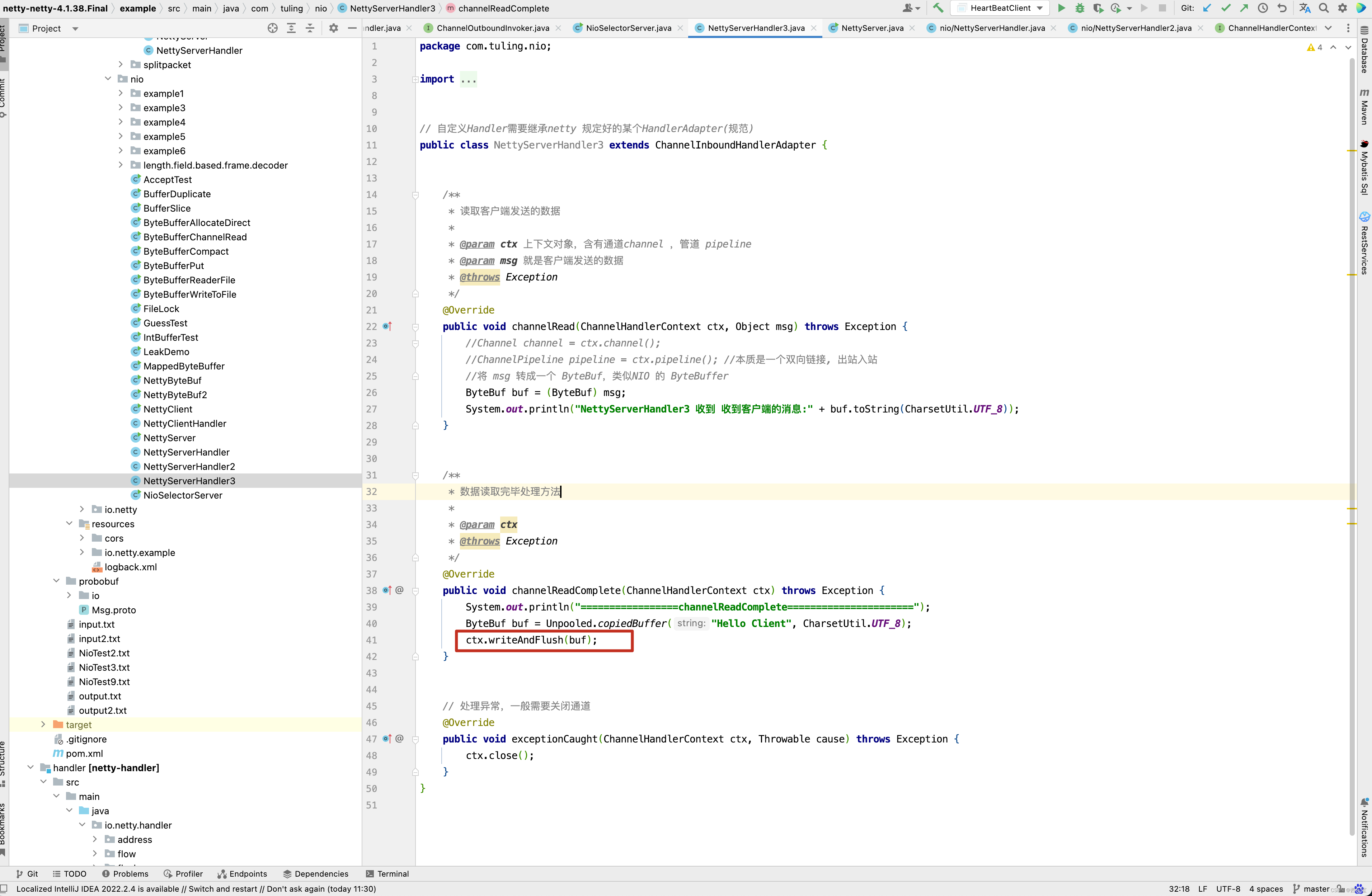
写数据writeAndFlush源码解读
对于写数据,还是以一个例子作为出发点来分析,先看例子的服务端代码 。
public class NettyServer {
public static void main(String[] args) {
// 创建两个线程组bossGroup 和workerGroup , 含有的子线程NioEventLoop 的个数默认为CPU 核数的两倍
// BossGroup只是处理连接请求,真正的和客户端业务处理,会交给workerGroup完成
EventLoopGroup bossGroup = new NioEventLoopGroup(1);
EventLoopGroup workerGroup = new NioEventLoopGroup();
try {
// 创建服务端的启动对象
ServerBootstrap bootstrap = new ServerBootstrap();
// 使用链式编程来配置参数
bootstrap.group(bossGroup, workerGroup)//设置两个线程组
.channel(NioServerSocketChannel.class) // 使用NioServerSocketChannel 作为服务器的通道实现
// 初始化服务器连接队列大小,服务端处理客户端连接请求是顺序处理的,所以同一时间,只能处理一个客户端连接,多个客户端同时来的时候
// 服务端将不能处理的客户端连接请求放在队列中等待处理
.option(ChannelOption.SO_BACKLOG, 1024)
.childHandler(new ChannelInitializer<SocketChannel>() {
@Override
protected void initChannel(SocketChannel ch) throws Exception {
ch.pipeline().addLast(new UserEncoder());
ch.pipeline().addLast(new NettyServerHandler());
}
});
System.out.println("netty server start ....");
// 绑定一个商品并且同步,生成一个ChannelFuture异步对象,通过isDone()等方法可以判断异步事件的执行情况
// 启动服务器(并绑定端口),bind是异步操作,sync方法是等待异步操作执行完毕
ChannelFuture cf = bootstrap.bind(9000).sync();
// 给注册监听器,监听我们关心的事件
cf.addListener(new ChannelFutureListener() {
@Override
public void operationComplete(ChannelFuture future) throws Exception {
if (cf.isSuccess()) {
System.out.println("监听端口9000成功");
} else {
System.out.println("监听端口9000失败");
}
}
});
// 对通道关闭进行监听,closeFuture是异步操作,监听通道关闭
// 通过sync方法同步等待通道关闭处理完毕,这里会阻塞等待通道关闭完成
cf.channel().closeFuture().sync();
} catch (Exception e) {
e.printStackTrace();
} finally {
bossGroup.shutdownGracefully();
workerGroup.shutdownGracefully();
}
}
}
// 自定义Handler需要继承netty 规定好的某个HandlerAdapter(规范)
public class NettyServerHandler extends ChannelInboundHandlerAdapter {
/**
* 读取客户端发送的数据
*
* @param ctx 上下文对象,含有通道channel ,管道 pipeline
* @param msg 就是客户端发送的数据
* @throws Exception
*/
@Override
public void channelRead(ChannelHandlerContext ctx, Object msg) throws Exception {
//Channel channel = ctx.channel();
//ChannelPipeline pipeline = ctx.pipeline(); //本质是一个双向链接, 出站入站
//将 msg 转成一个 ByteBuf,类似NIO 的 ByteBuffer
ByteBuf buf = (ByteBuf) msg;
System.out.println("收到客户端的消息:" + buf.toString(CharsetUtil.UTF_8));
}
/**
* 数据读取完毕处理方法
*
* @param ctx
* @throws Exception
*/
@Override
public void channelReadComplete(ChannelHandlerContext ctx) throws Exception {
System.out.println("=================channelReadComplete======================");
ctx.writeAndFlush(new User("zhangsan",18));
}
// 处理异常,一般需要关闭通道
@Override
public void exceptionCaught(ChannelHandlerContext ctx, Throwable cause) throws Exception {
ctx.close();
}
}
@Data
public class User {
private String userName;
private Integer age ;
public User(String userName, Integer age) {
this.userName = userName;
this.age = age;
}
}
public class UserEncoder extends MessageToByteEncoder {
@Override
protected void encode(ChannelHandlerContext ctx, Object msg, ByteBuf out) throws Exception {
if (msg instanceof User) {
out.writeBytes(JSON.toJSONString(msg).getBytes("utf-8"));
}
}
}
服务端代码其实很简单,在NettyServerHandler的channelReadComplete()方法中,向客户端写入一个User对象,在UserEncoder类中,将User对象转化为byte数组并写到ByteBuf中。
public class NettyClient {
public static void main(String[] args) {
// 客户端需要一个事件循环组
EventLoopGroup group = new NioEventLoopGroup();
try {
// 创建客户端启动对象
// 注意,客户端使用的不是ServerBootstrap , 而是Bootstrap
Bootstrap bootstrap = new Bootstrap();
// 设置相关的参数
bootstrap.group(group) //设置线程组
.channel(NioSocketChannel.class) // 使用NioSocketChannel作为客户端的通道实现
.handler(new ChannelInitializer<SocketChannel>() {
@Override
protected void initChannel(SocketChannel ch) throws Exception {
ch.pipeline().addLast(new NettyClientHandler());
}
});
System.out.println("netty client start ");
// 启动客户端去连接服务器端
ChannelFuture channelFuture = bootstrap.connect("127.0.0.1",9000).sync();
// 对关闭通道进行监听
channelFuture.channel().closeFuture().sync();
}catch (Exception e ){
e.printStackTrace();
}finally {
group.shutdownGracefully();
}
}
}
public class NettyClientHandler extends ChannelInboundHandlerAdapter {
// 当客户端连接服务器完成就会触发这个方法
@Override
public void channelActive(ChannelHandlerContext ctx) throws Exception {
StringBuffer sb = new StringBuffer();
for(int i = 0 ;i < 1023;i ++){
sb.append("a");
}
sb.append("中");
sb.append("bbbb");
String sbString = sb.toString();
byte[] midbytes = sbString.getBytes("UTF8");
System.out.println("midbytes = " + midbytes.length);
ByteBuf buf = Unpooled.copiedBuffer("", CharsetUtil.UTF_8);
buf.writeBytes(sb.toString().getBytes("utf-8"));
ctx.writeAndFlush(buf);
}
// 当通道在读取事件时会触发,即服务端发送数据给客户端
@Override
public void channelRead(ChannelHandlerContext ctx, Object msg) throws Exception {
ByteBuf buf = (ByteBuf) msg;
System.out.println(" 收到服务端的消息: " + buf.toString(CharsetUtil.UTF_8));
System.out.println("服务端的地址:" + ctx.channel().remoteAddress());
}
@Override
public void exceptionCaught(ChannelHandlerContext ctx, Throwable cause) throws Exception {
cause.printStackTrace();
ctx.close();
}
}
客户端代码没有什么变动,很简单的发送数据和读取数据,接下来跟进writeAndFlush()方法 。
public ChannelFuture writeAndFlush(Object msg) {
return writeAndFlush(msg, newPromise());
}
public ChannelFuture writeAndFlush(Object msg, ChannelPromise promise) {
write(msg, true, promise);
return promise;
}
private void write(Object msg, boolean flush, ChannelPromise promise) {
ObjectUtil.checkNotNull(msg, "msg");
try {
if (isNotValidPromise(promise, true)) {
ReferenceCountUtil.release(msg);
// cancelled
return;
}
} catch (RuntimeException e) {
ReferenceCountUtil.release(msg);
throw e;
}
final AbstractChannelHandlerContext next = findContextOutbound(flush ?
(MASK_WRITE | MASK_FLUSH) : MASK_WRITE);
final Object m = pipeline.touch(msg, next);
EventExecutor executor = next.executor();
if (executor.inEventLoop()) { // 判断是否是 EventLoop 线程
if (flush) {
next.invokeWriteAndFlush(m, promise);
} else {
next.invokeWrite(m, promise);
}
} else { // 当为非EventLoop线程时需要构建 task
final AbstractWriteTask task;
if (flush) {
task = WriteAndFlushTask.newInstance(next, m, promise);
} else {
task = WriteTask.newInstance(next, m, promise);
}
// 把task加入到executor 中,这个executor 就是NioEventLoop ,若是失败,则取消task执行
if (!safeExecute(executor, task, promise, m)) {
// We failed to submit the AbstractWriteTask. We need to cancel it so we decrement the pending bytes
// and put it back in the Recycler for re-use later.
//
// See https://github.com/netty/netty/issues/8343.
task.cancel();
}
}
}
private AbstractChannelHandlerContext findContextOutbound(int mask) {
AbstractChannelHandlerContext ctx = this;
do {
ctx = ctx.prev;
} while ((ctx.executionMask & mask) == 0);
return ctx;
}
findContextOutbound()方法很有意思,从Handler向前查找可用Handler,请看下图。
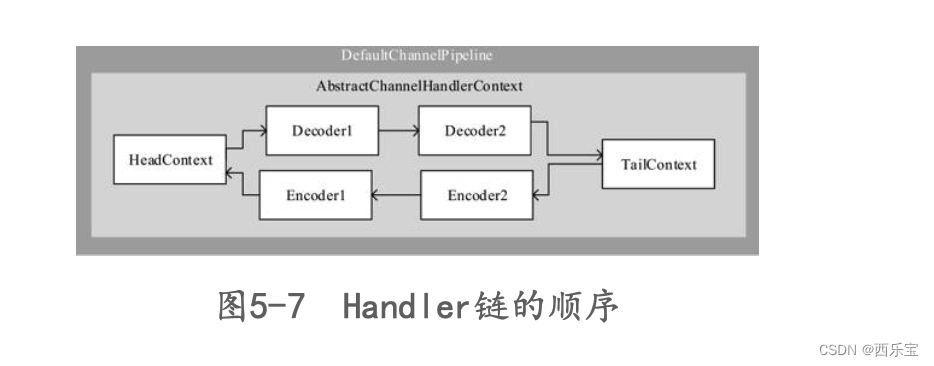
我们是不是有一种错觉,当读数据时,从HeadContext开始,一直读到TailContext中,其实不然,之前也分析过,如果Handler没有调用ctx.fireChannelRead(),是不会向后执行的,同理,当在Handler的channelReadComplete()方法中调用ctx.writeAndFlush(new User(“zhangsan”,18))方法,此时向前调用并不是从TailContext开始,而是从我们自定义的Handler向前查找Handler并调用他的writeAndFlush()方法 。在write()方法的加粗代码中有一个executor.inEventLoop(),这又是何意呢 ?如果executor.inEventLoop()为false,什么情况下会出现呢? 如果在业务Handler中,若开启了额外的业务线程,那么在Netty 内部是如何把业务线程结果数据经过I/O线程发送出去的呢? executor.inEventLoop()为false就是处理这一块逻辑,首先看个例子,我们重点看channelReadComplete的写法。
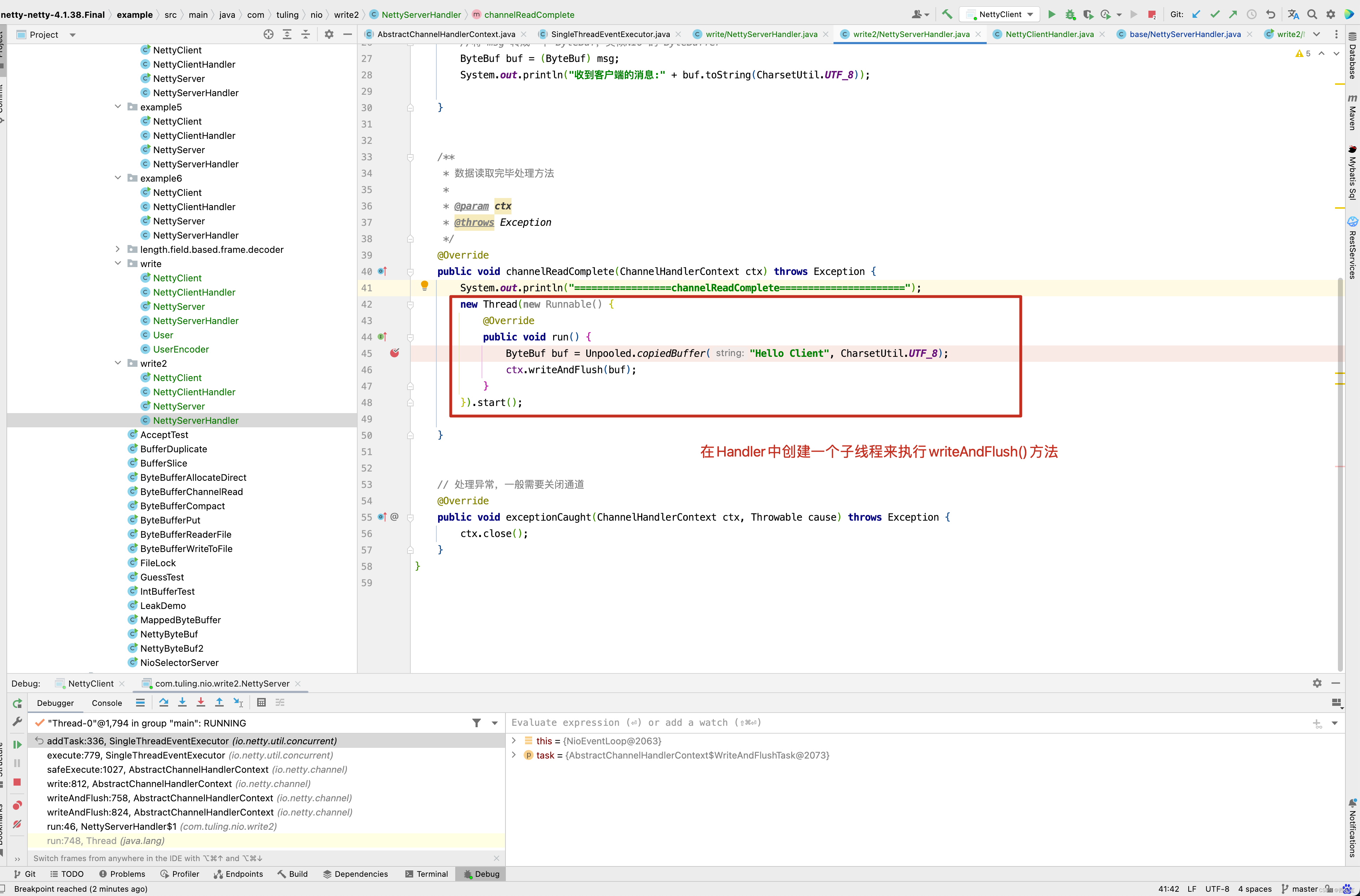
在ServerHandler里开启额外线程去执行 ctx.channel().writeAndFlush(response)时,NioEventLoop线程如何获取response内容并写回给 Channel呢?
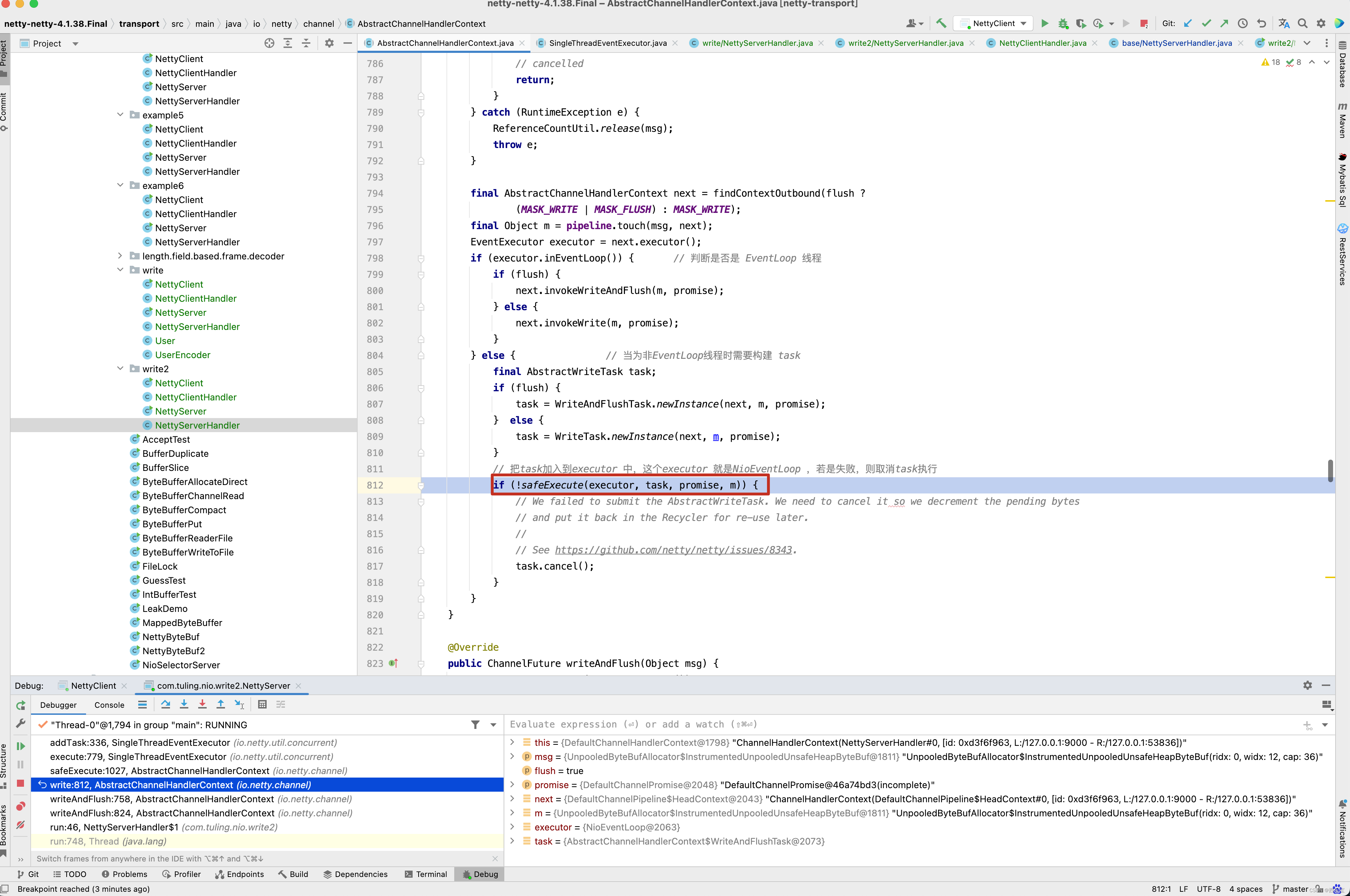
在写过程中有两种task,分别是WriteTask和WriteAndFlushTask,主要是根据是否刷新来决定使用哪种task,在NioSocketChannel中,每个Channel都有一条NioEventLoop线程与之对应,在NioEventLoop的父类SingleThreadEventExecutor的execute()方法存放非EventLoop线程的任务,包括WriteTask和WriteAndFlushTask这两种WriteTask,当调用添加任务时, 会唤醒EventLoop 线程,从而I/O线程会调用这些任务的run()方法,并把结果写回到Socket通道 。
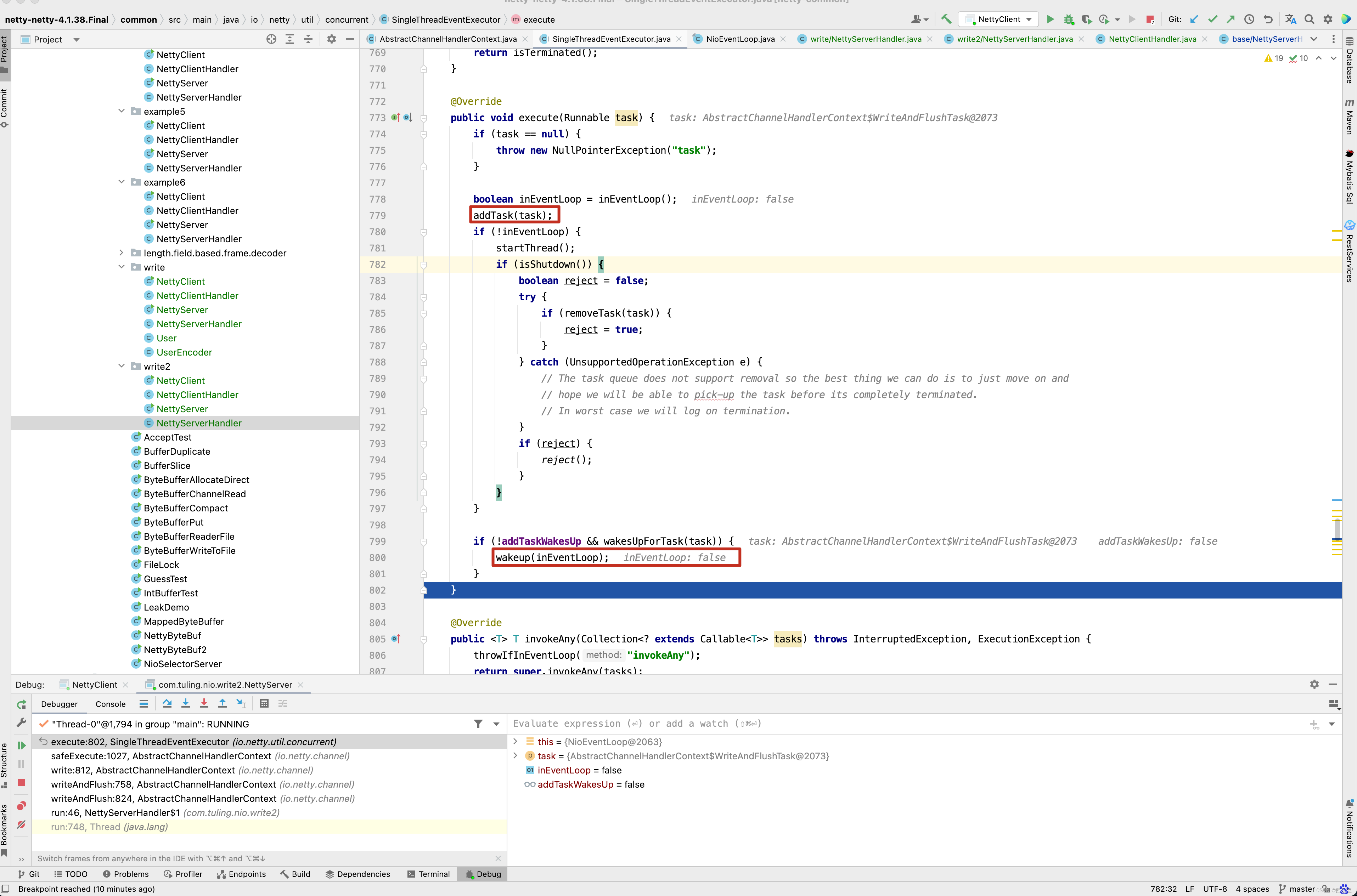
当然还需要理明白一点,ChannelHandlerContext有哪些东西 。
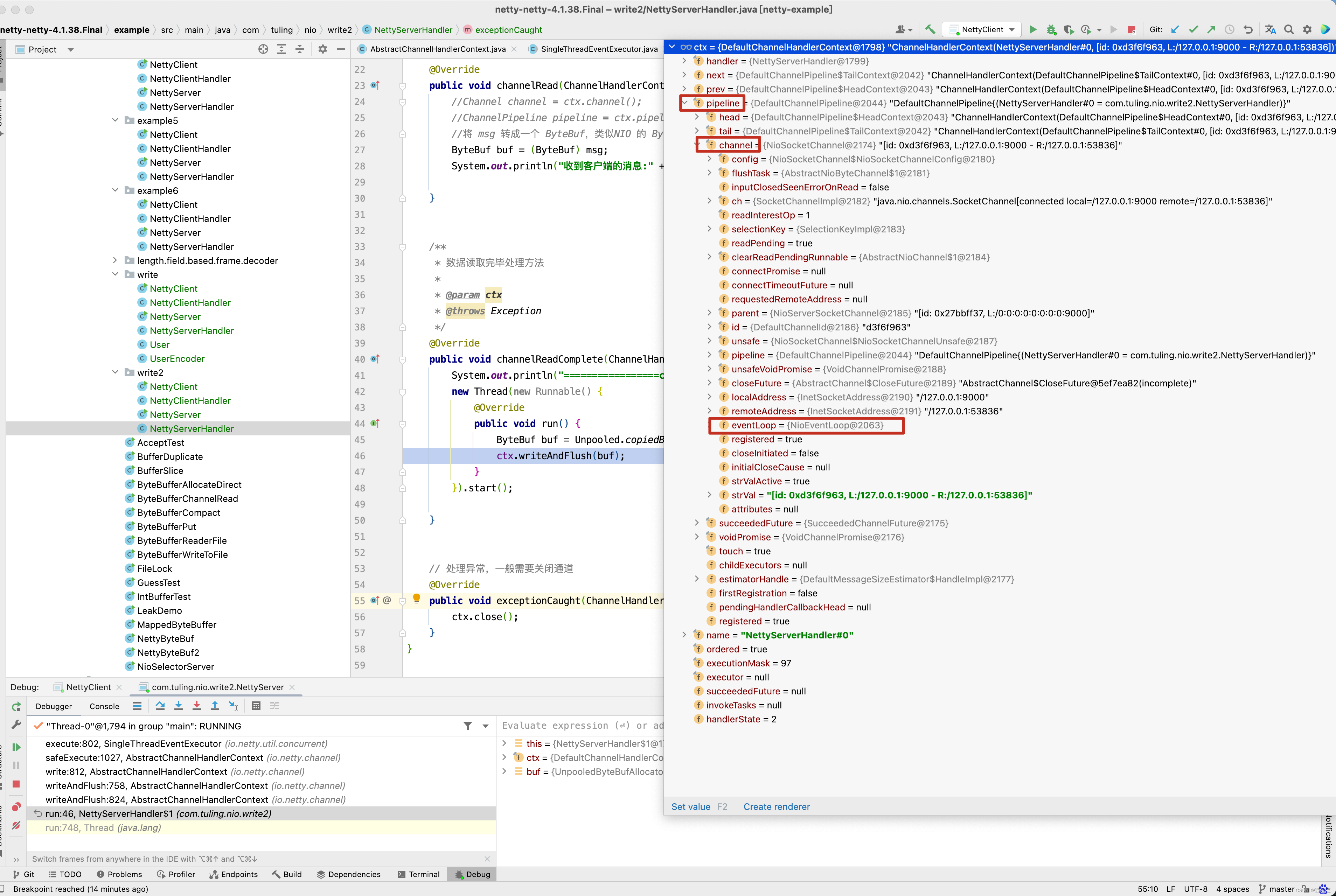
发现没有ChannelHandlerContext中有pipeline,每个pipeline中有SocketChannel,而channel中又有NioEventLoop,而NioEventLoop又有serverSocket注册的selector,有了这些, NioEventLoop执行器回写数据给客户端就很容易了。
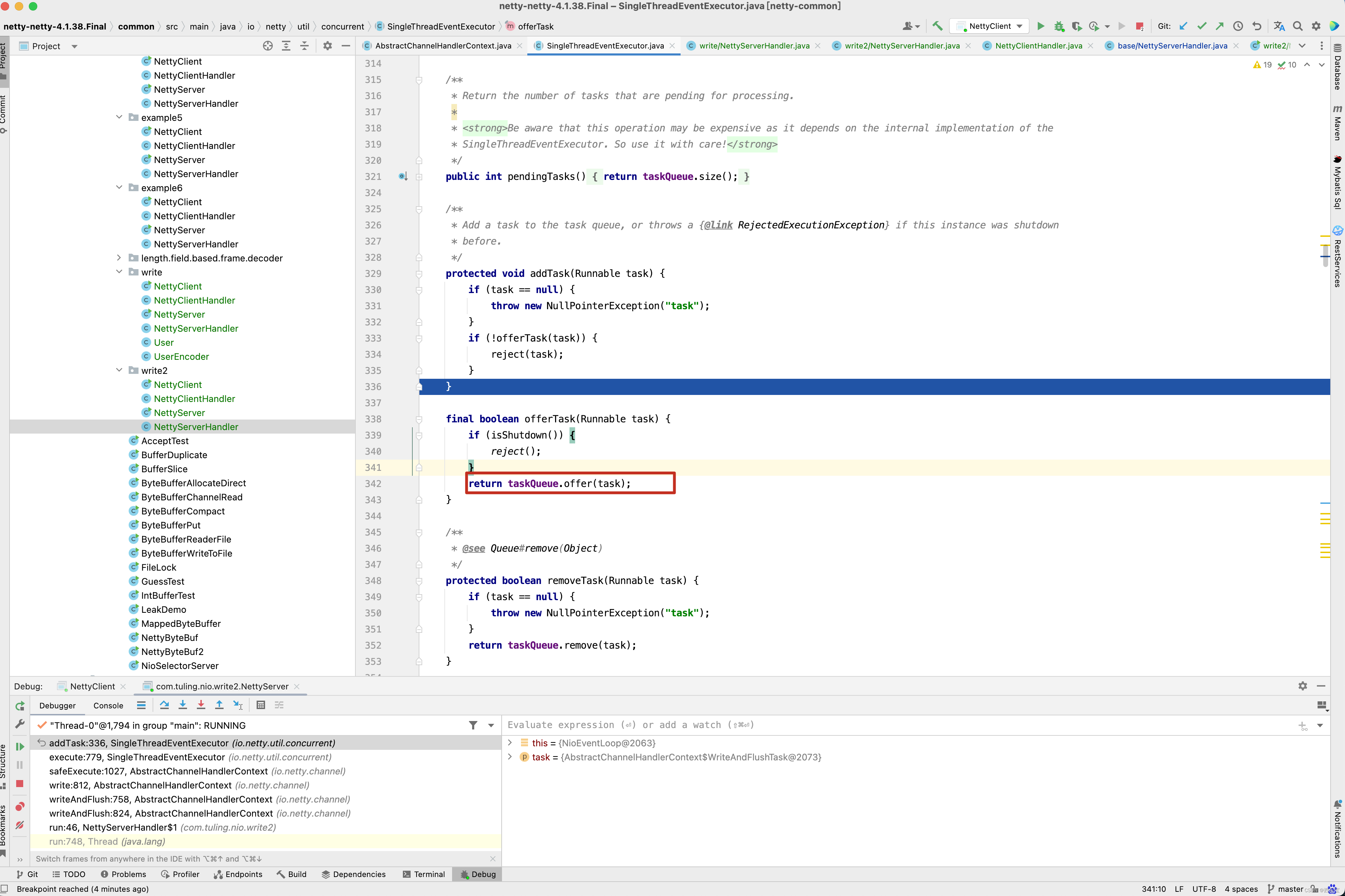
这一块逻辑已经在上一篇博客中分析得很清楚了,这里不再赘述 ,接下来继续看invokeWriteAndFlush()方法的实现逻辑。
private void invokeWriteAndFlush(Object msg, ChannelPromise promise) {
if (invokeHandler()) {
invokeWrite0(msg, promise);
invokeFlush0();
} else {
writeAndFlush(msg, promise);
}
}
private void invokeWrite0(Object msg, ChannelPromise promise) {
try {
((ChannelOutboundHandler) handler()).write(this, msg, promise);
} catch (Throwable t) {
notifyOutboundHandlerException(t, promise);
}
}
public void write(ChannelHandlerContext ctx, Object msg, ChannelPromise promise) throws Exception {
ByteBuf buf = null;
try {
if (acceptOutboundMessage(msg)) {
@SuppressWarnings("unchecked")
I cast = (I) msg;
buf = allocateBuffer(ctx, cast, preferDirect);
try {
encode(ctx, cast, buf);
} finally {
ReferenceCountUtil.release(cast);
}
if (buf.isReadable()) {
ctx.write(buf, promise);
} else {
buf.release();
ctx.write(Unpooled.EMPTY_BUFFER, promise);
}
buf = null;
} else {
ctx.write(msg, promise);
}
} catch (EncoderException e) {
throw e;
} catch (Throwable e) {
throw new EncoderException(e);
} finally {
if (buf != null) {
buf.release();
}
}
}
acceptOutboundMessage方法是很有意思的。如果我们自定义的UserEncoder对象继承MessageToByteEncoder指定了泛型对象。

那这个Encoder 编码器只对写入值为泛型对象的数据做编码处理,而这个功能实现源码就在acceptOutboundMessage()方法中,因为逻辑很简单,有兴趣自己打断点看看,无论我们定义多少个encoder Handler,最终都会调用HeadContext的write()方法 。
public void write(ChannelHandlerContext ctx, Object msg, ChannelPromise promise) {
unsafe.write(msg, promise);
}
而write()方法最终调用了NioSocketChannelUnsafe的write方法,进入NioSocketChannelUnsafe的write()方法 。
public final void write(Object msg, ChannelPromise promise) {
assertEventLoop();
ChannelOutboundBuffer outboundBuffer = this.outboundBuffer;
if (outboundBuffer == null) {
// If the outboundBuffer is null we know the channel was closed and so
// need to fail the future right away. If it is not null the handling of the rest
// will be done in flush0()
// See https://github.com/netty/netty/issues/2362
safeSetFailure(promise, newClosedChannelException(initialCloseCause));
// release message now to prevent resource-leak
ReferenceCountUtil.release(msg);
return;
}
int size;
try {
msg = filterOutboundMessage(msg);
size = pipeline.estimatorHandle().size(msg);
if (size < 0) {
size = 0;
}
} catch (Throwable t) {
safeSetFailure(promise, t);
ReferenceCountUtil.release(msg);
return;
}
outboundBuffer.addMessage(msg, size, promise);
}
public void addMessage(Object msg, int size, ChannelPromise promise) {
// 把msg消息数据包装成Entry 对象
Entry entry = Entry.newInstance(msg, size, total(msg), promise);
// 若链表为空, 则尾节点为当前节点
if (tailEntry == null) {
flushedEntry = null;
} else {
// 当链表不为空时,把新的Entry对象添加到链表尾部
Entry tail = tailEntry;
tail.next = entry;
}
// unflushedEntry 为空,表示调用addFlush()方法将链表中之前的元素都已经全部加入了需要发送的节点,否则链表为空
tailEntry = entry;
if (unflushedEntry == null) {
unflushedEntry = entry;
}
// increment pending bytes after adding message to the unflushed arrays.
// See https://github.com/netty/netty/issues/1619
// 修改通过缓存总数据的大小,若缓存总数据大小超过了高水位 , 则会触发 fireChannelWritabilityChanged 事件,进入背压
incrementPendingOutboundBytes(entry.pendingSize, false);
}
private void incrementPendingOutboundBytes(long size, boolean invokeLater) {
if (size == 0) {
return;
}
long newWriteBufferSize = TOTAL_PENDING_SIZE_UPDATER.addAndGet(this, size);
if (newWriteBufferSize > channel.config().getWriteBufferHighWaterMark()) {
setUnwritable(invokeLater);
}
}
在看上述代码之前先来看ChannelOutboundBuffer的几个属性。
// The Entry that is the first in the linked-list structure that was flushed // 链表中被刷新的第一个元素,此元素准备第一个写入Socket private Entry flushedEntry; // The Entry which is the first unflushed in the linked-list structure // 链表中第一个未刷新的元素, 当调用addMessage()方法后, 从原链表tailEntry到Entry (现链表tailEntry)节点都是未被刷新的数据 private Entry unflushedEntry; // The Entry which represents the tail of the buffer // 链表末尾结点 private Entry tailEntry; // The number of flushed entries that are not written yet // 表示已经刷新但还没有写到Socket 中的Entry 的数据 private int flushed;
前面3个属性都是指针,构造了刷新和未刷新的数据链表,ChannelOutboundBuffer缓冲区处理过程如图所示 。
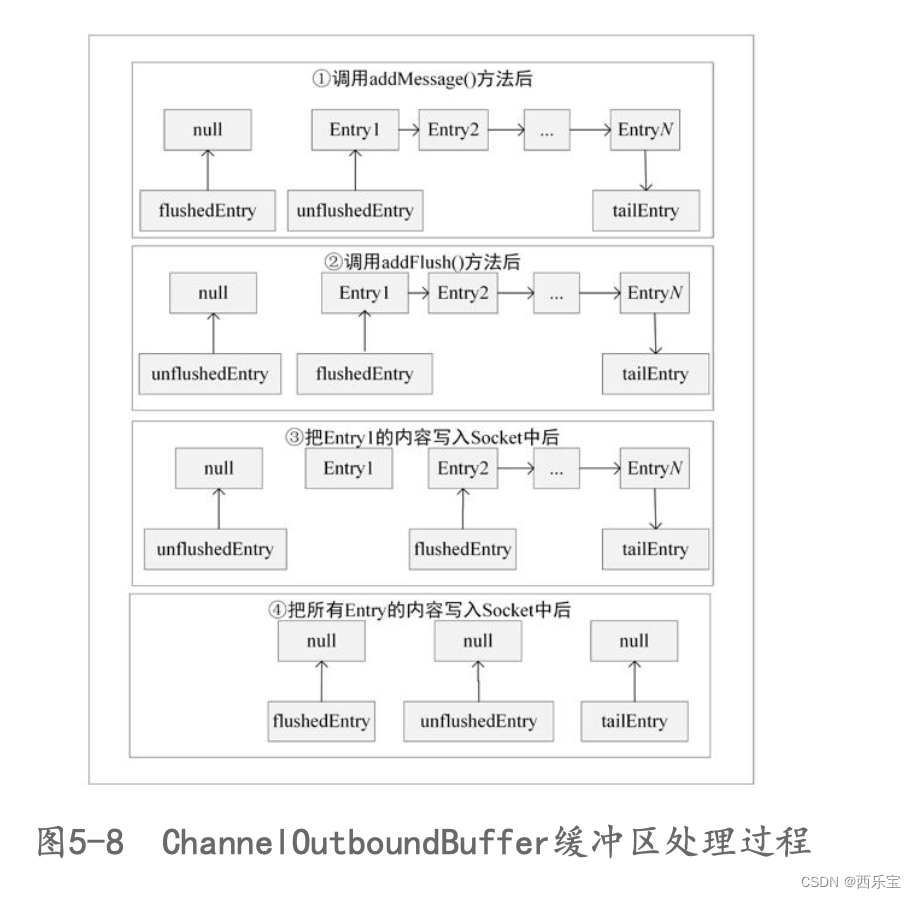
在调用addMessage()方法后,采用CAS方法增加待发送的字节数,此时如果待发送的字节数大于通道写buf的最高阈值writeBufferHighWaterMark,此时更新通道状态为不可写, 同时触发channelWritabilityChanged事件 ,防止内存溢出,在ServerHandler的channelWritabilityChanged() 方法中进行怎样的处理呢? 请看下图 。
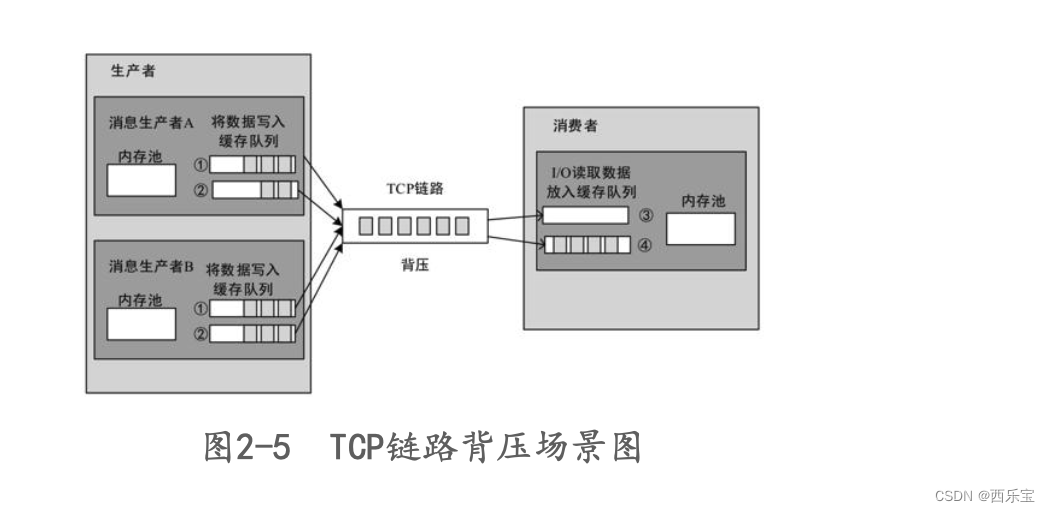
当消费者的消费速率低于生产者的发送速率时,会造成背压,此时消费者无法从TCP通道读取数据,因为它无法再从内存池中获取内存,从而造成TCP通道阻塞,生产都无法把数据发送出去,这就使生产者不再向缓冲队列中写入数据,从而降低了生产速率,当消费者的消费速率提升且TCP通道不再阻塞时, 生产者发送速率又会提到提升,整个链路运行恢复正常。
invokeWrite0()执行完,接着看invokeFlush0()方法的实现。
private void invokeFlush0() {
try {
((ChannelOutboundHandler) handler()).flush(this);
} catch (Throwable t) {
notifyHandlerException(t);
}
}
public void flush(ChannelHandlerContext ctx) {
unsafe.flush();
}
无论我们定义了多少个Handler,并实现了flush方法,最终都会调用HeadContext的flush()方法,而HeadContext的unsafe为NioSocketChannelUnsafe ,因此进入NioSocketChannelUnsafe的flush()方法 。
public final void flush() {
assertEventLoop();
ChannelOutboundBuffer outboundBuffer = this.outboundBuffer;
if (outboundBuffer == null) {
return;
}
outboundBuffer.addFlush();
flush0();
}
public void addFlush() {
// There is no need to process all entries if there was already a flush before and no new messages
// where added in the meantime.
//
// See https://github.com/netty/netty/issues/2577
Entry entry = unflushedEntry;
if (entry != null) {
if (flushedEntry == null) {
// there is no flushedEntry yet, so start with the entry
flushedEntry = entry;
}
do {
// 从unflushedEntry开始循环设置,将这些entry状态设置为非取消状态
flushed ++;
if (!entry.promise.setUncancellable()) {
// Was cancelled so make sure we free up memory and notify about the freed bytes
int pending = entry.cancel();
/***
* entry如果已经取消,则释放entry对应的内存,减少ChannelOutBoundBuffer的大小 , 如果缓存总数据的大小低于低水位,则触发
* fireChannelWritabilityChanged事件,调用业务 Handler的 channelWritabilityChanged() 方法
*/
decrementPendingOutboundBytes(pending, false, true);
}
entry = entry.next;
} while (entry != null);
// All flushed so reset unflushedEntry
// 每次设置完后都需要把unflushedEntry设置为空,在下次添加数据时,unflushedEntry为最先添加的entry
unflushedEntry = null;
}
}
主要做的事情有哪些呢? 还是请看图5-8

接着继续进入flush0()方法。
protected void flush0() {
if (inFlush0) {
// Avoid re-entrance
return;
}
final ChannelOutboundBuffer outboundBuffer = this.outboundBuffer;
if (outboundBuffer == null || outboundBuffer.isEmpty()) {
return;
}
inFlush0 = true;
// Mark all pending write requests as failure if the channel is inactive.
if (!isActive()) {
try {
if (isOpen()) {
outboundBuffer.failFlushed(new NotYetConnectedException(), true);
} else {
// Do not trigger channelWritabilityChanged because the channel is closed already.
outboundBuffer.failFlushed(newClosedChannelException(initialCloseCause), false);
}
} finally {
inFlush0 = false;
}
return;
}
try {
doWrite(outboundBuffer);
} catch (Throwable t) {
if (t instanceof IOException && config().isAutoClose()) {
/**
* Just call {@link #close(ChannelPromise, Throwable, boolean)} here which will take care of
* failing all flushed messages and also ensure the actual close of the underlying transport
* will happen before the promises are notified.
*
* This is needed as otherwise {@link #isActive()} , {@link #isOpen()} and {@link #isWritable()}
* may still return {@code true} even if the channel should be closed as result of the exception.
*/
initialCloseCause = t;
close(voidPromise(), t, newClosedChannelException(t), false);
} else {
try {
shutdownOutput(voidPromise(), t);
} catch (Throwable t2) {
initialCloseCause = t;
close(voidPromise(), t2, newClosedChannelException(t), false);
}
}
} finally {
inFlush0 = false;
}
}
上述方法中其他的细枝末节就不深入分析了,直接进入doWrite()方法 。
// 重写doWrite()方法、实现doWriteBytes()方法,将数据写入 Socket中。
protected void doWrite(ChannelOutboundBuffer in) throws Exception {
// 获取SocketChannel
SocketChannel ch = javaChannel();
// 获取配置属性writeSpinCount(循环写的最大次数)
int writeSpinCount = config().getWriteSpinCount();
do {
// 缓存中数据为空,无数据可写
if (in.isEmpty()) {
// All written so clear OP_WRITE
// 移除写事件,并直接返回
clearOpWrite();
// Directly return here so incompleteWrite(...) is not called.
return;
}
// Ensure the pending writes are made of ByteBufs only.
// 获取一次最大可写字节数
int maxBytesPerGatheringWrite = ((NioSocketChannelConfig) config).getMaxBytesPerGatheringWrite();
/**
* 缓存由多个Entry组成,每次写时都可能写多个Entry
* 具体一次性该发送多少数据
* 由ByteBuffer数组的最大长度和一次最大可写字节数决定
*/
ByteBuffer[] nioBuffers = in.nioBuffers(1024, maxBytesPerGatheringWrite);
int nioBufferCnt = in.nioBufferCount();
// Always us nioBuffers() to workaround data-corruption.
// See https://github.com/netty/netty/issues/2761
// 缓存中有多少个nioBuffer
switch (nioBufferCnt) {
case 0:
// 非ByteBuffer数据,交给父类实现
// We have something else beside ByteBuffers to write so fallback to normal writes.
writeSpinCount -= doWrite0(in);
break;
case 1: {
// Only one ByteBuf so use non-gathering write
// Zero length buffers are not added to nioBuffers by ChannelOutboundBuffer, so there is no need
// to check if the total size of all the buffers is non-zero.
ByteBuffer buffer = nioBuffers[0];
// buf可读写字节数
int attemptedBytes = buffer.remaining();
// 把buf发送到Socket缓存中
final int localWrittenBytes = ch.write(buffer);
// 发送失败
if (localWrittenBytes <= 0) {
// 将写事件添加到事件兴趣集中
incompleteWrite(true);
return;
}
/**
* 根据成功写入字节数和尝试写入字节数调整下次最大可写字节数
* 当两者相等时,若尝试写入字节数* 2 大于当前最大写入字节数
* 则下次最大可写字节数等于尝试写入字节数 * 2
* 当两者不相等时, 成功写入字节数小于尝试写入字节数/2, 且尝试写入字节数大于4096时
* 下次最大可写字节数等于尝试写入字节数 /2
*/
adjustMaxBytesPerGatheringWrite(attemptedBytes, localWrittenBytes, maxBytesPerGatheringWrite);
// 从缓存中移除写入的字节数
in.removeBytes(localWrittenBytes);
// 循环写次数减1
--writeSpinCount;
break;
}
default: {
// Zero length buffers are not added to nioBuffers by ChannelOutboundBuffer, so there is no need
// to check if the total size of all the buffers is non-zero.
// We limit the max amount to int above so cast is safe
// 尝试写入字节数
long attemptedBytes = in.nioBufferSize();
// 真正发送Socket 缓存中的字节数
final long localWrittenBytes = ch.write(nioBuffers, 0, nioBufferCnt);
// 如果发送失败
if (localWrittenBytes <= 0) {
// 将写事件添加到感兴趣集中
// 以便下次NioEventLoop继续触发写操作
incompleteWrite(true);
return;
}
// Casting to int is safe because we limit the total amount of data in the nioBuffers to int above.
// 调整下次最大可写字节数
adjustMaxBytesPerGatheringWrite((int) attemptedBytes, (int) localWrittenBytes,
maxBytesPerGatheringWrite);
// 从缓存中移除发送成功的字节
in.removeBytes(localWrittenBytes);
// 循环写次数减1
--writeSpinCount;
break;
}
}
} while (writeSpinCount > 0);
// 未全部发送完
// 若writeSpinCount < 0
// 则说明Socket 缓冲区已满,未发送成功
// 若writeSpinCount = 0
// 则说明Netty 缓存数据太大, 写了16次还未写完
incompleteWrite(writeSpinCount < 0);
}
protected final int doWrite0(ChannelOutboundBuffer in) throws Exception {
Object msg = in.current();
if (msg == null) {
// Directly return here so incompleteWrite(...) is not called.
return 0;
}
return doWriteInternal(in, in.current());
}
private int doWriteInternal(ChannelOutboundBuffer in, Object msg) throws Exception {
if (msg instanceof ByteBuf) {
ByteBuf buf = (ByteBuf) msg;
if (!buf.isReadable()) {
// 若可读字节数为0,则从缓存区中移除
in.remove();
return 0;
}
// 实际发送字节数据
final int localFlushedAmount = doWriteBytes(buf);
if (localFlushedAmount > 0) {
// 更新字节数据的发送速度
in.progress(localFlushedAmount);
if (!buf.isReadable()) {
// 若可读字节数为0,则从缓存区中移除
in.remove();
}
return 1;
}
} else if (msg instanceof FileRegion) {
// 如果是文件FileRegion消息
FileRegion region = (FileRegion) msg;
if (region.transferred() >= region.count()) {
in.remove();
return 0;
}
// 实际写操作
long localFlushedAmount = doWriteFileRegion(region);
if (localFlushedAmount > 0) {
// 更新数据的发送进度
in.progress(localFlushedAmount);
if (region.transferred() >= region.count()) {
// 若region已经全部发送成功,则从缓存中移除
in.remove();
}
return 1;
}
} else {
// Should not reach here.
// 不支持发送其他类型的数据
throw new Error();
}
// 当实际发送的字节数为0时, 返回Integer.MAX_VALUE
return WRITE_STATUS_SNDBUF_FULL;
}
doWrite()与doWriteInternal()方法在AbstractChannel的flush0()方法中被调用,主要功能是从ChannelOutBoundBuffer缓冲中获取待发送的数据,进行循环发送,发送的结果分为以下3种。
- 发送成功,跳出循环直接返回。
- 由于TCP缓冲区已满,成功发送的字节数为0 ,跳出循环, 并将写操作OP_WRITE事件添加到选择Key兴趣事件中。
- 默认写了16次数据还未发送完时, 把选择Key的OP_WRITE事件从兴趣的事件中移除,并添加了一个flushTask任务,先去执行其他任务,当检测到此任务时再发送。
protected final void incompleteWrite(boolean setOpWrite) {
// Did not write completely.
if (setOpWrite) {
// 将OP_WRITE写操作事件添加到Channel的选择Key兴趣事件集中
setOpWrite();
} else {
// It is possible that we have set the write OP, woken up by NIO because the socket is writable, and then
// use our write quantum. In this case we no longer want to set the write OP because the socket is still
// writable (as far as we know). We will find out next time we attempt to write if the socket is writable
// and set the write OP if necessary.
// 清除Channel选择Key兴趣事件集中的OP_WRITE写操作事件
clearOpWrite();
// Schedule flush again later so other tasks can be picked up in the meantime
// 将写操作任务添加到EventLoop线程上,以便后续继续发送
eventLoop().execute(flushTask);
}
}
// 属性flushTask为task任务,主要负责刷新发送缓存链表中的数 据,由于write的数据没有直接写在Socket中,而是写在了 ChannelOutboundBuffer缓存中,
// 所以当调用flush()方法时,会把数 据写入Socket中并向网络中发送。因此当缓存中的数据未发送完成 时,需要将此任务添加到EventLoop线程中,
// 等待EventLoop线程的再 次发送。
private final Runnable flushTask = new Runnable() {
@Override
public void run() {
// Calling flush0 directly to ensure we not try to flush messages that were added via write(...) in the
// meantime.
((AbstractNioUnsafe) unsafe()).flush0();
}
};
protected final void setOpWrite() {
final SelectionKey key = selectionKey();
// Check first if the key is still valid as it may be canceled as part of the deregistration
// from the EventLoop
// See https://github.com/netty/netty/issues/2104
if (!key.isValid()) {
return;
}
final int interestOps = key.interestOps();
if ((interestOps & SelectionKey.OP_WRITE) == 0) {
key.interestOps(interestOps | SelectionKey.OP_WRITE);
}
}
注册一个写事件,最终会被 selector.select(timeoutMillis) 监控到。

最终调用ch.unsafe().forceFlush()方法再次刷新数据到socket中。因为NIO的SocketChannel只能写ByteBuffer类型的数据, nioBuffers()方法把缓冲区中需要发送的数据转换成了ByteBuffer。
/**
* 在发送数据时需要把ChannelOutBoundBuffer中的msg转换成ByteBuffer
* maxCount : 本次最多获取buf的个数为1024
* maxBytes : 本次获取最大字节数
*nioBuffers()方法把缓冲区中需要发送的数据转换成了 ByteBuffer , 因 为 NIO 的 SocketChannel 只 能 写 ByteBuffer 类 型 的 数 据。具体代码解读如下:
*/
public ByteBuffer[] nioBuffers(int maxCount, long maxBytes) {
assert maxCount > 0;
assert maxBytes > 0;
long nioBufferSize = 0;
int nioBufferCount = 0;
final InternalThreadLocalMap threadLocalMap = InternalThreadLocalMap.get();
// 从线程本地缓存中获取ByteBuffer数组
ByteBuffer[] nioBuffers = NIO_BUFFERS.get(threadLocalMap);
// 从准备第一个写入的Socket 的元素开始
Entry entry = flushedEntry;
// 循环遍历 entry ,entry必须为准备写入Socket 的元素且为非取消状态
while (isFlushedEntry(entry) && entry.msg instanceof ByteBuf) {
if (!entry.cancelled) {
// 获取entry节点中实际发送的数据
ByteBuf buf = (ByteBuf) entry.msg;
final int readerIndex = buf.readerIndex();
// 获取可发送的字节数
final int readableBytes = buf.writerIndex() - readerIndex;
// 若可发送的字节数大于 0 则继续:否则跳过
if (readableBytes > 0) {
// 累计发送字节数不能大于 maxBytes
// maxBytes < nioBufferSize + readableBytes ,本次发送的字节 + 累计发送的字节是否大于最大字节限制
if (maxBytes - readableBytes < nioBufferSize && nioBufferCount != 0) {
// If the nioBufferSize + readableBytes will overflow maxBytes, and there is at least one entry
// we stop populate the ByteBuffer array. This is done for 2 reasons:
// 1. bsd/osx don't allow to write more bytes then Integer.MAX_VALUE with one writev(...) call
// and so will return 'EINVAL', which will raise an IOException. On Linux it may work depending
// on the architecture and kernel but to be safe we also enforce the limit here.
// 2. There is no sense in putting more data in the array than is likely to be accepted by the
// OS.
//
// See also:
// - https://www.freebsd.org/cgi/man.cgi?query=write&sektion=2
// - http://linux.die.net/man/2/writev
break;
}
// 累计发送字节数
nioBufferSize += readableBytes;
int count = entry.count;
// 获取字节中的ByteBuffer的个数
if (count == -1) {
//noinspection ConstantValueVariableUse
entry.count = count = buf.nioBufferCount();
}
// 需要存放多少个ByteBuffer
int neededSpace = min(maxCount, nioBufferCount + count);
// nioBuffers长度不够,需要扩容
if (neededSpace > nioBuffers.length) {
nioBuffers = expandNioBufferArray(nioBuffers, neededSpace, nioBufferCount);
NIO_BUFFERS.set(threadLocalMap, nioBuffers);
}
// 如果byteBuffer 的个数为1,则直接获取ByteBuffer并放入nioBuffers数组中
if (count == 1) {
ByteBuffer nioBuf = entry.buf;
if (nioBuf == null) {
// cache ByteBuffer as it may need to create a new ByteBuffer instance if its a
// derived buffer
entry.buf = nioBuf = buf.internalNioBuffer(readerIndex, readableBytes);
}
nioBuffers[nioBufferCount++] = nioBuf;
} else {
// The code exists in an extra method to ensure the method is not too big to inline as this
// branch is not very likely to get hit very frequently.
// 如果有多个循环获取ByteBuffer 放入nioBuffers数组中
nioBufferCount = nioBuffers(entry, buf, nioBuffers, nioBufferCount, maxCount);
}
// 不能超过最大个数限制
if (nioBufferCount == maxCount) {
break;
}
}
}
// 获取下一个节点
entry = entry.next;
}
this.nioBufferCount = nioBufferCount;
this.nioBufferSize = nioBufferSize;
return nioBuffers;
}
通过nioBuffers()方法获取到需要发送的ByteBuffer数组,然后通过SocketChannel写到网络中, 并返回写成功了多少字节,此时ChannelOutboundBuffer需要把这些字节从链表中移除,同时需要把刚刚生成的ByteBuffer数组也一起移除 。 下面看remote()方法的解读 。
/**
* 移除写成功的字节数
*/
public void removeBytes(long writtenBytes) {
for (;;) {
// 与nioBuffers()方法一样, 从准备写入Socket 的节点开始,获取此节点的Buf 数据
Object msg = current();
if (!(msg instanceof ByteBuf)) {
assert writtenBytes == 0;
break;
}
final ByteBuf buf = (ByteBuf) msg;
final int readerIndex = buf.readerIndex();
// 获取buf可发送的字节数
final int readableBytes = buf.writerIndex() - readerIndex;
// 如果当前节点的字节数小于或等于已经发送的字节数,则直接删除整个节点,并更新进度
if (readableBytes <= writtenBytes) {
if (writtenBytes != 0) {
progress(readableBytes);
writtenBytes -= readableBytes;
}
remove();
} else { // readableBytes > writtenBytes
// 若当前节点还有一部分未发送,则缩小当前节点的可发送字节长度
if (writtenBytes != 0) {
// 修改其readerIndex并更新进度
buf.readerIndex(readerIndex + (int) writtenBytes);
progress(writtenBytes);
}
break;
}
}
// 由于每次在发送时,都需要从线程本地缓存点点获取ByteBuffer数组,且每次获取的数组应无任何数据,因此此处需要清空它
clearNioBuffers();
}
public void progress(long amount) {
Entry e = flushedEntry;
assert e != null;
ChannelPromise p = e.promise;
long progress = e.progress + amount;
e.progress = progress;
if (p instanceof ChannelProgressivePromise) {
((ChannelProgressivePromise) p).tryProgress(progress, e.total);
}
}
/** Will remove the current message, mark its {@link ChannelPromise} as success and return {@code true}. If no
* flushed message exists at the time this method is called it will return {@code false} to signal that no more
* messages are ready to be handled.
* 节点数据都发送完后, 需要把节点从链表中移除
*/
public boolean remove() {
Entry e = flushedEntry;
if (e == null) {
// 如果获取不到链头节点,则清空ByteBuf缓存
clearNioBuffers();
return false;
}
Object msg = e.msg;
ChannelPromise promise = e.promise;
int size = e.pendingSize;
// 从链表中移除此节点,同时将flushedEntry指针指向下一个节点
removeEntry(e);
if (!e.cancelled) {
// only release message, notify and decrement if it was not canceled before.
// 节点在非取消状态下,由于没有地方用得上节点数据,因此需要释放其内存空间,并通知处理成功,同时缓存总数据大小相应的减少
ReferenceCountUtil.safeRelease(msg);
safeSuccess(promise);
decrementPendingOutboundBytes(size, false, true);
}
// recycle the entry
// 回收Entry 对象并放回对象池
e.recycle();
return true;
}
// 移除节点,同时修改flushedEntry指针
private void removeEntry(Entry e) {
if (-- flushed == 0) {
// processed everything
// 若最后的节点也被移除了,则所有的指针为null
flushedEntry = null;
if (e == tailEntry) {
tailEntry = null;
unflushedEntry = null;
}
} else {
// 否则预写入指针会不断向前移动
flushedEntry = e.next;
}
}
// Clear all ByteBuffer from the array so these can be GC'ed.
// See https://github.com/netty/netty/issues/3837
private void clearNioBuffers() {
int count = nioBufferCount;
if (count > 0) {
nioBufferCount = 0;
// 填null对象
Arrays.fill(NIO_BUFFERS.get(), 0, count, null);
}
}
总结
到这里,终于将Netty的服务端源码分析完毕,当然还有一些细节部分的代码,自己感兴趣可以自己打断点调试。 多调试,反复思考,这样才能真正的理解Netty源码,相对于半年前,我感觉我对Netty充满了自信,Netty客户端源码,我觉得和服务端源码差不多,就不分析了。当然了,当然啦, 有兴趣可以去看看《Netty源码剖析与应用》这本书,我觉得还是写得非常好的,博客中大部分理论知识都来源于这本书。 我也从中收益非浅,因此还是非常感谢作者刘耀林的,下一篇博客可能再研究一下Netty的时间轮及应该,Netty的源码学习也就告一段落了。如果看我的博客,也希望读者能从中学习到你想要的,或者从中得到启发 ,对我也是一种激励 。 下一篇博客见。
源码地址
https://gitee.com/quyixiao/netty-netty-4.1.38.Final.git

